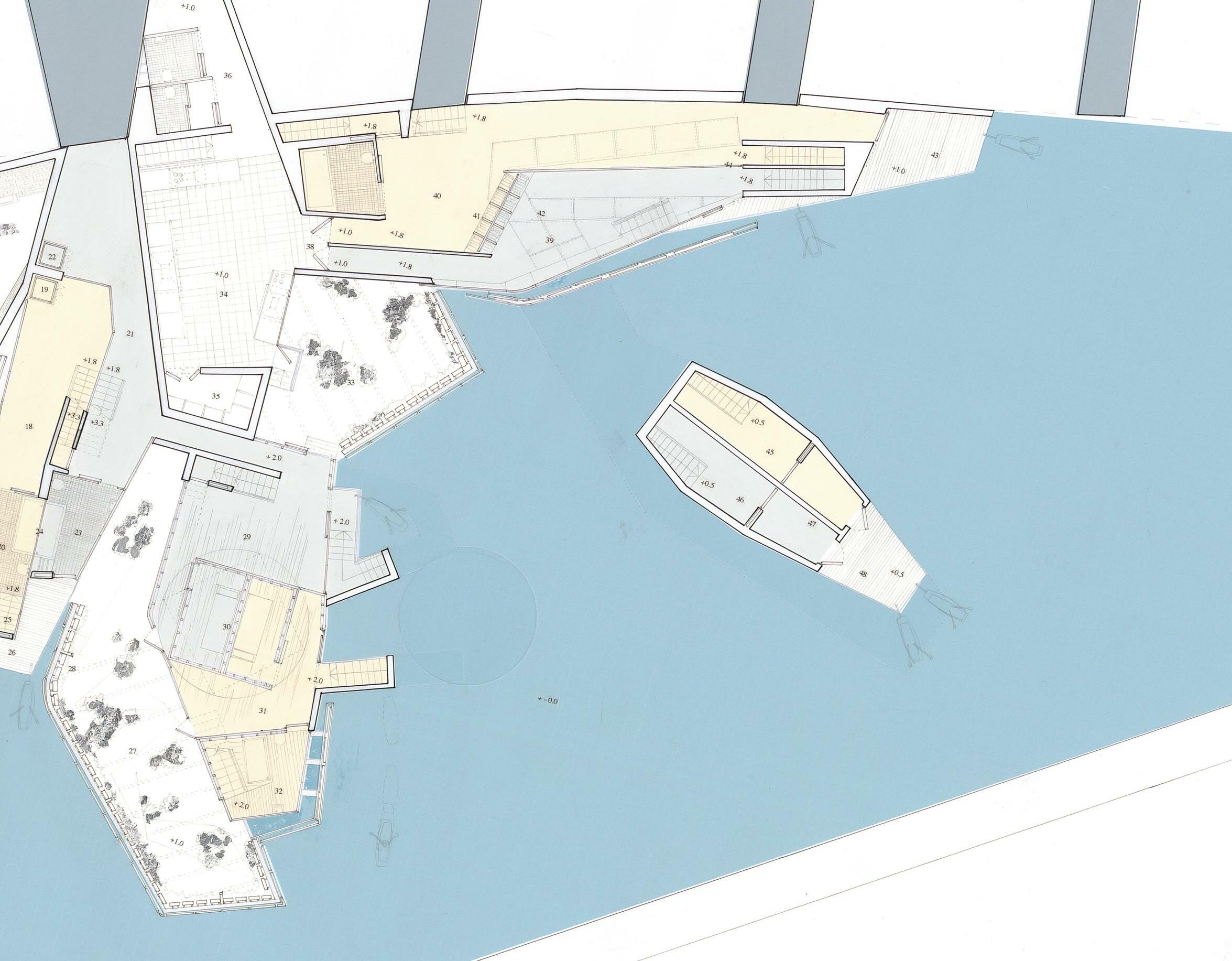Our Design DNA
At The Bartlett School of Architecture, we have been publishing annual exhibition catalogues for each of our design-based programmes for more than a decade. These catalogues, amounting to thousands of pages, illustrate the best of our students’ extraordinary work. Our Design Anthology series brings together the annual catalogue pages for each of our renowned units, clusters, and labs, to give an overview of how their practice and research has evolved.
Throughout this time some teaching partnerships have remained constant, others have changed. Students have also progressed from one programme to another. Nevertheless, the way in which design is taught and explored at The Bartlett School of Architecture is in our DNA. Now with almost 50 units, clusters and labs in the school across our programmes, the Design Anthology series shows how we define, progress and reinvent our agendas and themes from year to year.
2020 Material Cultures
Paloma Gormley, Summer Islam
2019 Tilt-Shift: Long Views Across the Edo Farlie Reynolds, Paolo Zaide
2018 Gravesbury: 4IR Charlotte Reynolds, Paolo Zaide
2017 Drifting Cityscapes
Tim Norman, Paolo Zaide
2016 Indian Nose Reconstruction
Christine Hawley, Paolo Zaide
2015 Hong Kong Reconsidered
Christine Hawley, Paolo Zaide
2014 Edge: Fragile Landscapes
Christine Hawley, Paolo Zaide
2013 The Peckham Experiment
Christine Hawley, Paolo Zaide
2012 Schools for Tomorrowland Sabine Storp, Paolo Zaide
2011 Housing 192060
Christine Hawley, Paolo Zaide
2010 Foods and Excess
Christine Hawley, Paolo Zaide
2009 Altered States
Liam Young, Paolo Zaide
2008 Landscape Ben Addy, Stuart Piercy
2007 Ben Addy, Stuart Piercy
2006 Ebb + Flow
Ben Addy, Stuart Piercy
2005 Trigger Mechanisms
Bernd Felsinger, Stuart Piercy
Material Cultures Paloma Gormley, Summer Islam
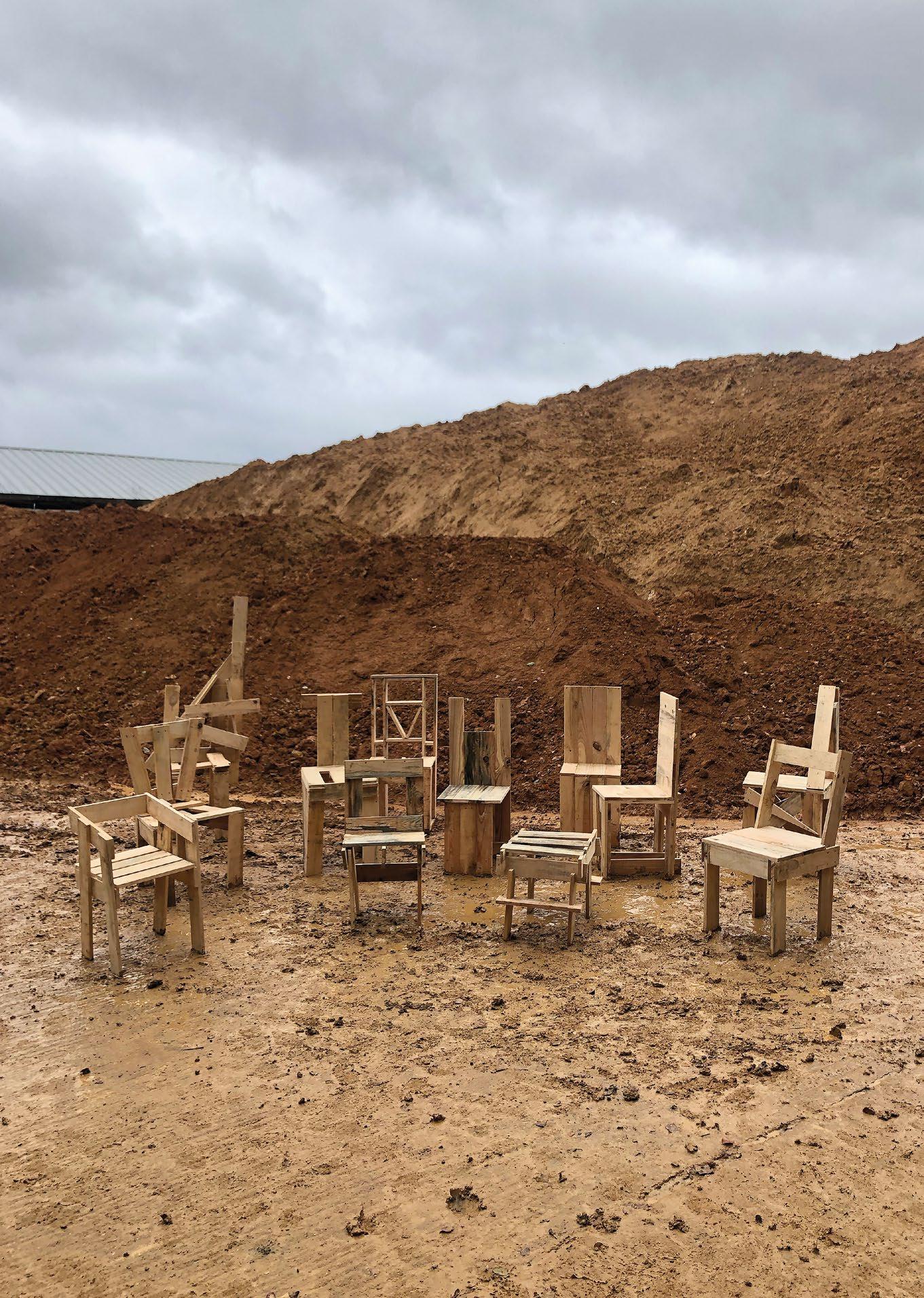
Material Cultures
Paloma Gormley, Summer IslamUG6 begins from the position that in order to halt the progress of ecological breakdown we need to radically rethink the logic of current construction methods, the materials we use, our approach to growth and our understanding of both value and time. In doing so, it is likely that we will need to both recover some of our forgotten technologies and develop entirely new forms of architectural language.
We are interested in developing qualitative prototypical buildings, which are ecologically founded, economically viable, and positively impact their inhabitants’ lives through considered design and accessible adaptability. In a climate in which warranties dictate design, and the nature of construction contracts limit quality, we seek to redistribute the priorities of the construction process in favour of design and sustainability.
Our proposals are designed to be factory made, involving different forms of prefabrication and drawing on the material resources and infrastructure of the surrounding contexts. They combine the efficiencies, improved labour conditions and precision of the factory with ancient building technologies and materials. Each building is a model, a design that can be reproduced and reconfigured many times and in many different contexts.
Students’ proposals are sited as part of the Aylesbury ‘Garden Town’, a government housing initiative drawing on the principles of Ebenezer Howard’s Garden Cities. The site is intended to be at once specific and generic, to enable the propositions to be tested against context and in relation to each other. Together the buildings form a broader urban proposition that constitutes a self-sufficient town with its own housing, community buildings and productive spaces.
Along the way, we have been modelling and testing at different scales, with an emphasis on the direct use of materials and 1:1 fabrication. We began our year with a trip to the brick factory HG Matthews, where each student designed and made a chair. We ended our time on campus at Here East, midway through the fabrication of a pavilion for the New Art Centre in Salisbury, for which the unit collaboratively designed a pavilion building using prefabricated timber cassettes with an innovative clay and hemp infill. Making brought us into contact with the tactility of these processes and enabled us to learn with our hands. We have interrogated how material and industrial cultures shape the world, and creatively challenged regulations, supply chains and processes in order to produce proposals that offer a radical yet viable alternative to the status quo.
Year 2
Nasra Abdullahi, Marius Balan, Sophia Brummendorf Malsch, Latisha Chan, Thomas Keeling, Sara Mahmud, Yerkin Wilbrandt
Year 3
Maria De Salvador, Bengisu Demir, Christina Economides, Evelyn Salt, William Zeng
Thanks to our consultants Simon Herron, Luke Olsen, Peter Laidler, Will Stanwix
Thank you to our critics
Barbara-Ann CampbellLange, Mollie Claypool, Amica Dall, Lettice Drake, Sam Little, Bob Sheil, Richard Wentworth
6.1 UG6 ‘One-Day Chair Project’. Using hand tools and palette timber, over the course of a single day each student designed and made a chair which reflected the structural principles of a different timber-framed building case study. These were built and photographed at HG Matthews Brickworks.
6.2, 6.8 Christina Economides, Y3 ‘The Homegrown Agora’ is a project which speculates on the possibilities which emerge from an integration of nature and architecture. Reframing agricultural waste and the growth of fungi as valuable resources for the production of biomaterials, the proposal explores how we can build with locally produced bio-based materials as substitutes for the high-embodied carbon products prevalent in the building industry. It is both a building and a system which incorporates growing, producing, using and decomposing materials.
6.3 Evelyn Salt, Y3 ‘New Urban Plan for Aylesbury Garden Town’. This site plan shows a cooperative housing proposal in the context of an urban plan developed collaboratively by the unit, with a number of different prototypical housing models arranged in organic clusters around communal green spaces. The project is situated within the new ‘garden town’ development of Aylesbury, the masterplan of which UG6 have redesigned in order to create community-centred spaces, where the programme, position and design of the buildings gives the town a distinct sense of place.
6.4, 6.9, 6.18 Maria De Salvador, Y3 ‘Mass Timber High Rise’. This proposal explores the use of mass timber frame structures in high-rise residential towers, and the potential role of the column in this system as both a structural and a spatial device. The mass timber structural columns free up the internal walls to vary from storey to storey, forming a series of dynamic private and public spaces. The plan leaves room for potential change and unprogrammed activities to take place, anticipating but not prescribing its future uses.
6.5 William Zheng, Y3 ‘The Chill Garden’. This project addresses the complexities of societal stress, and the desire to be both part of and apart from, the group. The proposal is for a densely occupied residential block with a carefully curated gradient of space, which navigates from the public social to the private realm. The design was developed through the interrogation of viewpoints and the experiences of the viewer and the viewed. The enclosures and openings that define the spaces have been calibrated materially and formally to recognise inherent social choreographies and promote social ease.
6.6–6.7 Thomas Keeling, Y2 ‘Earthside Terrace’. In this project, conversations between residents over light, land and space are resolved in negotiation between the hills and the walls. The outcome is a 43% reduction in basic construction costs; and an affordable, tailored neighbourhood which is embossed into the hillside. Construction techniques are exposed and celebrated: encouraging inhabitants to repair, retrofit and expand their homes as their relationship with the typology develops. This proposal aims to impact beyond the single instance of this development, shaping attitudes towards construction and reimagining our historically imbalanced relationship with nature.
6.10–6.12 Evelyn Salt, Y3 ‘The Bathhouse’. This project addresses how spatial and material decisions can help create the conditions for intimacy in an increasingly isolated society, explored through a prototypical co-operative housing typology composed of a primary in-situ timber frame and prefabricated hempcrete infill cassettes. Inward-facing openings are privileged over outward-facing ones, with large pivoting windows creating moments of connection across a courtyard allowing for relationships to be established at a distance and
generating an experience of togetherness. The ground floor of the building provides flexible social, communal and commercial space. In this instance it is shown occupied by a bathhouse, the communal spaces of which provide moments of encounter and interaction, places where relationships are formed and that foster a sense of community.
6.13, 6.15 Sophia Brummendorf Malsch, Y2 ‘Redefining the Rural’ investigates how our relationship to landscape and agriculture can define what living rurally looks like. It is a response to the unavoidable tension between enforced control over landscape through traditional agricultural practices, at the expense of complex forest ecosystems. The project proposes a provocative strategy of densification of agriculture and housing as a way of liberating arable land for reforestation. The building is designed for reconfiguration as well as disassembly, using prefabricated components that sit within a larger timber frame, which allows residents to customise their living space to their current and future needs.
6.14 Sara Mahmud, Y2 ‘Revolutionising Post-Factory Culture’. In the context of a growing disconnect between the places where things are bought and the places where things are made, this project advocates the reintroduction of manufacturing spaces into residential neighbourhoods, where communities can better understand the impact of their choices on the environments in which they live.
The proposal is a series of small-scale fabrication workshops which coexist with one- and two-bedroom flats, exploring the interconnection of domestic and productive space and the potential for shared spaces between these two programmes.
6.16 Bengisu Demir, Y3 ‘The Talking Laundrette’. This project investigates how natural materials and passive systems can help create low embodied energy solutions for everyday life. The proposal is a series of apartment blocks, joined together by a communal laundrette where the residential community can gather, interacting with one another in the processing of carrying out often unacknowledged domestic labour. In exploring the social and ecological potential of rethinking the way we wash and dry our clothes, the building addresses both the material and cultural shifts necessary in a low carbon future.
6.17 Latisha Chan, Y2 ‘Healthcare at Home’. This project explores the notion of care, and the extent to which a building’s material palette and programme can positively impact the lives of its inhabitants. The proposal is a sustainable housing model, which integrates a series of social spaces promoting both physical and mental wellbeing. Natural and low embodied carbon materials were carefully chosen for the structure and finishes, and a central hanging garden creates a microclimate of purified air. Prefabricated systems allow the building to be constructed quickly. The project envisions a future where housing developments across the country incorporate this new typology.
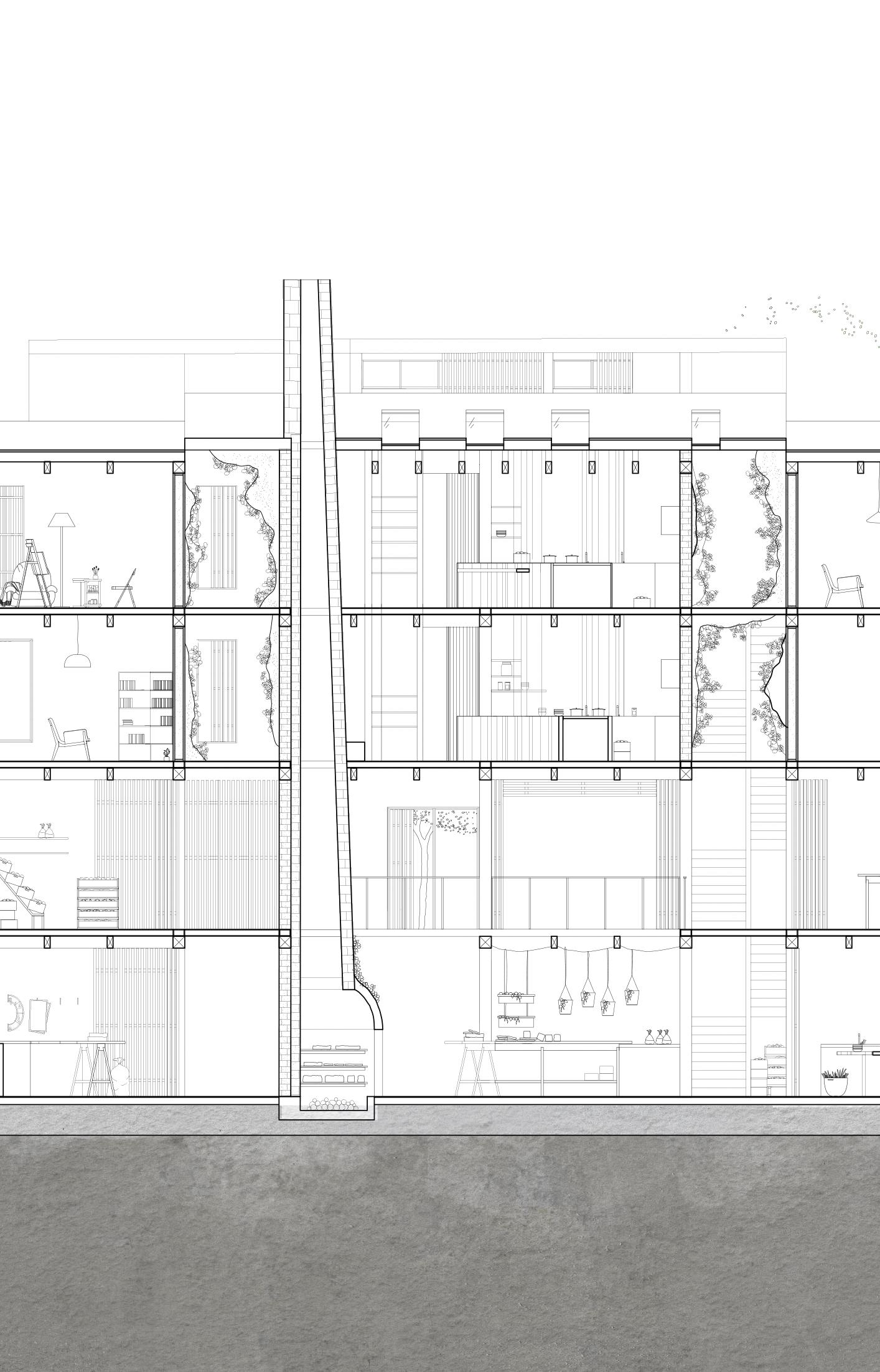






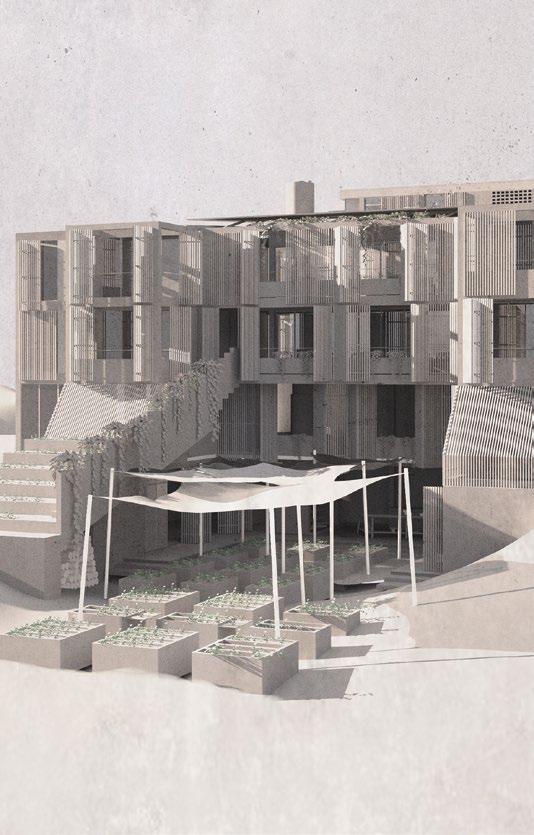
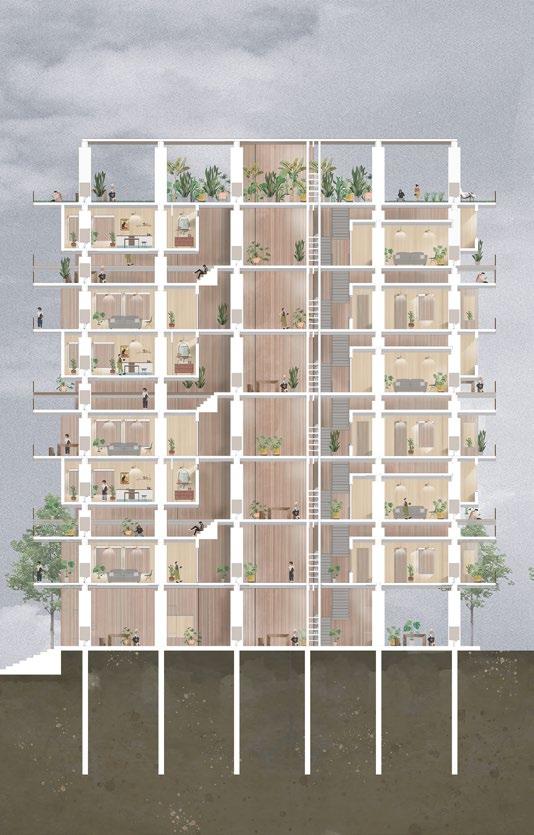
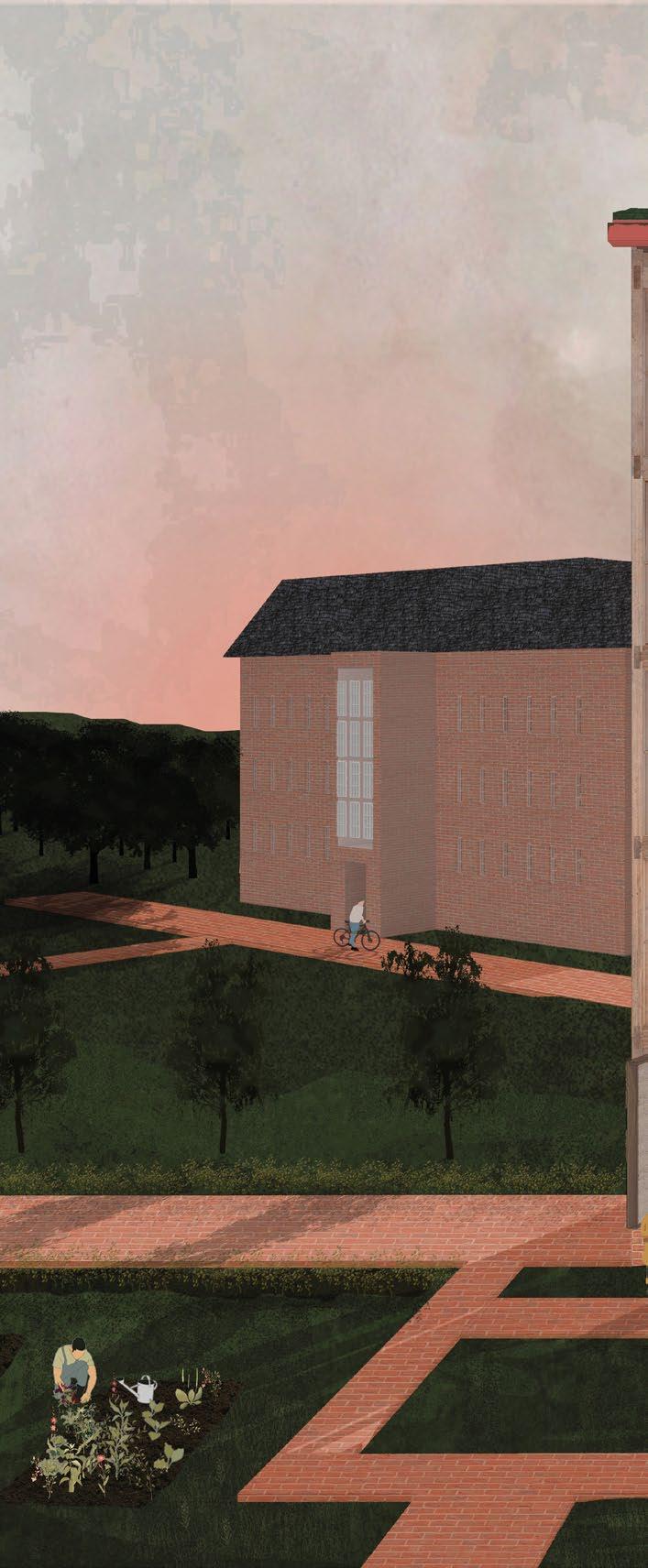
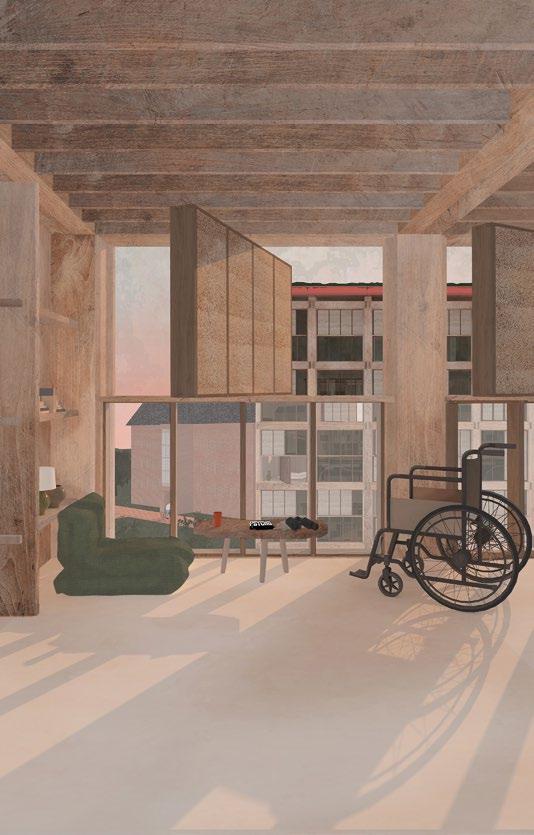
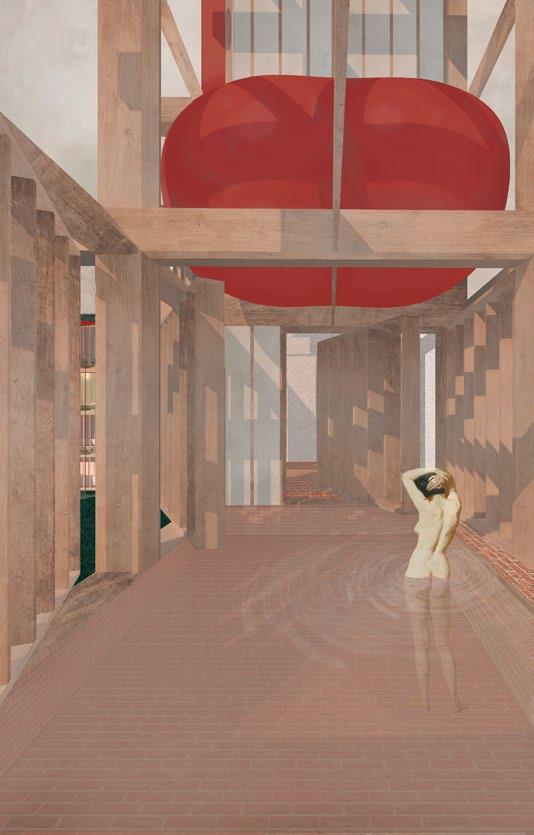
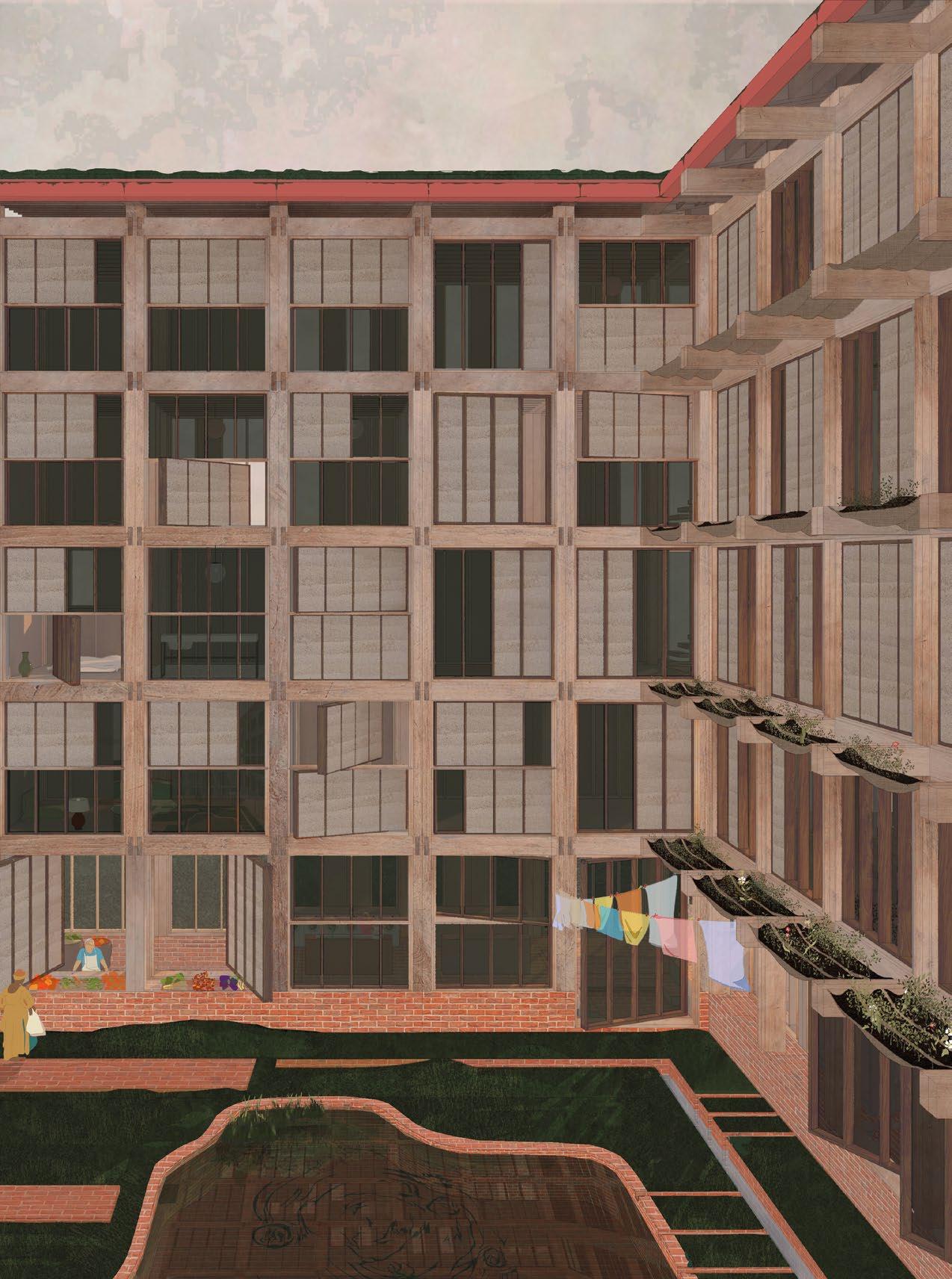
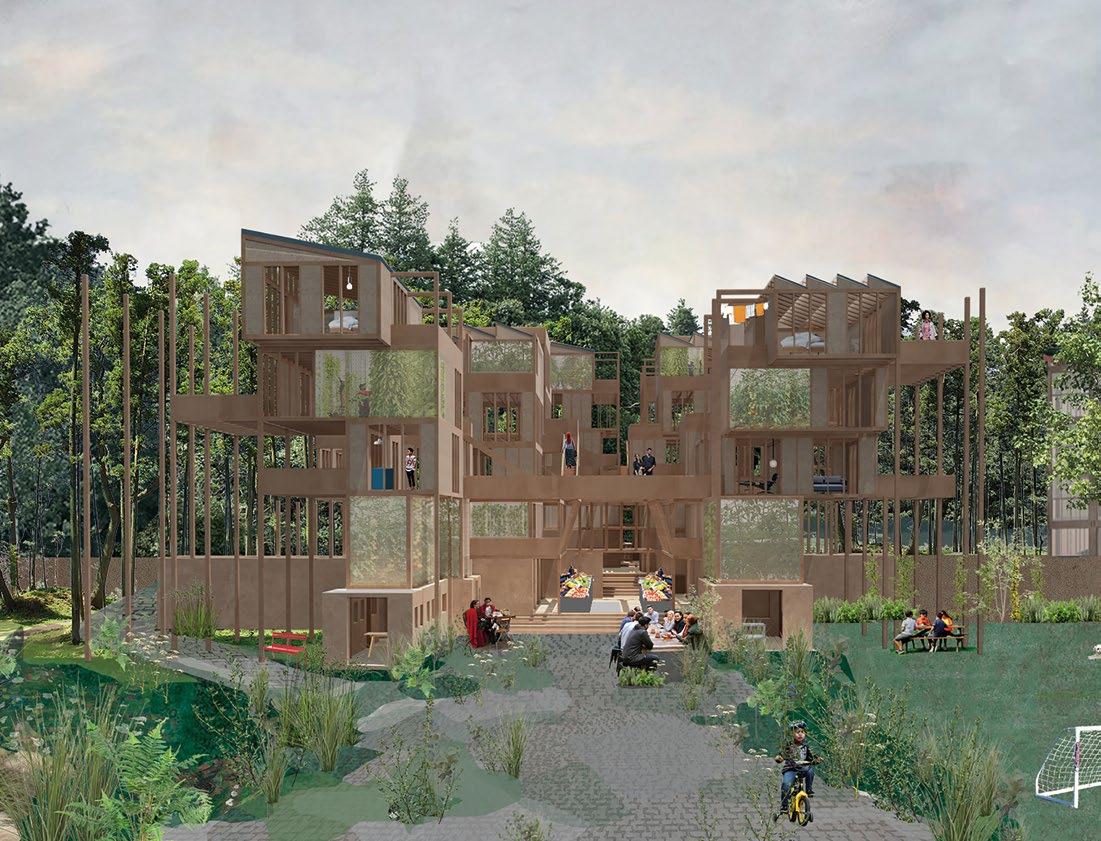


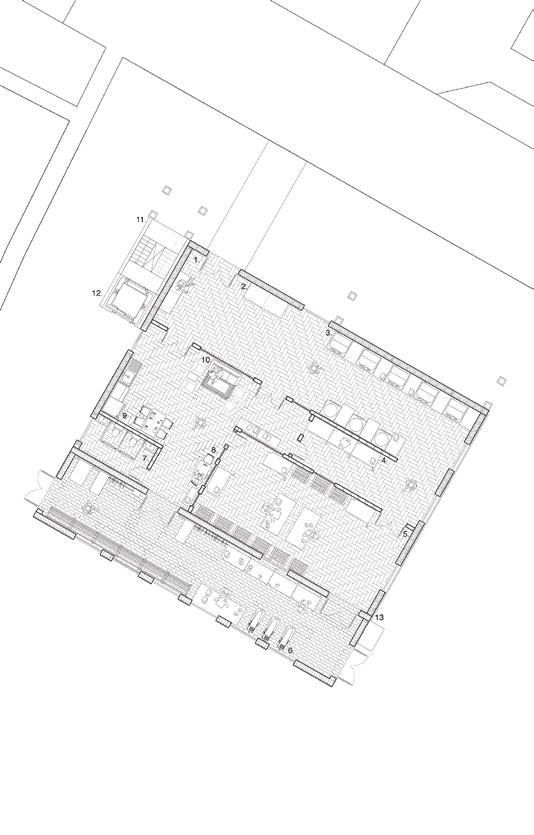
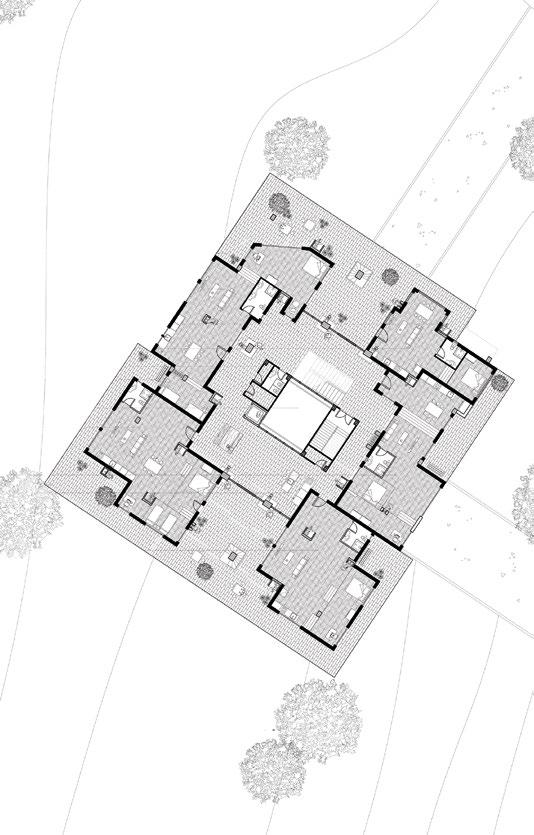
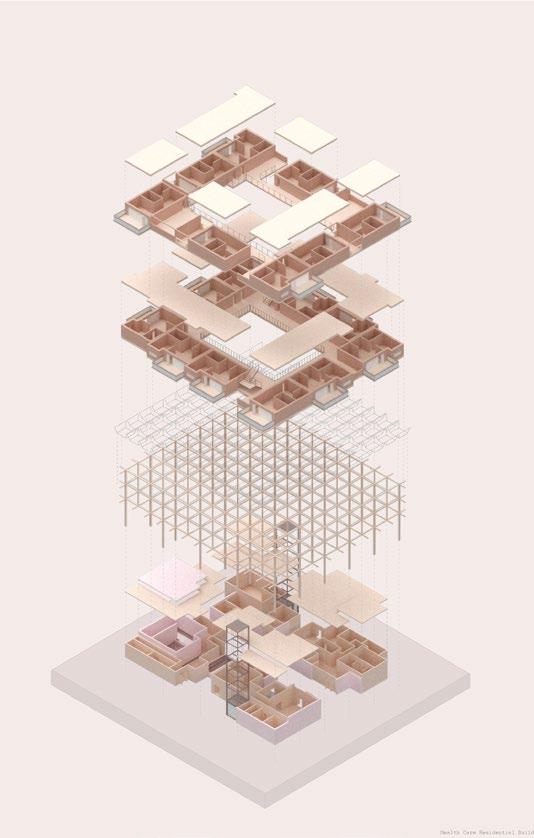
Tilt-Shift: Long Views Across the Edo Farlie Reynolds, Paolo Zaide

Tilt-Shift: Long Views Across the Edo
Farlie Reynolds, Paolo ZaideJapanese ukiyo-e – meaning ‘pictures of the floating world’ –are woodblock prints that were intended to provide escapism from everyday 17th-century life in Japan during the Edo period. Stitching together stories of people, spaces in nature and the changing of the seasons, ukiyo-e depicted imagined societies where folklore, erotica and wild landscapes were in abundance. Today, Tokyo’s dazzling neon backdrop is a dramatic shift from these dreamlike floating worlds. But between the subtle transience of the old capital and the digitally enhanced frenzy of Tokyo remains a culture inherently bound by tradition, craft and nature. This dialogue between tradition and modernity is embodied in the tactility of the moss garden, the diffuse light of the shoji –traditional Japanese doors made with translucent paper – and the engawa – a narrow Japanese veranda that forms an ambiguous passageway between dwelling and garden. Caught between shoji screens and the outer storm shutters, the engawa exists as a blurred threshold – a space that is neither inside nor out – and is a space for conversation or for observation of the slow passing of the seasons. This space reflects Japan’s traditional reverence for natural life and the environment. Originally absent from the Japanese language, ‘nature’ was considered so integrated with the everyday experience that there was no impetus to conceptualise it as its own entity. Technology was embraced as a means to adapt to the natural world and to passively extract resources, establishing a symbiosis between traditional Japanese craft and nature. Architecture, thus, became dependent upon its context rather than an artificial imposition within it. Today, the paradox between Eastern and Western approaches in Japan typifies the tension between nature and culture: both are in constant motion, slowly tilting between extremes, forcing us to speculate on how our environment might recalibrate when one radically shifts. This year, UG6 confronted this changing environment. We negotiated small tilts and big shifts – shocks caused by abrupt changes in nature or culture – and questioned how everyday spaces and urban landscapes can adapt to accommodate environmental uncertainty. Our focus was Tokyo Metropolis, a model ‘disasterresistant city’ that has undergone a number of changes to withstand potential environmental impacts over the years. Searching beyond the pragmatic, we interpreted the notion of ‘shocks’ and the ‘environment’ from a cultural perspective. This year’s brief was an invitation to journey through Japan’s traditional and contemporary narratives, to stitch into the rhythmic tempo of Tokyo and to bind age-old techniques and materials with new technological inventions.
Year 2
Renee (Soraya) Ammann, Tengku (Sharil) Bin Tengku Abdul Kadir, Cira Oller Tovar, Ewa Roztocka, Natalia Sykorova, Chak (Anthony) Tai, Milon Thomsen, Long (Ron) Tse, Suzhi Xu
Year 3
Chun (Jason) Chan, Hiu (Victor) Chow, Migena Hadziu, Zhongliang (Abraham) Huang, Yuen (Peter) Kei, Kit Lee-Smith, Owen Mellett
UG6 would like to thank our guest critics: Laura Allen, Barbara-Ann Campbell-Lange, Edward Denison, Christine Hawley, Ness Lafoy, Inigo Minns, Caspar Rodgers, Gregory Ross, Emory Smith, Kit Stiby Harris, Sabine Storp, Jessie Turnbull; and friends of the unit, Theo Clarke, Maxim Goldau, Kerry Lan, Shiyin Ling, Jerome Ng, Yip Wing Siu
Thank you to Robert Newcombe for our photography workshops, to our computing tutor Jack Holmes and our technical tutors Clyde Watson and Dimitris Argyros
For their warm hospitality we would like to thank Toshiki Hirano from the Kengo Kuma Lab, Kaz Yoneda and Momoyo Kaijima for introducing Tokyo from the Atelier Bow Wow Terrace. Finally, we would like to thank the Daiwa Foundation and the Great Britain Sasakawa Foundation for their generous support this year
6.1 Migena Hadziu, Y3 ‘Archipelago/Dichotomy’.
This project proposes a DNA research and archive facility for the ex-military Daiba Park island in Tokyo Bay. The architecture bridges the gap between time and materiality by reacting to the conditions set out by the process of preservation and manipulation of the site, allowing the building to keep evolving in parallel to the research development.
6.2 Natalia Sykorova, Y2 ‘Museum of Forgotten Territories’. This project accesses the inaccessible through reconstruction of a non-existent village. A territory of the Burakumin – an outcast community considered to be at the bottom of Japanese society –the village has been left and consciously forgotten to suppress discrimination. The proposed building communicates collisions and disassociations within Japanese society through the process of leather-making.
6.3–6.5 Kit Lee-Smith, Y3 ‘Anthropogenic Tectonics’. The UNESCO Intangible Cultural Heritage programme promotes education and preservation, adopting traditional Japanese attitudes, rather than Western material archiving. The design for a ‘seismic proving ground’ within Tokyo Bay aims to celebrate new technologies, investigates seismic activity around liquefaction – whereby the strength of soil is affected through an earthquake or similar force – and searches for a future treatment for design on reclaimed land.
6.6 Long (Ron) Tse, Y2 ‘Juku with the Falling Eggs’. In response to the rigid yet inefficient Japanese education system, the project explores the new typologies of learning environment for students aged between 3 and 13. Inspired by Bruno Munari’s ‘Tactile Workshops’, the scheme proposes a learning landscape and chicken farm that encourages children to learn through physical interaction, play and creativity.
6.7 Hiu (Victor) Chow, Y3 ‘Hesei Shrine Complex’. This project looks at the deconstruction and desecularisation of the traditional Japanese religion Shinto, with the aim of creating shrines with metaphysical boundaries, in contrast to traditional walls and gates, where enshrined objects have been closed-off and people have been forgotten. The project reminisces on the memories of the Tsukiji Fish Market and Heisei era, whilst looking forward to the revitalisation of Shinto and the future of the new emperor.
6.8–6.9 Suzhi Xu, Y2 ‘Kyo no Shiki – Four Seasons of Kyoto’. By studying the daily rituals of geisha, the tradition of ‘revealing and concealing’ is reinterpreted in this project through the redesign of a kimono and in a performance. The performance became the foundation of an installation on Tokyo’s streets, revealing and concealing fragments of Kyoto and the dying beauty of geisha culture.
6.10 Owen Mellett, Y3 ‘The Flooding Japanese Garden’. This landscape intervention sets a precedent for the further development of Tokyo, integrating flood control with the creation of new public garden spaces. By inhabiting and reconstituting the bottom floors of buildings close to important flood points, the project creates an ever-shifting garden space. Surrounded by a forest of support columns, among which the inhabited structures sit, the garden retreats, shifts and unfolds as the water level changes to ensure this public space is always inhabitable, regardless of the changing environmental conditions around it.
6.11–6.12 Tengku (Sharil) Bin Tengku Abdul Kadir, Y2
‘Nha – Home for the Vietnamese Immigrant’. A proposal for a co-housing scheme for the new Vietnamese immigrant and the Japanese university student, designed in response to a controversial immigration bill by the Japanese government. Learning and exchange are facilitated onsite through the use of adapted vernaculars and myths from both cultures.
6.13 Chak (Anthony) Tai, Y2 ‘Salaryman’s Genkan’. Inspired by social problems relating to harsh working conditions in Japan, this project investigates extensions to the home that help people to de-stress after work. Using the engawa spaces commonly found in traditional Japanese homes, a series of scripted, organic landscapes in the form of ‘plug-ins’ create a new conversation around the conventional daily routine.
6.14 Yuen (Peter) Kei, Y3 ‘Mikoshi Lion Festival’. Due to the redevelopment of Tsukiji Fish Market in Tokyo, the annual matsuri (festival) is disappearing. This project incorporates public and private spaces allocated to the festival’s parade route and, also, workshop facilities for building celebratory structures. A mikoshi lion head is constructed above the workshop area as a symbolic display of Tokyo’s dynamic cityscape.
6.15 Renee (Soraya) Ammann, Y2 ‘A Night-time Retreat’. Situated in Dogenzaka, Tokyo – where the night is always young, and the drinks never stop coming –this programme offers a place of rest for those wanting to escape it. Designed for the average party-goer and worker, it incorporates laundry, bathing and sleeping facilities packaged in the format of a deconstructed Katsura Imperial Villa.
6.16 Milon Thomsen, Y2 ‘Towards a ‘Bonsai’ Architecture: Multigenerational Living in Tokyo 2090’. With Tokyo’s ageing population set to halve by the end of the century, this project seeks new strategies that might preserve the city’s vitality through subtle subtractions and additions to existing building typologies. By connecting the disjointed urban structure and breaking with the unsustainable ‘demolish and rebuild’ philosophy, insertions of hanging gardens create new common ground for social interaction, learning and care between the young, working and elderly populations.
6.17 Zhongliang (Abraham) Huang, Y3 ‘Arrow to the Sea’. This project counters the ecological damage caused by the Tokyo 2020 Olympics in the form of a traditional Japanese martial arts centre, located in Tsukiji. In order to bring tranquillity back to the site, bamboo forests will be planted in and around the main architecture, where people can practice martial arts and Japanese archery, and enjoy the peaceful view of the bamboo forest and Tokyo Bay.
6.18 Ewa Roztocka, Y2 ‘Renewal of Shitamachi’. This project is set on the historical border between the Yamanote and Shitamachi areas in Tokyo, constructing a bridge on the border for contrasting social and urban patterns to meet. In it, lost personal memories and belongings of the forgotten lowland Shitamachi cultures are celebrated through craft. The design seeks to revive the Shitamachi area, in particular its housing, and promotes local Shitamachi craft.
6.19 Cira Oller Tovar, Y2 ‘The Streetscape of Asakusa’. In contrast with the civic squares seen in Europe, villages and districts in Japan have an axial organisation. This village structure, with no visual endpoints, would appear to signify the lack of importance placed on spatial limits. The project explores how different elements merge interior and exterior, and private with public spaces in contemporary Japan.
6.20 Chun (Jason) Chan, Y3 ‘Aqua-Vitality Retirement Centre’. This proposal uses architecture to retain the memory of the Tsukiji Fish Market. The building redefines the memory of existing shops, structures and functions. An intersection between Tokyo’s old and new, prefabricated building elements were designed to combine with the existing structure, creating a sustainable Japanese garden and an atmosphere of delight for the older and younger generations.
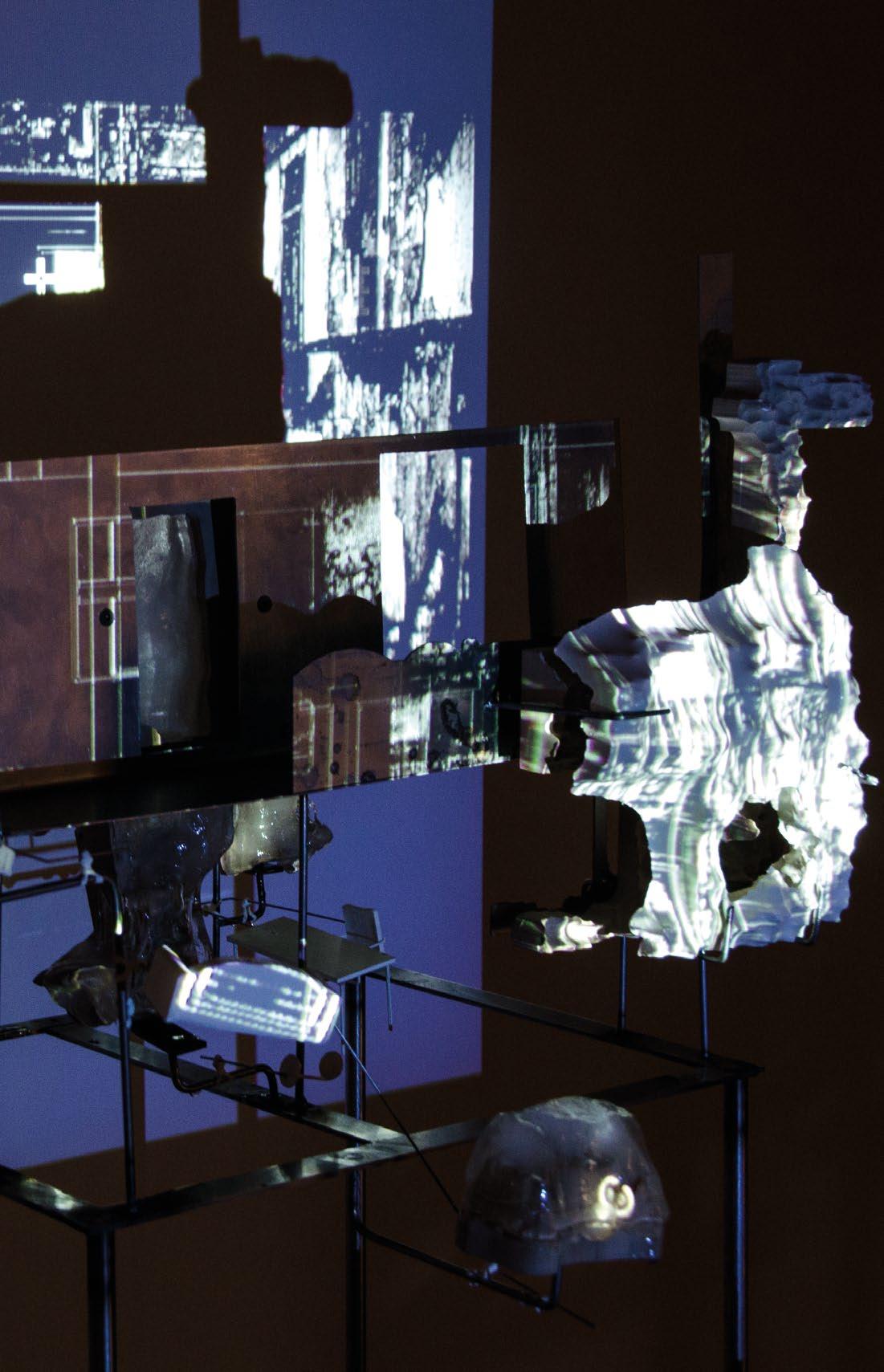

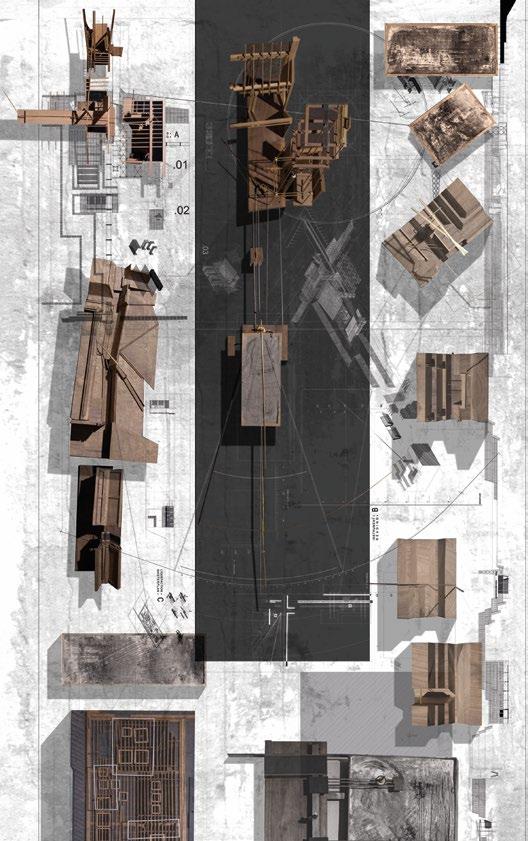

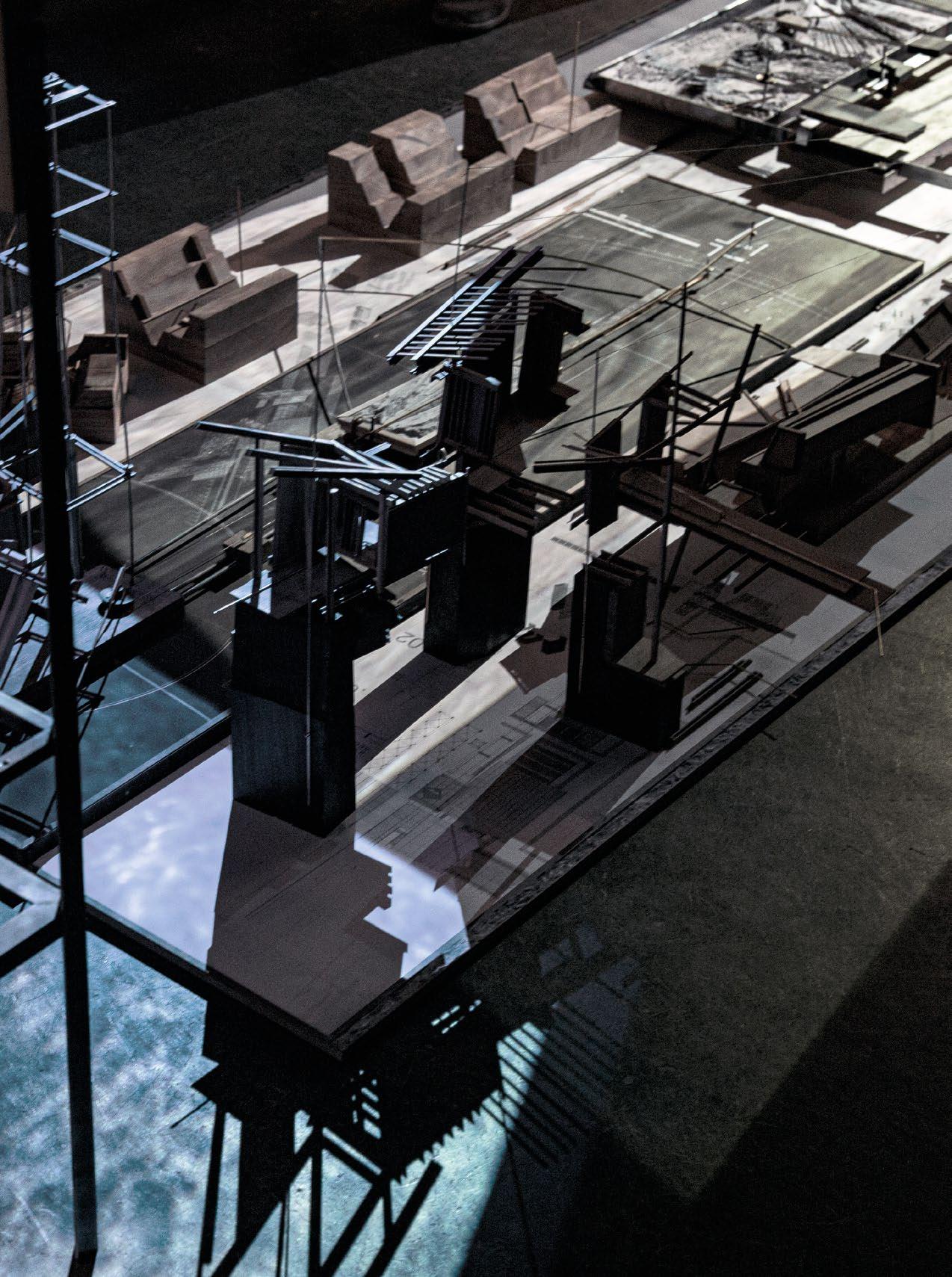

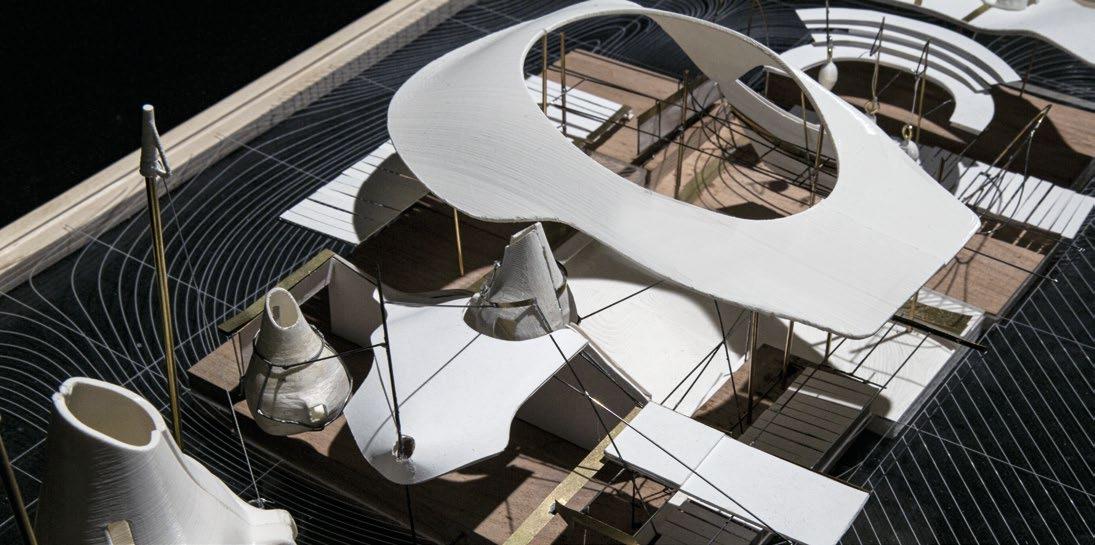


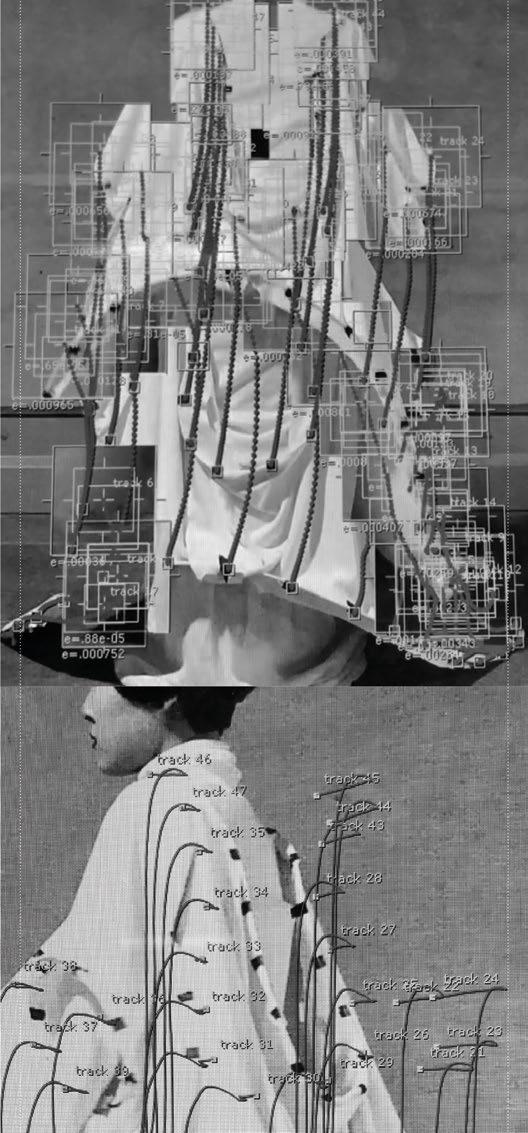



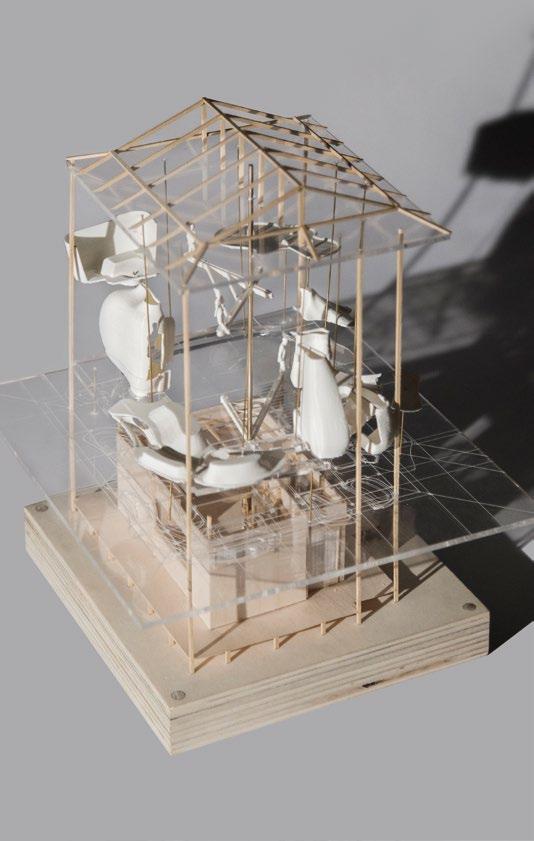
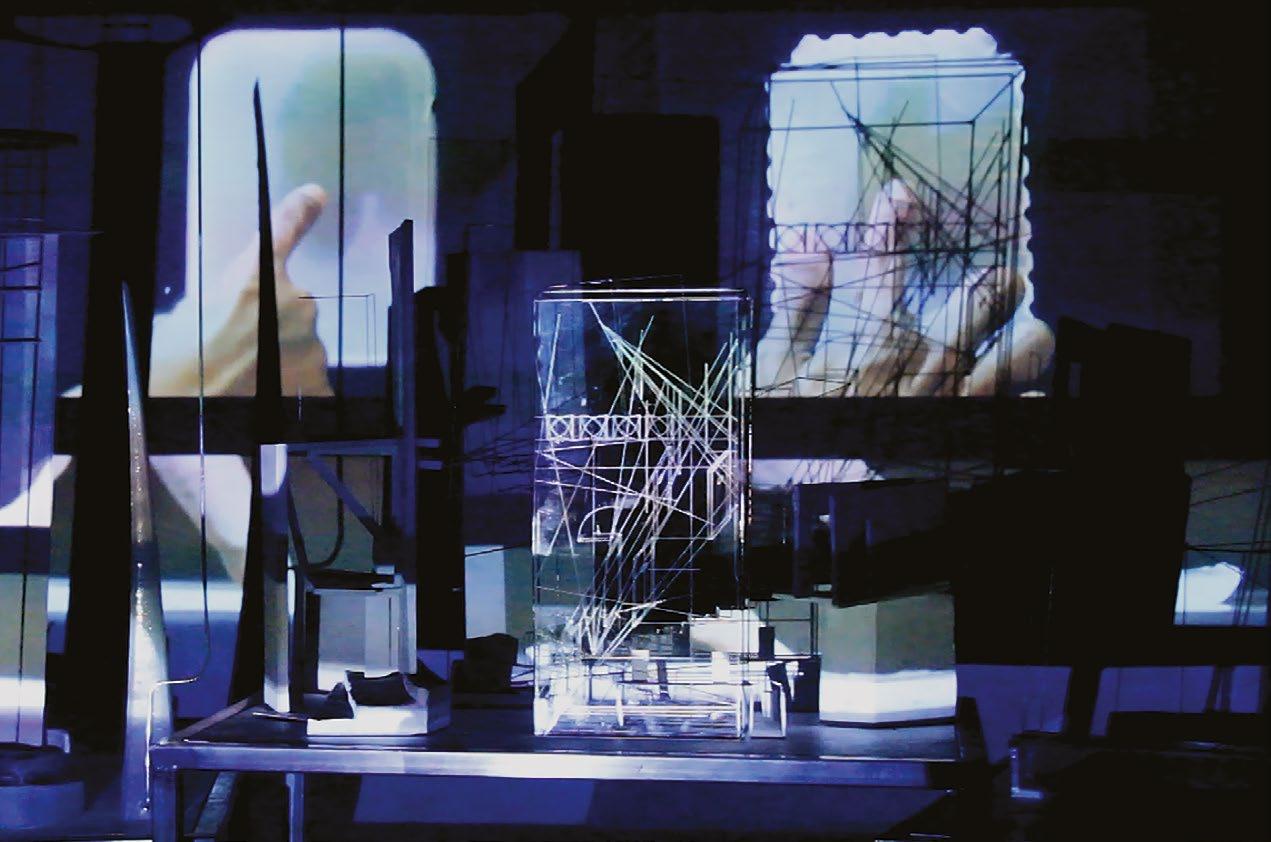
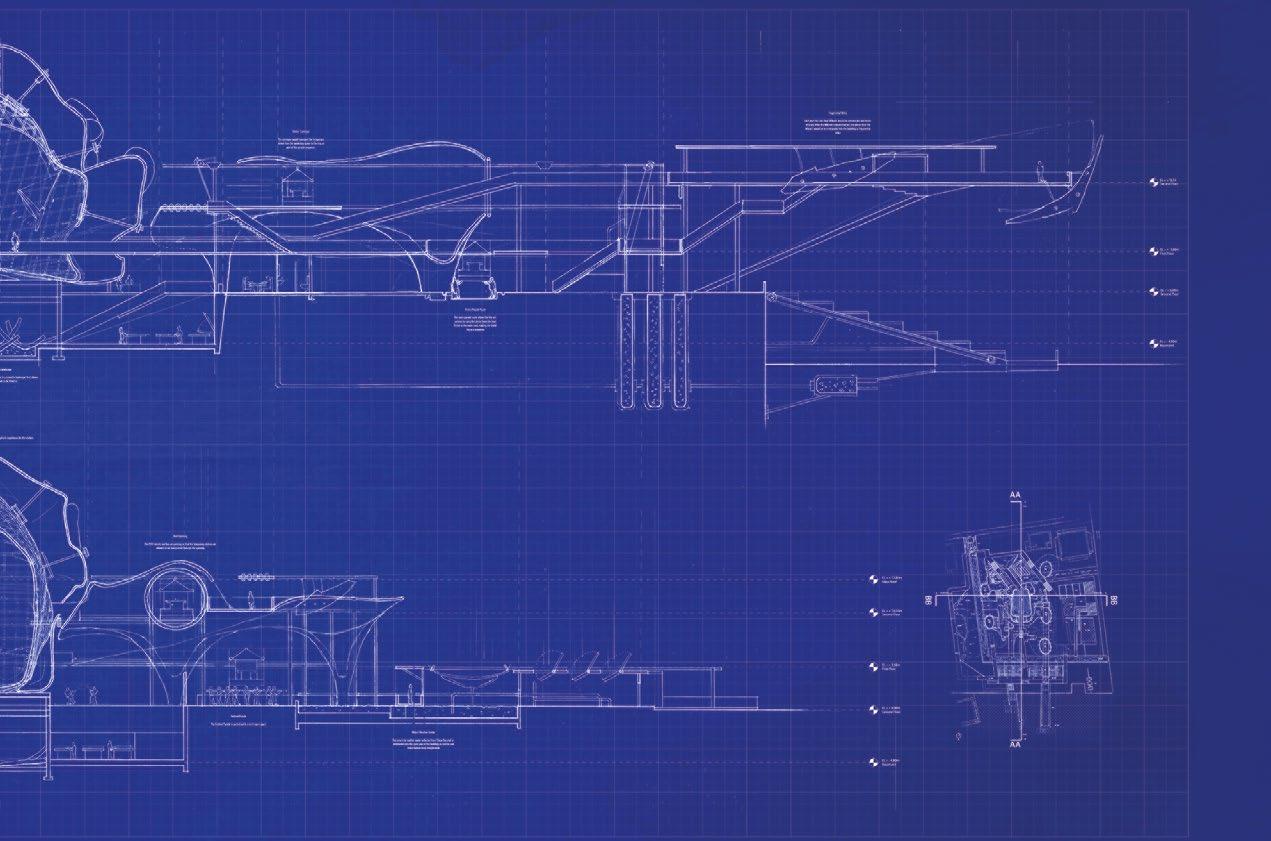
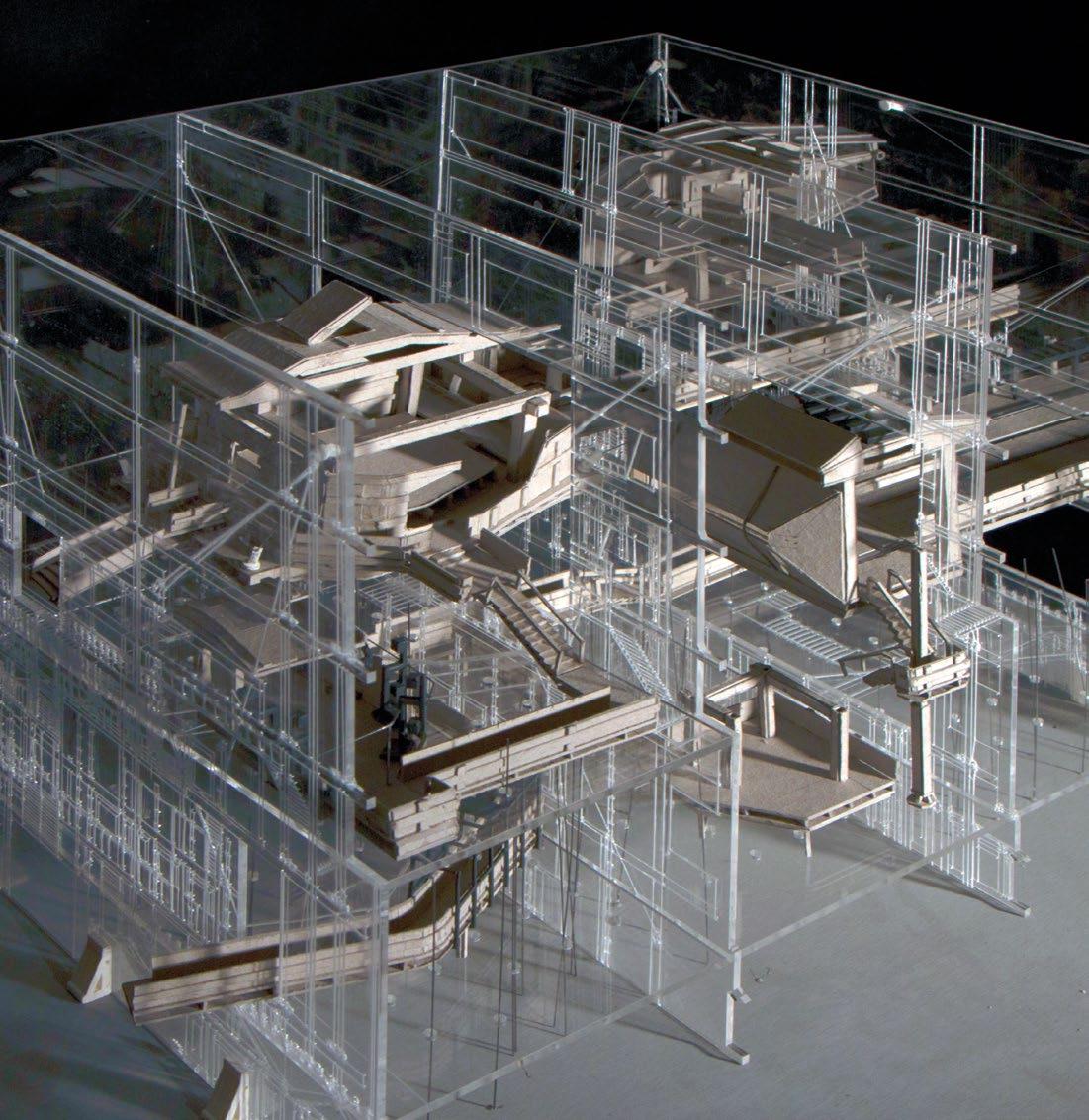
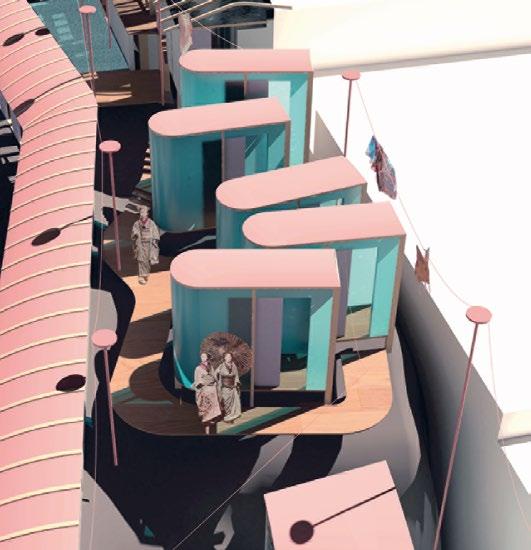

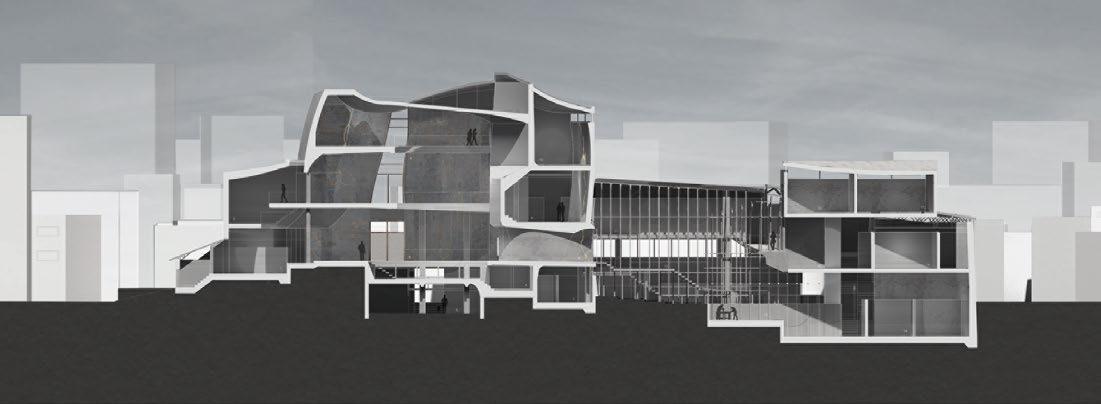
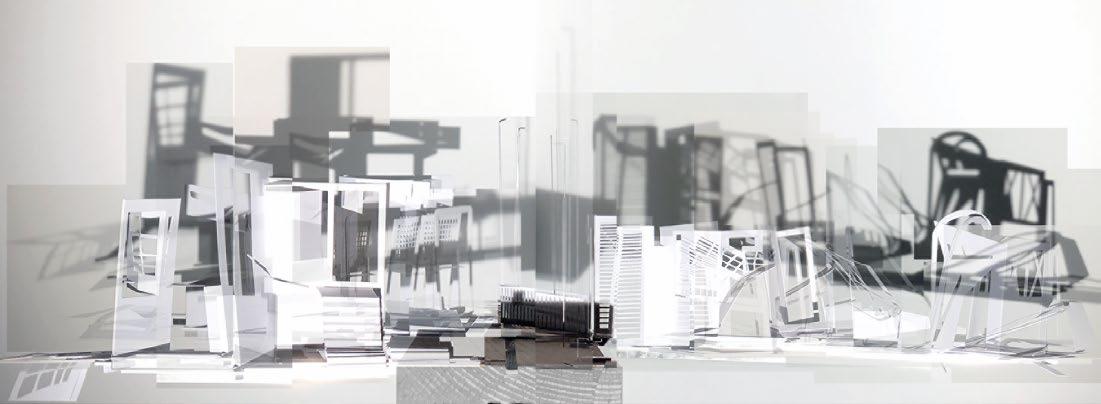

Year 2
Amy Kempa, Zakariya Miah, Indran Miranda Duraisingham, Marcus Mohan, Imogen Ruthven-Taggart, Annabelle Tan Kai Lin, Tini Hau Tang, Arina Viazenkina
Year 3
Theo Clarke, Maxim Goldau, Yo Hosoyamada, Tsz (Victor) Leung, Lingyun (Lynn) Qian, Kenji Tang, Ching (Cherie) Wong
UG6 would like to thank our guest critics: Will Armstrong, Peter Bishop, Barbara Campbell-Lange, Andy Friend, Christine Hawley, CJ Lim, Joe Paxton, David Roberts, Sabine Storp, Patrick Weber and friends of the unit George Courtauld, Jin Kuo, Kerry Lan, Enoch Liang, Yiki Liong, Jerome Ng, Max Shen, Sam Tan, Gordon Yip
Thank you to Lynne Goulding and Matthew Carreau from Arup Foresight for the Emerging Futures workshop
Thank you also to Emma Kitley, Robert Newcombe and Yip Wing Siu for running various media workshops, to our computing tutor Jack Holmes and our technical tutors Dimitris Argyros and Clyde Watson
Gravesbury: 4IR
Charlotte Reynolds, Paolo ZaideWe are on the brink of 4IR – the fourth industrial revolution. Building on the momentum of last century’s digital revolution, 4IR is beginning to merge our cyber networks with our physical infrastructure at an accelerating rate, creating new hybridised environments. With every mile of optic fibre laid and each new artificially intelligent device embedded in the Internet of Things, the ways in which we interface with our physical environment are modified and the ways we interact with one and other are shaped. In this technological storm our culture and economy will be forged. How will these advances fundamentally alter and ultimately challenge our way of life? Intrigued by this fragile tension between cultural tradition and technological progression, this year’s brief was an invitation to enter tomorrow’s brave new worlds.
This year’s programme was sited on the city’s edge, a suburban landscape that will be reinvented with 4IR. Gravesend, once a naval and shipbuilding town, is now a commuter zone that maintains only a small proportion of industrial activity. Across the water, Tilbury remains the principle port of London with a rich industrial history. East Tilbury’s 1932 Bata factory provided a unique model of a company town. Unique to the architecture of Bata Town was its utopian vision of community living that offered a farm to supply the eggs and milk for the guests at the Bata Hotel, tennis courts, football pitches and a swimming pool for the workers’ leisure, and a local cafe complete with an espresso bar and jukebox. Thriving sites of production and manufacturing in previous industrial revolutions, these forgotten factory townscapes are now promised a new lease of life, set to boom with new creative and cultural economies. The factory typology is now being optimised through automation, but how do we picture our homes and neighbourhoods will be? In a digitally oversaturated world, what kinds of spaces do we design in which we can live, learn or simply do nothing?
The connection between these towns was the focus for our main building project: to reimagine the impact of technology on the production, spaces and communities along the Thames Corridor. What will be important for these towns’ communities? How will the hybrid of technology and space support our lifestyles beyond the functional and pragmatic? How will it help to reconnect to its historic past, the societies of today and the ecologies and architecture of tomorrow? With a focus on the community over technology, what types of programmes and forms of living will cater for the welfare, ambitions and dreams of these neighbourhoods? 4IR provides an opportunity to think about how we can connect and reconnect with these virtual and physical realities. Still untested, ‘Gravesbury’ presents a site for sensitive experimentation, wonder and a taste for the unknown.
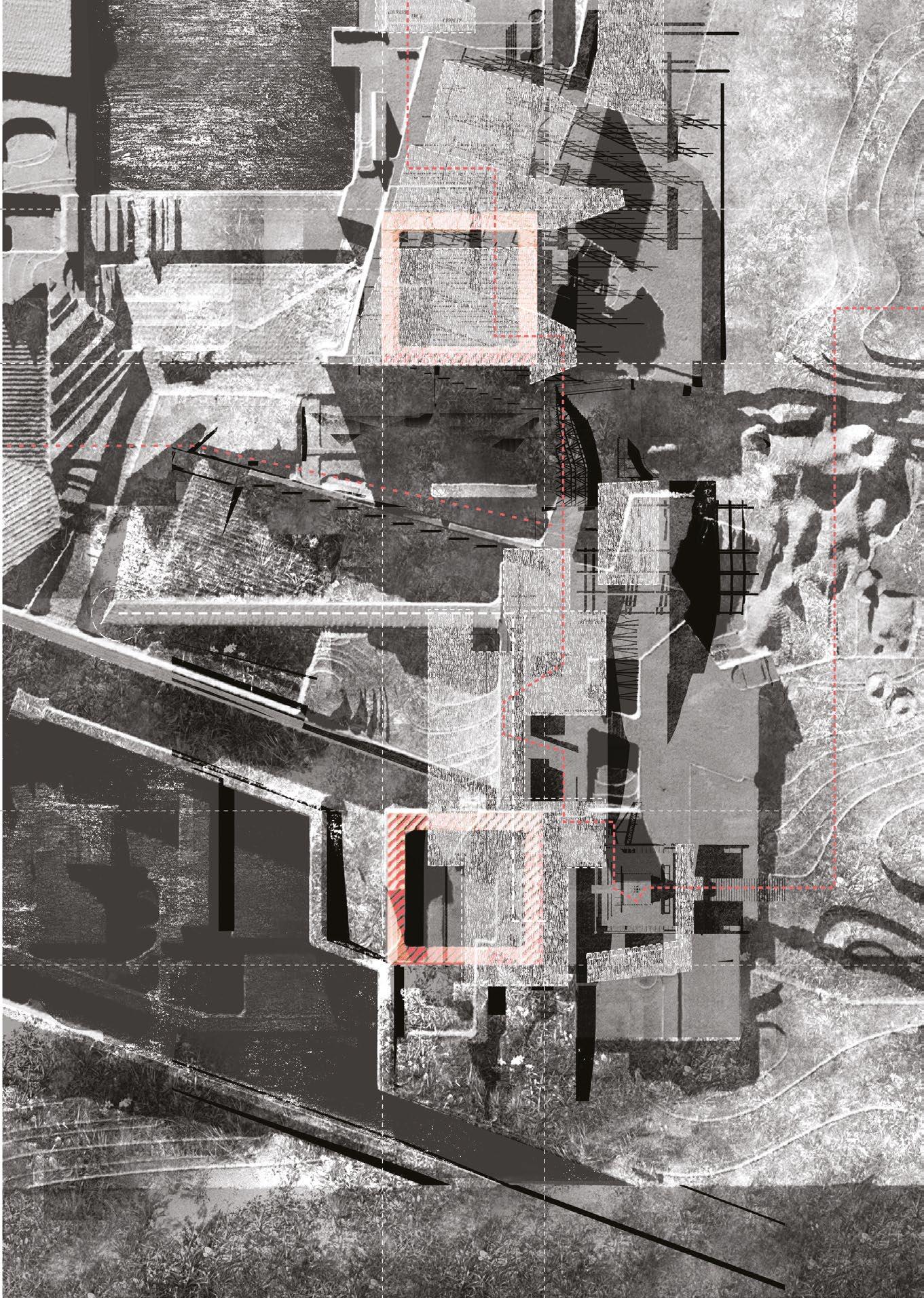
Fig.6.1 Theo Clarke Y3, ‘Philharmonic for Relics’. Cliffe Marshes, a landscape of decoys, becomes a wetland reserve hiding behind the guise of a controversial proposal for a new London airport. The project immerses itself within this political debate, creating a Potemkin airport to appease political demands, whilst simultaneously preserving the ecological diversity of the Thames Estuary. Fig. 6.2 Arina Viazenkina Y2, ‘Tollesbury Slowscape’. The sanctuary is embedded in the undulating marshlands of Tollesbury, exploiting the natural resources to create a unique environment for palliative care and physical wellbeing. Fig. 6.3 Victor Tsz Leung Y3, ‘Tilbury Future Climates Academy’. Powered by the neighbouring Tilbury Power Station, the school serves as an agricultural education facility for the local communities of Gravesbury whilst hosting
a number of smaller satellite campuses within the cityscape of London. Water serves as the protagonist of the building as it works to heat, cool and irrigate the agricultural production of a controlled, projected future climate to reflect impending climatic extremes. Fig. 6.4 Yo Hosoyamada Y3, ‘Supermarket Collective’. In a society of overconsumption and production, ‘degrowth’ proposes a counter-thesis focusing on cooperation, self-sufficiency, and ‘bottom-up' approaches. The project is a model for a cooperative community which sets itself on top of a supermarket. Parasitically attaching itself to the existing facility, the scheme imagines a landscaped intervention of symbiotic exchange systems between the existing and the new.


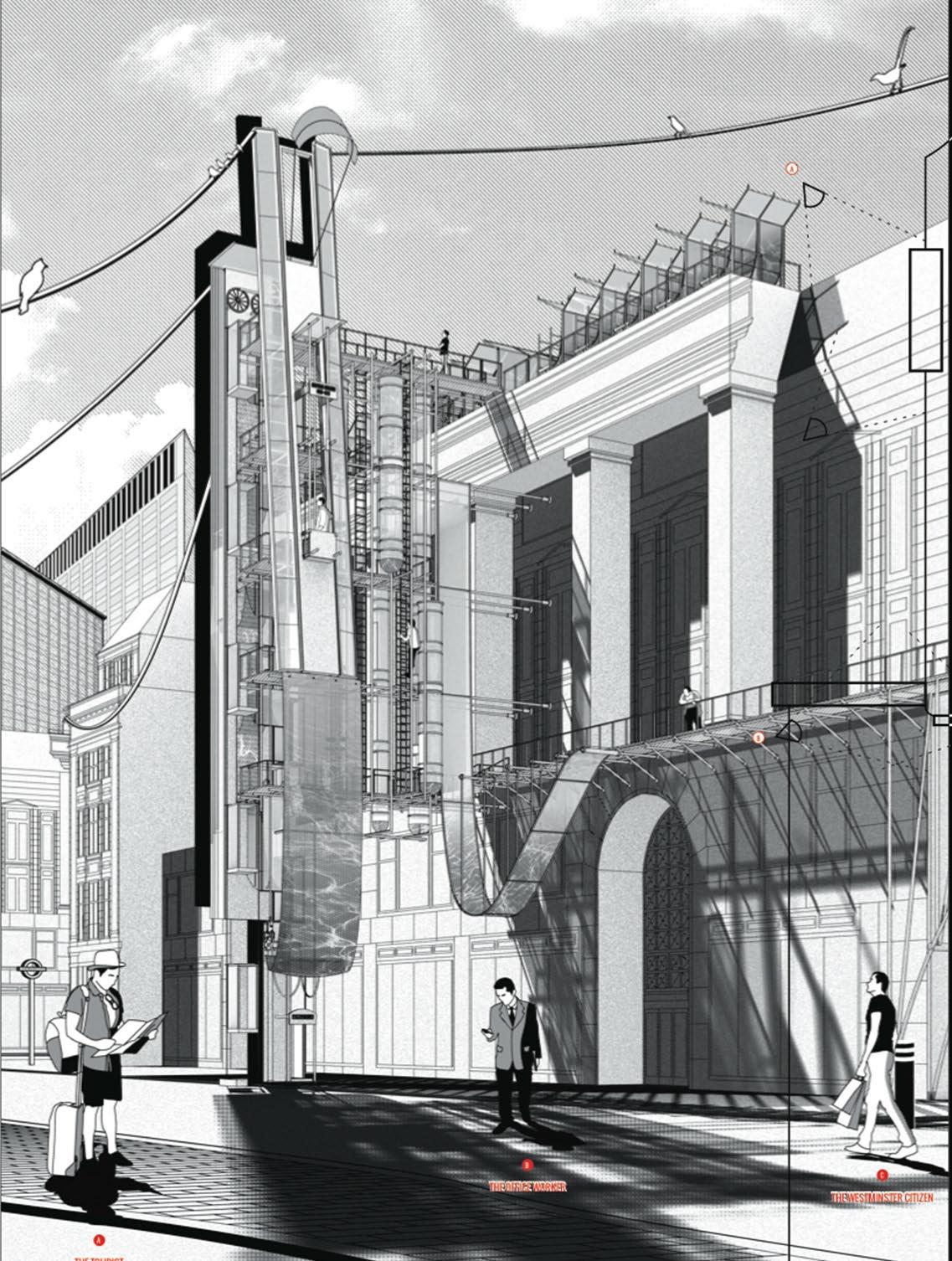
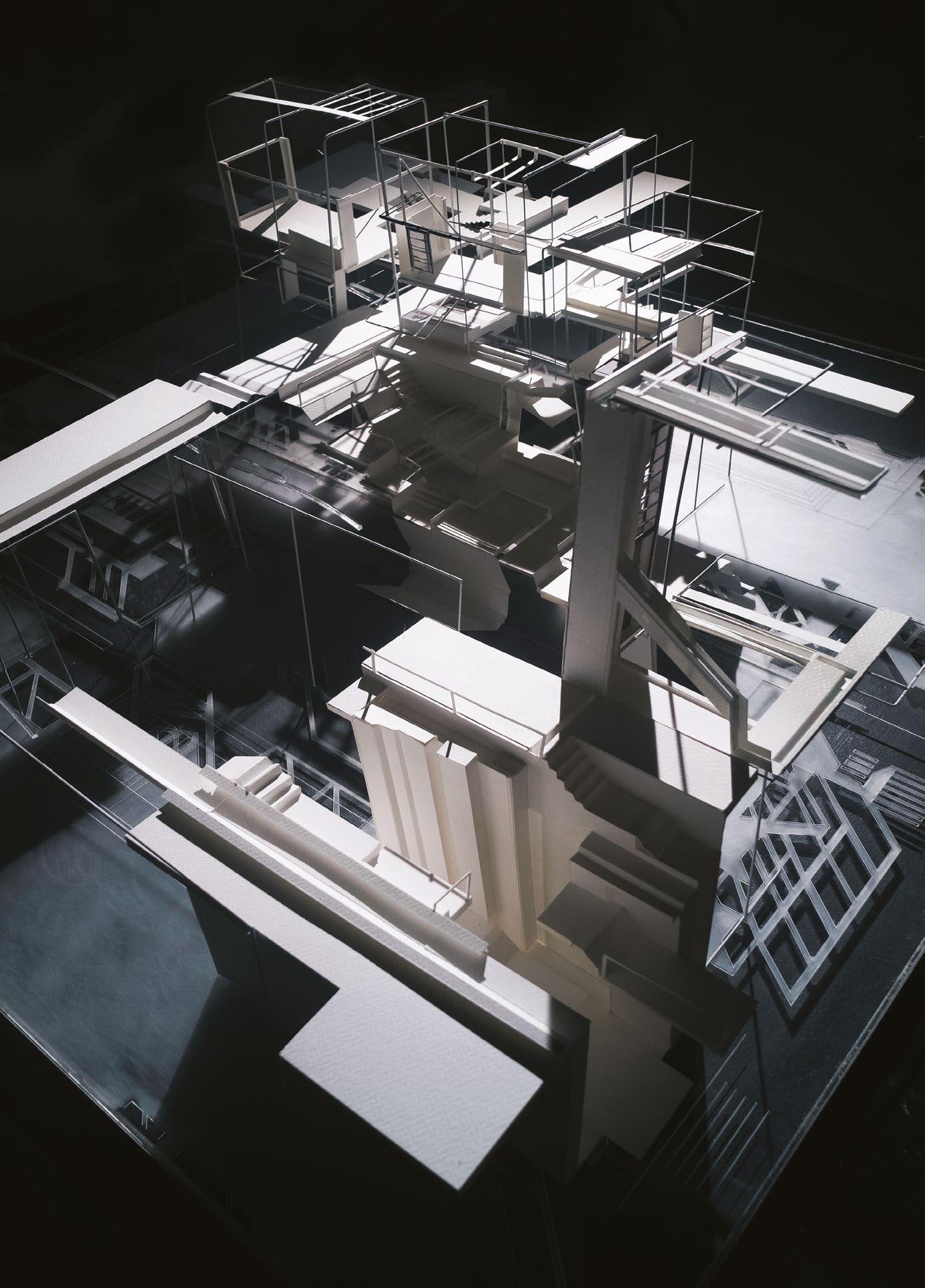
Fig. 6.5 Amy Kempa Y2, ‘Resorting to Malt’. Following the degeneration of Gravesend into a commuter town, the project aims to revitalise the area through the reintroduction of lost traditions and community. Malt production drives the building, recycling and reusing waste industrial water to provide a more public aspect of bathing to the otherwise private, industrial processes. Fig. 6.6 Imogen Ruthven-Taggart Y2, ‘Gravesend Pier: A Crafted Intervention’. The project introduces an open creative hub into the shoreline of Gravesend. The language of the interventions aims to bridge the gap between the surrounding industrial landscape and the developing residential town, introducing a place for the community to work, explore and interact. Fig. 6.7 Ching (Cherie) Wong Y3, ‘Gravesend Maritime Academy’. The academy is a critical commentary

on today’s cruise ship industry. The school provides training to local youths whilst exposing the wider community to the unique working environments of the cruise ship by repurposing dismantled parts of the iconic QE2. These typically less visible conditions of the cruise ship industry are highlighted to the public through a series of reconstructed theatrical sets.
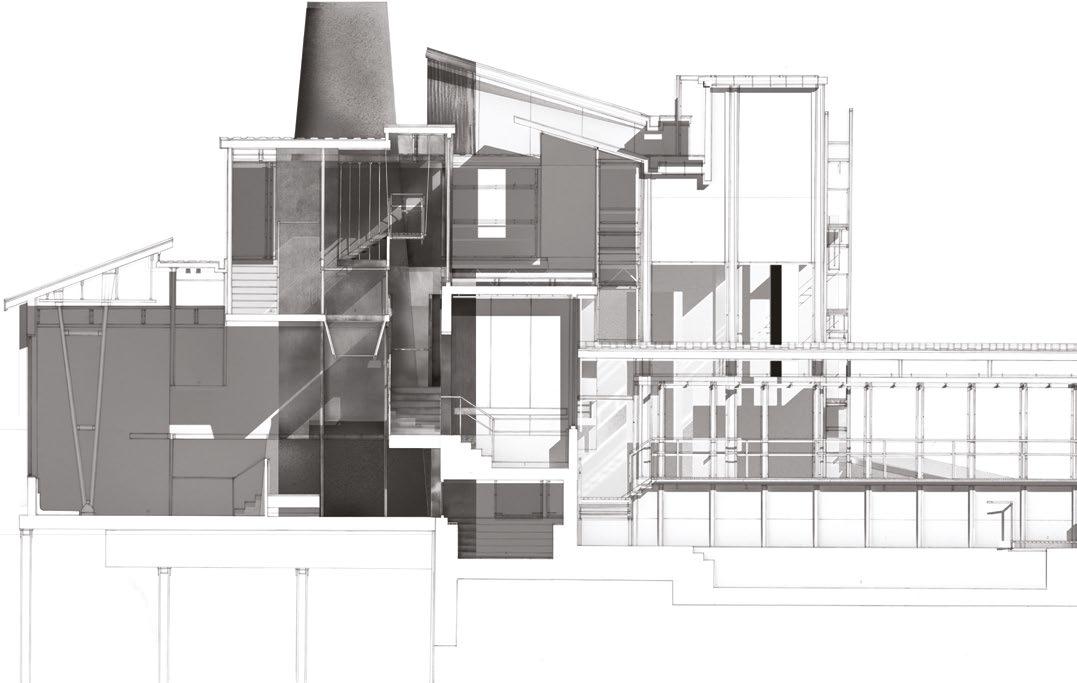



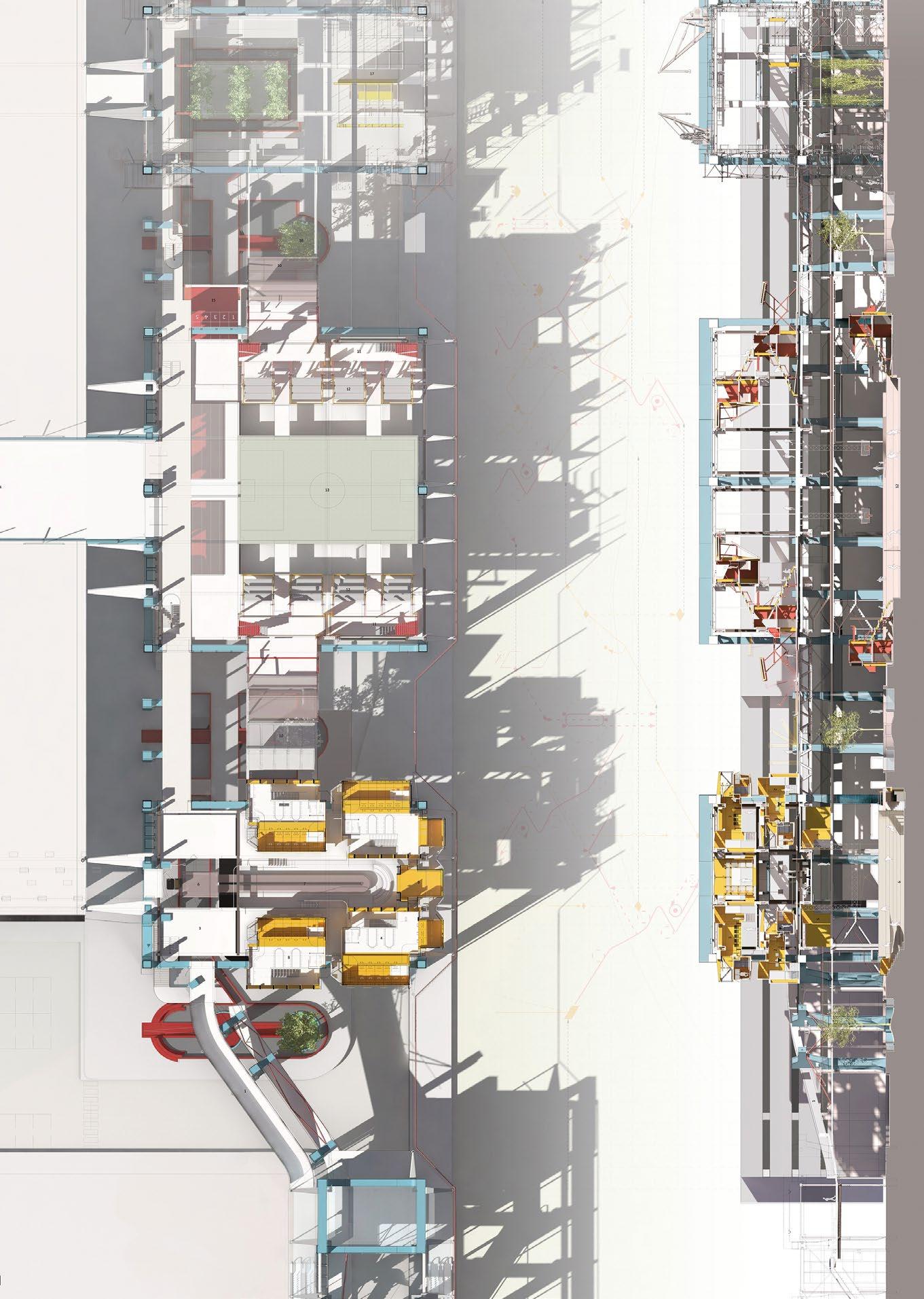
Fig. 6.13 Kenji Tang Y3, ‘Butcher by the Bay’. A lab-grown meat production plant and dining experience are embedded within Gravesend’s riverside leisure area and parkland, where the public can actively learn about the scientific processes behind the clean, environmentally responsible food produced onsite. In response to the growing concerns around meat consumption, the project combines two emerging bio-technologies – in-vitro meat and mycelium cell cultivation – to bring a feasible and appetising substitute to dinner tables. Visitors travel along a ‘blood vessel dining route’ within the building whilst enjoying a four-course gastro experience within suspended ‘dining cells’.
Fig. 6.14 Maxim Goldau Y3, ‘Homo Faber’. A growing community of craftsmen revive a barren plot between Tilbury and East Tilbury that has been violated for decades, used for landfill:
this land becomes a ground for industrial tree farming, revitalising local skills and manufacturing in timber production. The new forestry community explores the qualities of inhabiting the woodland, living symbiotically with its cyclical growth in the form of community-built slender modular tower structures, linked by elevated roads, constructed from harvested wood. The tree becomes a keystone of the architecture which forms the village’s constructed and natural fabric.
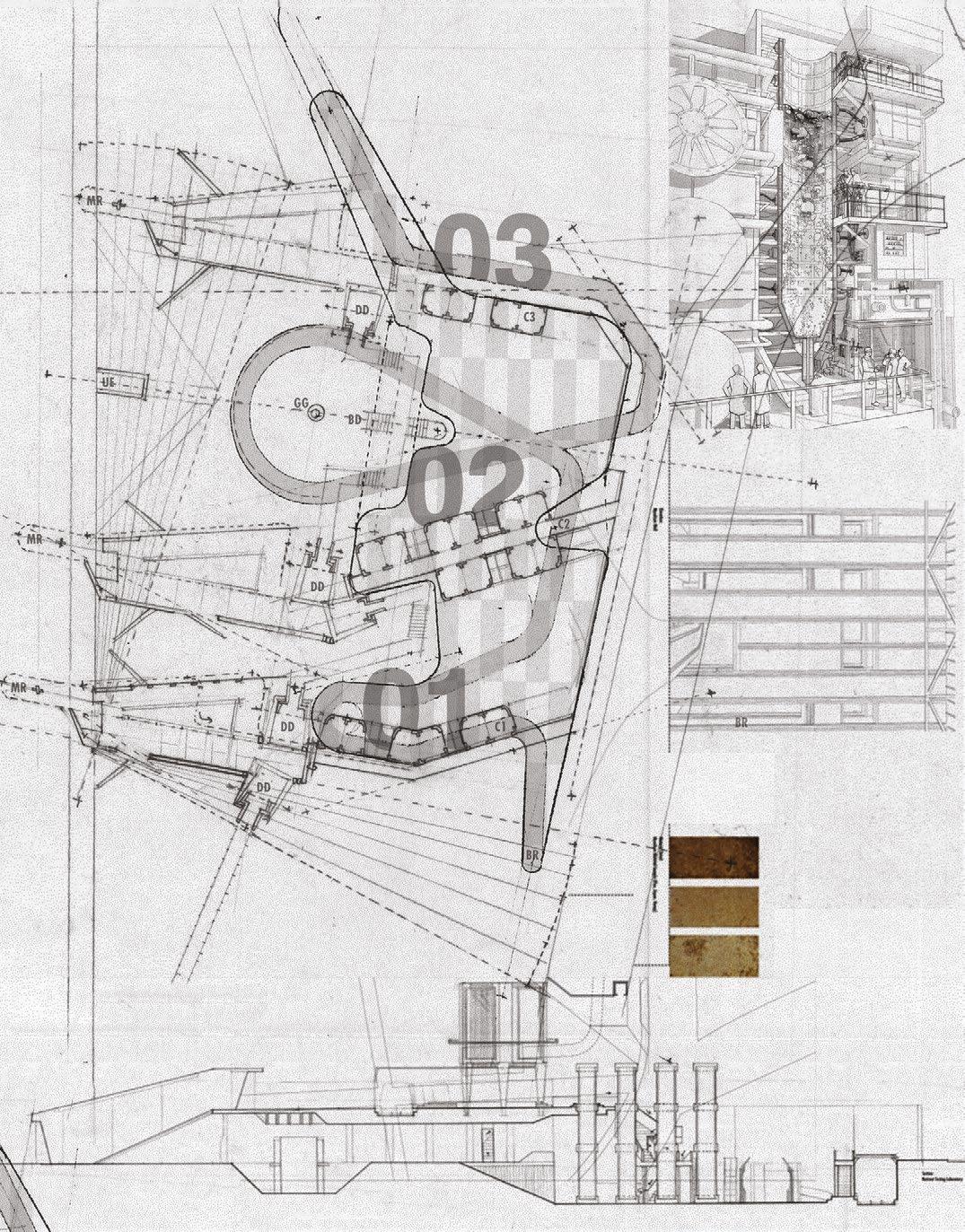
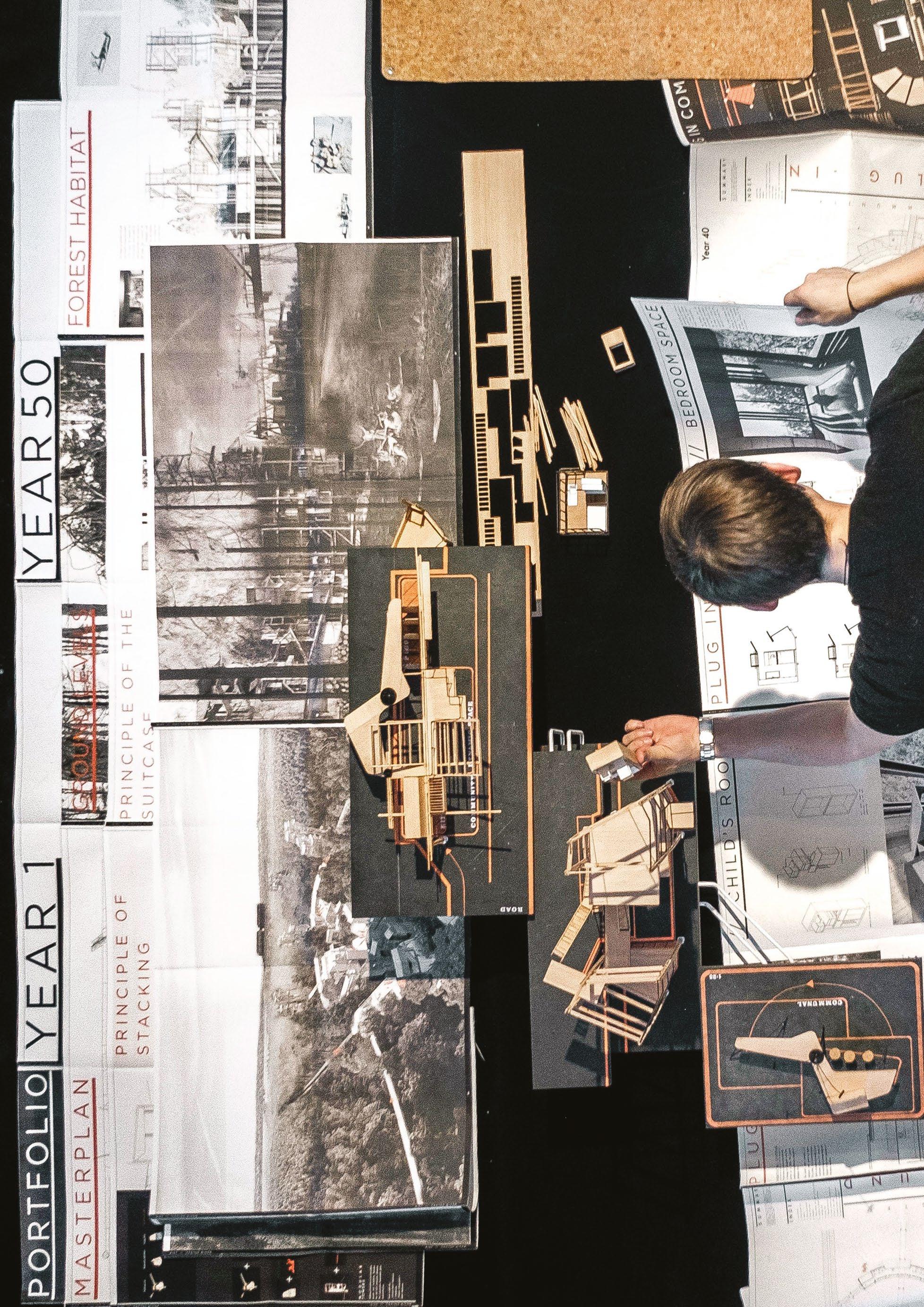
Drifting Cityscapes Tim Norman, Paolo Zaide
Year 2
Xavier De La Roche, Yee (Enoch) Liang, Gabriel Pavlides, Max Hanmo Shen, Negar Taatizadeh, Olivia Trinder, Gordon Yuk Yips
Year 3
Nikhil (Isaac) Cherian, Wing (Melody) Chu, Nichole Qi Ho, Kaizer Hud, Shi Yin Ling, Carolina Mondragon-Bayarri, Rosie Murphy, Fola-Sade (Victoria) Oshinusi
Thank you to: Christine Hawley, CJ Lim, David Roberts, Mike Tite, Patrick Weber, Peter Bishop, Sabine Storp, Stephen Gage, as well as friends of the unit: Emily Priest, George Courtauld, Ivan Hung, Jin Kuo, Joe Travers-Jones, Max Butler, Sam Tan, Yiki Liong, Yip-Wing Siu
Thank you also to our computing tutors Jack Holmes and Joerg Majer and our technical tutors Clyde Watson and Dimitris Argyros
Drifting Cityscapes
Tim Norman, Paolo ZaideWith today’s fragile borders being redrawn by identity politics, migrationrelated challenges are increasingly something architects must understand and respond to. Just last summer, we watched Rio de Janeiro open the 31st Summer Olympics to welcome athletes from across 207 nations. While the Games presented an opportunity to celebrate the coming together of the global community, other forms of migration today present far greater challenges: in the Mediterranean, the unfolding refugee crisis continues to strain both political and race relations across Europe, while in the US, the newly elected 45th president leads a populist campaign that promises to build an 3,100 kilometre-long “impenetrable, physical, tall, powerful, beautiful, southern border wall” to separate Mexico from the Land of the Free. Back in Britain, after a vote to leave the European Union, businesses begin to relax, as the grey-cloud prophecies of the end to free movement of labour have not yet come true – Brexit, of course, is still to come.
The question of migration might be a complex one, but this year’s theme was an invitation for our imagination to drift and to speculate. This century will see a dramatic rise in different types of migration, from communities escaping from the political or environmental conditions of their home to mobile people who choose to live in other parts of the world simply because they can. With the question of how future migrants will integrate, live and operate in their new host environments the unit continued to consider the organisation of communities, and to explore the architectural design of the individual and shared programmes, spaces and infrastructures. This year’s brief took the optimistic tone of Doug Sanders’ ‘Arrival City’, in which migration, and its inherent goal of resettling people, is presented as one of the great opportunities of our time. The brief was an invitation to explore this theme from the abstract to the poetic – and from the pragmatic to the fantastic. Where do these journeys begin? How do they unfold? Do they end, propagate or simply continue to drift?
The main brief for the year was a challenge to consider the Arrival City beyond the merely pragmatic – what is desirable? What levels of functionality would actually improve the quality of living in our city in fifty years’ time? And how do we integrate qualities of transience, flexibility and adaptation? In a cityscape with shifting territories and ecologies, mobile and settling communities, how do we design spaces that have practical, social and cultural value? What stories can future communities share? The work from the unit is filled equally with optimism, provocation and wonder.
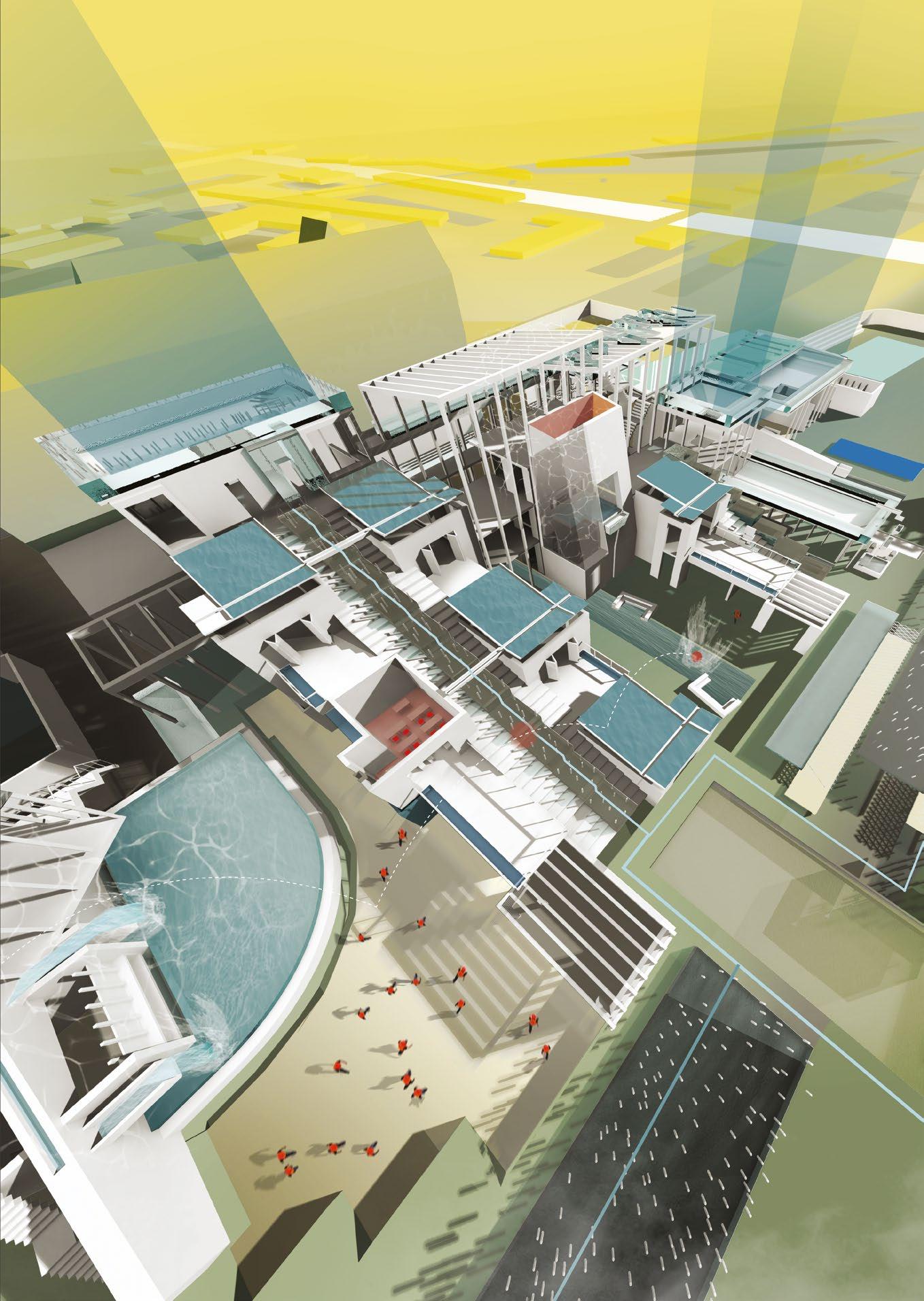
Fig. 6.1 Kaizer Hud Y3, ‘Stepney Hydrosensitive School’. The school aims to stimulate urban water sensitivity by positioning itself as a water recycling interface. Taking cues from Islamic architecture via the local Bangladeshi population, the water system is exposed to incite students’ curiosity. Captured rainwater and grey water from surrounding houses is filtered and used as a resource for play, learning and spiritual reflection. Fig. 6.2 Gabriel Pavlides Y2, ‘School of Landscape Design’. By placing the building along the canal in Mile End Park, students are encouraged to interact with gardens and greenhouses to influence the way people experience nature. Fig. 6.3 Olivia Trinder Y2, ‘East End Azulejos’. With old Arts and Crafts techniques re-emerging, the project encourages local communities to come together in artisan workshops and
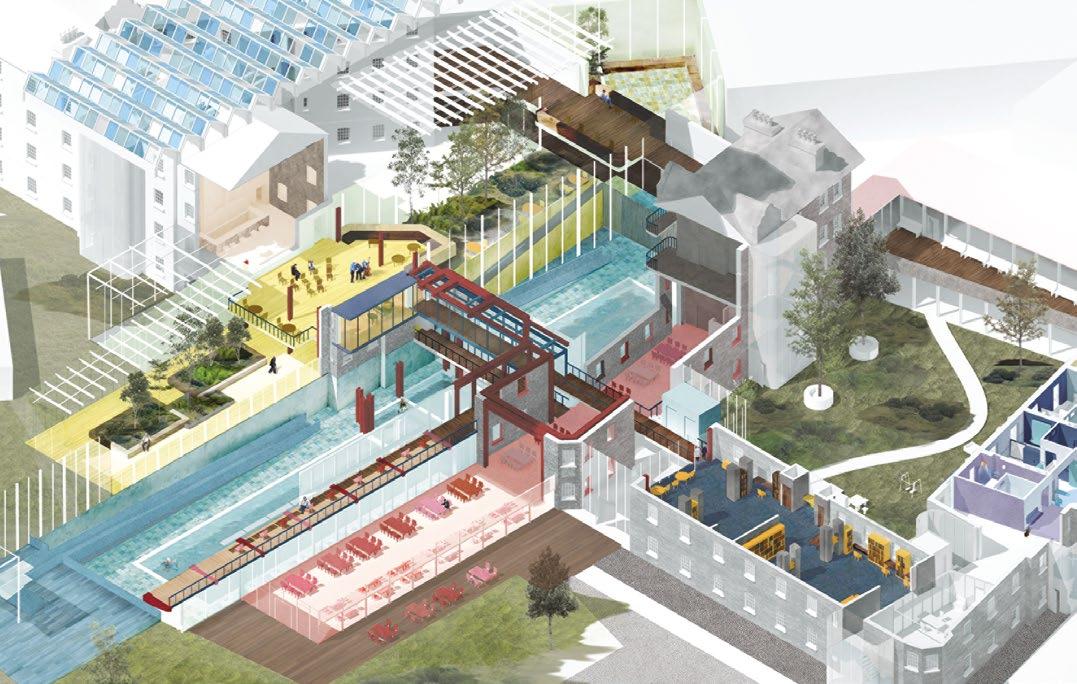
studios for the production of glazed ceramic tiles. Fig. 6.4 Wing (Melody) Chu Y3, ‘The Dunstan Elderly Centre’. The project redevelops two Victorian dwellings in Stepney Green into a mixed-use centre for the elderly, serving the existing residents in the context of the ageing population of 50 years’ time. Fig. 6.5 Nikhil (Isaac) Cherian Y3, ‘Whitechapel Craft Arcade’. As the Whitechapel Bell Foundry announces its departure, the project rejuvenates the future of craft by housing workshop spaces and yearly fairs as a twist on London’s affluent arcade shopping experience. Fig. 6.6 Nichole Qi Ho Y3, ‘Theatre for Storytellers’. A community theatre created as a space for stories to be told through performances and conversations, providing a shared experience to empower the voices of both immigrants and
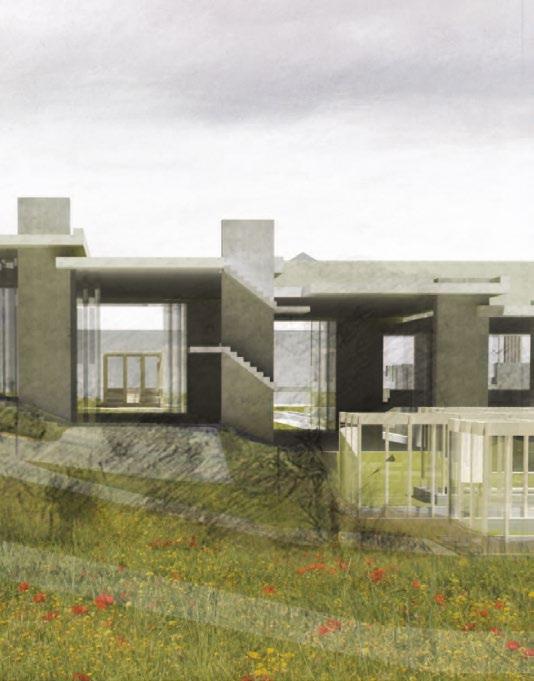

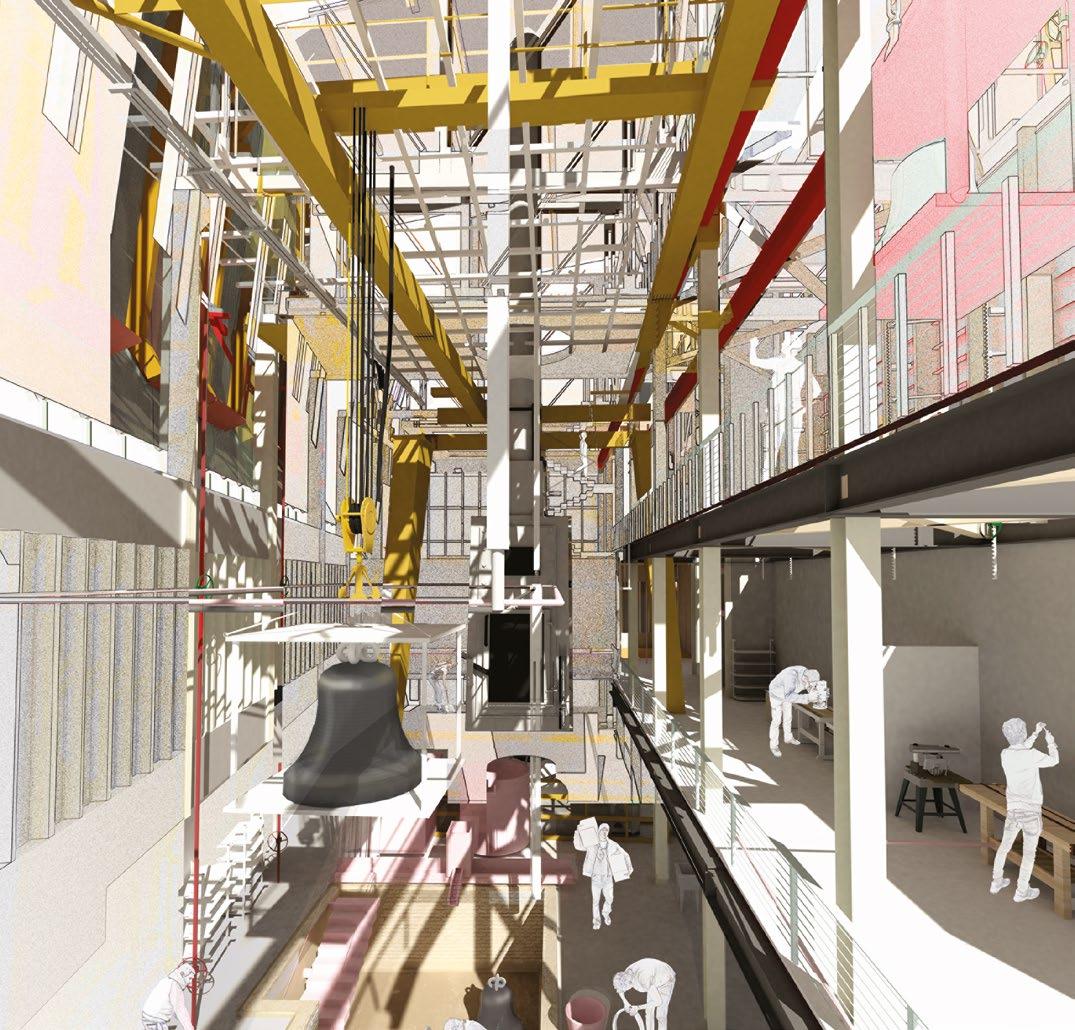

Fig. 6.7 Carolina Mondragon-Bayarri Y3, ‘Women’s Refuge’. An urban secret garden that assists newly-immigrated women to integrate into their new environment through blurring exterior and interior boundaries by manipulating light, sound and views.

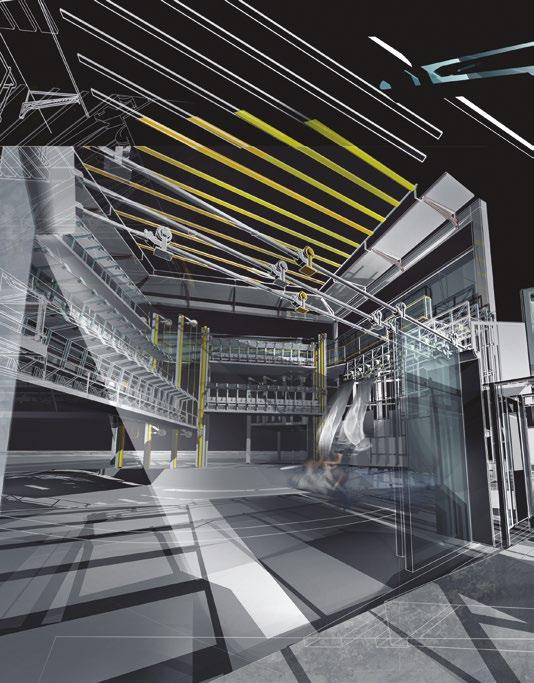
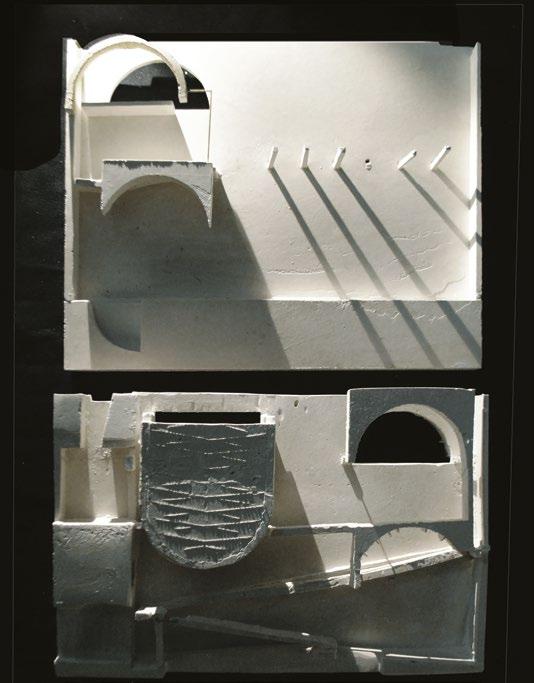
Fig. 6.8 Negar Taatizadeh Y2, ‘Theatre and Performance Spaces’. The project investigates the concept of the building acting as a theatre stage itself, creating surprising moments for visitors as they become part of the act. Fig. 6.9 Xavier De La Roche Y2, ‘Trading Archive’. Reoccupation of a 17th-century almshouse originally built for travelling seamen, and redefining its interior as a network of highly sculptural spaces to provoke a critique of the East India Company’s controversial history. Fig. 6.10 Max Hanmo Shen Y2, ‘City Farm of the Future’. An alternative city farm typology which also functions as a market
and a playscape that is woven through the stepped pastures of the market roof. Figs. 6.11 – 6.12 Fola-Sade (Victoria) Oshinusi Y3, ‘The Stepney Green Landscape of Transient Accommodation’. Providing three guest accommodation typologies existing alongside current residents, this project focuses on the spatial requirements needed to accommodate residents who will be staying on different timescales: from the long-term comfort and adaptability of existing residents to the short-term needs of overnight residents.



Figs. 6.13 – 6.14 Shi Yin Ling Y3, ‘Anchor Park Mixed Development’. The issue of migration pushes the city of London to grow outwards and upwards. The project instead proposes a low-rise, high-density residential development that integrates ecological density through an interweave of green courtyards and pockets. Fig. 6.15 Rosie Murphy Y3, ‘Intergenerational Agri(Culture)’. The project nurtures the passing on of traditions and knowledge of different cultures, and encourages intergenerational connections by incorporating greenhouses of varying climates that celebrate universally significant activities of growing, cooking and eating. Fig. 6.16 Yee (Enoch) Liang Y2, ‘Whitechapel Carpentry Guild’. The Whitechapel Carpentry Guild looks to revive the fading crafting culture by providing
a testing ground for woodwork that will eventually be constructed around London. Fig. 6.17 Gordon Yip Y2, ‘Adaptive Communal Housing’. A housing scheme focusing on adaptability for individual and communal interests.
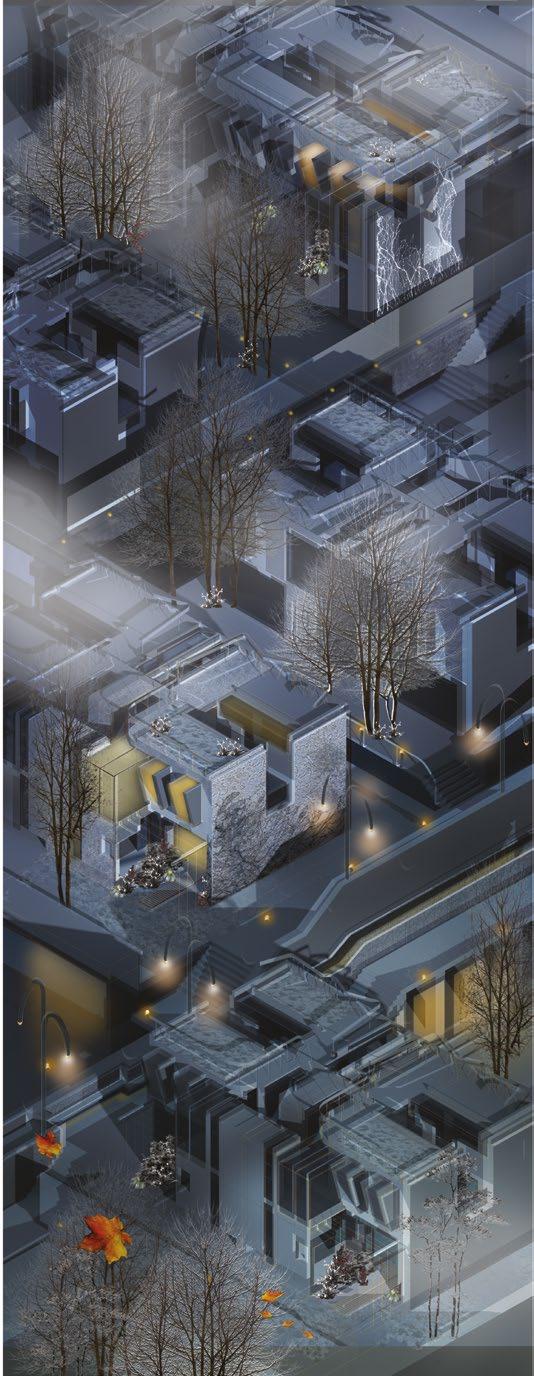


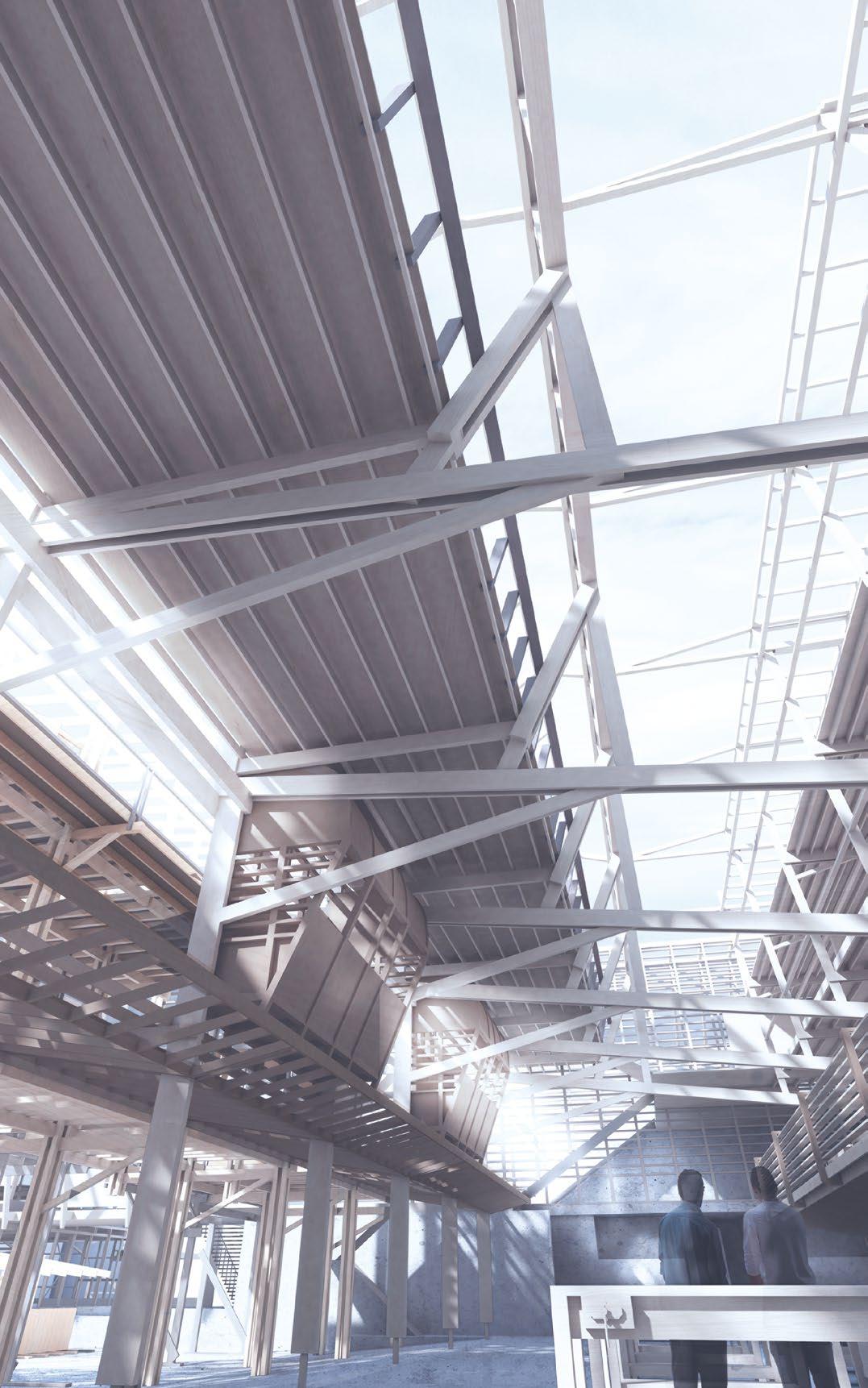

Indian Nose Reconstruction
Christine Hawley, Paolo ZaideYear 2
Alex Desov, Ashleigh-Paige Fielding, Dustin May, Edward Sear, Fan (Lisa) Wu
Year 3
Lester Tian-Lang Cheung, Deedee Pun Tik Chung, Ching Kuo, Xin Hao (Jerome) Ng, Hoi Lai (Kerry) Ngan, Yuchen Pan, Calvin Po, Yip Wing Siu, York Tsing (Nerissa) Yeung
UG6 would like to thank our friends and critics: Bartek Arendt, Abigail Ashton, Paul Bailey, Peter Bishop, Max Butler, Stephen Gage, Jamie Hignett, Alex Julyan, Jens Kongstad, CJ Lim, Anu and Shilpa Mridul, Tim Norman, Emily Priest, Sabine Storp, Joe Travers-Jones, Patrick Weber, Ivor Williams
Special thanks to our technical tutors Matt Springett and Clyde Watson
This year UG6 approached the issue of health from a cultural perspective, looking at both the clinical models of the West and the natural ‘life balance’, which is the more popular alternative across Asian continents. Health is currently a topical subject that, within the UK, can make or destroy political parties as current NHS provision becomes increasingly inadequate. A demographic change will challenge our understanding of conventional medicine and perhaps raise interesting discussions about alternative approaches.
This subject is not just an issue for politicians and the medical community but also for designers; history has shown that groundbreaking design can provide innovative care decades ahead of its time. In 1926 the holistic medical philosophy pioneered by Drs George Scott Williamson and Innes Hope Pearse was offered at the Peckham Health Centre. Both the building and the clinical support radically challenged the tradition of reactive medicine; it emphasised the importance of a socially, mentally and physically balanced lifestyle; it is only now that the wisdom and efficacy of their approach offers a concept that we should consider, if contrasted against the costly science of modern medicine.
In November the Unit travelled to India where we observed attitudes to health and traditional medicine that promote certain similarities to the Peckham Experiment through ideas of holistic well-being, where the body, the mind and lifestyle have to be in balance. Joseph Carpue, born in 1764 in London, studied plastic surgery in India for twenty years and was the first to perform ‘rhinoplasty’ or, as it was known then, ‘Indian nose reconstruction’. What do these medical cultures share and what might they offer us today? And is some of this thinking relevant to the health provision of the future?
The brief challenges concepts of collective and civic health and its place in the contemporary city. The students explored an alternative to the modern primary care centre, currently offering a service that responds only to illness and not to well-being. Why and when do we need medical advice and prescription and how can this be minimised? Set in future Peckham, the projects explored ideas about health and lifestyle that comments on all aspects of what we do, whether it be work, recreation or simply doing nothing.

Fig. 6.1 Deedee Pun Tik Chung Y3, ‘Hydro-Rehabilitation Centre’. This project incorporates hydrotherapy as a remedial treatment for both sports injury prevention and rehabilitation. Situated adjacent to the Peckham Library, the project offers a platform to host events and celebrations in Peckham. It includes diverse suspended water elements which promote mental and social wellbeing. Fig. 6.2 Dustin May Y2, ‘Peckham Food Centre’. Society has become disconnected with the food it eats. The project educates Peckham’s community on the food industry; from cultivation and growing to culinary classes and wider environmental impacts. Fig. 6.3 Fan (Lisa) Wu Y2, Peckham Convalescent Home’. The NHS is under high pressure due to the lack of continuity in social care facilities. Many argue that the current hospital environment is disempowering
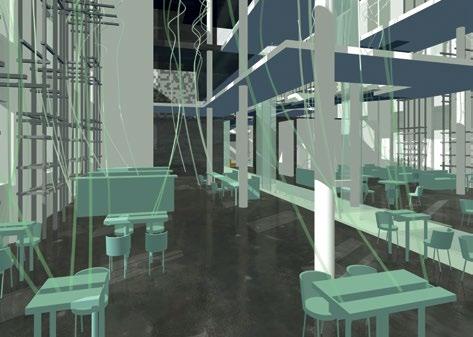


for patients, resulting in a slower recovery time. Therefore an intermediary recovery centre is crucial for the community of Peckham. Figs. 6.4 – 6.5 Ashleigh-Paige Fielding Y2, ‘Peckham Hydro-Health Centre’. Over the next fifty years, London will increasingly become a stressful environment. This project aims to weave in moments of tranquility into the urban fabric. The Peckham Hydro-Health Centre becomes the extension of Peckham Square, exposing the forgotten Surrey Canal. The issue of mental health is approached by a series of sensory moments suspended above a sculpted landscape, connected through the overarching theme of water.
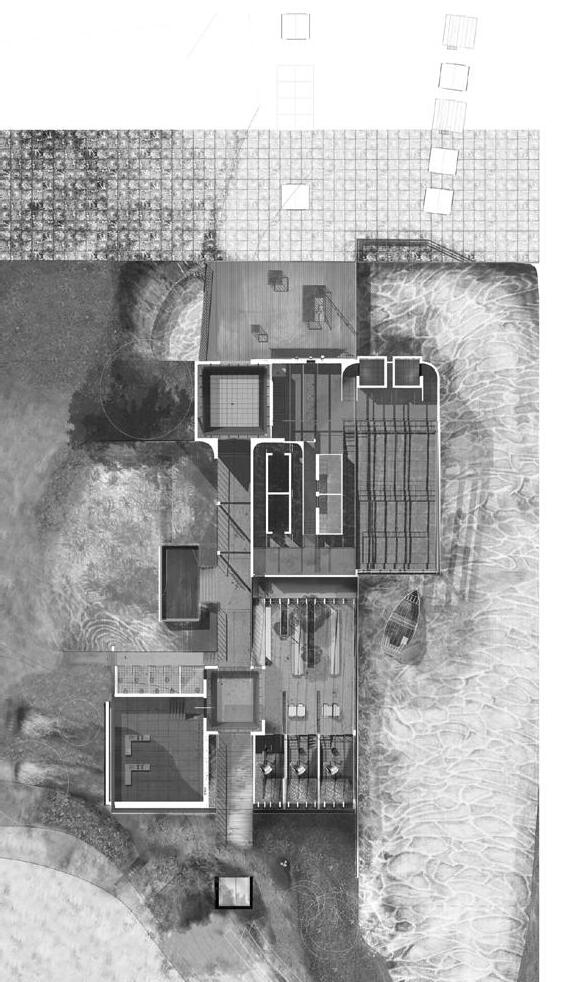
Ensure image ‘bleeds’ 3mm beyond the trim edge.
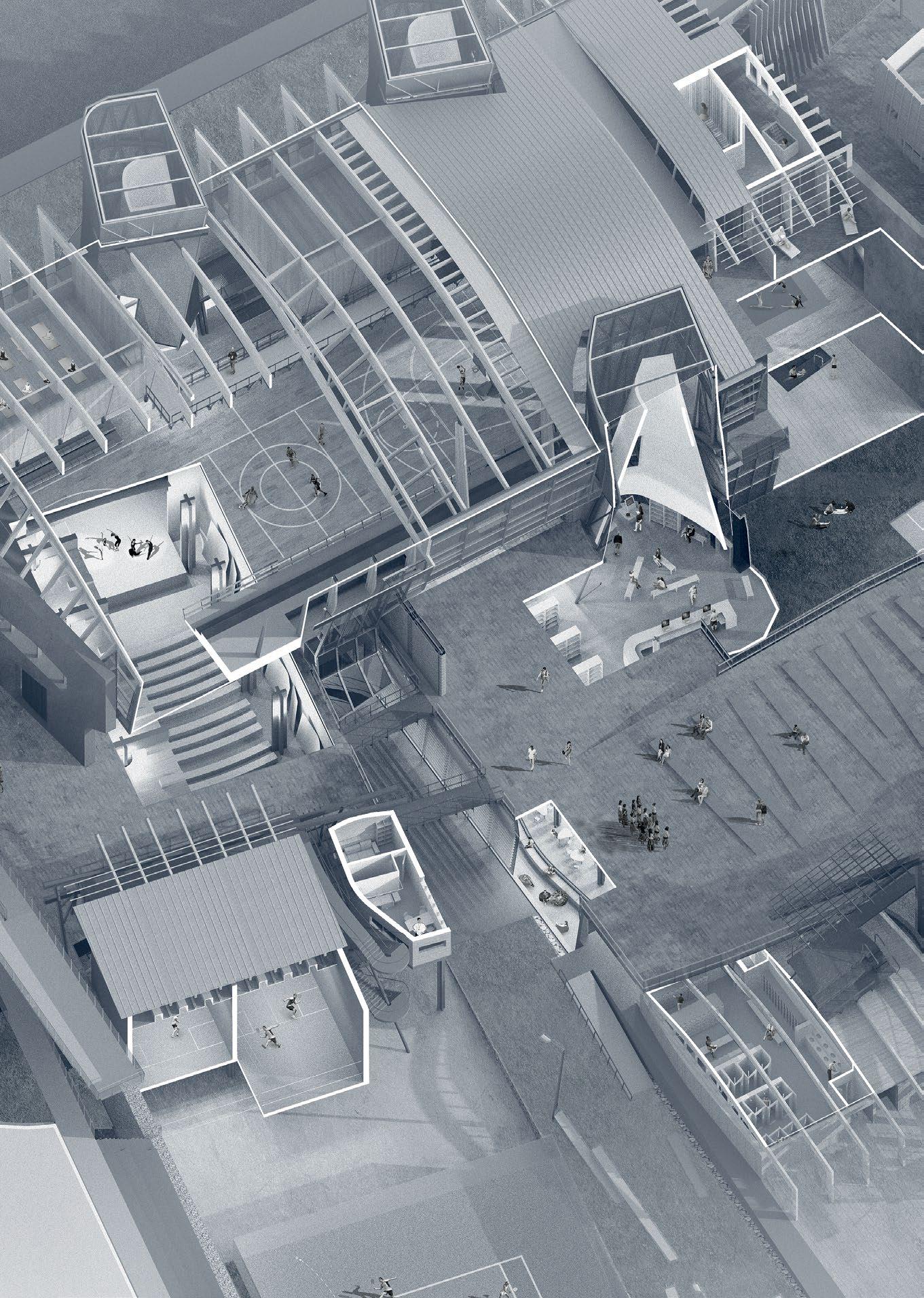
Fig. 6.6 Calvin Po Y3, ‘Peckham Health Common’. This project re-examines the contemporary relevance of ‘common land’ as an intersection of communities and a common site for the shared concern for health. It reinterprets the Peckham Experiment’s holistic, preventative approach in the context of healthcare’s present and future, combining sport, community life, leisure and medicine, acknowledging health as not only an absence of illness but a consequence of all aspects of living. Fig. 6.7 Xin Hao (Jerome) Ng Y3, ‘Peckham Hospice Care Home’. Situated in a Grade II listed building, the Hospice home provides care for people, enabling them to live the remainder of their lives to the full. Each unit offers views of the garden through the use of periscopes and movable façades and includes an additional room for family members.
Figs. 6.8 – 6.9 York Tsing (Nerissa) Yeung Y3, ‘Peckham Wellbeing Sports Centre’. Situated within the existing multi-storey carpark in Peckham, this project is an interpretation of the 1930s Peckham Experiment with additional cultural and recreation facilities. The building consists of transformable catalysts at varying scales which incrementally change this urban site into a vibrant centre for the community. Figs. 6.10 – 6.11 Lester Tian-Lang Cheung Y3, ‘Blind Community Centre’. The proposal aims to enrich the lives of the visually impaired by providing an environment for social integration and personal growth. The use of tactile surfaces and sound devices become the guiding principles to navigate through the building.
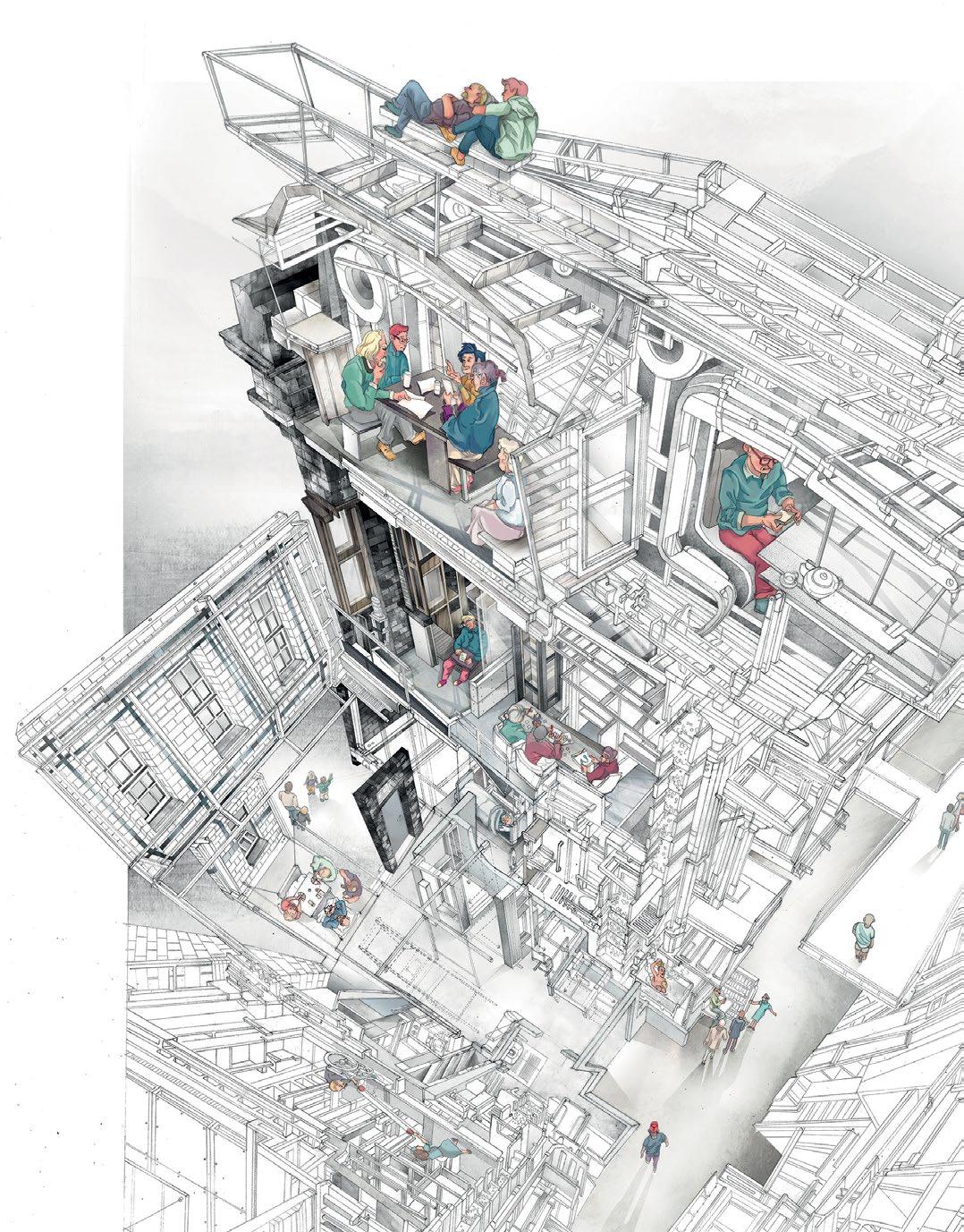

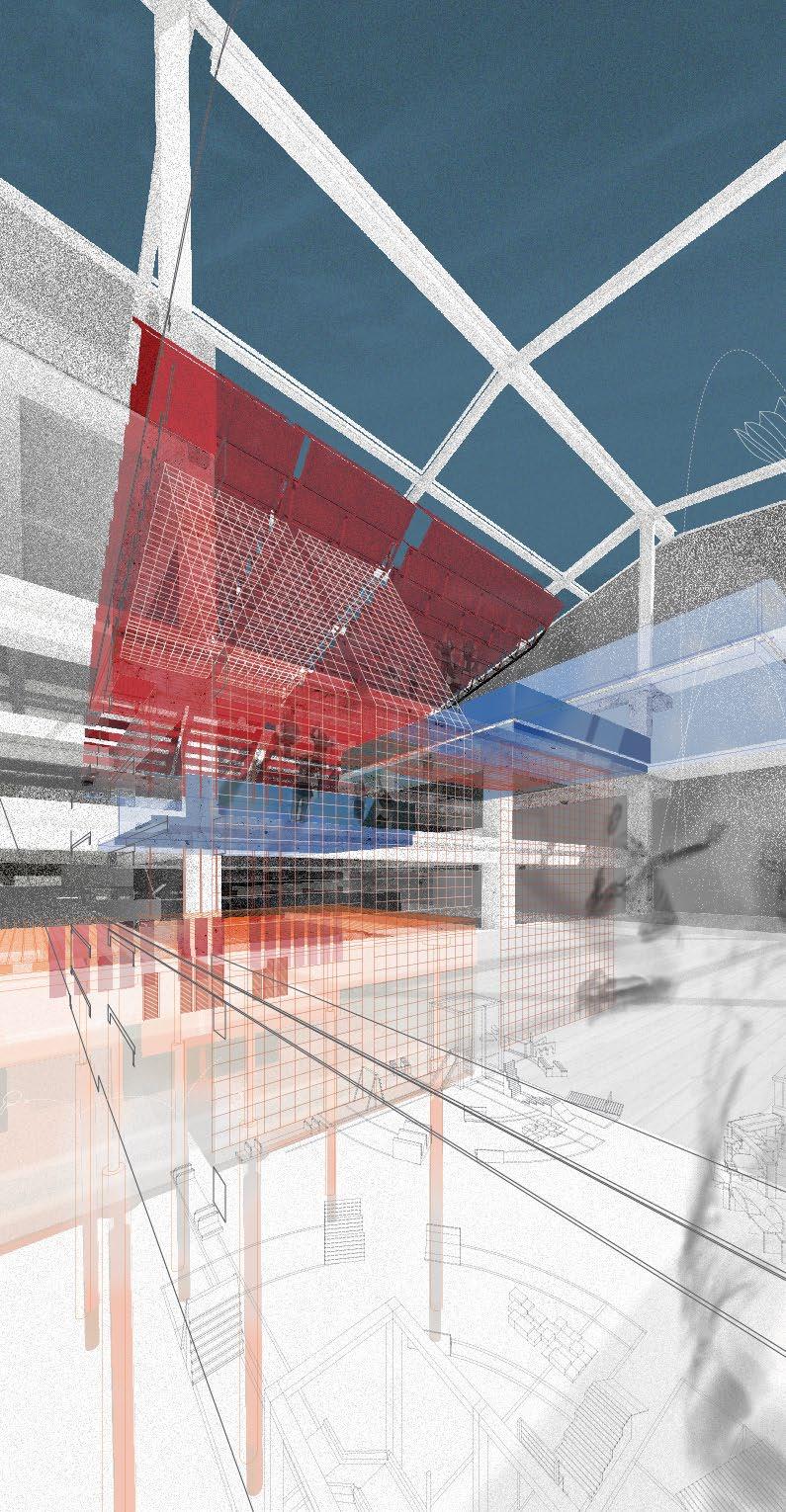
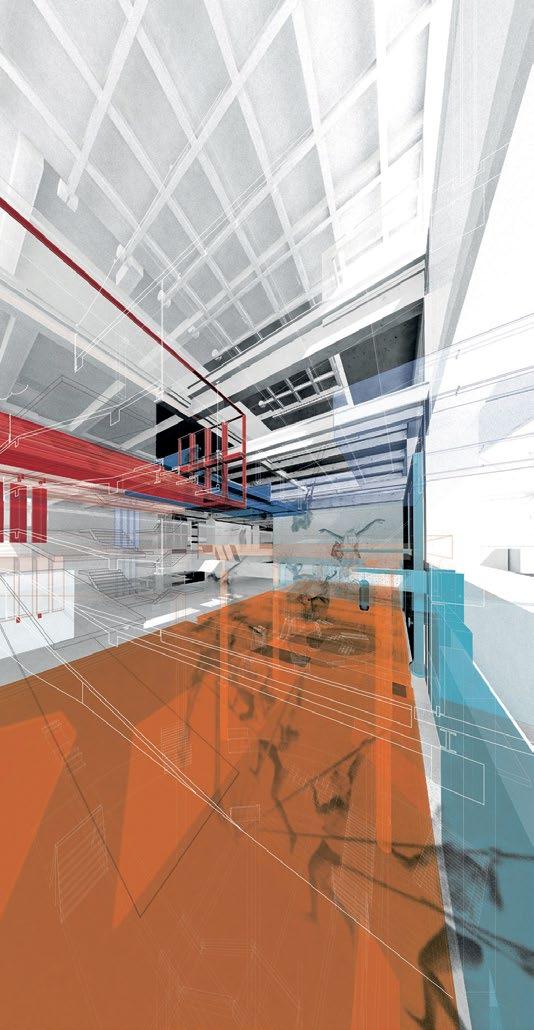

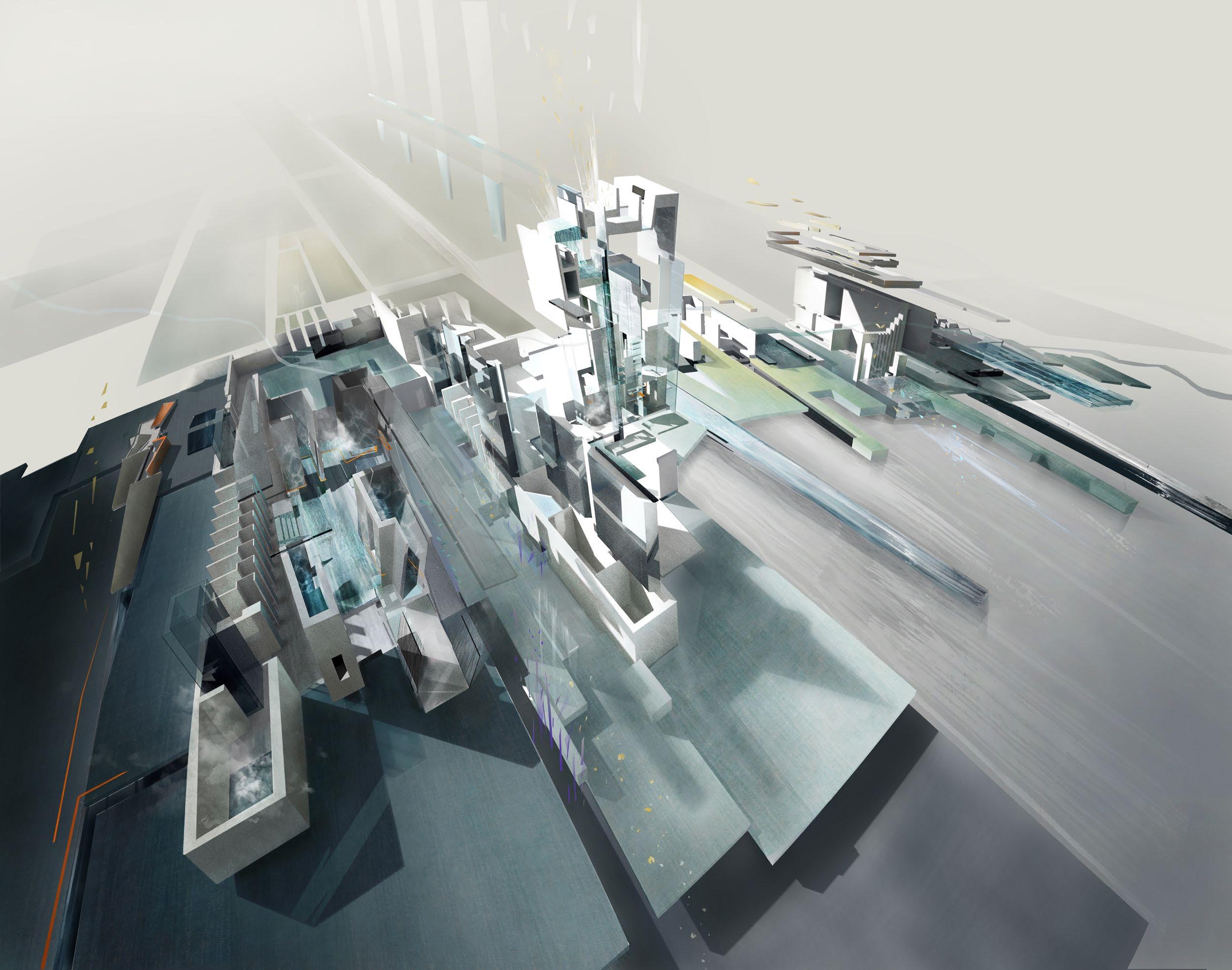
Fig. 6.12 Hoi Lai (Kerry) Ngan Y3, ‘Peckham Horizon’. The project responds to the needs of dementia patients through the sensitive use of landscape. SItuated next to the River Peck, the building becomes a repository of personal and historical memories. Pockets of garden and waterscape exude a tranquil and calming environment for the patient, caretakers and visting families with spaces arranged around common courtyards and personal rain rooms. Fig. 6.13 Alex Desov Y2, ‘Multicultural Healing Garden’. The project is a vibrant garden that brings together the diverse backgrounds and traditions that exist in Peckham’s dynamic streetscape. The garden combines a spiritual healing centre and museum, exhibiting a range of seeds, plants and natural environments. The building becomes a celebration of different beliefs and cultures.
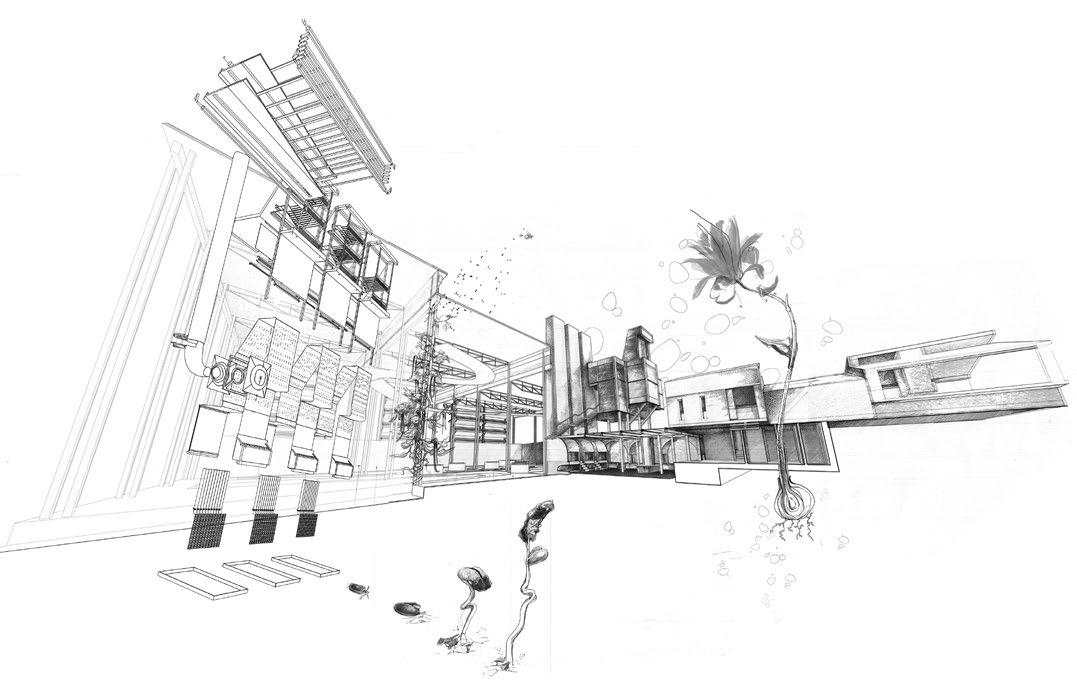

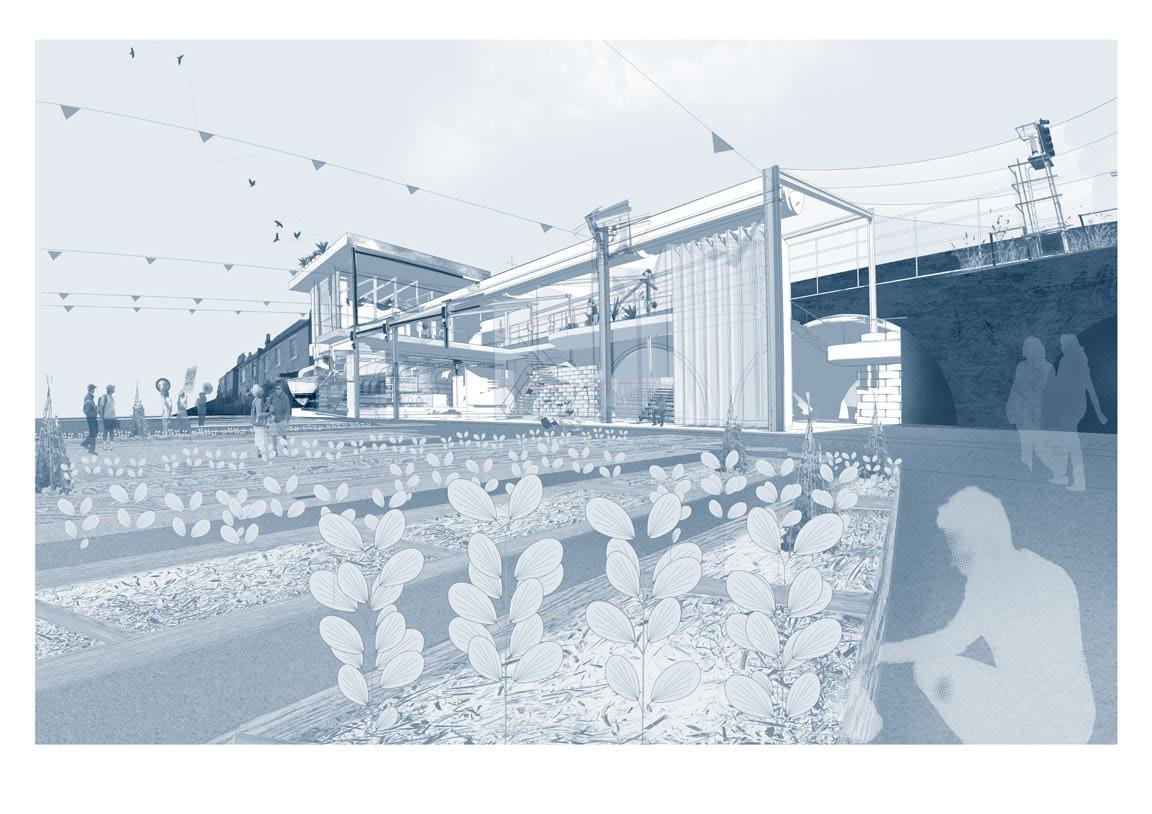
Fig. 6.14 Edward Sear Y2, ‘The Spike Community Centre’. With social interaction and community spirit key to maintaining mental health and wellbeing, the Spike Community Centre accommodates and employs the homeless people of Peckham. The programme focuses on breaking the users’ self-destructive cycles, through vocational training and fostering community activities. Holding regular events such as street parties, markets, pop-up cinema nights and arts/crafts workshops, the centre serves as a platform for the communities of Peckham to converge and flourish.

Fig. 6.15 Ching Kuo Y3, ‘Peckham Urban Farm’. This scheme redevelops a disused multi-storey car park into a series of horticultural spaces for educational purposes and recreation. The design seeks to demonstrate different growing conditions throughout the building, allowing people to understand a wider range of growing methods in the food production cycle.
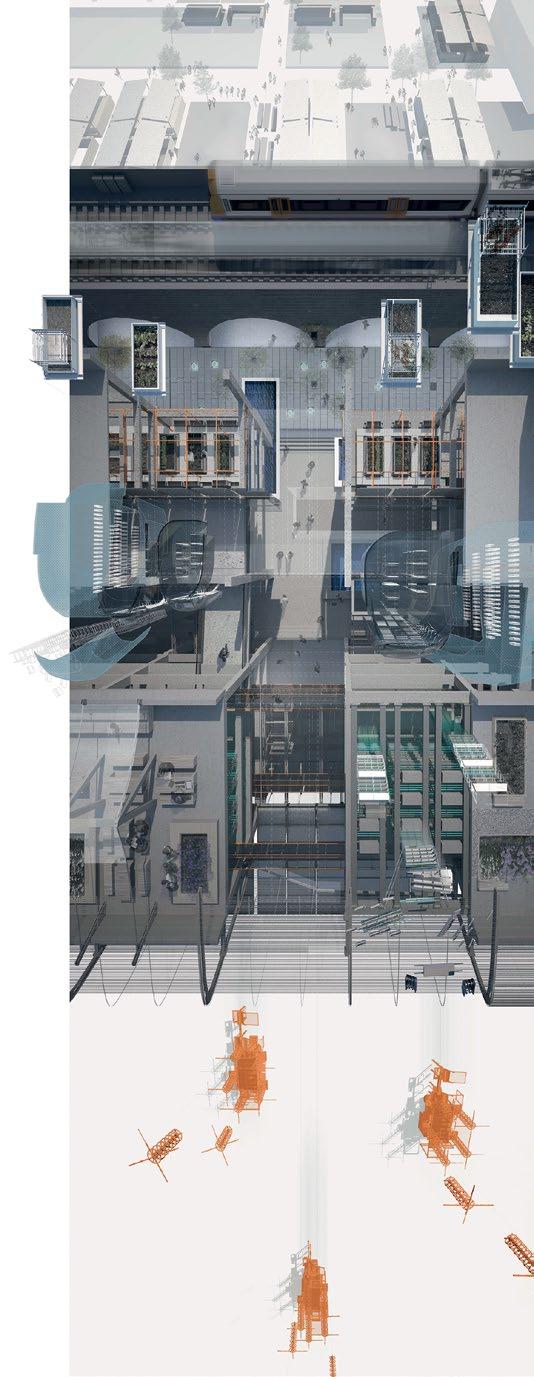
Fig. 6.16 Yuchen Pan Y3, ‘Asthmatic Clinic Centre For Children’. Located in a Grade II listed site, the project addresses the demands of children sufferring from asthma. Providing facilities and accomodation, alongside therapeutic environments, the building helps reduce the recurrance of asthma attacks. The insertion of different lightweight elements, indoor gardens and towers create a unique
environment filled with light and air. Figs. 6.17 – 6.19 Yip-Wing Siu Y3, ‘The Super-Able Housing, CIC’. With an ageing population expected to rise by 46% in 2029, the requirements of a rapidly shifting demographic applied on the NHS, social infrastructure and the built environment must be addressed. Sited in Peckham, this masterplan tackles London’s ageing demographic and shortage of public housing by promoting socio-physical wellbeing and community cohesion through an integrated agricultural social enterprise. Key to the proposal is the development of a ‘Lifetime Home’ which adapts to the four life stages that evolve to suit the needs of the young through to the old.
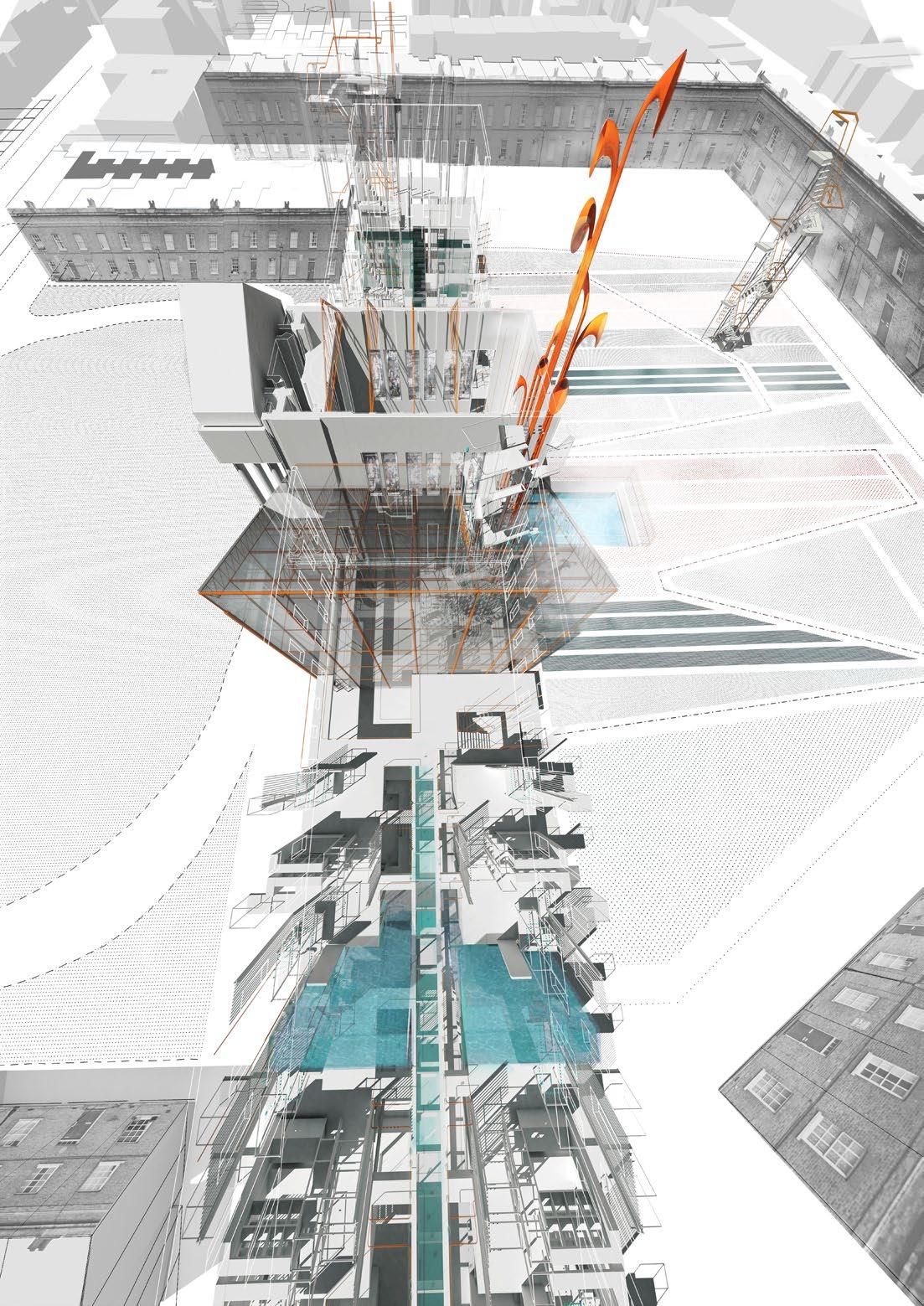
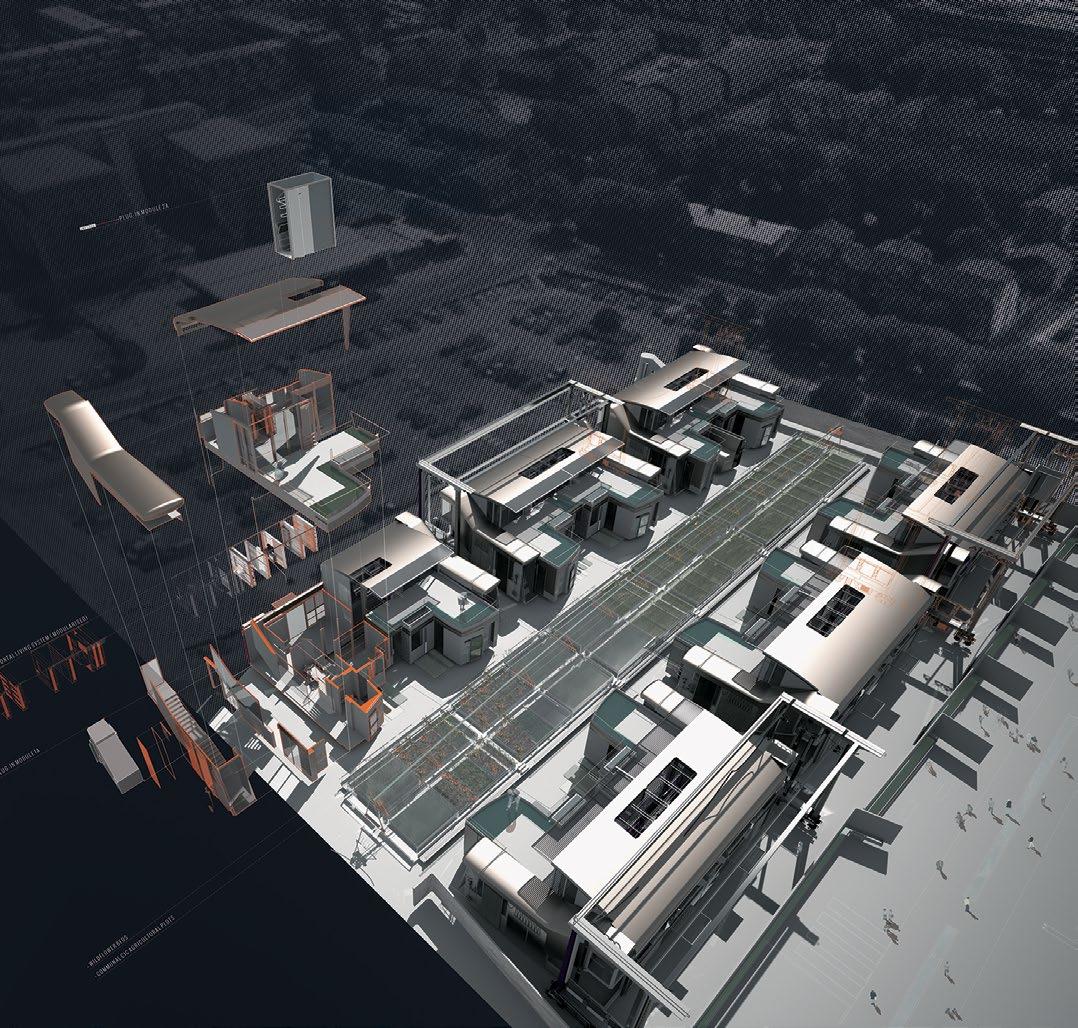


Hong Kong Reconsidered Christine Hawley, Paolo Zaide
Hong Kong Reconsidered
Christine Hawley, Paolo ZaideYear 2
Deedee Pun Tik Chung, Judy El-Hajjar, Stefan Florescu, Ching (Jin) Kuo, Xin Hao (Jerome) Ng, Hoi Lai (Kerry) Ngan, Yuchen Pan, Yip-Wing Siu
Year 3
Kamola Askarova, Grace Fletcher, Cheung Hong Ivan Hung, Lee Chew Kelemen, Yi Ki Liong, Aqsa Saleemi, Shi Qi (Kiki) Tu
UG6 would like to thank our technical advisor Matt Springett and our friends and critics: Peter Bishop, Julia Ran Chen, Nick Elias, Marta Granda, Carlos Jiménez Cenamor, Jens Kandt, Jens Kongstad, Sarah Lee, CJ Lim, Yeoryia Manolopoulou, Tim Norman, Farlie Reynolds, Clyde Watson, Yutaka Yano
www.unitsix.info
Hong Kong is one of the most densely populated cities in the world and may well be a model of future urban living if current population and migratory patterns continue. Land occupation will need to be considered with great care and perhaps a minimum footprint and sacrificial lower levels will become the norm. With the consequences of digital advances having revolutionised the way we work and socialise, we now have the opportunity to speculate about the changes that might affect the way we will live and operate in the next half-century. This year, UG6 raised questions about the nature of physical location and space: will we work remotely, will there be the need for commuting, how will social organisation work, and what effect will this have on our forms of habitation? Hong Kong Island, Kowloon and the New Territories are a unique blend of historic colonial past and current Chinese culture, in some ways a microcosm of fast-paced emerging multicultural communities, and the current pressure on land utilisation has already demonstrated how unlikely patterns of function can coexist.
The emphasis on the use of vertical space and Hong Kong’s space restrictions requires both ingenuity and imagination. There are currently many buildings in Hong Kong that through circumstance have brought together residential, commercial and leisure functions, and thirty-five years after its publication, Koolhaas’ Delirious New York has become an Asian reality. The utopian model of a tower containing all that is needed to maintain a community may have seemed implausible in the late 70s but this architectural conjecture has proved remarkably prescient. Gary Chang’s 24 rooms in 32 square metres will probably be a model needed in the urban compression of the future, and the notorious Chungking Mansions offers a glimpse into a lifestyle where commercial expediency has created a dystopian world of undesired residency. Both examples have emerged through circumstantial need, but the former is an imaginative design response and the latter the product of commercial exploitation.
The main brief for the year challenged the unit to consider beyond the merely pragmatic – what is desirable, what levels of functionality would actually improve the quality of living in fifty years’ time, how can one measure quality in a context with so many physical restrictions. The programme offered an opportunity to consider radical models of habitation for the future where methods of travel might be airborne; places of social interaction reconsidered; and home, work and leisure environments undifferentiated. Hong Kong is vibrant and complex and many of its qualities are both critically difficult and critically inspiring.
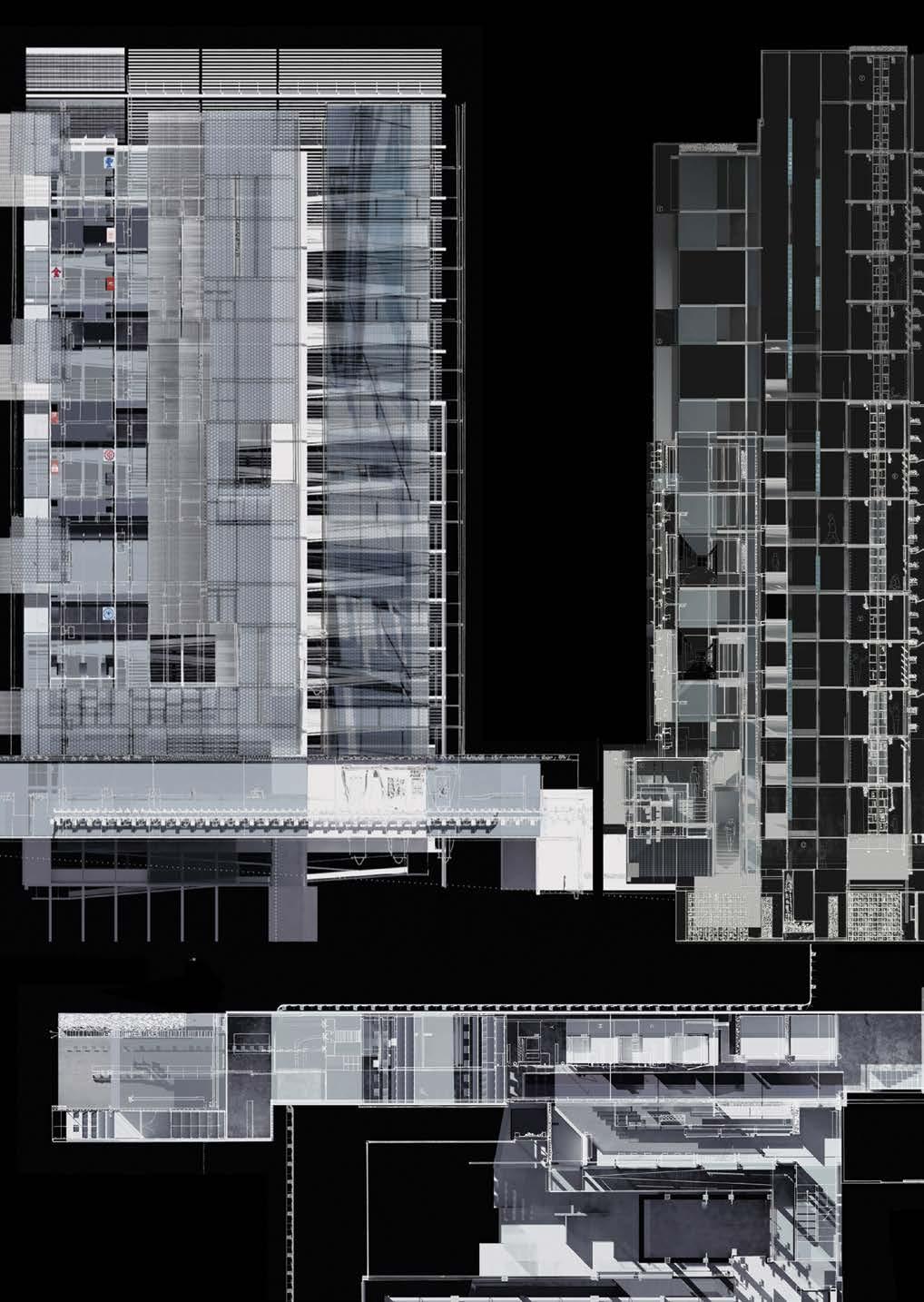
Fig. 6.1 Yip-Wing Siu Y2, ‘Dai Pai Democratic Press’. The Democratic Press acts as a series of public spaces that serve to provoke and inspire free, uncensored discussions on the city’s politics and social wellbeing. The library tower and archive are dedicated to democratic material and act as a celebration of knowledge accessible and embedded into the heart of city. Fig. 6.2 Cheung Hong Ivan Hung Y3, ‘Cinema of Light 2065’. This project reinterprets the city of light into three types of cinematic engagement with future Hong Kong, using natural, artificial and virtual light manipulations. Sited in the heart of Mong Kok, the proposal includes both outdoor and indoor cinema, leisure facilities such as bars, restaurants, film archival spaces and projections in various part of the building.

Fig. 6.3 – 6.4 Deedee Pun Tik Chung Y2, ‘Vertical Transparency - Gym’. A multipurpose sports complex set adjacent to the mid-level escalators in Central. Taking advantage of the site’s natural greenery, the programme acts as a getaway from the city’s fast-paced rhythm and serves as an educational facility that encourages a health-conscious lifestyle. Fig. 6.5 Hoi Lai (Kerry) Ngan Y2, ‘Shan Shui Retreat’. The ‘Shan Shui Retreat’ is dedicated to promote public health among the densely populated area of Central. The project provides generous green spaces and different water-related activities which focus on physical exercise and mental relaxation. Narrow but experiential corridor spaces create dynamic and reflective waterscapes set within the hard city fabric.
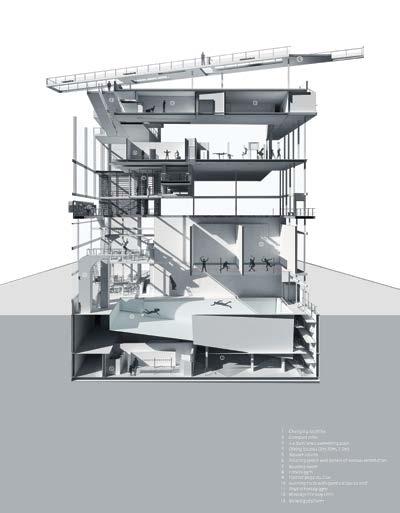
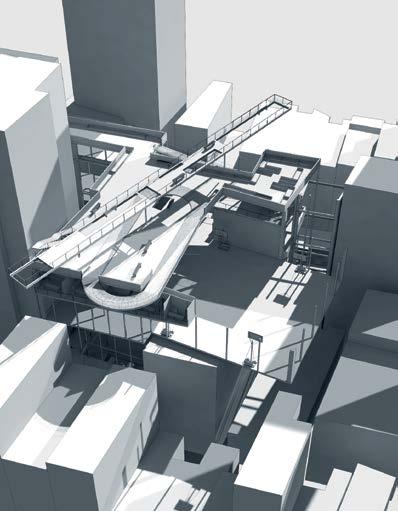
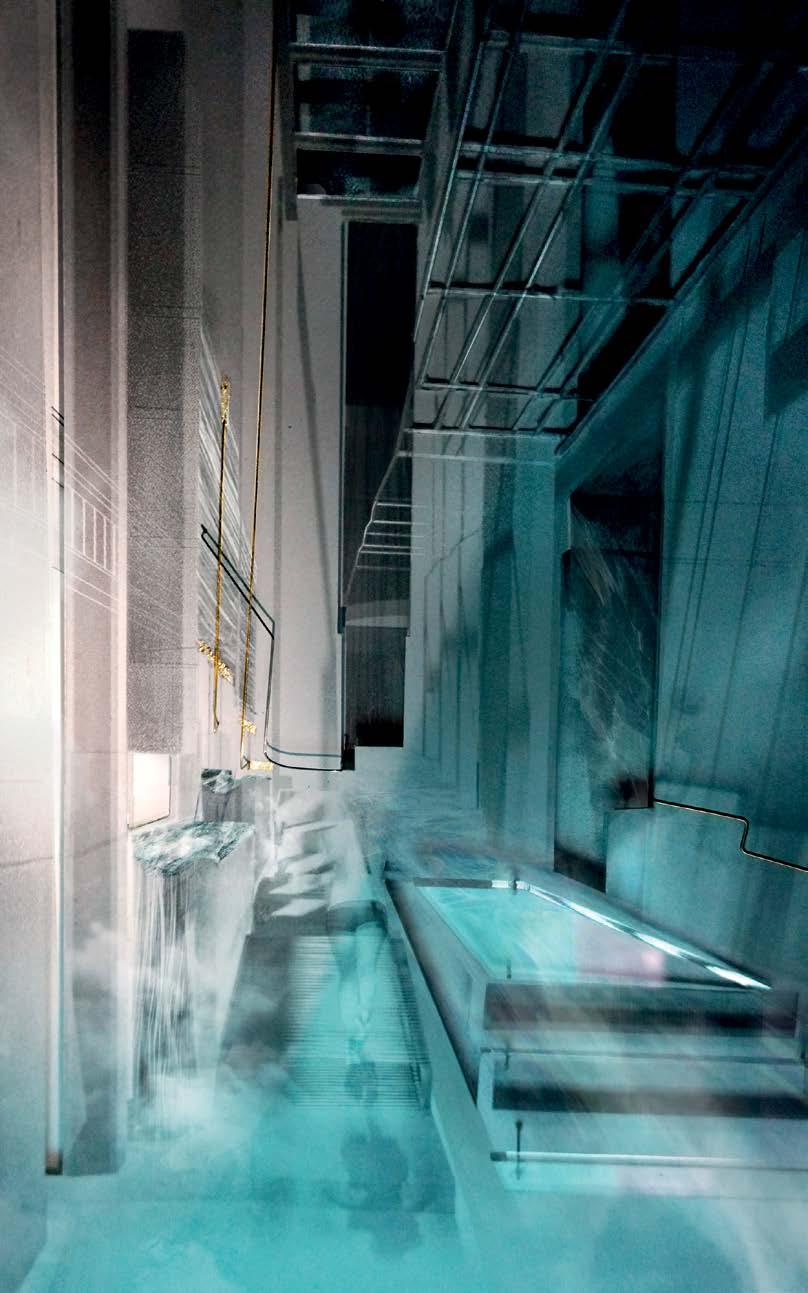
Figs. 6.6 – 6.8 Grace Fletcher Y3, ‘Hotel’. The project aims to provide a calm sanctuary within the vibrant metropolis. The hotel caters for different transient communities offering three different types of accommodation for a one-night, one-week or one-month stay. The use of fabric as a construction material has developed an architectural language, which facilitates the controlled dialogue between the visitor and the city. Figs. 6.9 – 6.10 Xin Hao (Jerome) Ng Y2, ‘Mongkok 2065 Elderly Home’. This project explores the modular design for the independent elderly people and adjacent housing for their family members. Each unit offers multiple views of the city through the use of periscopes and movable balconies. The complex also includes gardens and facilities for eating and
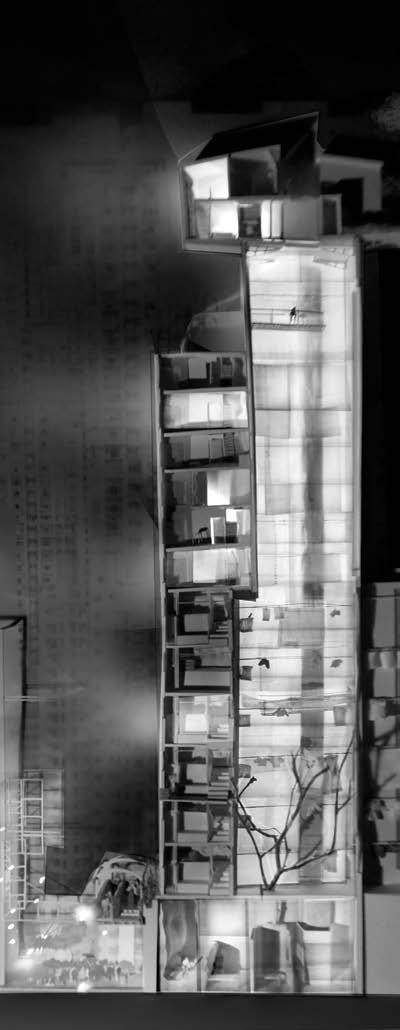
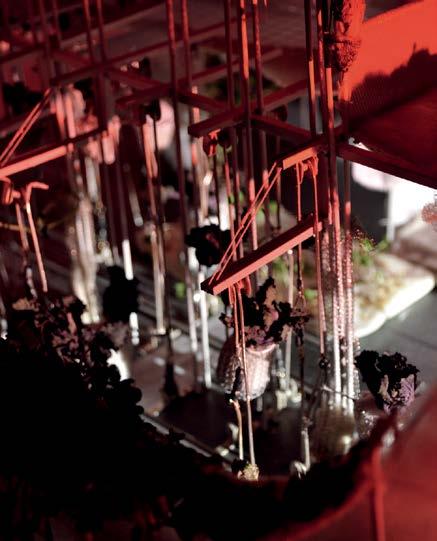
leisure that open up to the wider local community. Fig. 6.11 Judy El-Hajjar Y2. To counter the depreciation of markets and natural food sales in 2065 Hong Kong, a floating market bridge will help promote a modern way of grocery shopping, just minutes from home. The project reveals an exploration of the senses. Pollution from the city below does not reach the Hong Kong market due to its high altitude. Fig. 6.12 Stefan Florescu Y2, ‘Mong Kok Bamboo Centre’. The Centre is dedicated to bamboo as an indispensable raw material that can be used across the fields of construction, gastronomy and the arts. The project is linked to an existing school to provide gardens and spaces for learning, and in addition offers public exhibition and community spaces. 6.7
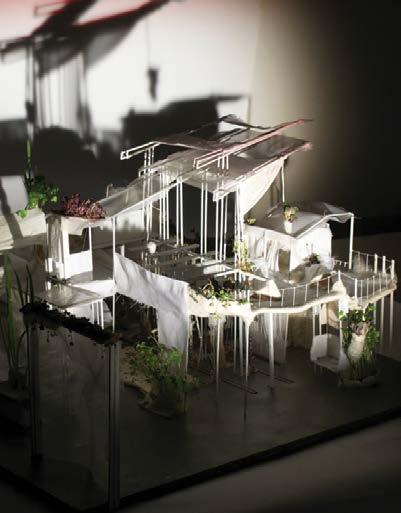

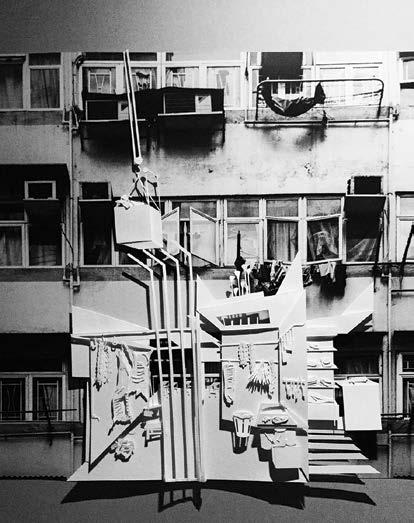


Fig. 6.13 Lee Chew Kelemen Y3, ‘Mong Kok Autonomous Bath-House’. The brief challenges Hong Kong’s current form of water management. The introduction of an urban wetland and bath act as a potential prototypes to harness water by collecting, filtering and reusing water to reduce the reliance on imported water while introducing and triggering social interaction through water-based interventions. The scheme is a celebration of the resource of water that creates an idyllic escape from the city. Figs. 6.14 – 6.15 Aqsa Saleemi Y3, ‘The Nursery Of Fortunate Clouds 2065’. The Nursery is a comment on the scarcity of potable water in the city. The building is inspired by the Chinese fairytale Sky O’Dawn, and harvests and filters the city’s humid air to collect drinking water for the
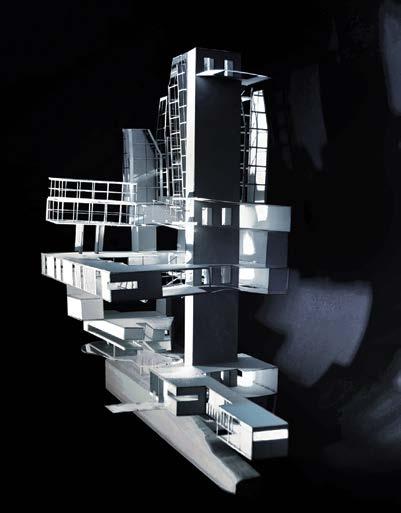
children. The children learn about the precious nature of water and learn how use it to care for their future environment.
Fig. 6.16 Yi Ki Liong Y3, ‘The Central Elderly Health and Community Centre’. The project considers Hong Kong’s ageing population and how architectural requirements may shift according to these demographics. With isolation from society and the city becoming a common phenomenon amongst the elderly, the Central Elderly Health and Community Center aims to challenge the elderly person’s mental and physical limits while providing a safe, socially dynamic environment.


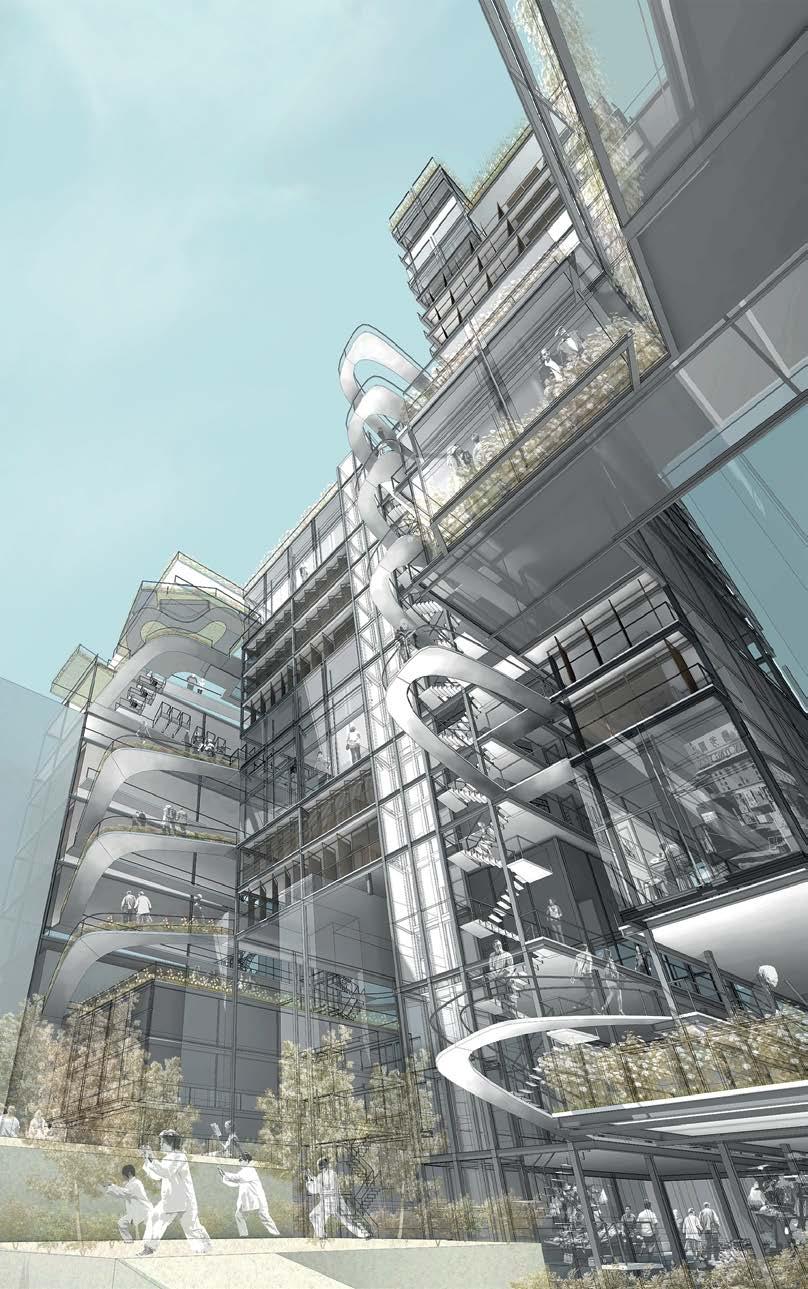
Fig. 6.17 Kamola Askarova Y3, ‘Bicycle Club’. The project promotes a sustainable form of transportation for Hong Kong and incorporates a bicycle factory, repair shop, a library and virtual exhibition spaces. It aims to celebrate the efficiency of the bicycle through the theatrical display of exposed kinetic mechanical systems, which are powered by the members of the club. Fig. 6.18 Yuchen Pan Y2, ‘Live Food Museum’. The building captures three food cultures that may disappear from Hong Kong in 50 years time: Dai Pai Dong, Iceroom, and Tea Restaurant. The museum provides people with the ‘live’ experiences of learning, preparing and eating, to preserve and celebrate local traditions and family values. Fig. 6.19 Shi Qi (Kiki) Tu Y3, ‘Cardboard Residential Building 2065’. The project
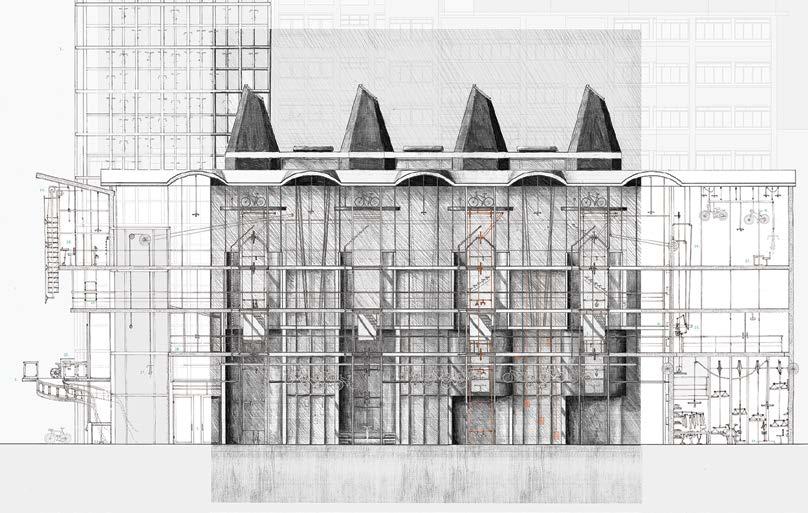
aims to address the need for sustainable models of living for socially neglected members of Hong Kong’s population. The housing model provides flexible accommodation flats with social gardening spaces. It investigates the possibilities of reusing cardboard and integrating it into the building system, by turning it into growing compost, partitioning elements and furniture. Fig. 6.20 Ching (Jin) Kuo Y2, ‘The Central Community Centre’. In response to Hong Kong’s lack of public communal space, the Community Centre offers various types of leisure activities to local residents and the wider public. The building acts as a wayfinder to other cultural facilities in the city, offering dynamic activities at street level and more quiet spaces for reading and reflection above ground.



Edge: Fragile Landscapes
Christine Hawley, Paolo ZaideYear 2
Oliver Colman, Thomas Cubitt, Ye Lone (Jarrell) Goh, Katja Hasenauer, Niema Jafari, Robert Newcombe, Sylwia Poltorak, Laszlo von Dohnanyi
Year 3
Supichaya (Susan) Chaisiriroj, George Courtauld, Georgina Halabi, Yu-Me Kashino, Samuel Tan, Yiren (Aviva) Wang, Anqi (Angel) Yu
Unit 6 would like to thank our technical advisor Matt Springett and our critics: Abigail Ashton, Peter Bishop, Izaskun Chinchilla, Nick Elias, Naomi Gibson, Jens Kongstad, CJ Lim, Tim Lucas, Farlie Reynolds, Yeoryia Manalopolou, Tim Norman and Oliver Wilton
A special thank you to the Santander Foundation for their generous support
As the prospect of environmental stability slips away and we experience a climate that becomes increasingly volatile, the challenge will be to understand how to provide shelter in this environment. The scenario is fifty years in the future, which if the climate pundits are correct, will be a time characterised by increasing storms, drought and rising sea levels. Within this context, Unit 6 considers the organisation of communities and how this would affect not only the design of housing but also the infrastructure that supports them. With the influence of research, analyses and speculation the Unit questions models of living and developed infrastructural proposals tested within fragile edge conditions.
The early nineteenth century Quaker philanthropists such as Cadbury and Rowntree understood that working communities needed far more than merely housing to lead a secure and productive life. Bournville and New Earswick were the influential forerunners of the garden city movement that developed models of mixed development that were conceptually radical yet rooted in ideas about humanity. Similarly, the brief for this year demanded a radical approach where housing and infrastructural plans are not referenced by the status quo but an imaginative vision of life at the midpoint of the twenty-first century. Not only did the students consider the social consequences of design but also the technical challenges of changing weather patterns on fragile landscapes.
The Unit explored sites at the mouth of the Thames Estuary. Cliffe Marshes and Gravesend both share a geographic characteristic in that they are on the edge of water and particularly vulnerable to the forces of the weather. The first site is a fragile ecological site, historically the site for brick and cement making and latterly a RAF base in the second-world war, more recently it was part of the hotly disputed site for the third London airport. Today, the marshland contains strange archaeological relics, traces of its historic past, a tangled network of watercourses and marshland that supports an important diversity of wildlife. Gravesend was a naval and shipbuilding town and still supports industries that are water-based, it is also a commuter town for those that work at Tilbury docks. Each site provided different challenges, one that had to address all the responsibilities of delicate ecology and the second the dual responsibility of considering the context of the town and the water’s edge.

Fig 6.1 Unit 6 Group Model, Initial site research of Thames Estuary 50 years into the future. Fig. 6.2 – 6.3 Anqi (Angel) Yu Y3, ‘Gravesend Residential Tower’. In response to pressures of increasing housing demand and loss of green spaces due to flooding, the typology of a residential tower hybridises these issues. A series of interlocking housing units connect to a number of different gardens ranging from communal spaces to private vertical green balconies. Fig. 6.4 Supichaya (Susan) Chaisiriroj Y3, ‘The Cliffe Wetlands Visitor Centre’. A regional marshland visitor and education facility for the study of the fragile environment and biodiversity of the Thames Estuary landscape. The building plays on the abundance of water reeds which can be processed into thatch as a building material and takes opportunities to develop moments of the building which
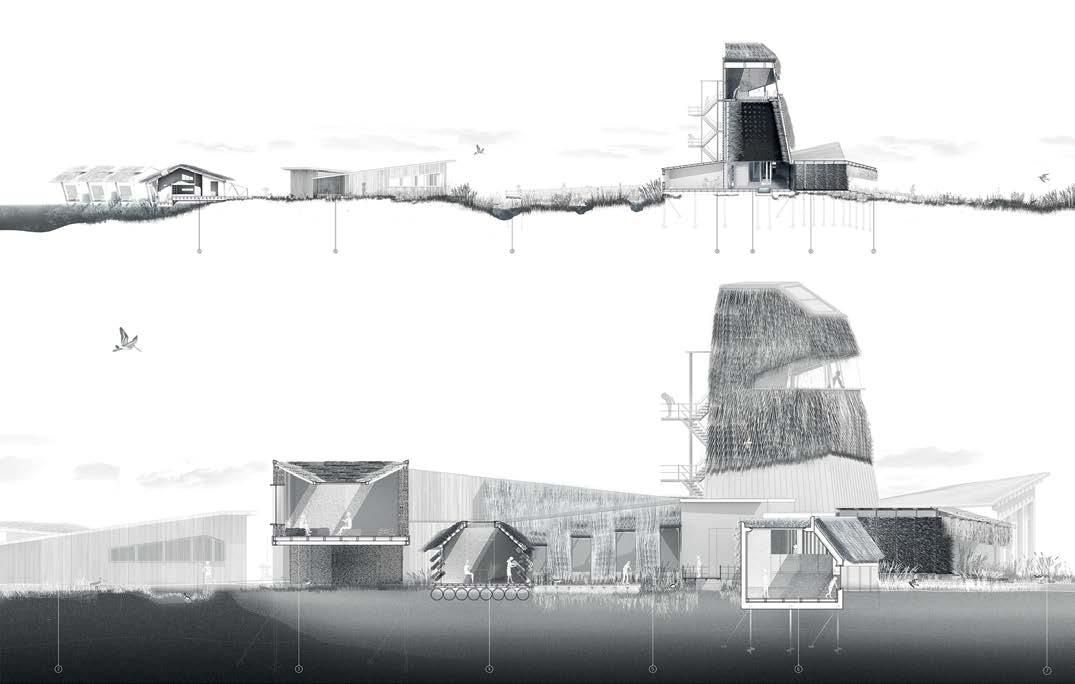
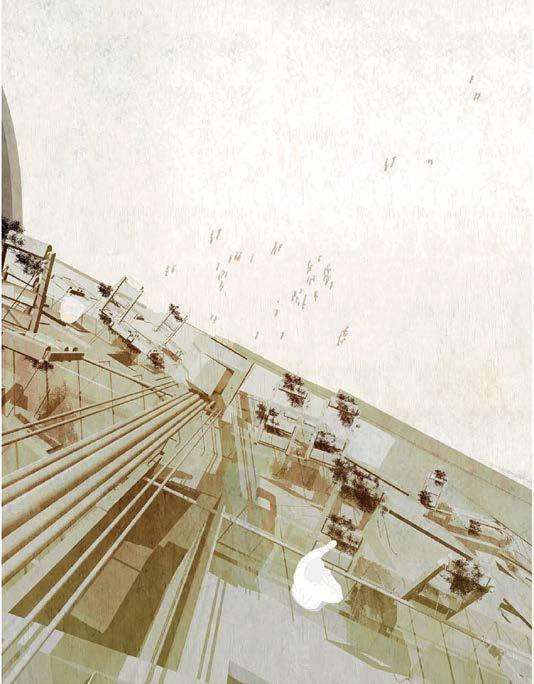
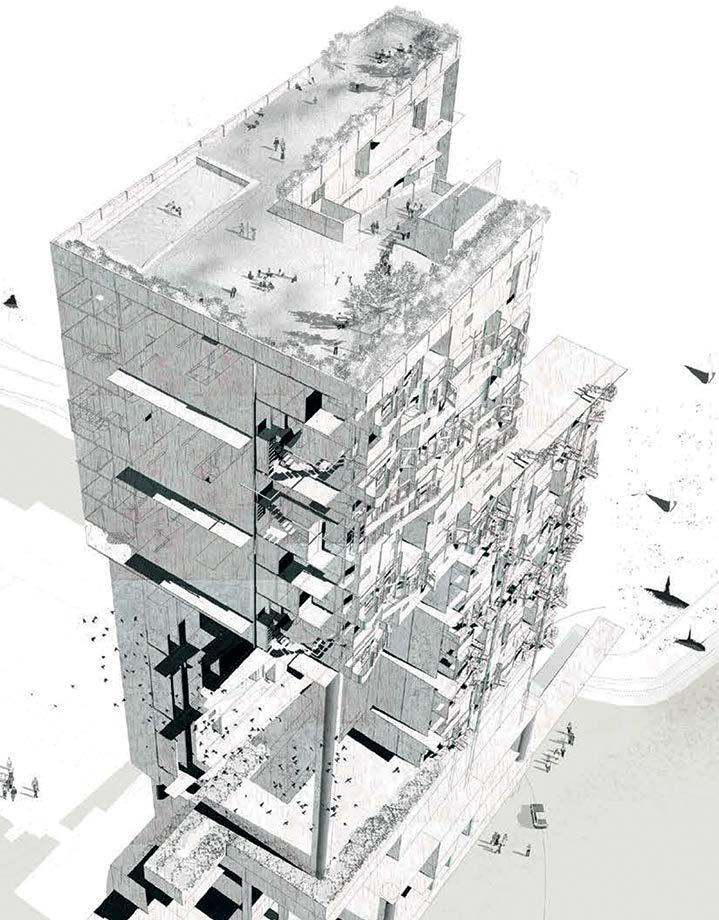
blend into the surrounding landscape. Fig. 6.5 Samuel Tan Y3, ‘Cliffe Marshes Gateway to London 2064’. Due to the expansion of river transportation and mobile technology advancements, people will live a more transient life. The project acts as a hybrid work-home travel nodal point, whilst ecologically enhancing the sensitive marshscape where it is sited. The combined ferry terminal with accommodation caters to a future where our lifestyles have become increasingly decentralised from notions of home or work. 6.2
6.3




Fig. 6.6 Yiren (Aviva) Wang Y3, ‘Twilight of Life Centre’. A community centre for the Active Third Age in Gravesend functions to preserve oral history and to act as an active archive for the town. Set into existing factories and shipyards of Gravesend, this building forms a physical and social reservoir of memories of Gravesend’s prosperous past. Fig. 6.7 – 6.8 Laszlo von Dohnanyi Y2, ‘Observatory’. Sited in one of the least light-polluted locations in the UK, the hands-on teaching astronomical observatory provides research and education facilities. It allows visitors to retreat into the ground and connect back to the night sky, acting as a celestial retreat for stargazers. Fig. 6.9 – 6.12 George Courtauld Y3, ‘Managed Retreat’. An oyster farm and processing plant to respond to protein shortages and alternative food sources in

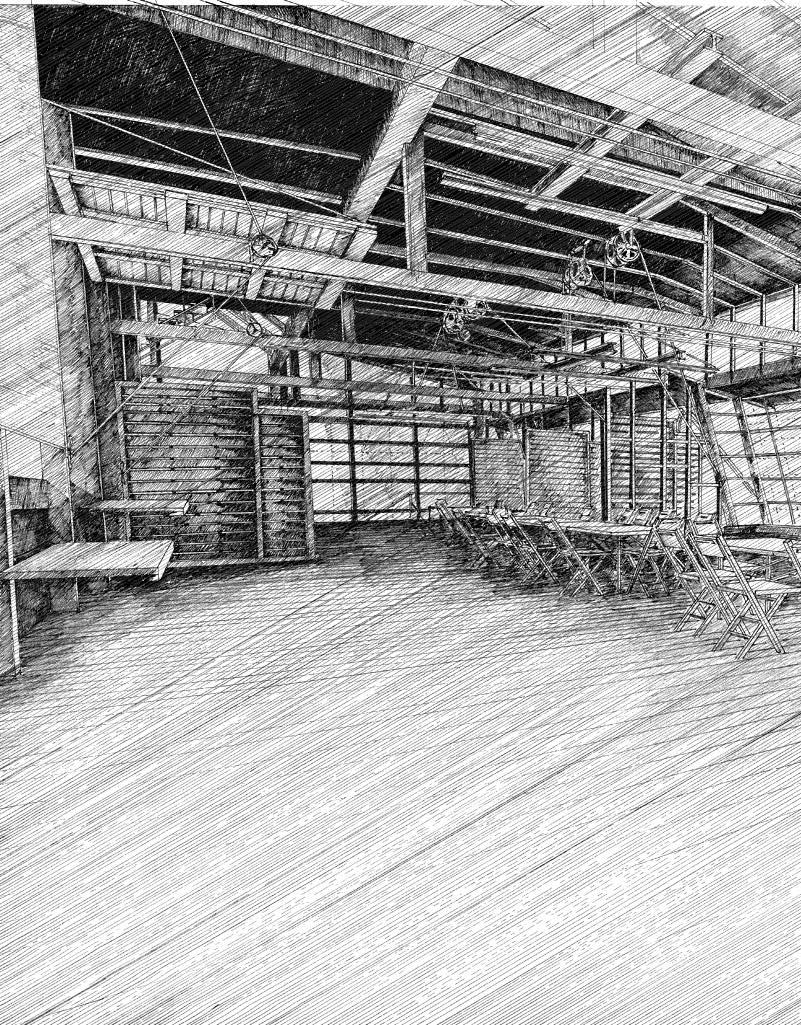
6.9
6.10
the future. The project plays on the language of the Victorian vernacular and adapts to different seasons and cycles; processing spaces are temporarily repurposed as retreat accommodation and the building responds to the fluctuations of ebb and flow. 6.11 6.12


Fig. 6.13 Niema Jafari Y2, ‘Super Earthed Lido’. Thames Water is upgrading their Victorian sewage system to a super sewer, allowing an increase in river water purity. The lido utilises the water from the Thames at high tide and is planned around two WWII decoy buildings. Dredged material discarded in Cliffe forms the Lido intrinsically linked to the dynamics of the area. Fig. 6.14 Georgina Halabi Y3, ‘Cliffe Bread and Breakfast’. A retreat and public waterscape which makes use of the tidal changes to power waterwheels that propel private cabins to retreat or plug in to the main building. A main waterwheel is used for making bread for the retreat guests and the Higham town residents. Fig. 6.15 Sylwia Poltorak Y2, ‘Aromatherapy Gardens’. A garden retreat for the city of London set into the particular wind and light conditions of Cliffe Marshes. The main

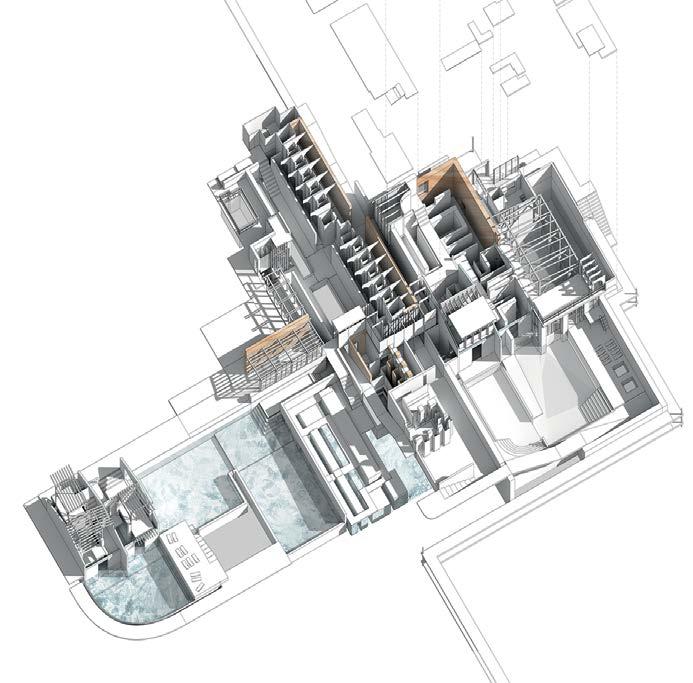
building contains an interior garden that creates a miniature landscape of walking paths, terraces and flower beds of lavender. Fig. 6.16 Oliver Colman Y2, ‘Flood Displacement Campus’. Forecasting a 2m rise in sea level by 2064, large numbers of people will be displaced from their homes due to extreme flooding along coastal waterways. The campus will temporarily accommodate these people for a month, creating a sense of community with public spaces within the central hub and the collective accommodation blocks. Fig. 6.17 Katja Hasenauer Y2, ‘Cliffe Marshes Nature Retreat’. The retreat, balancing delicately on the remains of Shornemead Fort, creates a connection between old and new. Located adjacent to the River Thames within a vast nature reserve, the retreat focuses on the surrounding views of existing natural beauty.

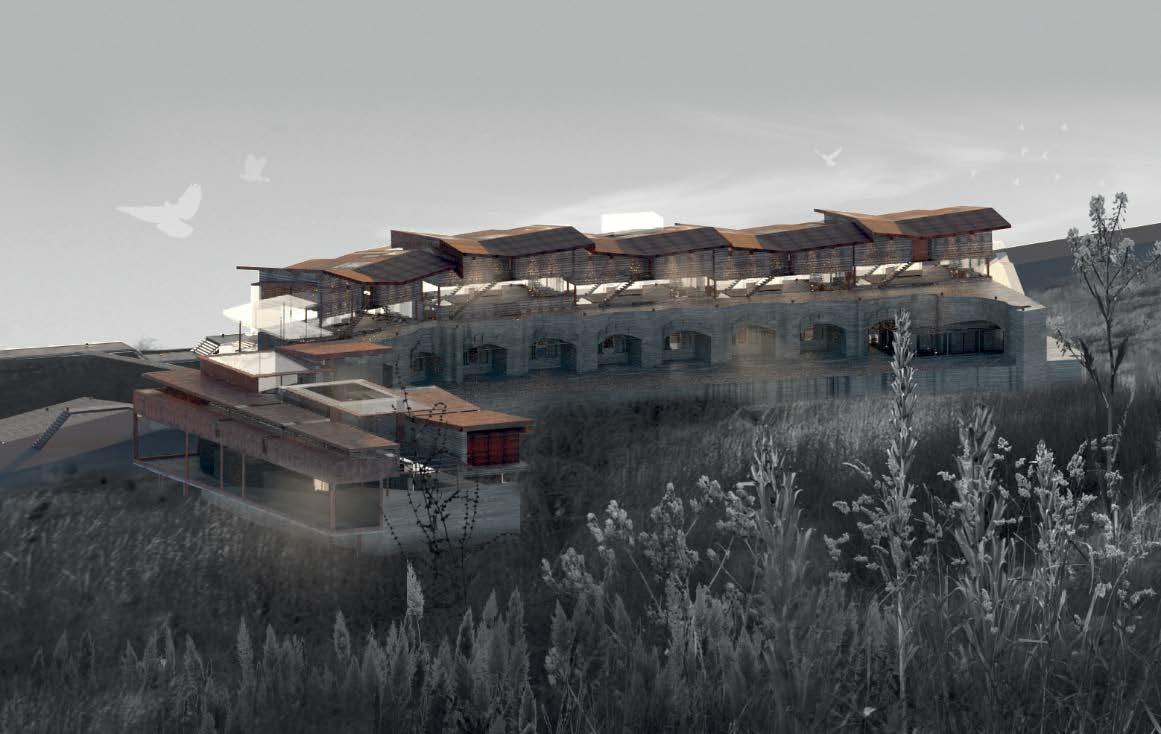


Fig. 6.18 Robert Newcombe Y2, ‘Gravesend Horticulture Centre’. The Gravesend Horticulture Centre set in 2064 is a porous walled garden, sheltering and propagating an oasis of nature at the centre of the historic gateway to London, whilst re-activating a decaying post-industrial context.

Fig. 6.19 Ye Lone (Jarrell) Goh Y2, ‘The Seafort Fish Farm’. The derelict offshore Redsands Fort has been repurposed into a modernised salmon farm. New infrastructure meets with the rusting shells of the steel towers, and visitors can spend a day fishing and dining while being surrounded by fragments of a wartime relic. Fig. 6.20 Thomas Cubitt Y2, ‘Shornemead Garden City’. A housing development placed adjacent to the Thames Estuary. In response to the rise in sea level, the project acts as an example of a village that could co-exist with the
flood zone, harvesting the tide in order to generate energy. The development is suspended above a series of water gardens which absorb tidal surges and mitigate flooding on a larger scale.
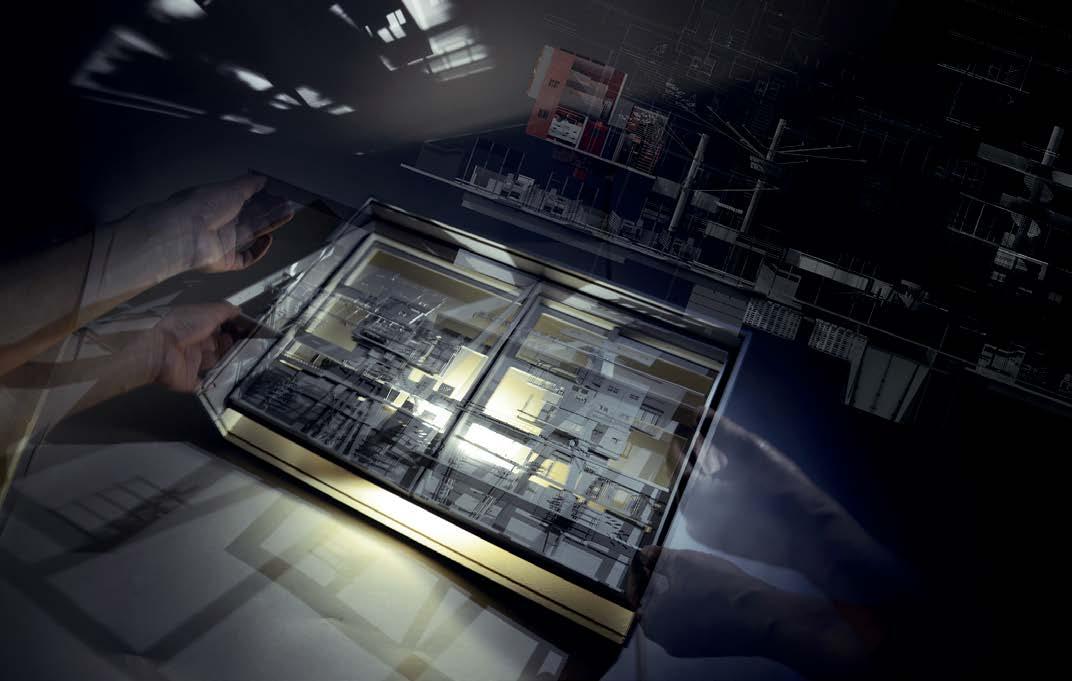
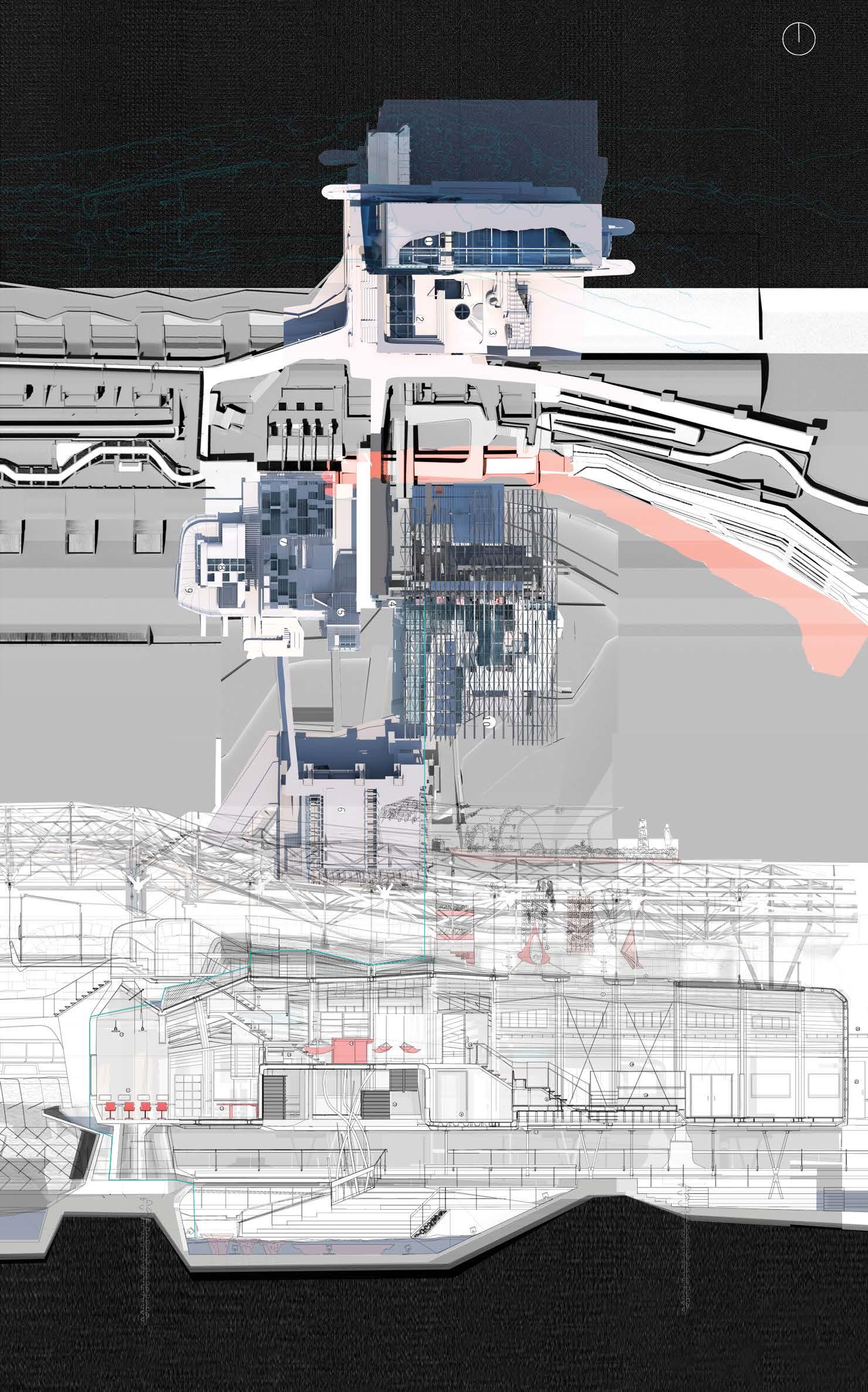
2013
The Peckham Experiment Christine Hawley, Paolo Zaide
The Peckham Experiment
Christine Hawley, Paolo ZaideIn 1926, two pioneering doctors, George Scott Williamson and Innes Hope Pearse, started a radical project in South London and opened the Pioneer Health Centre. This was not a medical practice as we understand it today, but a revolutionary approach to health and wellbeing. They proposed that the medical world need not be prescriptive and responsive to specific ailments – instead, it ought to focus on why these ailments occured in the first place. With the introduction of the NHS in 1949, the emphasis was to provide facilities and resources that treated illness, the Peckham Experiment focused on the opposite – what it is that keeps people well.
This year Unit 6 set out to investigate the principles of the Peckham Experiment and their architectural consequences in the context of the 21st century. The unit took a train journey from Budapest, Vienna to Vals, Switzerland; a European cross-section that presented health as a lifestyle, not a prescription, an opportunity to observe the role that architecture plays. The themes were visible in the work of a range of architects, from the intricately detailed Post Office by Otto Wagner, the socialist living conditions of Vienna’s Sargfabrik Estate, the futuristic Gasometer by Co-op Himmelblau, to Peter Zumthor’s experiential Thermal Baths.
Unit 6 began the year by exploring one idea about physical or mental wellbeing. Many of these initial interests evolved into small buildings, showcasing an element of sensory and experiential wellbeing, such as fragrant gardens hidden within Regents Park, moments of refuge that reside in Canvey Island and seaweed baths excavated from a blue lagoon. Others were smaller scale insertions into daily routine, for example, napping cubicles that could be placed around London to encourage rest. Even radical public installations were created, using wallpaper, bananas and one student’s wardrobe as a means of testing public trust.
The major project was sited in future Peckham and close consideration was given to the areas current,
past and future circumstances. The Unit researched different aspects of Peckham in groups, extracting a range of data and cultural information and exploring it through drawing models; collectively creating an investigative archive. By combining these findings, the Unit developed programs with either direct responses to Peckham’s current condition or well-substantiated speculations about its future.
Max, Jamie, Laura and Nadia identified housing as a key area of architectural wellbeing. With a range of interlocking units and courtyard spaces, Max questioned the level of social cohesion in Peckham’s existing housing typologies. Jamie responded to the isolation experienced by some in the area’s sheltered housing, by designing homes for the elderly that open onto a public thoroughfare. Laura too designed housing for the elderly, where residents are encouraged to build relationships by spending time in their allotments. Nadia Wikborg’s programme involved the intergration of a public laundrette, elderly housing and lemon tree gardens, with fragrances encouraging the young and old residents to intergrate.
Other students addressed the challenges of Peckham’s changing and multicultural demographic. Aiko, for example, responded to the increase of young parents in Peckham, whilst Chengcheng used craft workshops to support the retired workforce of Peckham. Claire Seager and Andrew Yap explored the traditions and nutritional benefits of Peckham’s diverse cuisine.
Through a range of approaches Chris Straessle, Olivia Hornby and Joyce Chen each set out to improve leisure facilities by reintroducing the theatrical arts to Peckham. Chris activated an empty park square with a highly flexible theatre that unfolds onto the landscape. Olivia designed numerous suspended spaces creating acoustic isolation from the bustle of the public below. Joyce chose to build upon the foundations of an old cinema, constructing a submerged theatre and
pocketed gardens as a means of supporting Peckham’s growing theatrical interest.
Catherine Penn, Yolanda Leung and Tzen Chia set out to reinvent neglected structures in key locations. Catherine and Yolanda both looked at the multistorey car park proposing programmes that support the council’s initiatives to create a cultural destination, alongside a developing high street. Tzen’s project transforms the nearby railway arches into bamboo-growing workshops and a public bicycle facility that creatively address the sustainable aims of Southwark.
The importance of public landscaping was explored by Joe Travers-Jones and Emily Priest. Joe designed a crematorium; translating the linear landscape into the procession of a service. Emily focused on preserving nature in the context of Peckham’s ever-changing landscape, designing undulating gardens that enhance the walk up to Burgess Park from Peckham Square.
We would like to thank our technical tutor, Matthew Springett, and our critics: CJ Lim, Carlos Jimenez, Nicholas Elias and Sabine Storp.
Year 2: Max Butler, Xi Yao (Joyce) Cheng, Jamie Hignett, Olivia Hornby, Aiko Nakada, Catherine Penn, Emily Priest, Claire Seager, Chris Straessle, Joe Travers-Jones, Zisheng (Andrew) Yap
Year 3: Tzen Chia, Tom James, Heng In (Yolanda) Leung, Chengcheng Peng, Nadia Wikborg, Laura Young
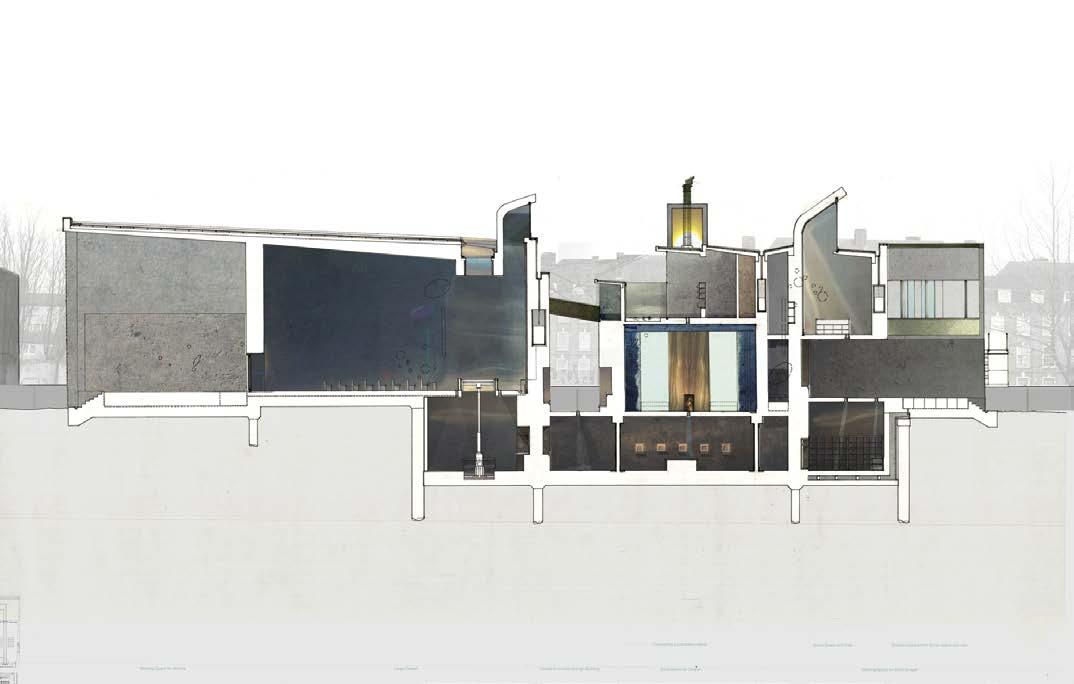


Fig. 6.1 Claire Seager, Y2, Cookery School, detail of crosssection. The building celebrates the ‘coming together’ that good food inspires by providing cooking spaces and a chef apprenticeship scheme for people living in Peckham. The various ethnicities of Peckham are catered for in large kitchens, arranged around courtyard dining and gardens for growing produce. Fig. 6.2 – 6.3 Joseph Travers-Jones, Y2, Crematorium, ground plan and detail of long section. Given total privacy whilst moving through the building, each party experiences a sequence of quiet and isolated spaces, candlelit seating, and peaceful water gardens, going on to complete the funeral ceremony amongst celebratory spaces on the roofscape. The building developed from the idea of a procession; carefully chosen lighting and materiality enhance

the sensory states of the service. Fig. 6.4 Chengcheng Peng, Y3, Community Centre, external render showing overall building within context. The building offers supporting groups for expectant mothers and a short stay creche, and workshop classes to educate the local adults. Waste products from the workshop would be recycled as aggregate for concrete construction in the local area. Fig. 6.5 – 6.6 Joyce Chen, Y2, internal view of submerged theatre and final model. By reutilising the basement foundations of the old cinema on site the building physically and socially reconstructs Peckham’s performing arts culture. Constructed from the excavated earth and gabions, the auditorium is submerged into the site. Revolving mechanistic doors are an important feature, opening out onto pocketed gardens during the summer.

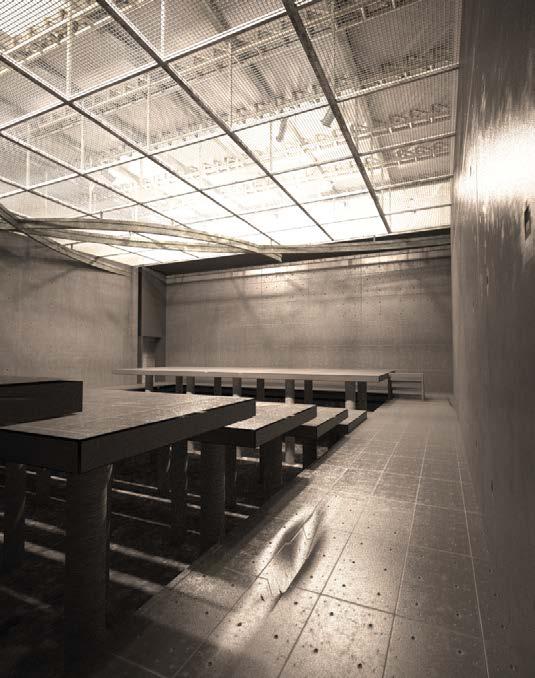
6.4
6.5 6.6
Fig. 6.7-8 Laura Young, Y3, Soil Association Research Centre & Housing for the Elderly, external view wild flower gardens and internal view looking onto allotments. On a green corridor between Burgess Park and Peckham Rye, the architecture preserves the natural qualities of Peckham’s ‘good soil’ Prototyping new ways of cultivating environments outdoors for a wide variety of crop types, the scheme develops new elderly housing typologies based on the engagement with the outdoors, allowing occupants to establish their own ground as guardians to the gardens whilst preserving the public thoroughfare. Fig. 6.9 Catherine Penn, Y2, The Peckham Plex Carpark, roof elevation. The project focusses on seasonal change incorporating a rooftop ice rink with dual functionality as a summer reflecting pool, and sculptural canopies channel
rainwater into an outdoor ‘ice bar’ in winter. Fig. 6.10 Olivia Hornby, Y2, Peckham Music Centre, short section. A community centre with auditorium, music school, cafe and musical therapy centre. To acheive acoustic isolation, the building is suspended over public open space where each acoustic space is suspended in a specific way to acheive desired musical qualities, whilst the public space below is left open to the elements. Fig. 6.11 Max Butler, Y2, Mixed Income Housing Association, view of overall scheme, shifting from roof plan (bottom) to elevation (top). A diverse mix of interlocking residences enclose multi-level gardens and a range of communal facilities. Adjactent to streets running through the scheme sit semi-public shared gardens. Residents are encouraged to occupy and ammend these spaces.




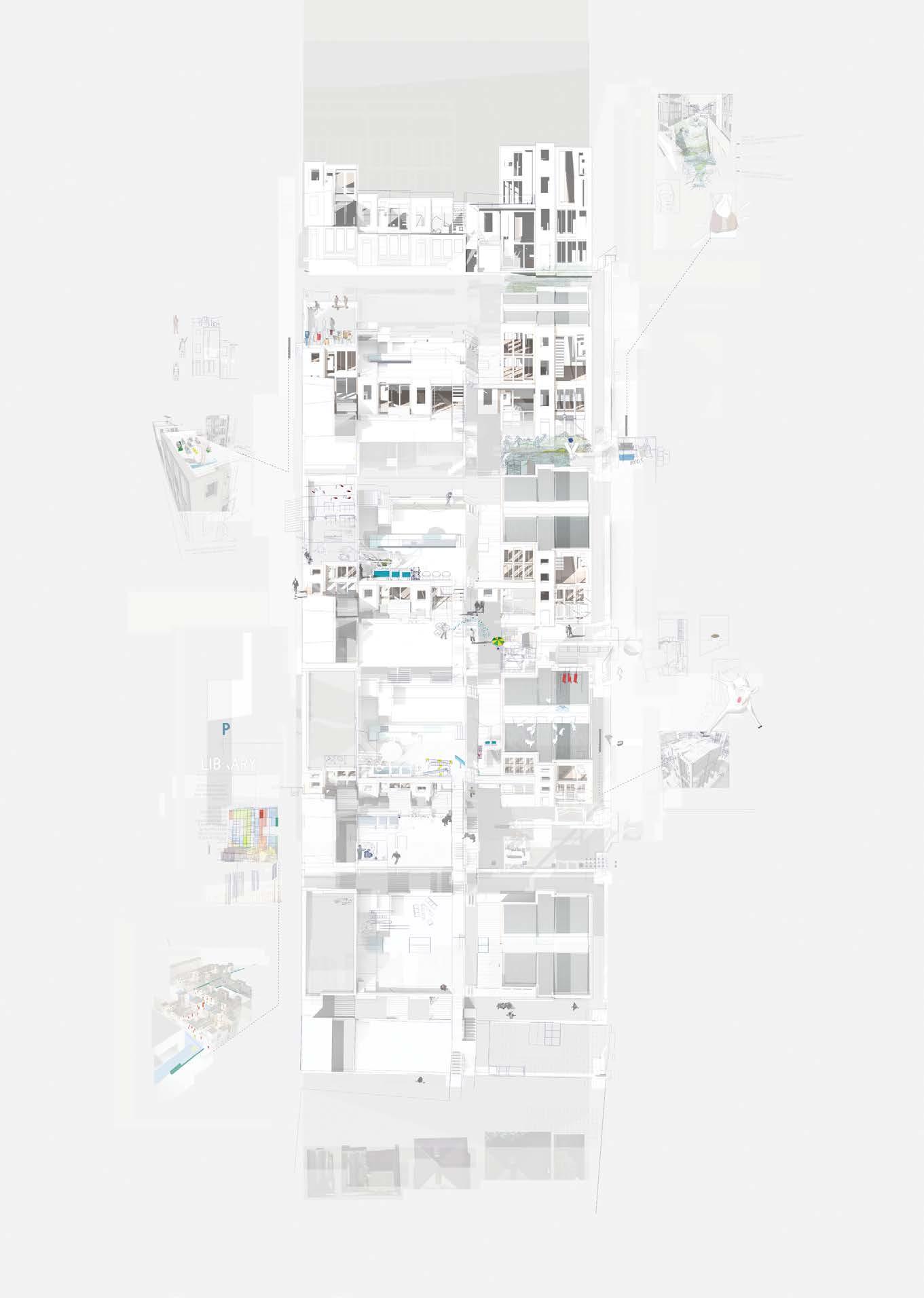
Fig. 6.12 Nadia Wikborg, Y3, Launderette & Sheltered Housing, sectional model and ground floor plan. The building brings the community of Peckham together in a landscape of fragrant lemon trees and freshly aired laundry, inviting the public to interact with the elderly residents through a lemonade cafe as well as a public garden where they can meet and exchange stories. Fig. 6.13 Chris Straessle, Y2, A light intervention on an otherwise empty park. The main part of the building is a black box theatre, where this particular theatre design can be easily adapted to many types of performance requirements. And in response to the landscape, the building also has an open-air theatre. The theatre’s double skin envelope encases pockets of inhabitation where it widens, and folds out onto the parkscape. Fig. 6.14 – 6.15 Tzen Chia, Y3, Bamboo Bicycle Grow &
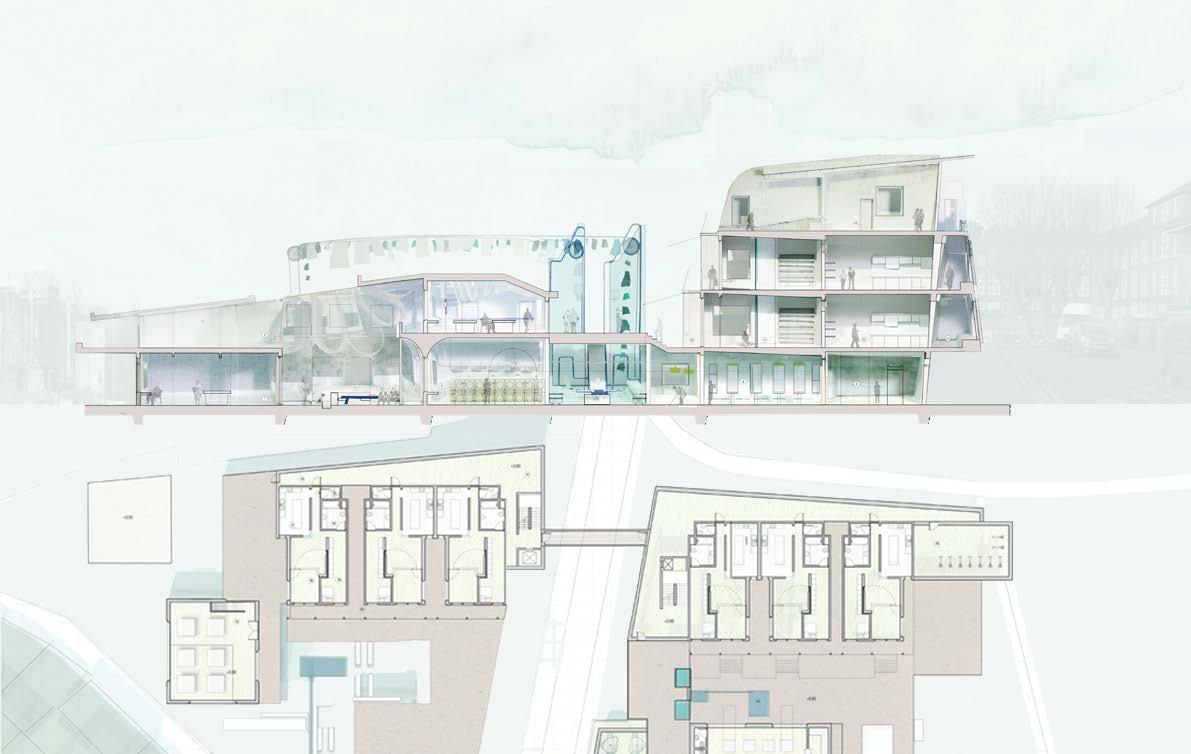
Workshop, Internal rendering of workshop and view down main corridor. The building is made up of a flexible sequence of spaces designed to suit the seasonality and cycles of everyday life in accordance to the growing rates of bamboo. Empowering the community with skills and new means of alternative transport whilst the allotment and cooking areas encourage physical and social wellness. Fig. 6.16 Emily Priest, Y2, Preservation Gardens, Seed Bank & Research, perspectival view and sectional elevation. Suburban Peckham seems to have lost its agricultural heritage in an effort to preserve the linear park that leads up to Burgess Park, the preservation gardens become dense and sparse, and the vegetation would become experiential.


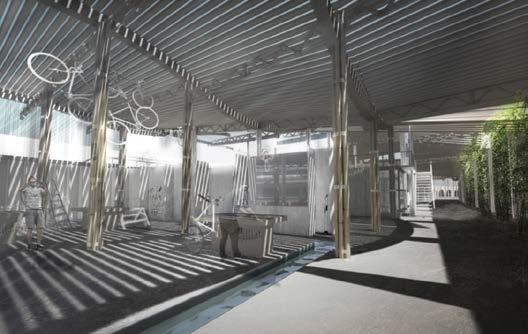
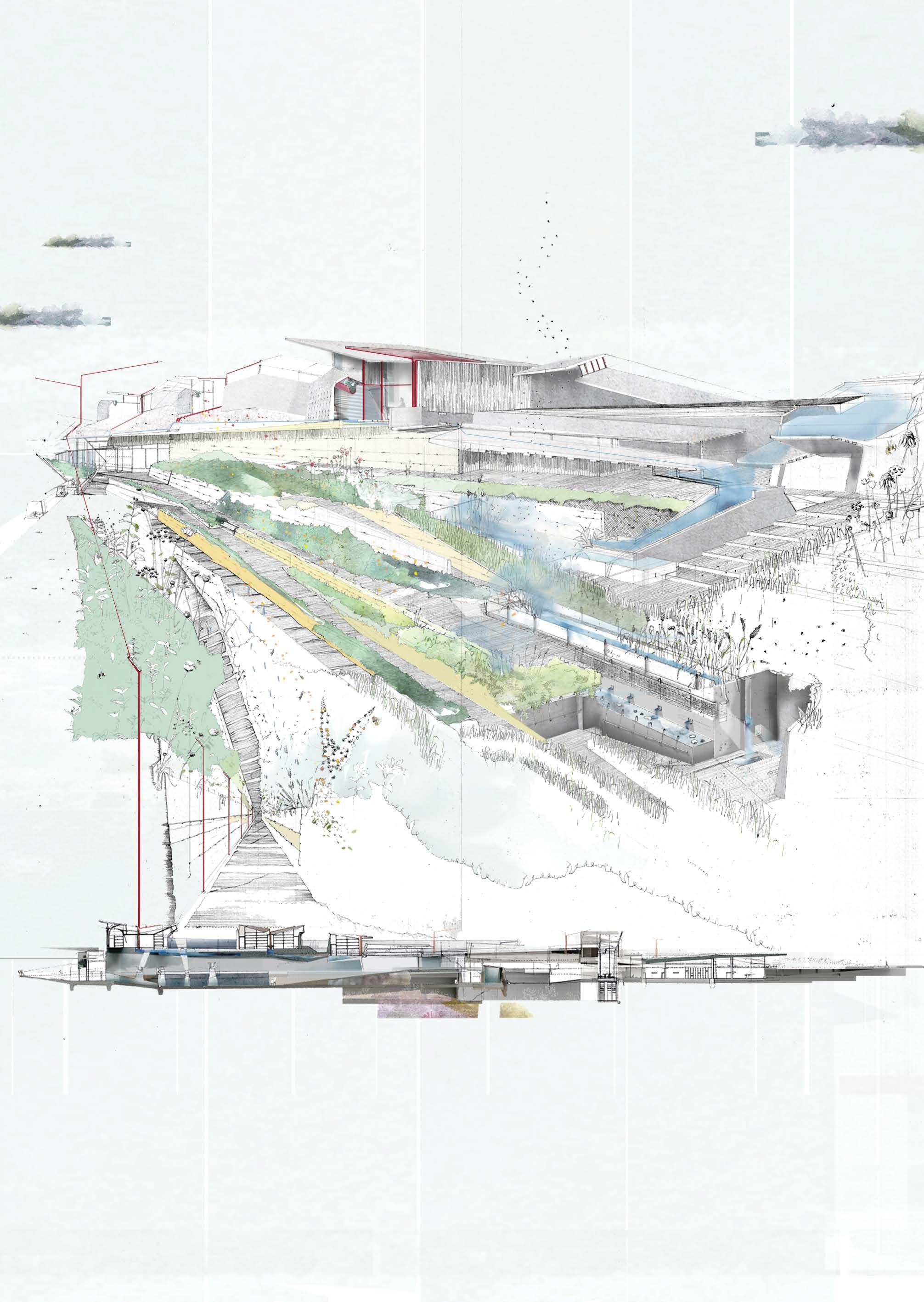
Fig. 6.16 Jamie Hignett, Y2, sheltered housing for the elderly and artists housing, axometric view with cut-away moments. A mixed typology of artists studios and sheltered housing for the elderly to reduce the isolation between these two communities. In reaction to existing unconsidered models, the scheme provides a sense of identity and autonomy to the residents. The housing for the elderly overlooks a public thoroughfare that runs through the building; elements of which can open out blurring the threshold between private and public space. The residents can inhabit the bedroom facades with their posessions to express their character.
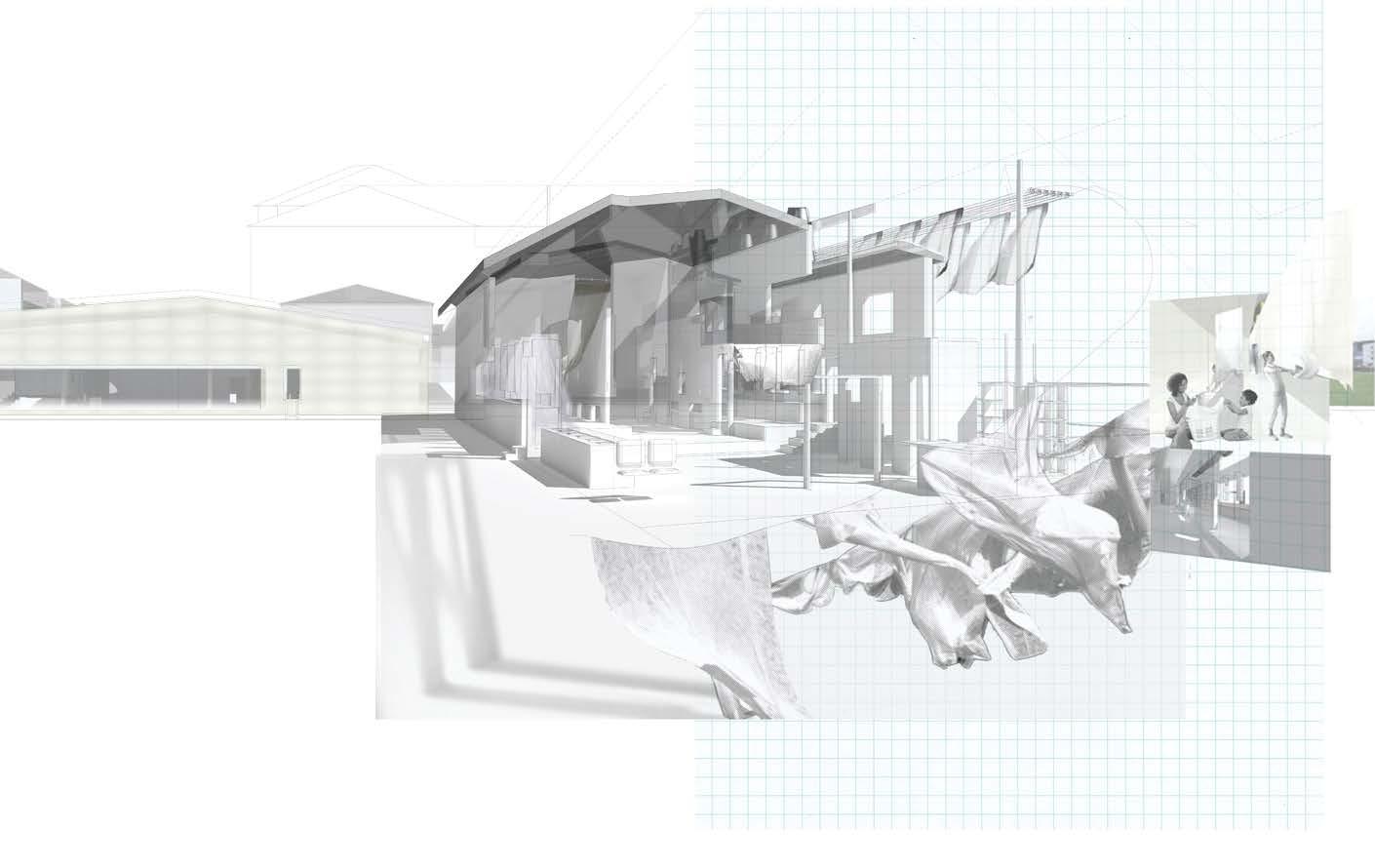
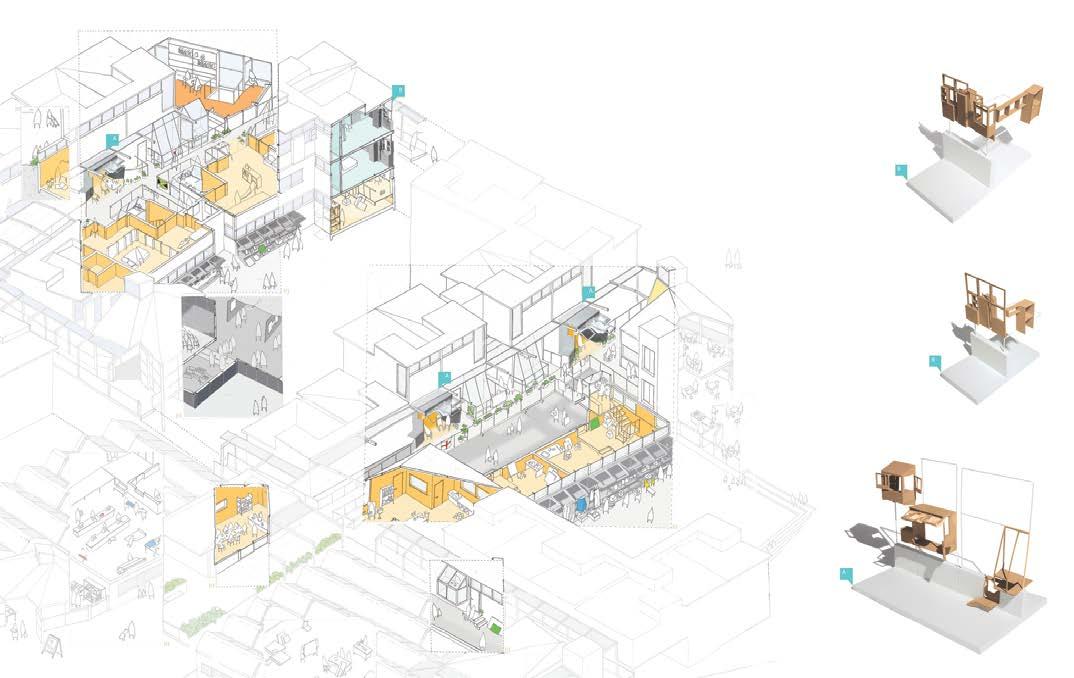
Fig. 6.17 Aiko Nakada, Y2, Peckham Threefold, Day Care Centre & Laundrette, in response to the increase in young parents situated in Peckham this building provides a place
for parents to socialise and carry out important daily tasks. The project stemmed from a delicate awareness towards the protective nature of a parent and child; the buildings structure safely encloses the child whilst providing viewing points for the parent to watch over them. Fig. 6.18 – 6.19 Yolanda Leung, Y3, The Market Intervention. In recognition of Southwark Council’s effort to improve the area of the hugely underused carpark, this project explores the notion of redeveloping the carpark into a market space with scattered mobile modules of foldable stalls and expandable kitchen pods. The reason behind the foldable modules lies in the idea of renovation, where the carpark is not completely invaded but enhanced. The exisiting gallery spaces and Frank’s Cafe and Campari Bar would be retained.
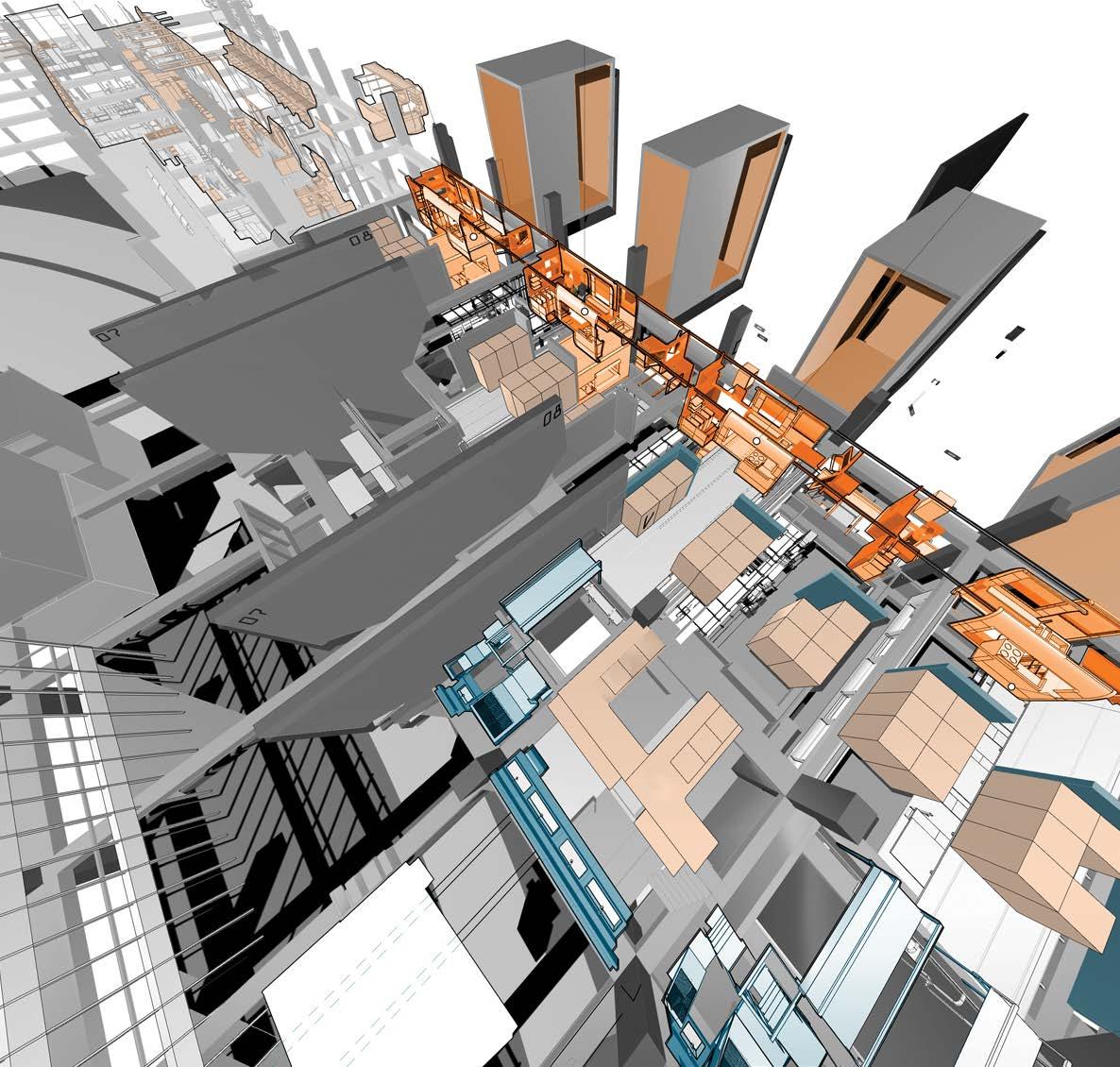
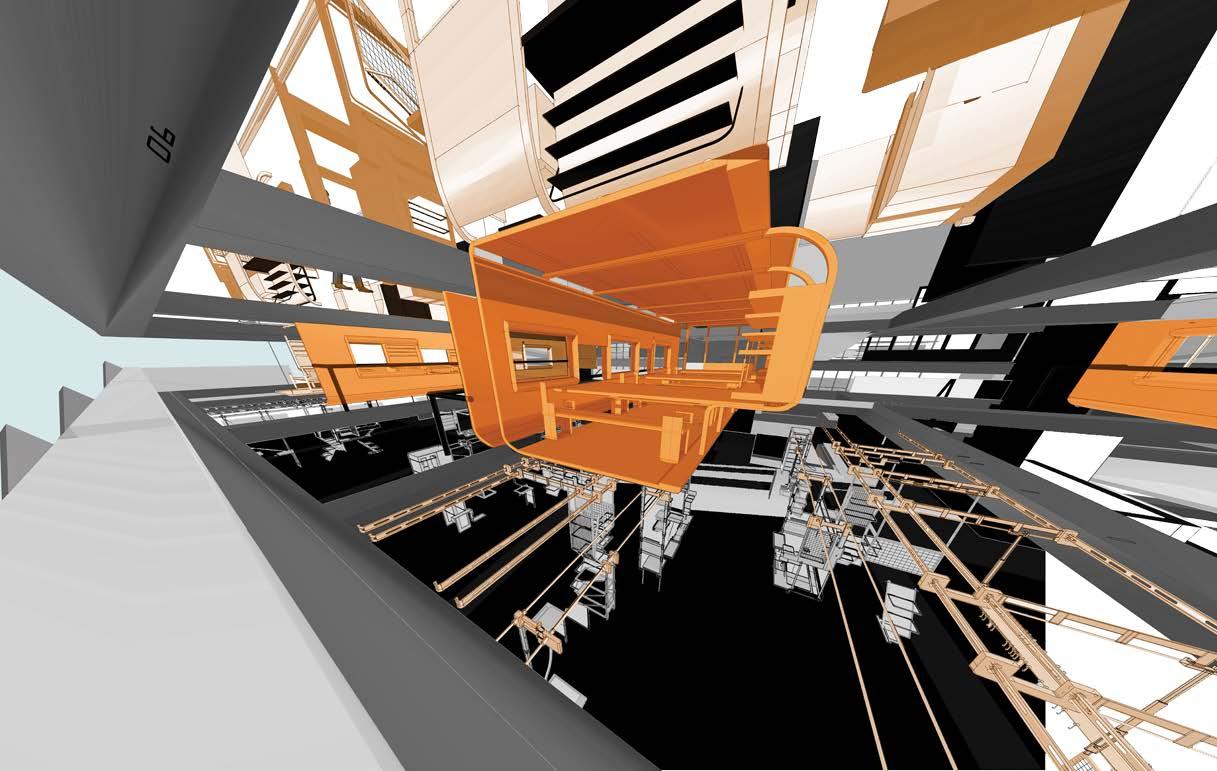
Schools for Tomorrowland Sabine Storp, Paolo Zaide
SCHOOLS FOR TOMORROWLAND
Sabine Storp, Paolo ZaideOn the 18th of July, 1955, Christine Vess Watkins and Michael Schwartner were the first children to be welcomed to Disneyland. This was to be the happiest place on earth where fond memories of the past could be relived and the youth could savour the challenge and promise of the future. Tomorrowland was dedicated to the advances of Science and the Space Age, and its attractions were an invitation for the visitor to ride into the adventures of Disney’s wonderful tomorrow. Participating in this dream America’s larger ‘forward thinking’ companies used Tomorrowland to showcase their designs for the appliances and technologies to come. American Motors’ Autopia exhibit represented the future of the country’s multi-lane limited-access highways and Monsanto’s Hall of Chemistry proposed that bio technology would benefit your life, food and health. These corporate visions came with a promise to build a new and easier way of life ‘for you, your children, and generations to come’.
The rapid escalation in the development and centrality of technology is mirrored in concerns and debates about sustainability and the nature of resources which question how prepared we may really be, for an unpredictable yet extraordinary future. With more people worldwide graduating through education in the next thirty years, the systems of schooling that met the demands of industrialism need to adapt to the transformations of demography, ecology and the ways we socially interact. The unit was to explore images of the future that would provide a challenge to imagine the new schools for tomorrow.
The first term began by looking at spaces for learning, and the development of concepts, models and a proposal for the ‘extension’ of an existing London school. The extension was considered beyond the simplistic definition of a building addition to critically explore what ‘learning’ may constitute in the future, and how spaces could be created to frame this process. In consultation with the pupils and teachers of Salusbury Primary School in North London, a competition project was proposed to design an ‘extension’ to the school playground which reconsidered the traditional playground object or addition. In the light of Tomorrowland a range of appliances and constructs were developed that allow the children to expand their experience in ‘learning to learn’, discover and to imagine.
Informed by the first project, the subsequent architectural proposition sought to develop educational programmes, functions and spaces fit for the 21st Century. The field trip was to Cuba in order to study the revolutionary art schools and organopónicos, urban organic gardens off the streets of Havana. These are architectural models that favour customisation over standardisation. Students were encouraged to investigate the conditions of Havana’s built and social environments; their diverse research and experience
resulted in design programmes which were developed with a sense of risk, provocation and invention.
Unit 6 would like to thank our technical tutor, Matthew Springett, and critics: Samson Adjey, Abigail Ashton, Jan Birksted, Tom Brooksbank, Gonzalo Coello de Portugal, Ed Farndale, Marta Granda Nistal, Christine Hawley, William Hunter, Popi Iacovou, Tumpa Jasmin, Tim Norman, Charlotte Reynolds
Year 2: Georgina Halabi, Carl Inder, Yu-Me Maru Cheah Kashino, Huma Mohyuddin, Joshua Stevenson-Brown
Year 3: Madiha Ahmad, Samuel Douek, Geethica Gunarajah, Dean Hedman, Ashley Hinchcliffe, Emma Kitley, Nadia Wikborg, Zhang (Allen) Wen, Li (Grace) Zhou
Fig. 6.1 — 6.2 Josh Stevenson-Brown, Westbourne Community Center, Westway, London. A scheme to develop an unused stretch of land in Westbourne Park and activate the Grand Union Canal, with public, community and nursery spaces. From observations of Havana, where private spaces spill out into the street and public space is appropriated by the community, the scheme seeks to extend the use of the ‘school’ changing the use of the site throughout the day.
Fig. 6.3 Li (Grace) Zhou, Kindergarten / Elderly Day Care Centre, Westway, London. The spatial design facilitates a synchronised timetable of activities involving the interaction of the Kindergarten children and Elderly. The design encourages the exploration of nature and the sensorial within the building. Fig. 6.4 Dean Hedman,


Study Model of an Artificial Landscape. Fig. 6.5 Dean Hedman, Climatotherapy Institute, Havana. Influenced by the prolific self-sufficiency of the people, culture, the rapidly aging population, and the Malecón, the programme aims to create a model of dealing with this aging population. Using the therapeutic qualities of the sea and optimised microclimates within the building, therapeutic gardens spread into the cities replacing the myth of the urban organopónicos.
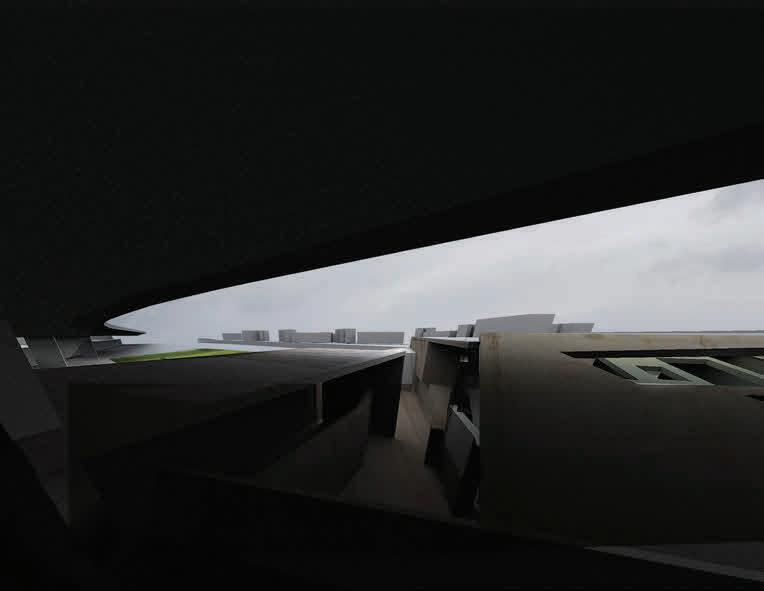


Fig. 6.6 — 6.7 Georgina Halabi, Self Sufficient Junior School and Urban Farming, Kings Cross, London. The roofs of the classrooms build an artificial landscape, which is split into zones for different outdoor uses. On the lower levels the landscape is exposed to the elements to allow for free outdoor play whilst the upper levels consist of rigid planting used to feed the school. Fig 6.8 Carl Inder, Primary School & Cinema, Westway, London. Concepts of framing, montage and perception were developed to translate the spatial qualities of the cinematic into a spatial scheme for a school. The building aims to provide a fluid and dynamic teaching and learning environment anticipating touchscreen technology and immersive projection as the norm. The cinema auditorium is used as a key community and commercial facility. Fig 6.9 Yu-Me Maru Kashino,Taxi Motel



and Tinkering School, Kings Cross, London. A primary school set in the future, a London ‘black cab’ arrives and will become a classroom, furniture, or ‘tinkering’ workshop whilst parked in one of three taxi zones. Children engage in ‘learning through play’ by interacting with the various ways in which the taxis ‘plug-in’ to the building. Fig. 6.10 Emma Kitley, Study for Construction School, Havana. Looking into future political changes in Cuba, the population may start to restore more buildings through a long restoration process. The school will provide young adults with the skills required to help restore their homes and cities whilst gaining independence through a new understanding in many fields of construction. The water collection and recycling principles of the building become an example for the city of Havana.
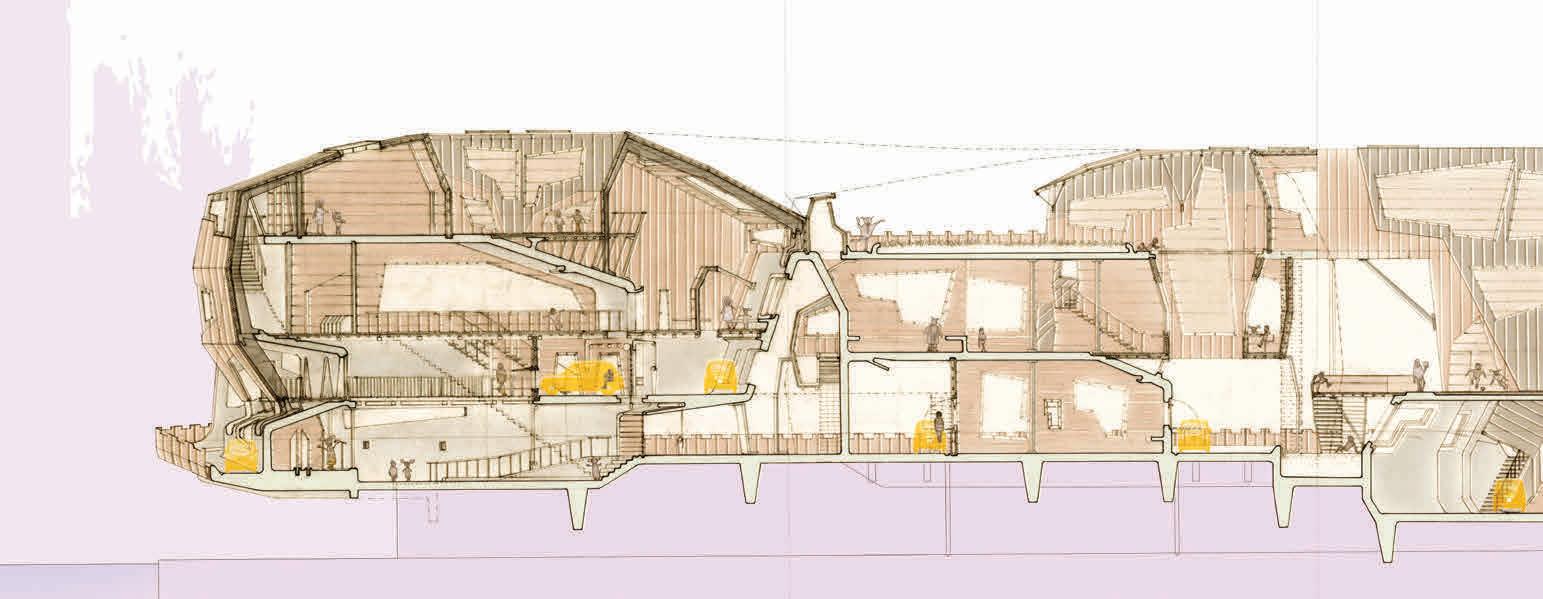
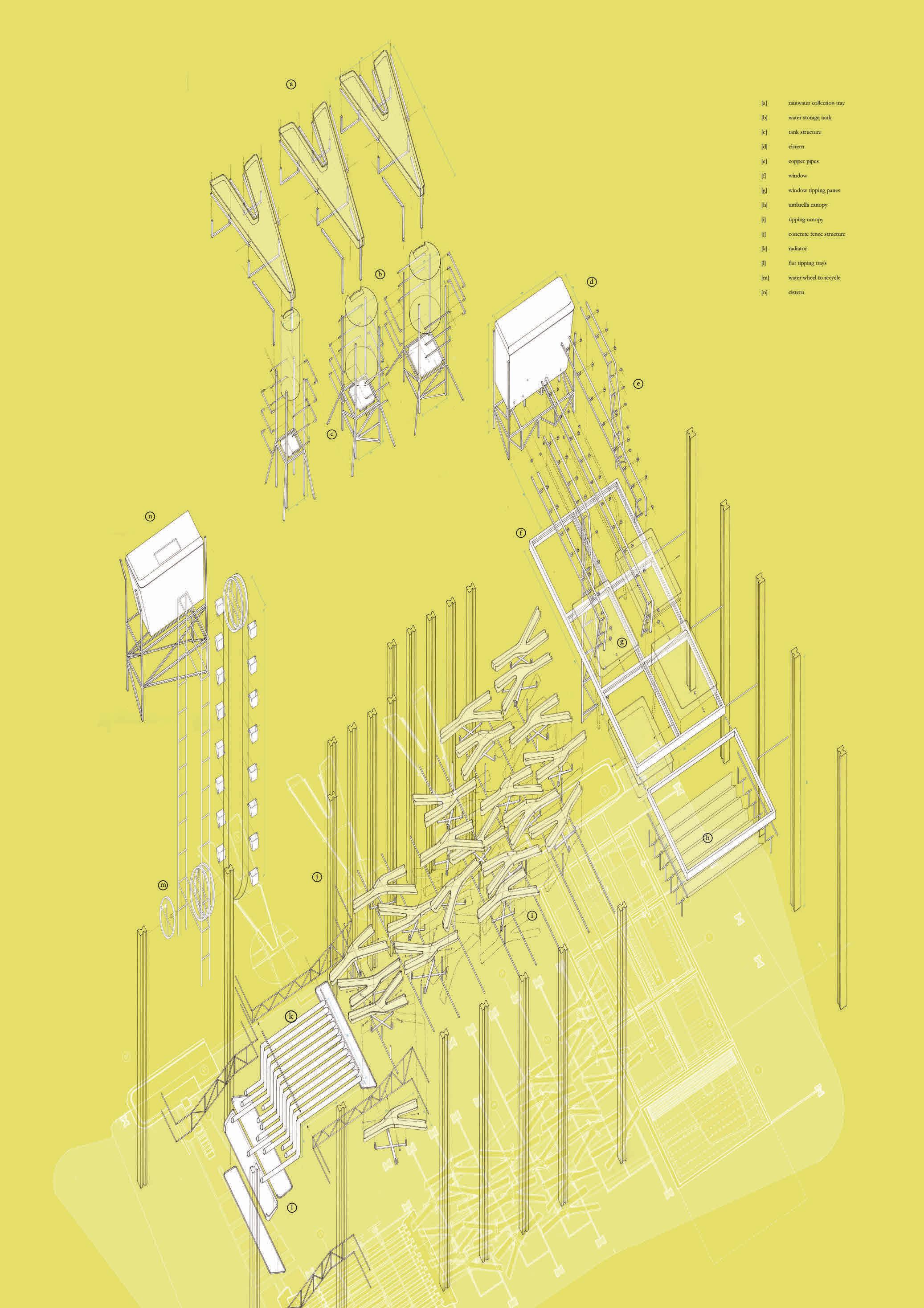
Fig. 6.11 Madiha Ahmad, Film School and Archive, Havana. The building exists in central Havana and is a response to keep the local identity alive through film. It provides an open ‘groundscape’, sets and spaces for ‘telenovela’ . These adaptable spaces for the school and an open roofscape transform into an open-air cinema at night. The building also aims to be an example of sustainable and low energy construction in Havana through the application of earth as a building material. Fig. 6.12 — 6.13 Huma Mohyuddin, Primary School, Westway, London. The primary school is designed as an unconventional ‘open classroom’ experience to encourage interaction and play between pupils of different ages. The roof is a combination of various pods that are used for different purposes. Some are used to grow the children’s vegetable garden, others


collect water and some extrude down into the classrooms to create different learning environments. Fig. 6.14 — 6.15 Ashley Hinchcliffe, Study for the Weather Responsive School, Havana. Located along the Malecón, the school is continuously faced with the changing weather. Built upon a system of protective layers and staggered responses, the school reacts to daily weather fluctuations through a perforated skin, which protectively wraps around the school in stages. This movement, that creates an adaptive learning environment corresponding to atmospheric conditions, dictates the interior experiences of the school. The school’s ever-changing form reflects the weather, relaying the message of inclement weather as a warning beacon for the city of Havana.
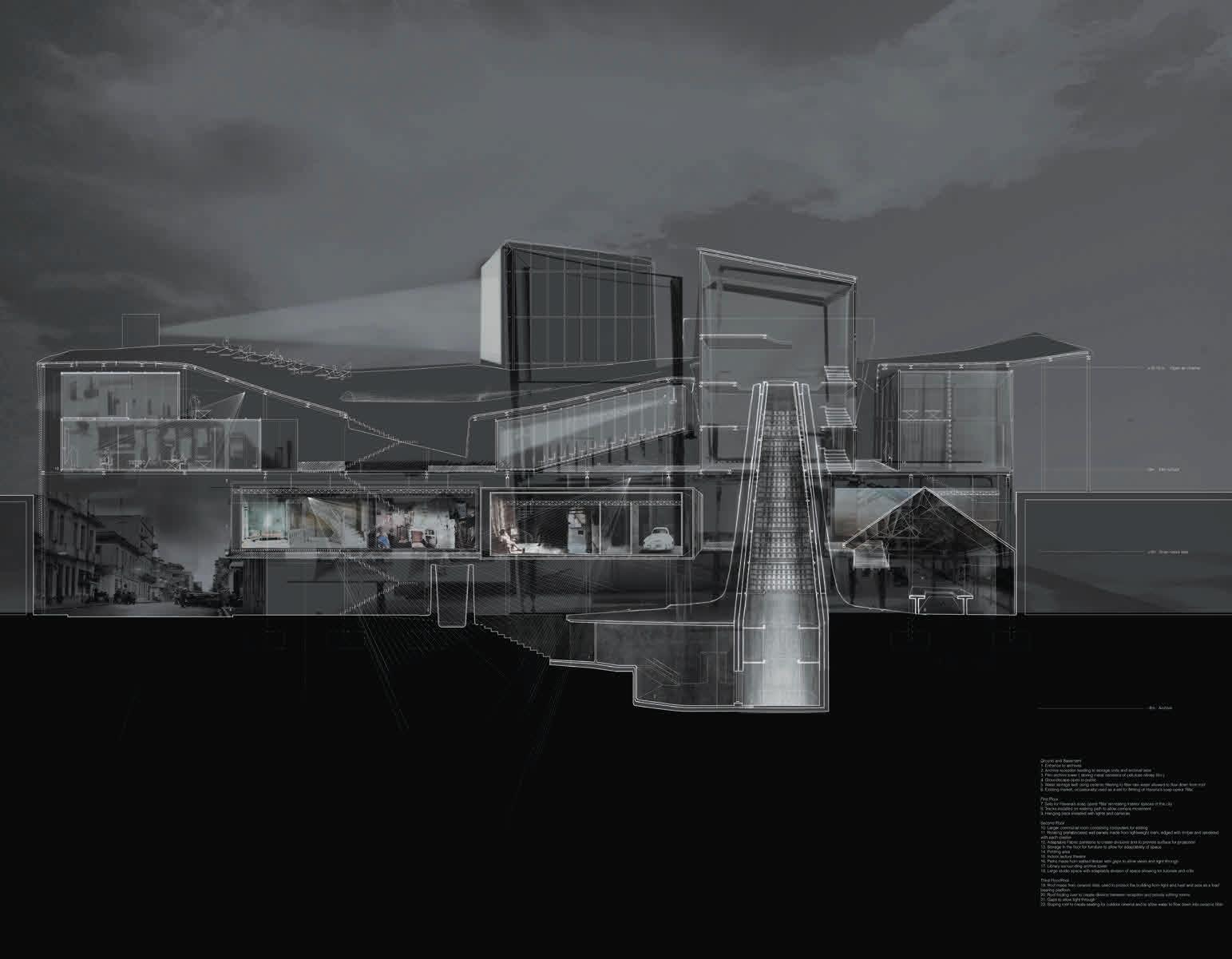

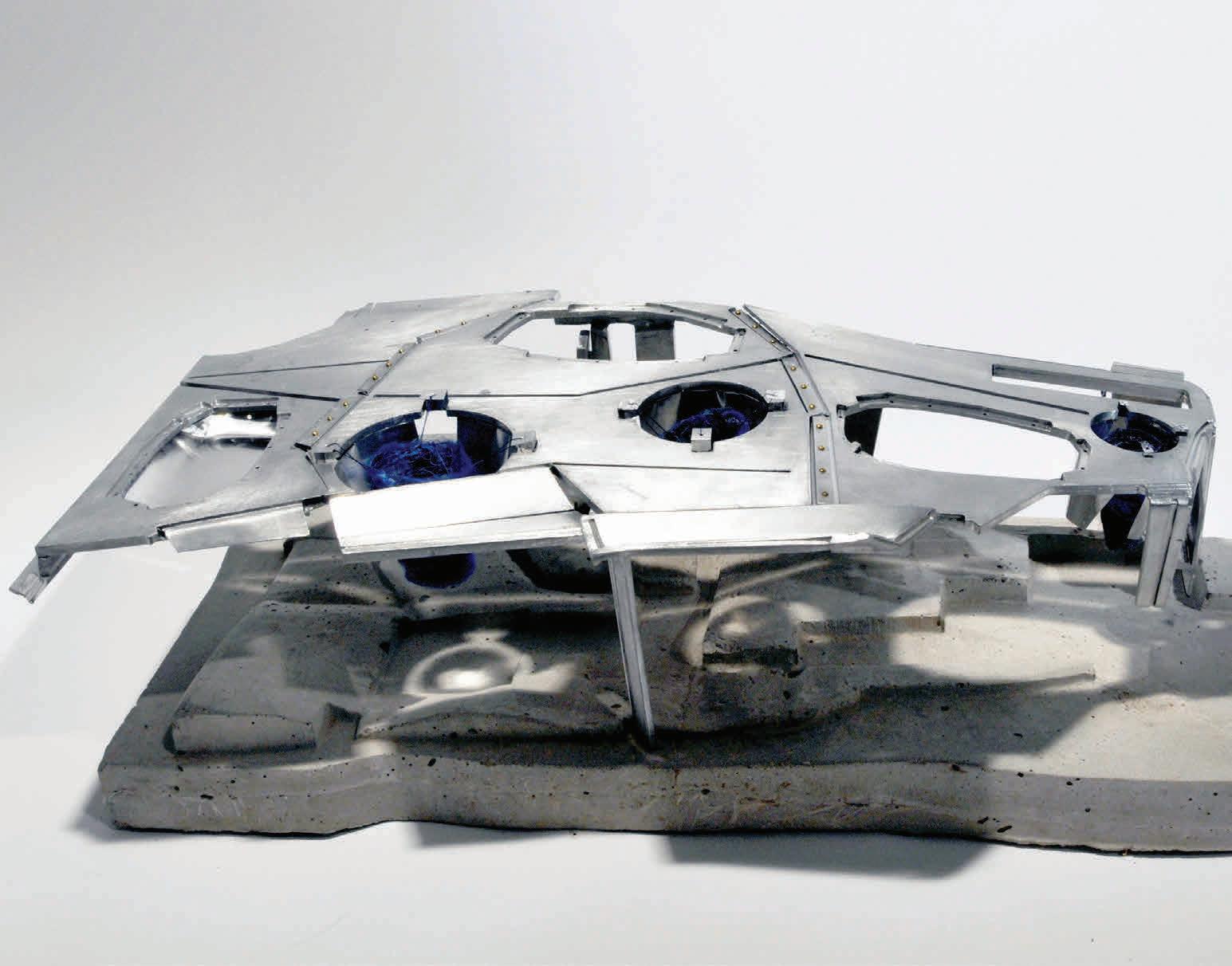
Fig. 6.16 — 6.17 Geethica Gunarajah, Casablanca Ceramics Centre, Havana. The programme facilitates the revitalisation of Cuba’s architectural identity, lost since the embargo, through utilising Havana’s wide local resource of Matzana red clay. The building demonstrates reinventions with modular clay construction, which consider interplay with sunlight, water and ventilation on the steep hillside site. The resulting experiential qualities appropriately accommodate the education and manufacture of clay arts and crafts. Fig. 6.18 Yu-Me Maru Kashino, Taxi Motel and Tinkering School, Kings Cross, London. Fig. 6.19 Nadia Wikborg, Flower Carts, Salusbury Primary School, London. The project explores how children learn about the natural world. The children
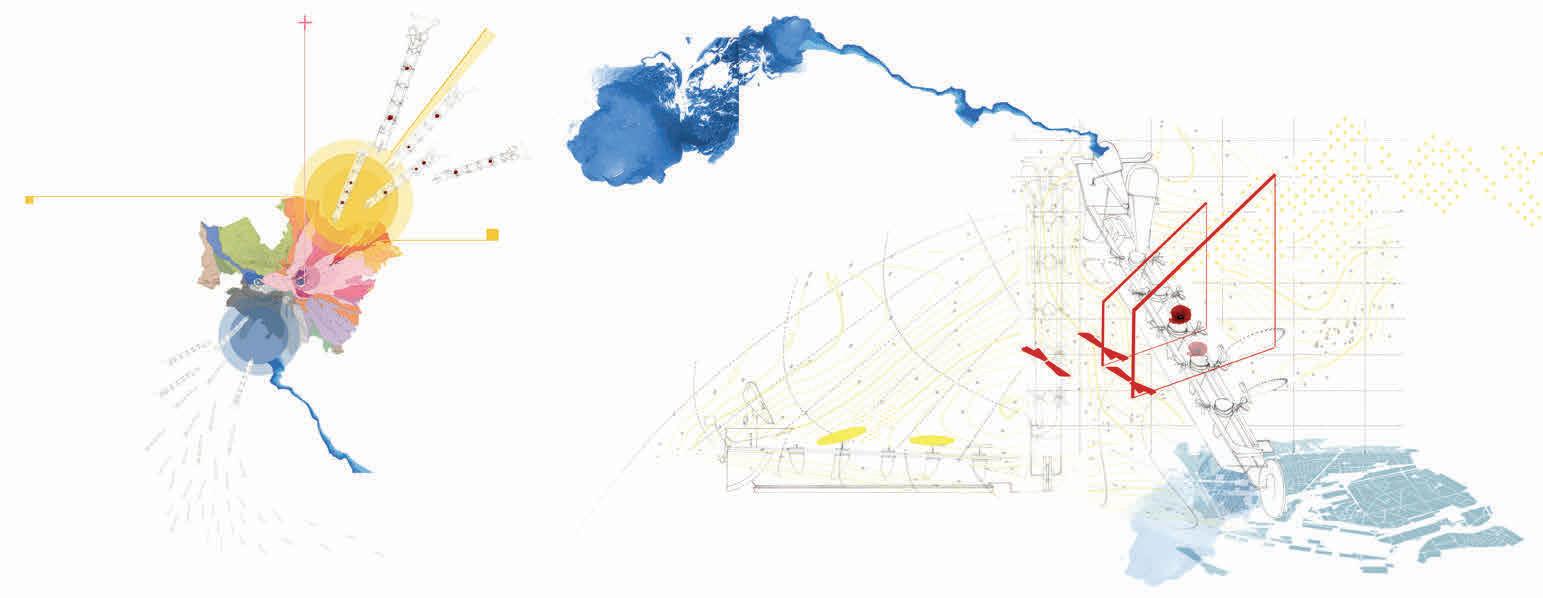
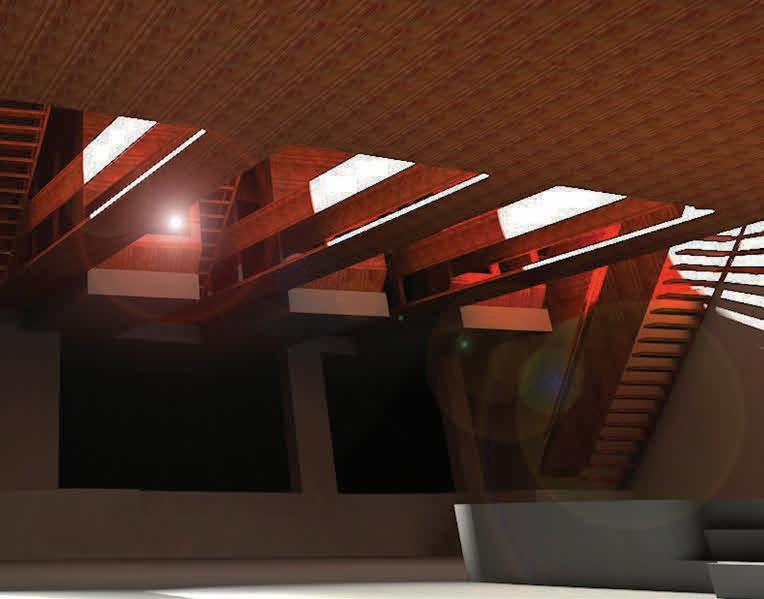
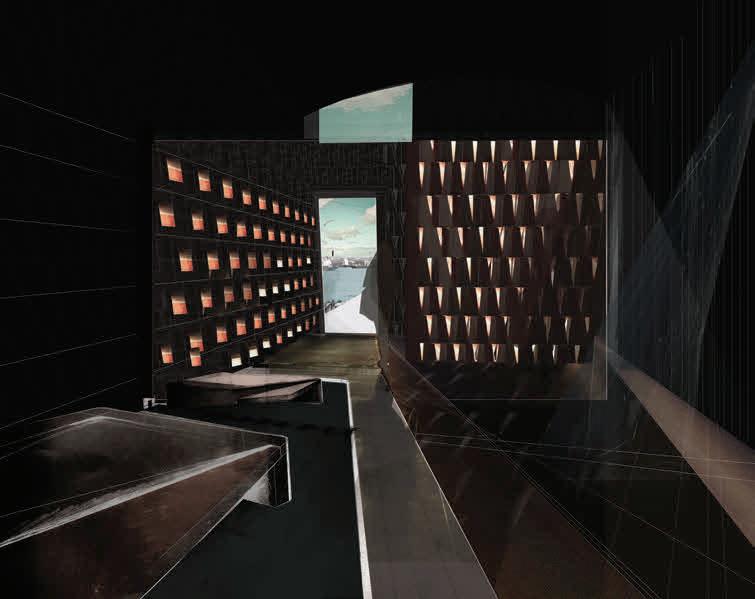
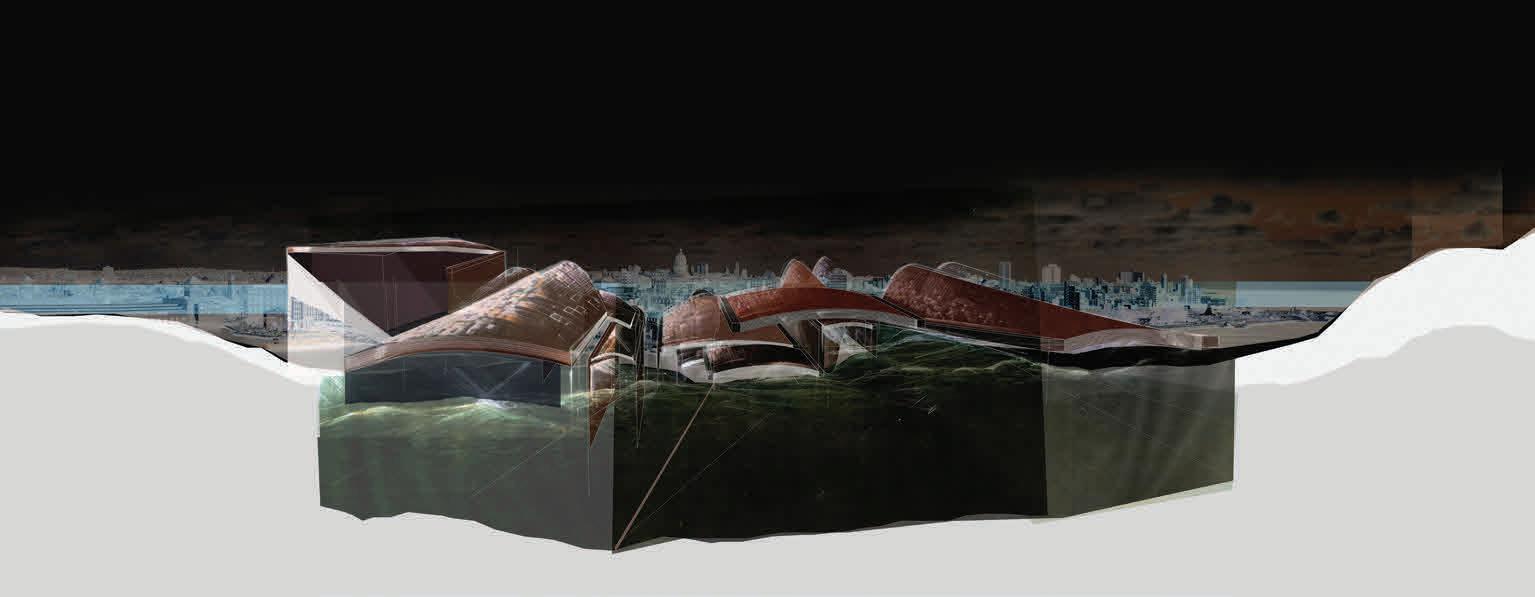
are encouraged to grow and care for flowers which are brought from home to school in personal carts. Fig. 6.20 Samuel Douek, The School of Sustainability, Havana. The culture of self-sustainability that came out of an era of challenging socio-political change is under threat. The School of Sustainability will attempt to maintain Socialist ideology in a ‘post-Castro’ era by educating Cubans of all ages about sustainable technologies that have been researched and developed on site. The construction and repair of the school itself will be the primary form of education, offering the opportunity for inexperienced volunteers to learn sustainable construction techniques, promoting independence from the state.
6.16 6.18
6.17 6.19

Housing 192060 Christine Hawley, Paolo Zaide
H O U S I N G 1 92 0 6 0
Within the next 50 years our way of living will change in ways that are now unimaginable or are they? The development of the electronic highway in the last 20 years has revolutionised the way in which we receive information, work, travel, shop and socially interact. In the next 50 years technical, infrastructural and social change can and should radically affect the way we think about the use of architectural space In the 1960s Archigram speculated about floating, walking and drop cities, while the social realists at Narkomfin developed a housing model that was the embodiment of the communist dream; and E M Forster and George Miller saw a darker future in 'The Machine Stops' and Mad Max. This year the question we would like to ask is, how radical is your picture of the future? And we suggest alternatives to a housing model that has remained largely unaltered for the last four centuries
The first term the programme offers an opportunity to look into the future on a much smaller scale. The aim is to design a ‘house’ that must address the logistics of everyday living, incorporating spaces nuanced by the owner’s pre-occupations and dreams This is a dwelling that addresses both the mundane and the extraordinary and acts as a springboard for the more strategic agenda of the second project
The lepidopterist, the astronomer, the underground archivist will reside in a place that accommodates the peculiarities of their activities.
There are of course existing examples of residences that are designed around thematic obsessions and extreme practical needs: the Casa Batlio in Barcelona and the Matharoo House in Ahmedabad are instances of intellectual and practical requirements shaping extraordinary places. The site for the first project is on the perimeter of Regent’s Park where the town meets parkscape and water.
Influenced by the first exercise the second project may ask questions about the possibility of customisation rather than the current preoccupation with standardisation.
The unit trip took us from Madrid to Barcelona to study eccentric houses and collapsed housing markets This project should push the boundaries of all possibilities, creating a balance between the practical and the poetic, the real and the unreal.
Year 2: Nichola Czyz, Yoonjin Kim, Christopher Worsfold, Songyang Zhou Year 3: (Julia) Ran Chen, Haeseung Choi, Max Dowd, Alicia Gonzalez-Lafita, Yu Chien Wendy Lin, Amanda Jayne Moore, Michael Pugh, Tian Qin, Charlotte Reynolds, Charlotte Moon
Fig 6 1 Sunny Qin, Tailored living in 2060, In 50 years’ time, with the matured technology of prefabrication, people are able to live in the tailored home a home which is made up of a series of slices; each slice is selected by the occupant according to their specific needs Fig 6 2 Nichola Czyz, GMT-4 Greenwich Self-Cleaning market, External Fishmongers Hostel, Olfactory Ice Garden, Oyster Steam Bar, Tilapia & Oyster Farm, Fishbreeders House The Space is reconfigured throughout the day to suit the Fishmongers who exist in their own timezone next to the Greenwich Meridian; the market seeks to take advantage of the diurnal tidal shift


Fig 6 3 Max Dowd, The Frozen Zoo Project, Regent’s Park
A cryogenetic archive of the species residing at London Zoo in a 7-storey water tower in response to the threat of rising sea levels Fig. 6.4 Alicia Lafita Gonzales, Softening Transitions An architecture for Alzheimer ’s disease reducing ‘Sundown Syndrome’ through the manipulation of natural light Fig. 6.5 Amanda Moore, Edible Park and Housing Complex, Greenwich, London (2060) Housing for 1000 residents and an integrated farm which provides 200 residents with all of their fruit and vegetables The project questions current problems of fuel usage in producing food and suggests using localised sources Fig. 6.6 Chris Worsfold, Housing with cooking school Anticipating a dramatic demographic shift the project seeks to aid integration Each apartment is provided with an external green space that acts as a hybrid between allotment and balcony, functional yet providing a platform for temporary

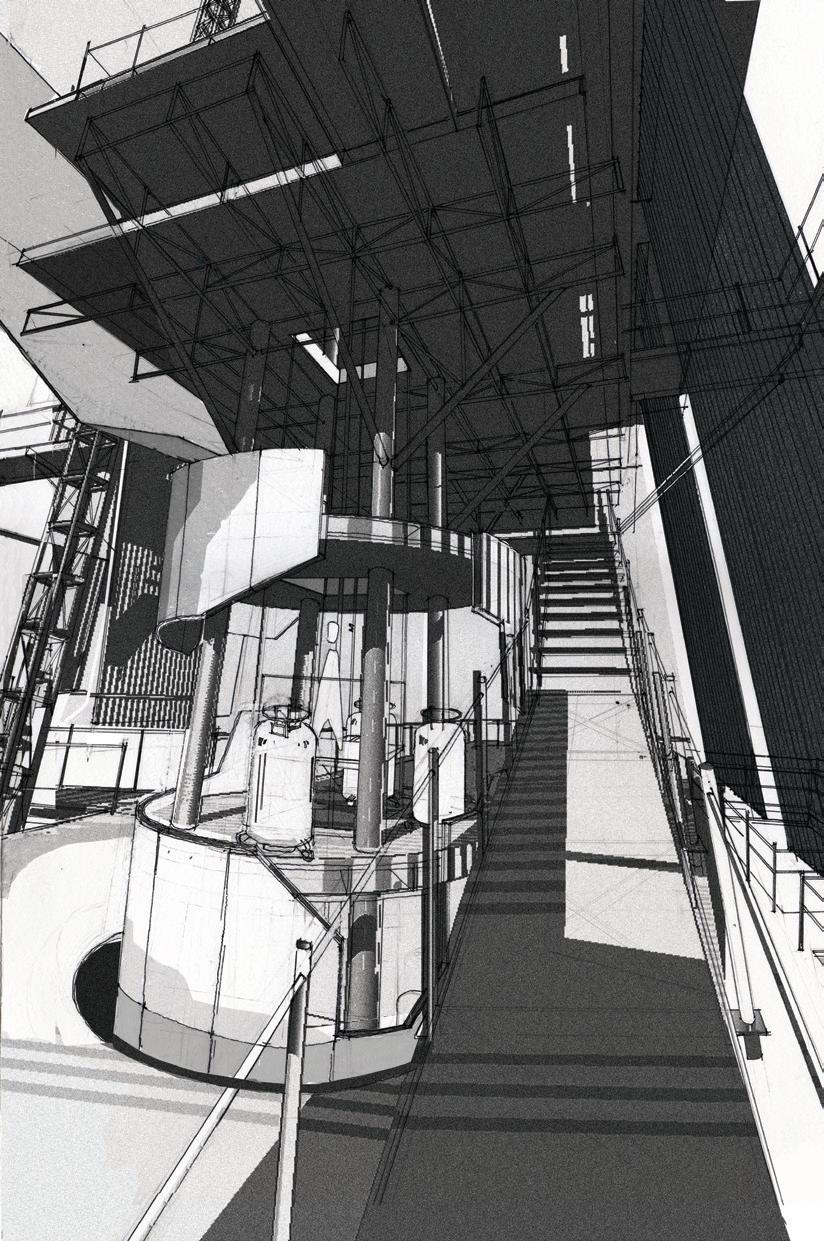
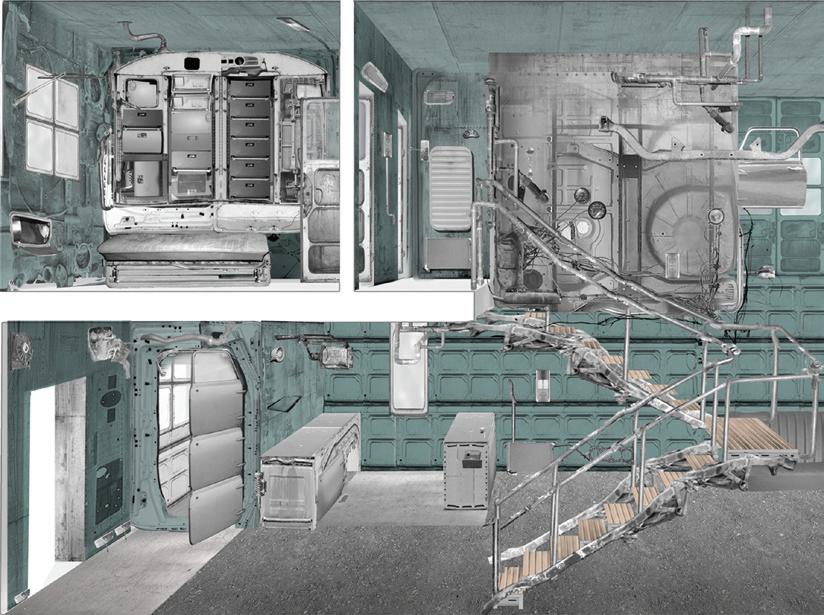

inhabitation conditioned by the British weather Fig. 6.7 Haeseung Choi, Car Breakers’ Yard and Housing The upcoming post-oil generation has slowly begun to make the automotive technologies of today redundant The housing project integrates repurposed elements from the car and places them within the house Fig 6 8 Michael Pugh, Urban cattle farm + housing scheme: Deptford Creek, London 2060 Adapting to a major climate shift with the shutdown of the Gulf Stream conveyor, the building responds to depleted imports and exports due to poor transport in the winter months The building safeguards food security by moving agricultural typologies into areas that require it A mutual symbiosis is then formed between man and beast to weather the cold season
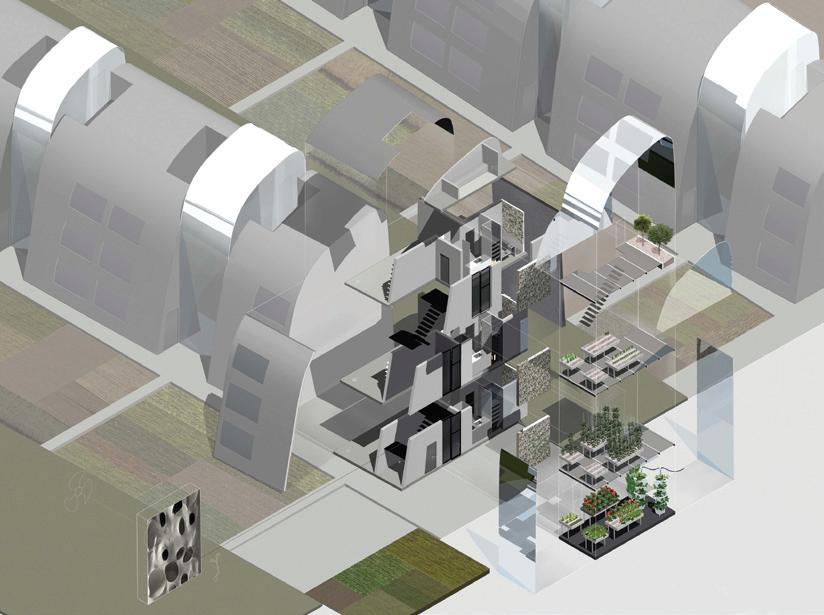
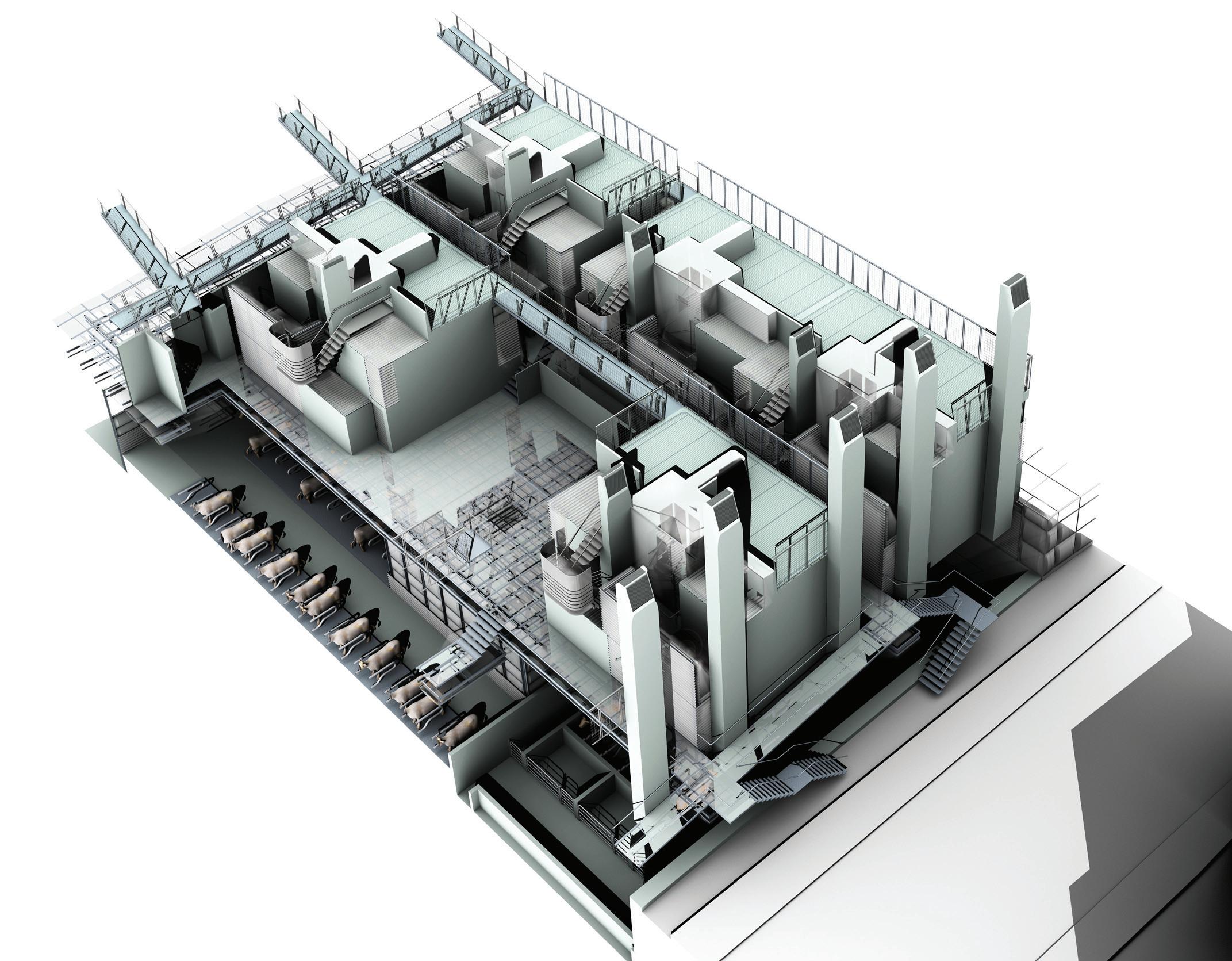
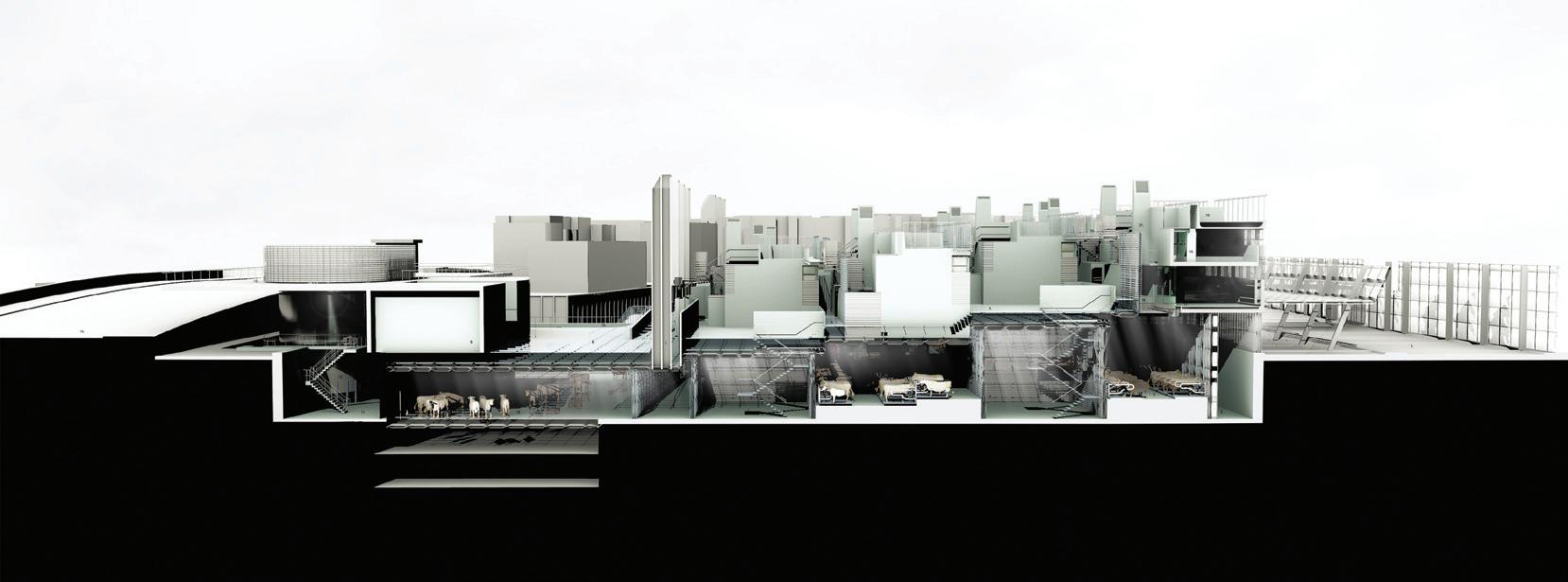
Fig. 6.9 Wendy Lin, A ghostwriter’s house The project explores filmic motifs of ghosts, shadows and ambiguous space The building is underground and everything within it floats Taking a journey through the building is like reading a ghost story slowly unravelling until one reaches the climax Fig. 6.10 Songyang Zhou, Library of the Future The building preserves the artefact of the book, at a time when technology challenges our current forms of reading A central tower houses more valued books, with the rest of the building acting as reading spaces interwoven with water Fig. 6.11 Ran Chen, The Therapeutic ‘Slowtown’ for the Elderly The project is a study on how to create a therapeutic landscape for the elderly in 2060 Throughout one day residents could capture different sets of sensorial experiences of the natural environment outside the building, with water channels meandering through the building and horticultural plots growing over the roofs Fig 6 12 Sarah Edwards, Housing for narrowboats’ owners
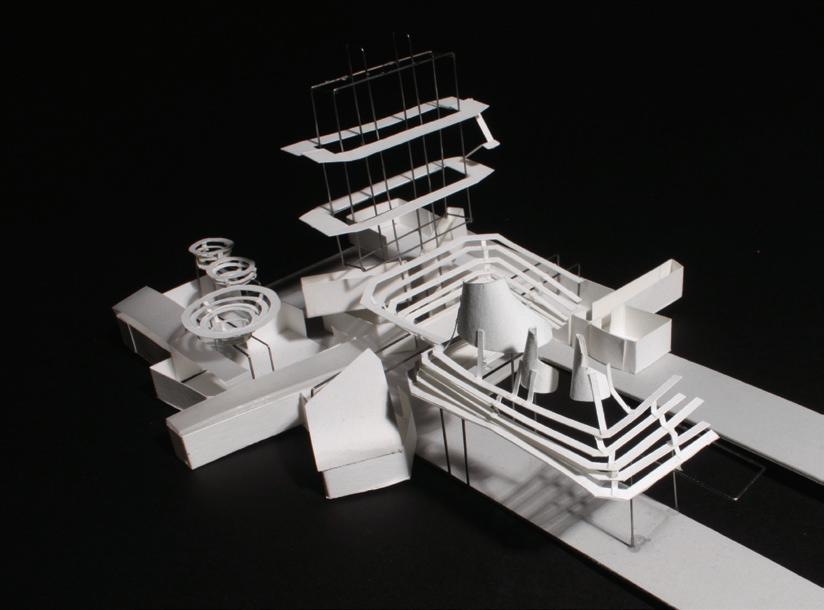

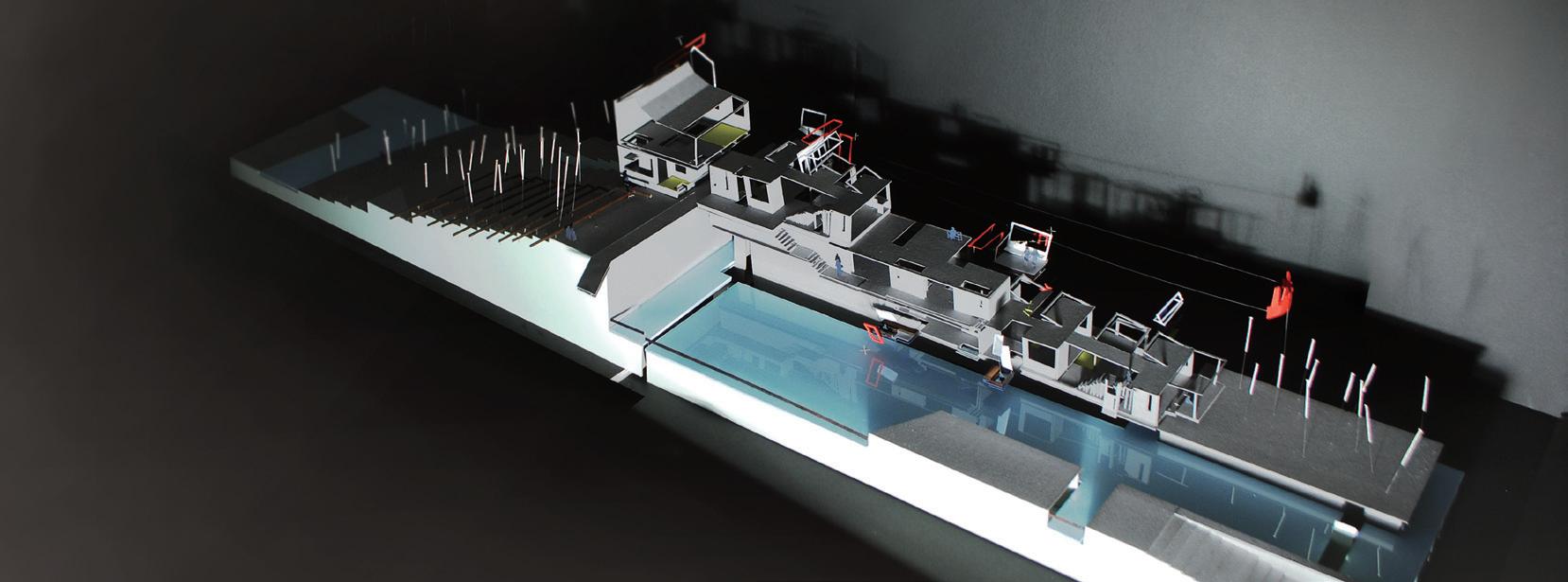
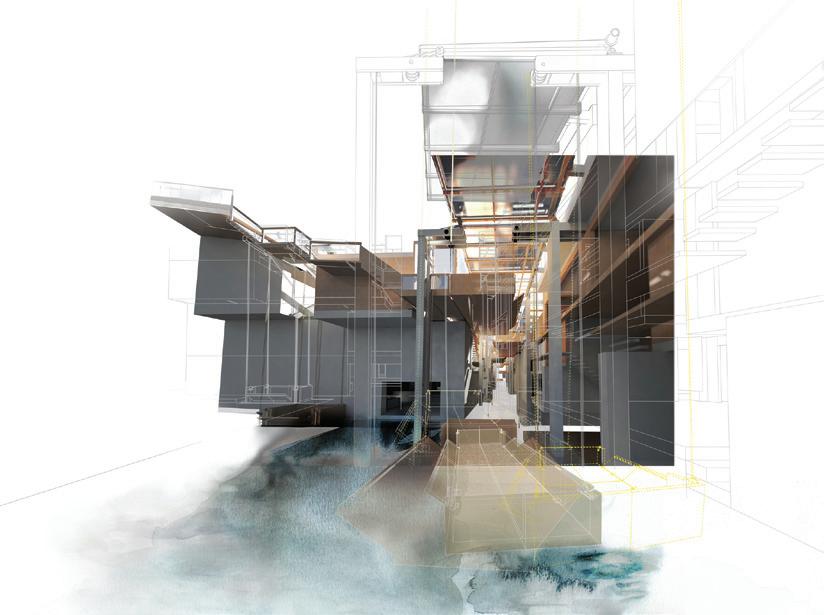
and temporary mooring facilities, Bethnal Green Gas Works, Regent’s Canal The house is an extension to a cramped life on a 20m narrowboat but continues to implement its space-saving devices Fig. 6.13 Yoonjin Kim, Housing for Multigenerational living, Deptford Creek The Thames waterscape activates the reconfiguration of the scale of communal areas between typologies It aims to be conceived as if everyone lives in the same ‘house’, and at the same time, each one has a very individual ‘home’ in the same space Fig. 6.14 Charlotte Reynolds, Deptford Peninsula Riverboat Station The project links the poorly connected Deptford Creek site with a citywide waterbus network, powered by energy harvested on site from algae It provides a riverbus transport station and also a boatel: short-term accommodation for both business travellers and tourists alike The key influence of water and the relationship between the macros scale of the landscape and the micro scale of the domestic house are key
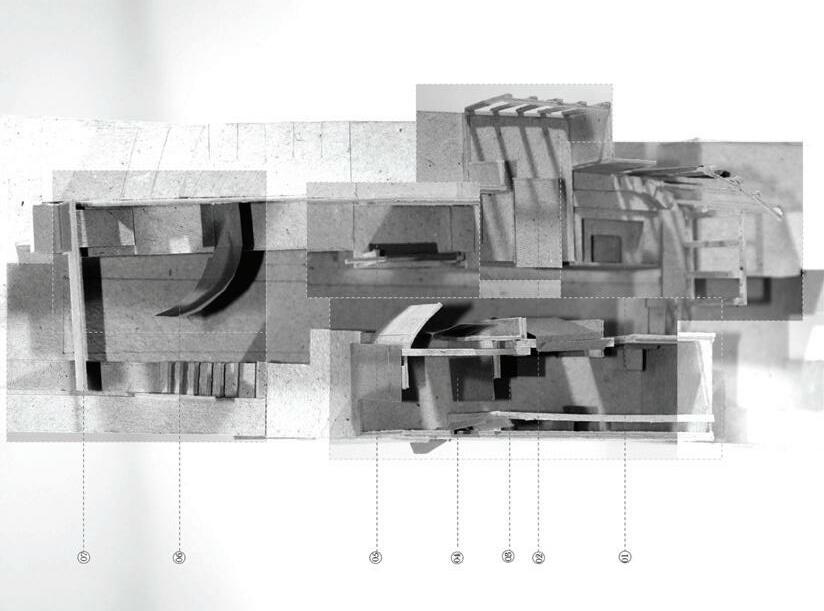

Foods and Excess Christine Hawley, Paolo Zaide
Foods and Excess
Over the next twenty years cities will undergo unpredictable transformations. Rapid change in technologies, social and environmental conditions will shift the form and perception of urban environments. We set out to investigate the 21st century metropolis, exploring the contradictory relationship between invisible systems and the buildings that host them.
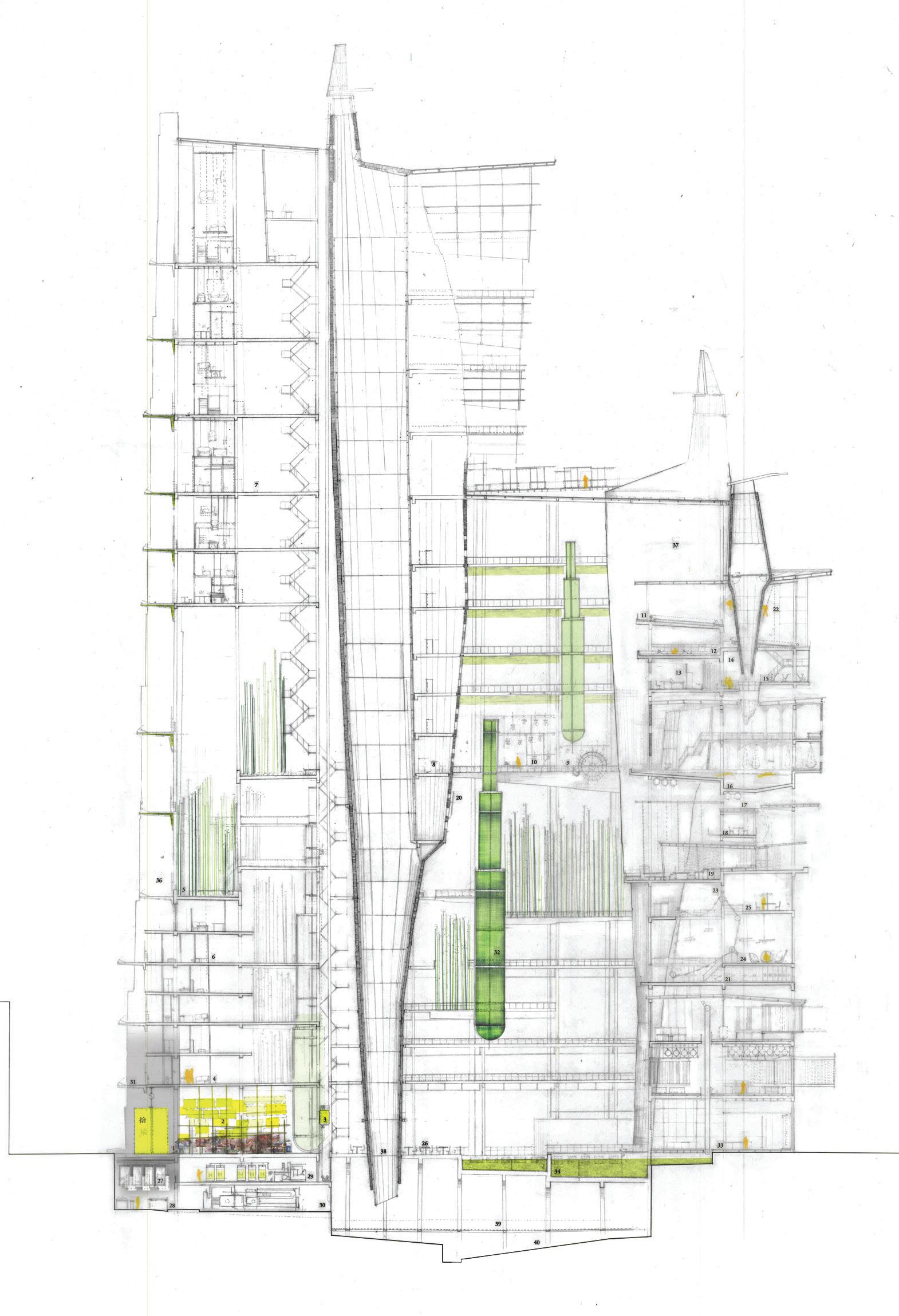
The word ‘flood’ conjures an immediate image of water: excess and its chaotic aftermath. Traditionally we have developed systems to control and contain these fluctuations. However, one could intervene in such a way that the huge dynamic of this phenomena be creatively used to benefit cities.
We should also consider the concept of ‘flood’ beyond the realms of the natural. A super-imposition of imagery and information systems supported by increasingly powerful technology ‘flood’ our conscious and unconscious world prompting subtle changes of habit. Flood conjures up images of drama and intensity. Consider the palettes of Klein and Kapoor where colour floods the eye. Gabriel Garcia Marquez’s essay, ‘Light is like Water’, uses light to ‘flood’ the room with dramatic and terrifying consequences. The invisible yet cataclysmic force of the global economy can be manipulated by ‘flooding’ financial markets.
Unit 6 set out to question this concept and its impacts on the micro and macro environment. Abstract ideas must be rigorously tested in drawings and models and this process formed an essential part of our exploratory methodology. The second part of the year took the thread of the earlier explorations and developed these together with the notion of excess.
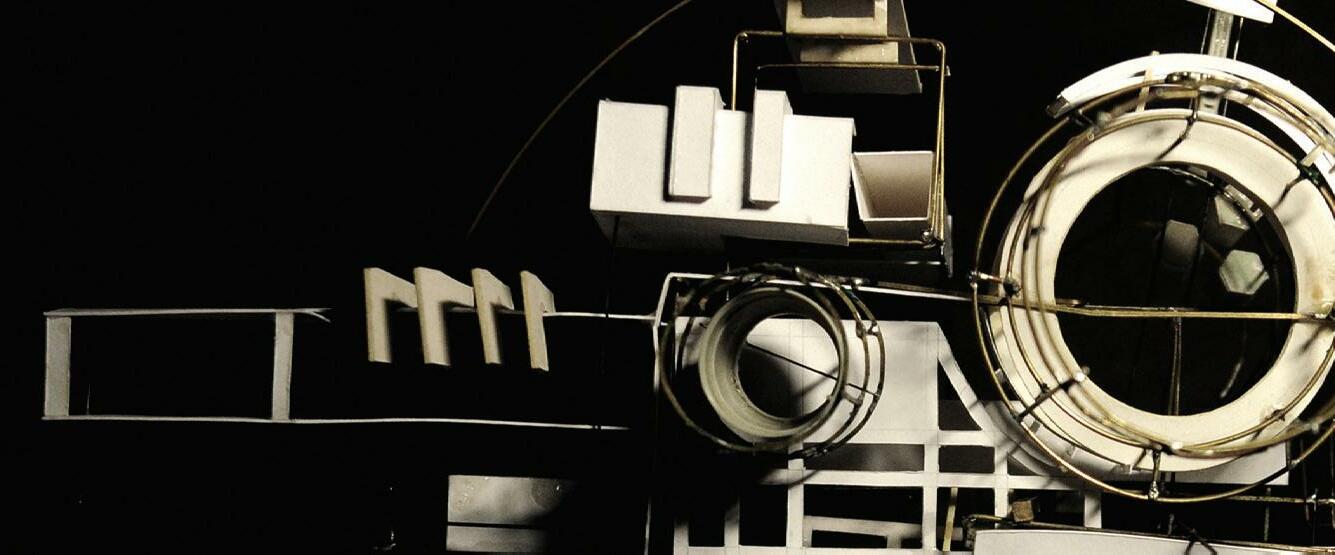

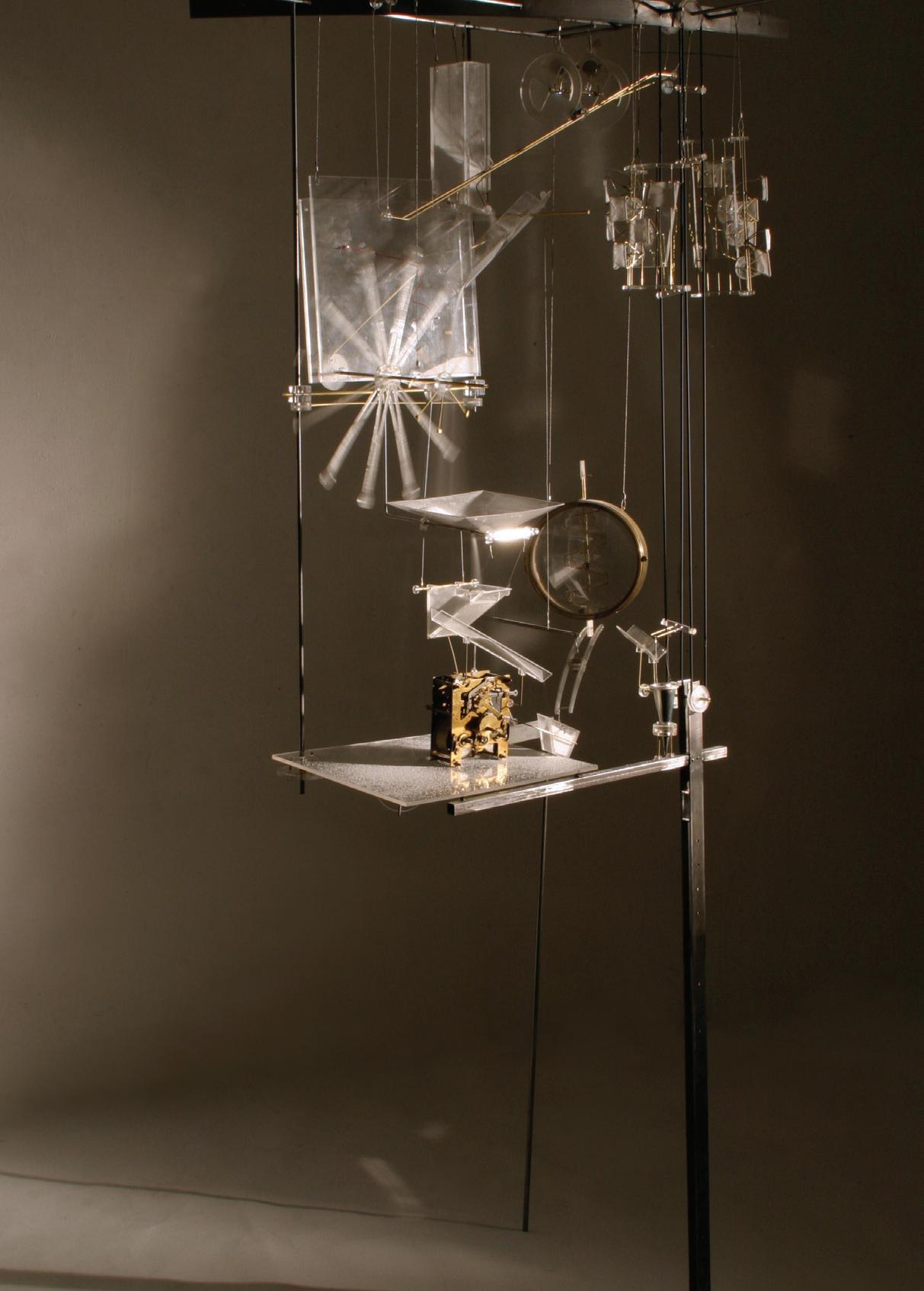
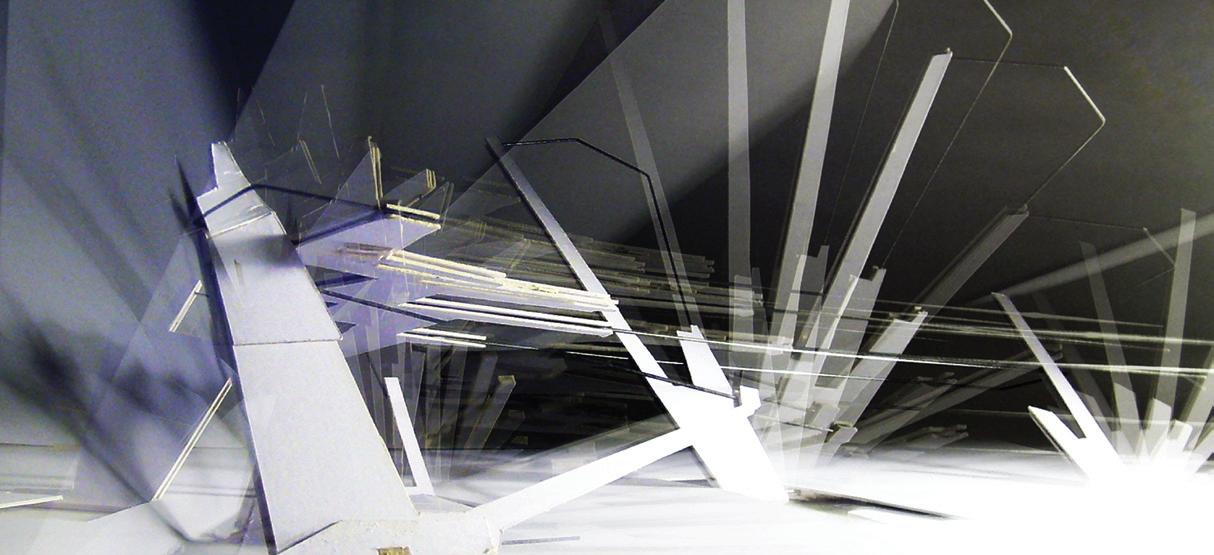
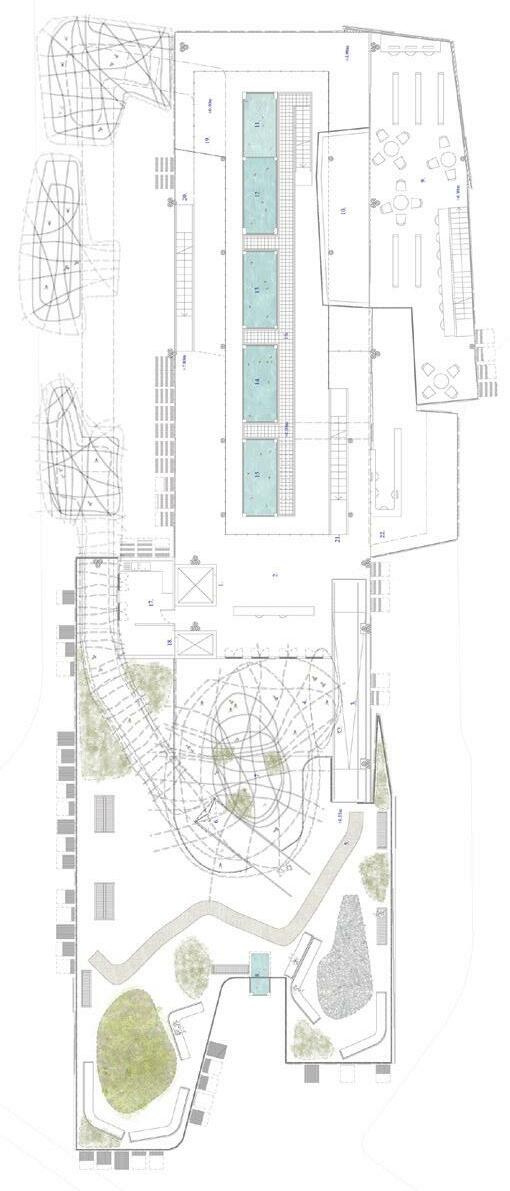
 Clockwise from top left: Georgina Goldman, Defensive Wrist Piece; Linlin Wang, Water Intoxication Model; Hyder Mohsin, Pop-Up Hinge Mechanisms; Risa Nagasaki, Koi Cockatoo Fan Club.
Clockwise from top left: Georgina Goldman, Defensive Wrist Piece; Linlin Wang, Water Intoxication Model; Hyder Mohsin, Pop-Up Hinge Mechanisms; Risa Nagasaki, Koi Cockatoo Fan Club.
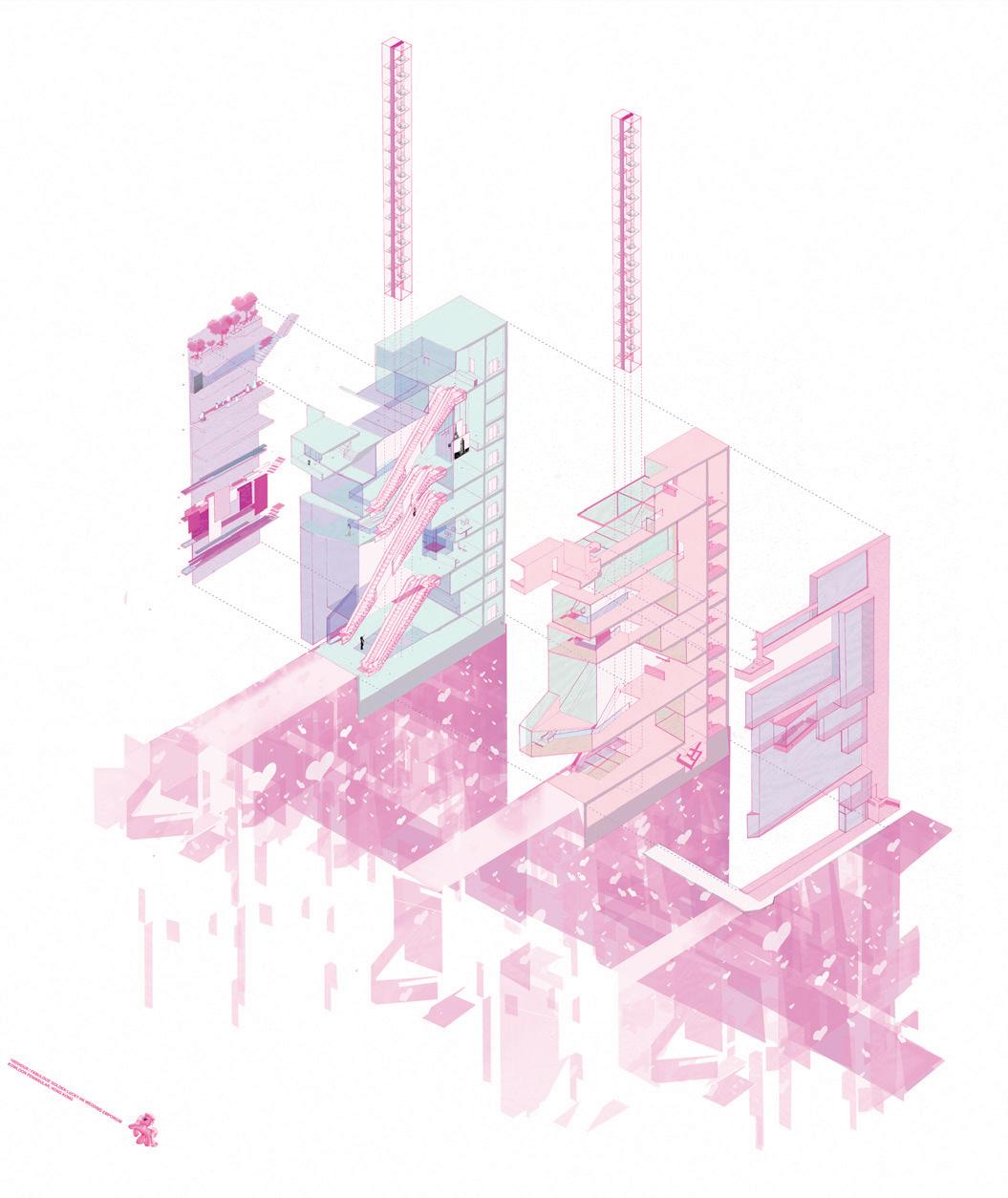
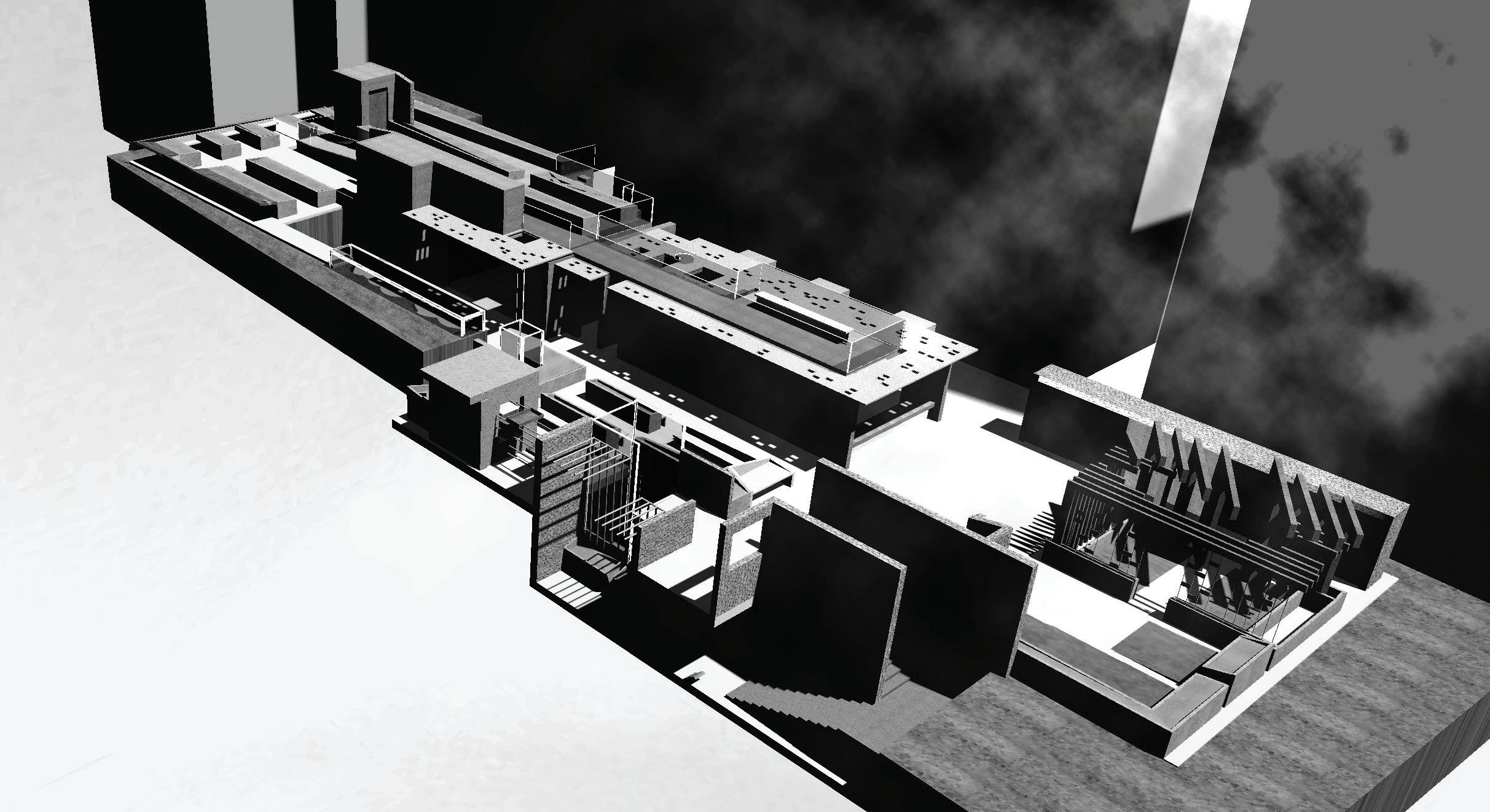

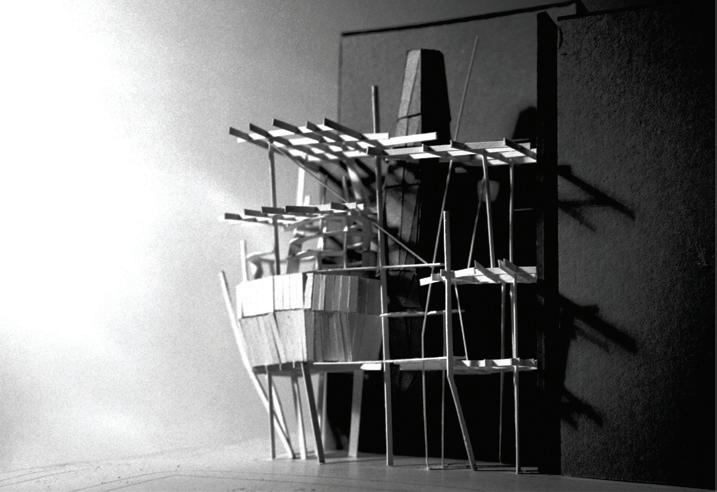 Clockwise from top left: Ami Matsumoto, Ephemeral Poetry Book; Adam Peacock, Hideous/Fabulous Golden Lucky HK Wedding Emporium; Naomi Gibson, Day Community Centre for the Elderly; Sungwoo Park, Traditional Chinese Medicine Centre.
Clockwise from top left: Ami Matsumoto, Ephemeral Poetry Book; Adam Peacock, Hideous/Fabulous Golden Lucky HK Wedding Emporium; Naomi Gibson, Day Community Centre for the Elderly; Sungwoo Park, Traditional Chinese Medicine Centre.

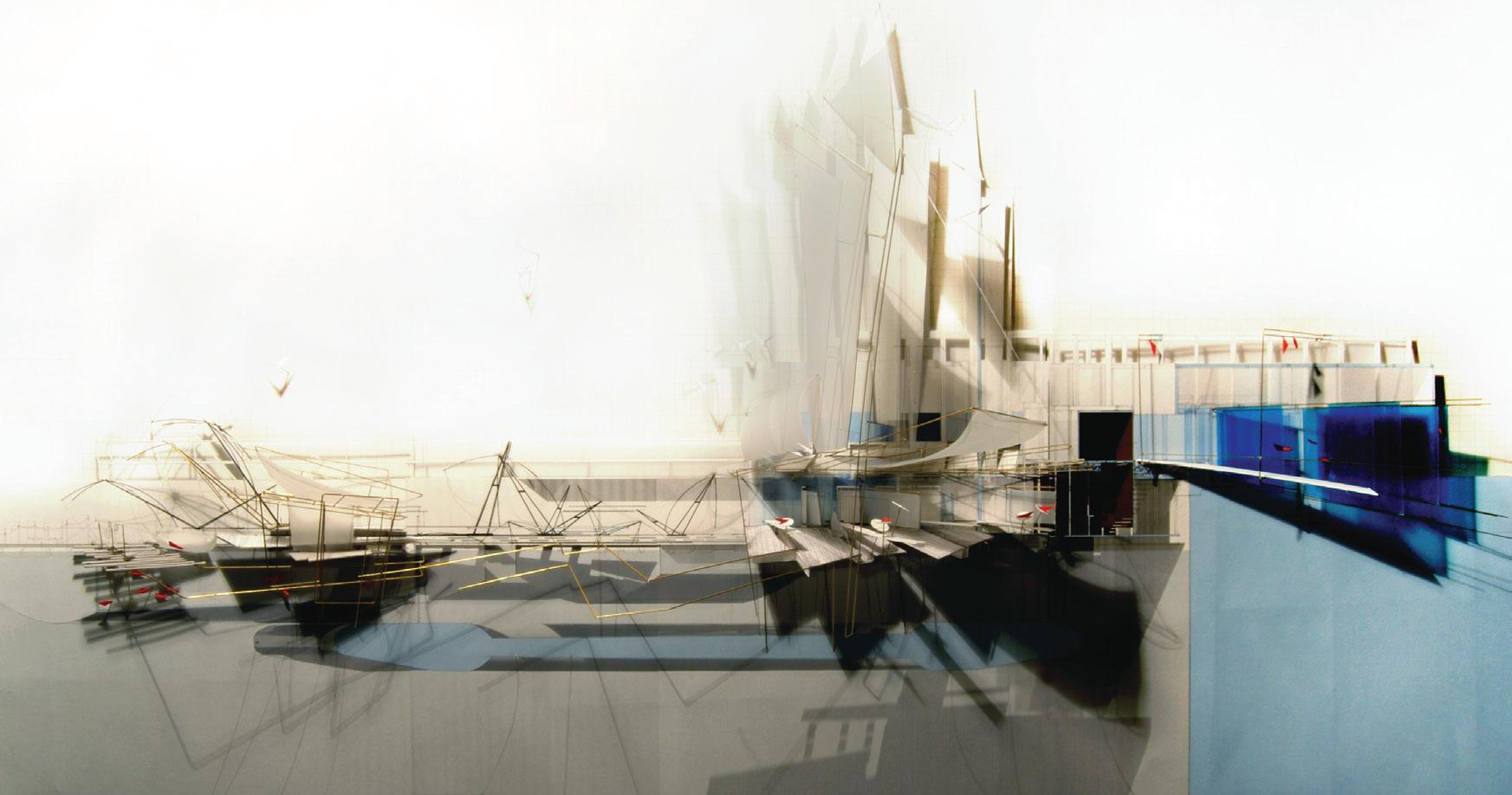
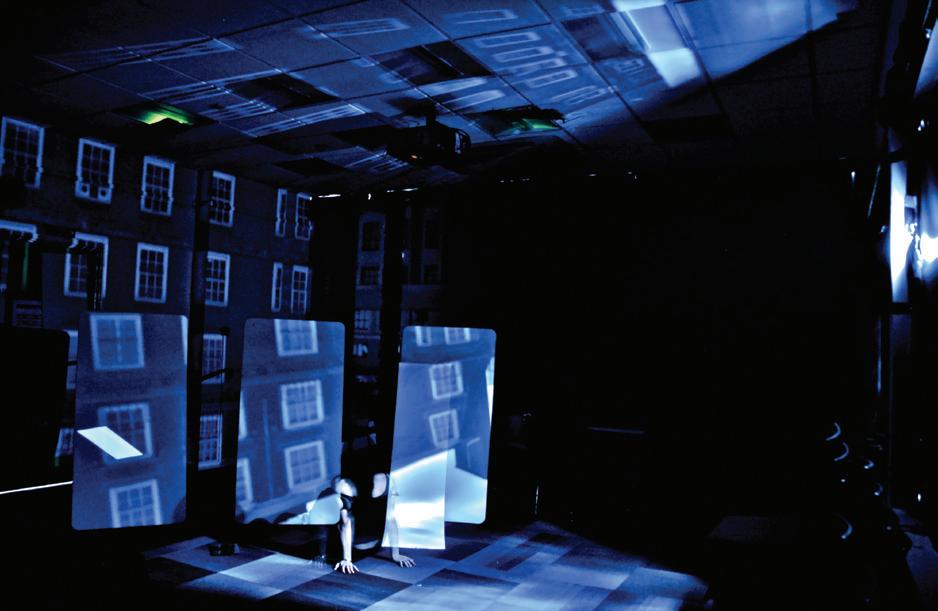
 Clockwise from top left: Mika Zacharias, Marine Centre and Spa, Victoria Harbour; Li Zhou, Hong Kong Window Study; Daniel Lane, Kowloon Centre of Sound; Frank Siyu Fan, Public Fishing Complex.
Clockwise from top left: Mika Zacharias, Marine Centre and Spa, Victoria Harbour; Li Zhou, Hong Kong Window Study; Daniel Lane, Kowloon Centre of Sound; Frank Siyu Fan, Public Fishing Complex.
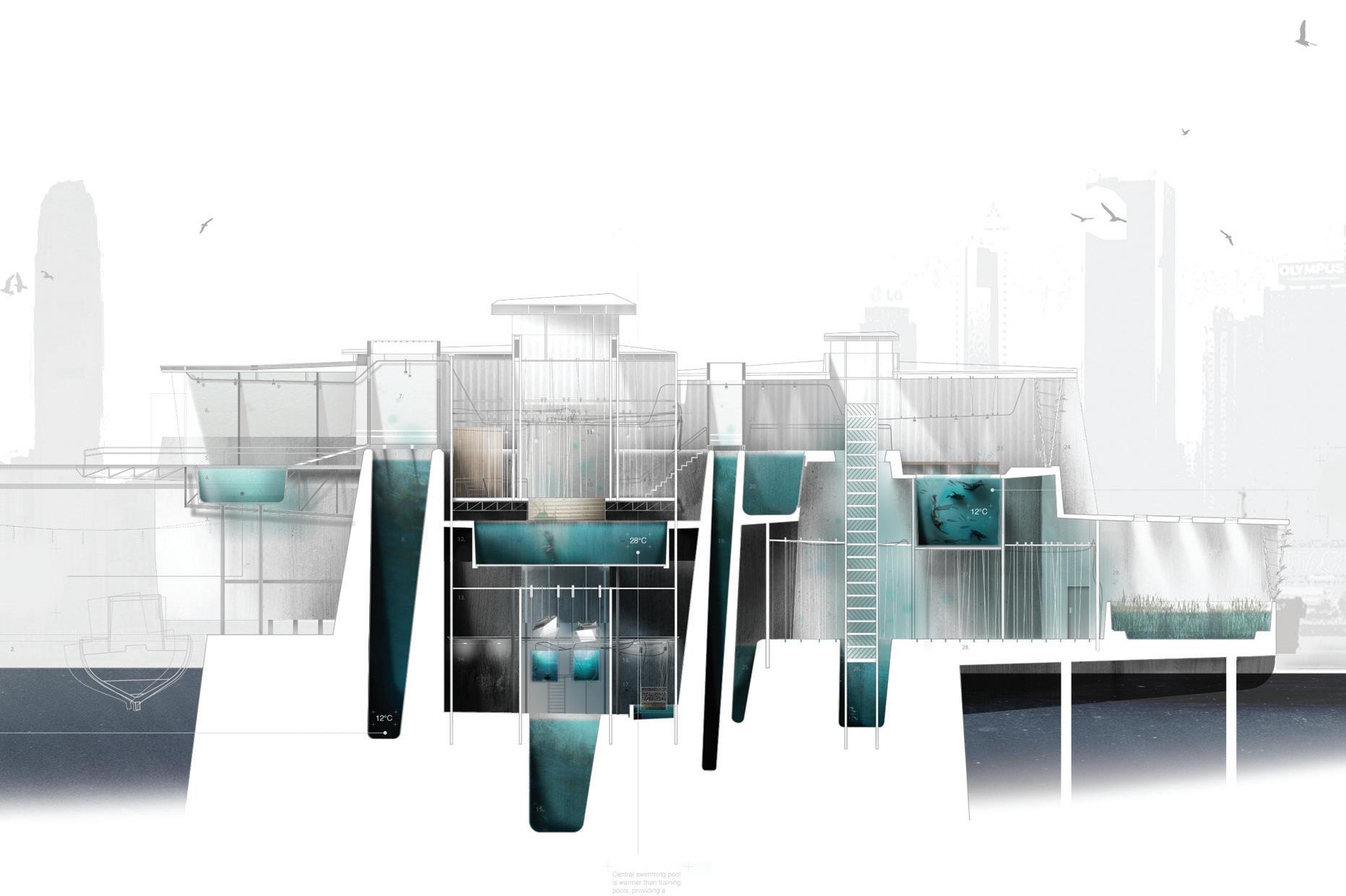
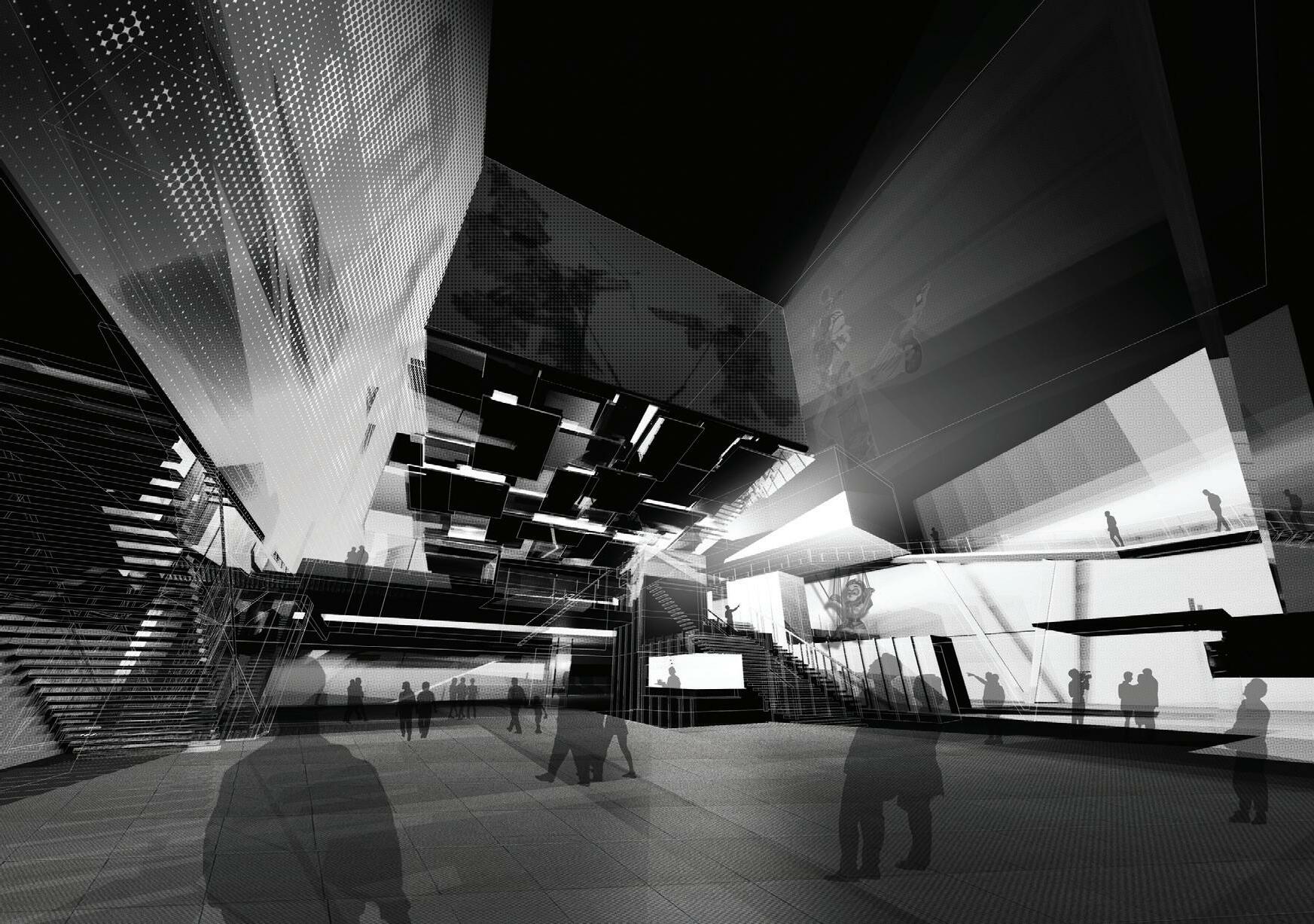 Top: Mika Zacharias, Marine Centre and Spa, Victoria Harbour. Bottom: Yuchen Wang, Contemporary Shadow Theatre. Opposite: Ka Man Leung, Banker’s Garden Retreat.
Top: Mika Zacharias, Marine Centre and Spa, Victoria Harbour. Bottom: Yuchen Wang, Contemporary Shadow Theatre. Opposite: Ka Man Leung, Banker’s Garden Retreat.
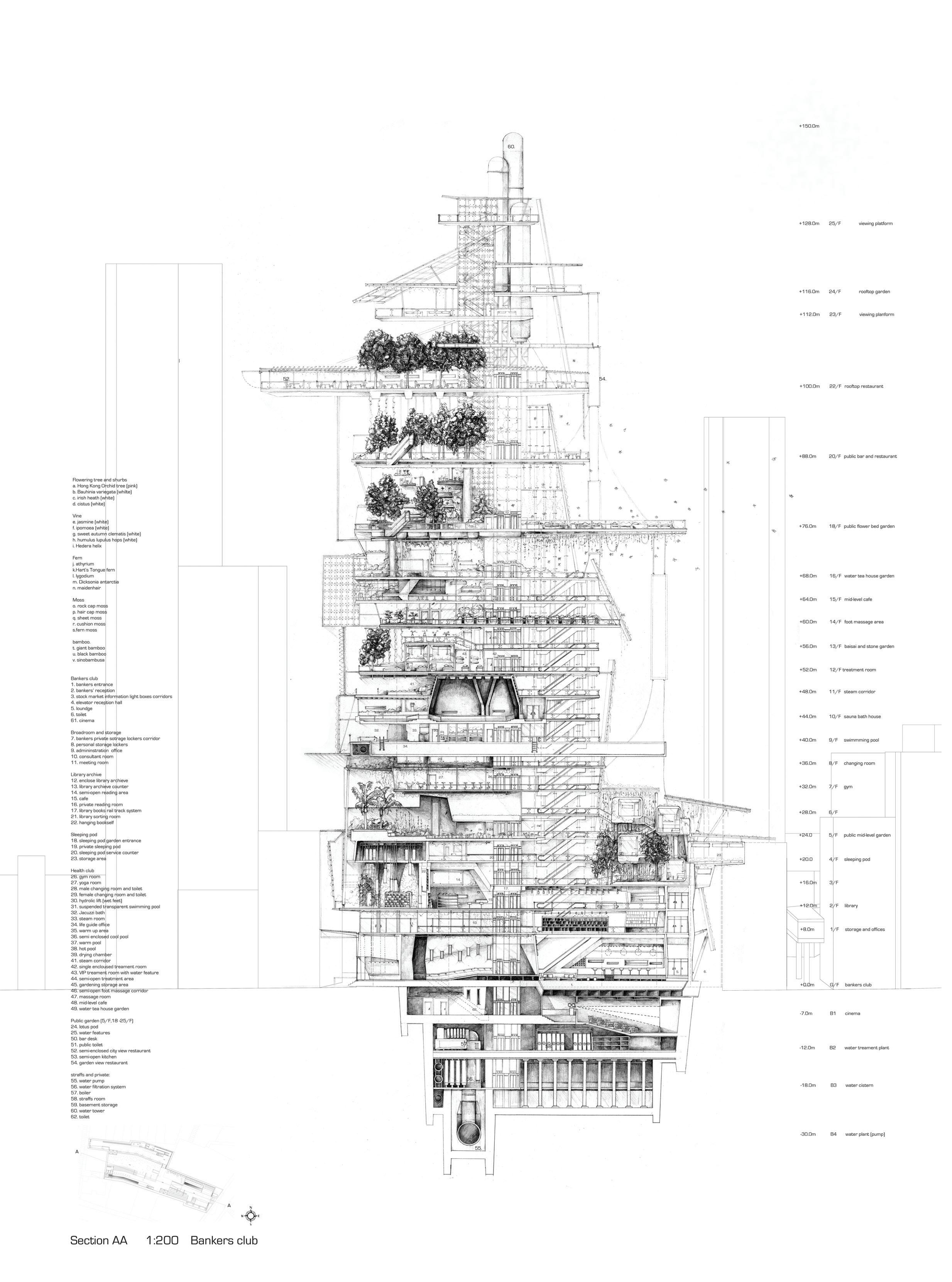
Altered States Liam Young, Paolo Zaide
Altered States


“Going mad is the only way of staying sane.” - J.G.Ballard
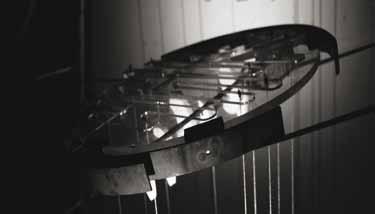
Lost on strange islands suspended within the familiar spaces of the everyday is the vagabond troupe of DIY eccentrics, adventurers and malcontents who conjure their own atlas of Micronations. These fictional states vary in physical scale from the islands of 17th century pirate utopias, to an abandoned anti aircraft tower in the middle of the North Sea or the sitting room of an anonymous flat in east London. They merge fact, myth and speculation in their embrace of a parallel world, motivated by political subterfuge, legal loopholes, an immoderate love of royal titles, or a disenchantment with the commonplace.
This year Unit 6 authored our own archipelago of fictional states. We navigated this critical space between the actual and the imagined, a space where architecture can enter into new relations with the territories of science and fiction. We wandered off the map, through the speculative landscapes of dreams and desires, on a future safari into brave new worlds that have mutated from our own. These projective states are actually readings of the world we are now in, an experience of the present as a site of possible futures. Projects slip suggestively between mistakes, myths and lies – a ‘combinatory capacity’ of infinite and unsettling possibilities.
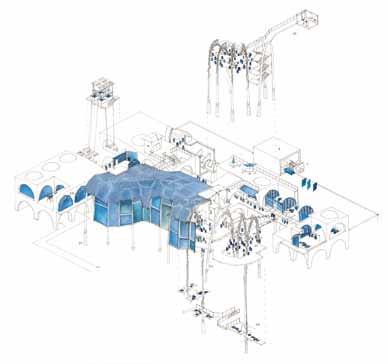
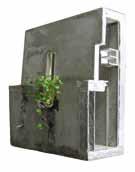
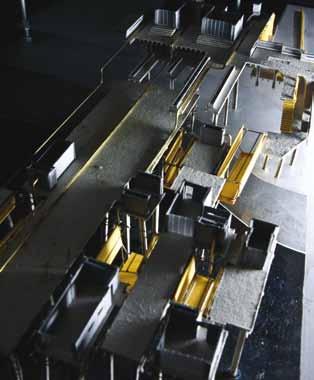
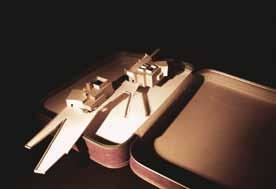


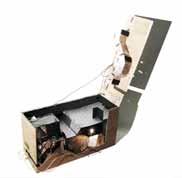
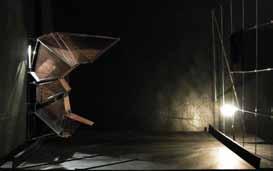 Top left: Michelle Young, Border Control. Right (top to bottom): Nicholas Blomstrand, David Rhys Jones, Jake Attwood-Harris. Middle left: Joel Cady, Jake Attwood-Harris, Route of interior illusions. Bottom: Imran Perretta, AnarchaeologyofBrickLane.
Top left: Michelle Young, Border Control. Right (top to bottom): Nicholas Blomstrand, David Rhys Jones, Jake Attwood-Harris. Middle left: Joel Cady, Jake Attwood-Harris, Route of interior illusions. Bottom: Imran Perretta, AnarchaeologyofBrickLane.
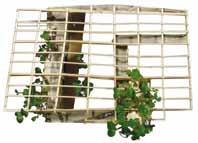

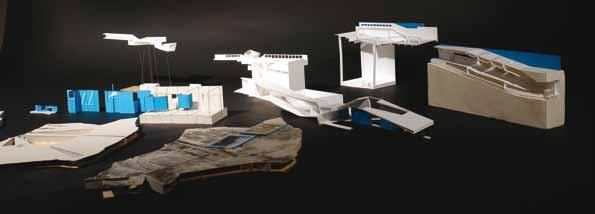
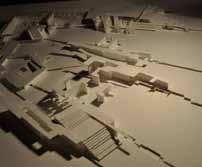
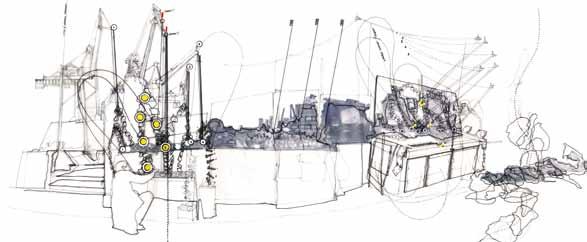 Clockwise from top-left: Nicholas Elias, Istanbulmapping;marketplace; Imogen Holden, Charcoalwatergardens; Joel Cady, TheOlympic Dreamer’sModels;Imogen Holden; Joel Cady.
Clockwise from top-left: Nicholas Elias, Istanbulmapping;marketplace; Imogen Holden, Charcoalwatergardens; Joel Cady, TheOlympic Dreamer’sModels;Imogen Holden; Joel Cady.
This page: Imran Perretta. Allotments for retired Hooligans
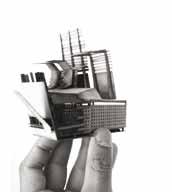
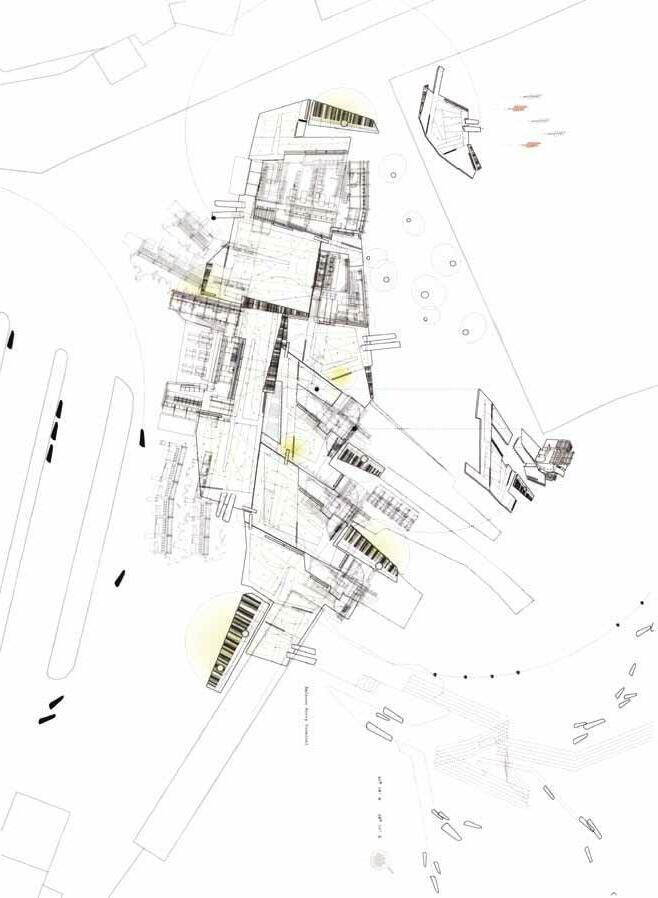

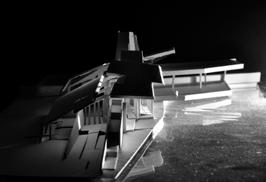


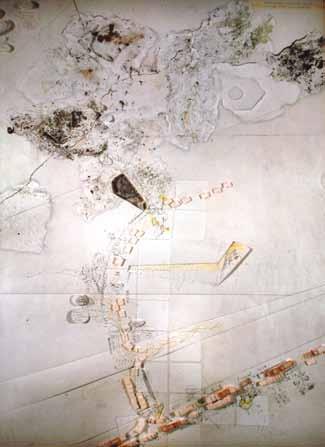
 Clockwise from top: Aisha Nur MD Ajib, Subterraneanrefugeofsoundsandsmells; Aisha Nur MD Ajib, SensoryBorders; Aminah Babikir, 7 LondonGates[twoshown];Joe Gautrey, Chris Mobbs, Secular Celebration.
Clockwise from top: Aisha Nur MD Ajib, Subterraneanrefugeofsoundsandsmells; Aisha Nur MD Ajib, SensoryBorders; Aminah Babikir, 7 LondonGates[twoshown];Joe Gautrey, Chris Mobbs, Secular Celebration.
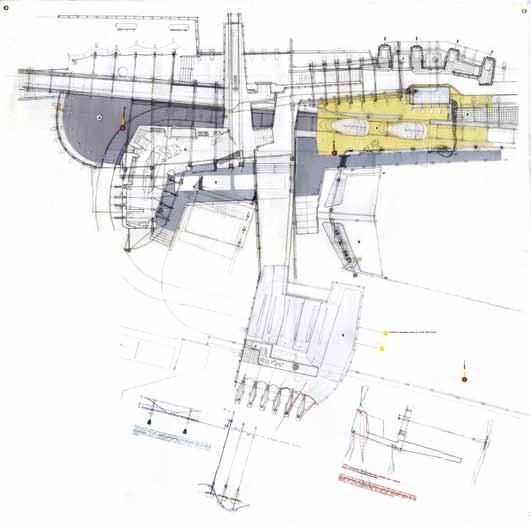
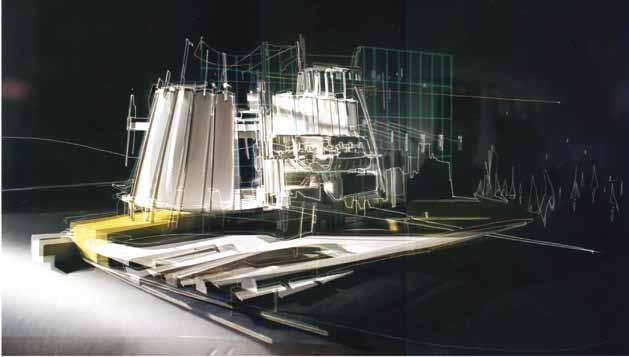
 This Page: Nicholas Elias, Bospherous SailingSchool.
This Page: Nicholas Elias, Bospherous SailingSchool.
Landscape Ben Addy, Stuart Piercy
Landscape
The landscapes of Britain and Ireland have been formed by the manifold interactions of people and nature. These interactions vary widely in tempo and concentration but are necessary wherever the landscape is used by us-for sustenance, energy production, transport or recreation.
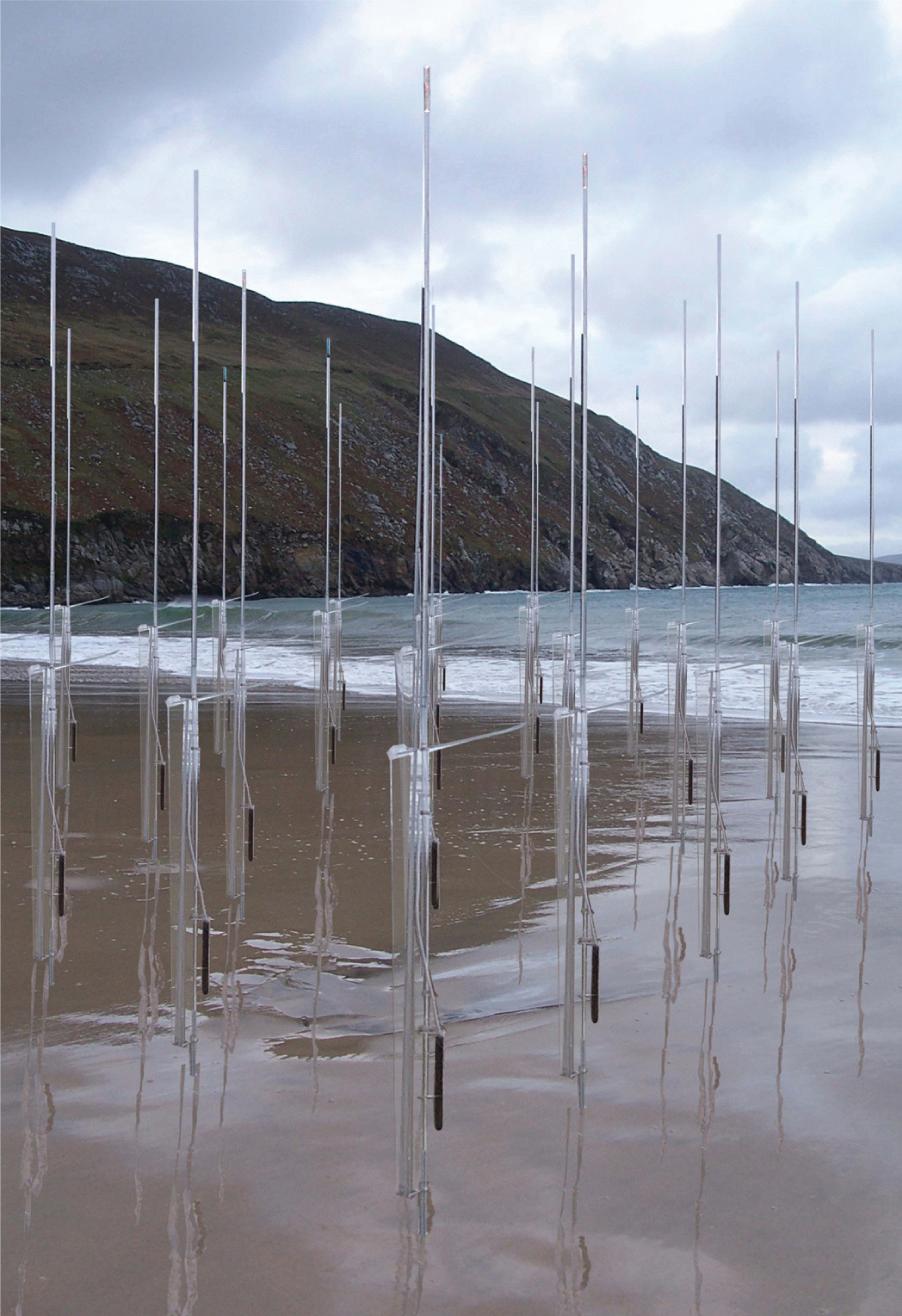
There is no part of these islands that has not been subject to human alterationfrom medieval runrig systems in the Scottish Highlands to the intensive post war agricultural landscapes of East Anglia. Human operations on the rural landscape are fundamental to its character-whether seemingly passive, for example by being made available for grazing, or more comprehensive, for example for transport infrastructure.
In all instances this interaction has to be maintained in order for the landscape to remain productive for our needs. Frequently these interactions are characterised by an attempted obstruction of natural processes or by the blunt physical alteration of the landscape. Are there more subtle alternatives that can yield similar results?
The same principles are true at the scale of buildings. Buildings must be repaired and modified-at greater or lesser frequencies-in order for their performance to be maintained. Maintenance regimes that are applied to modern buildings are typically considered as an appendix to the design process, but what happens when the maintenance of the building, as much as the cultivation of the landscape, is considered to be central to the production and use of architecture?


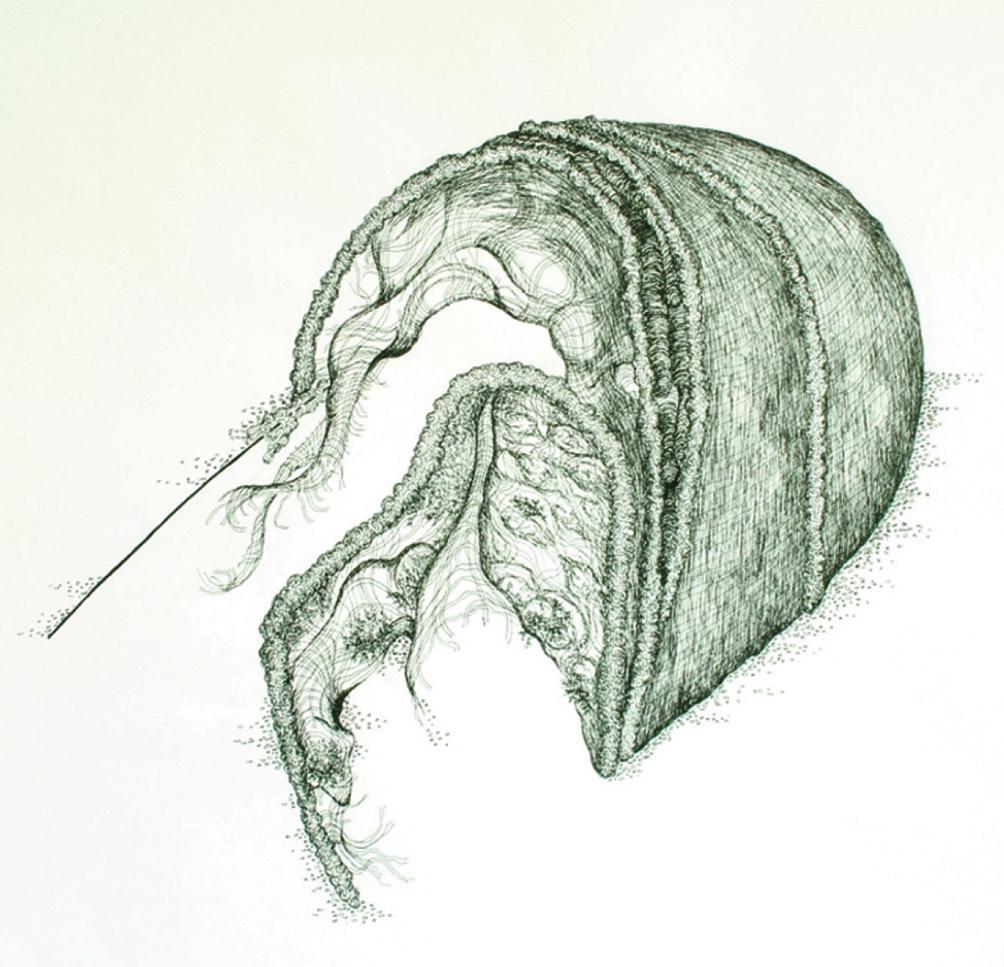
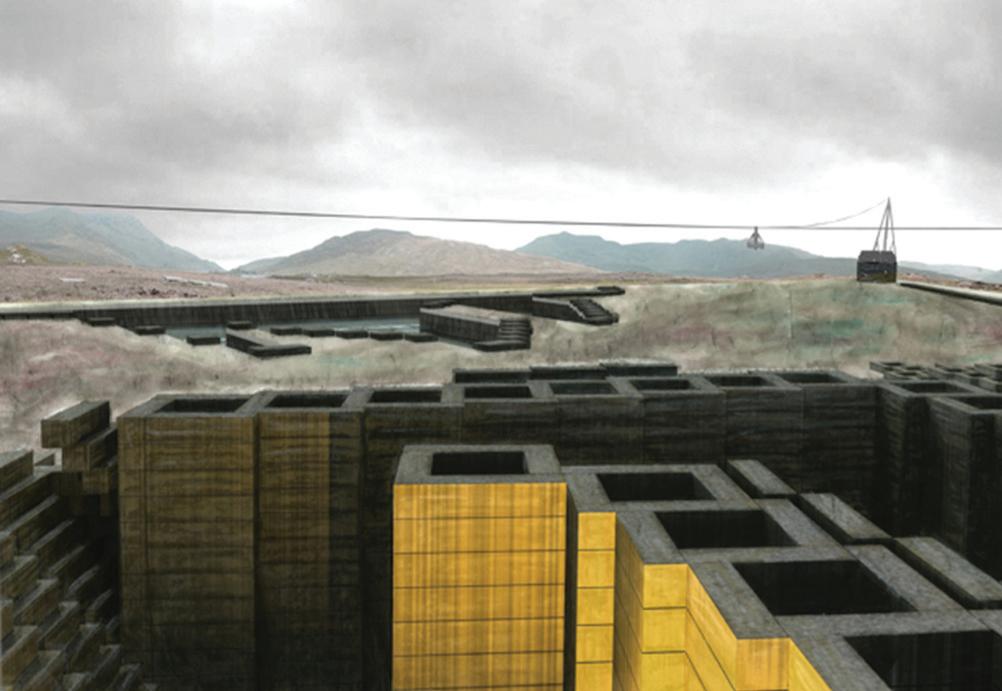
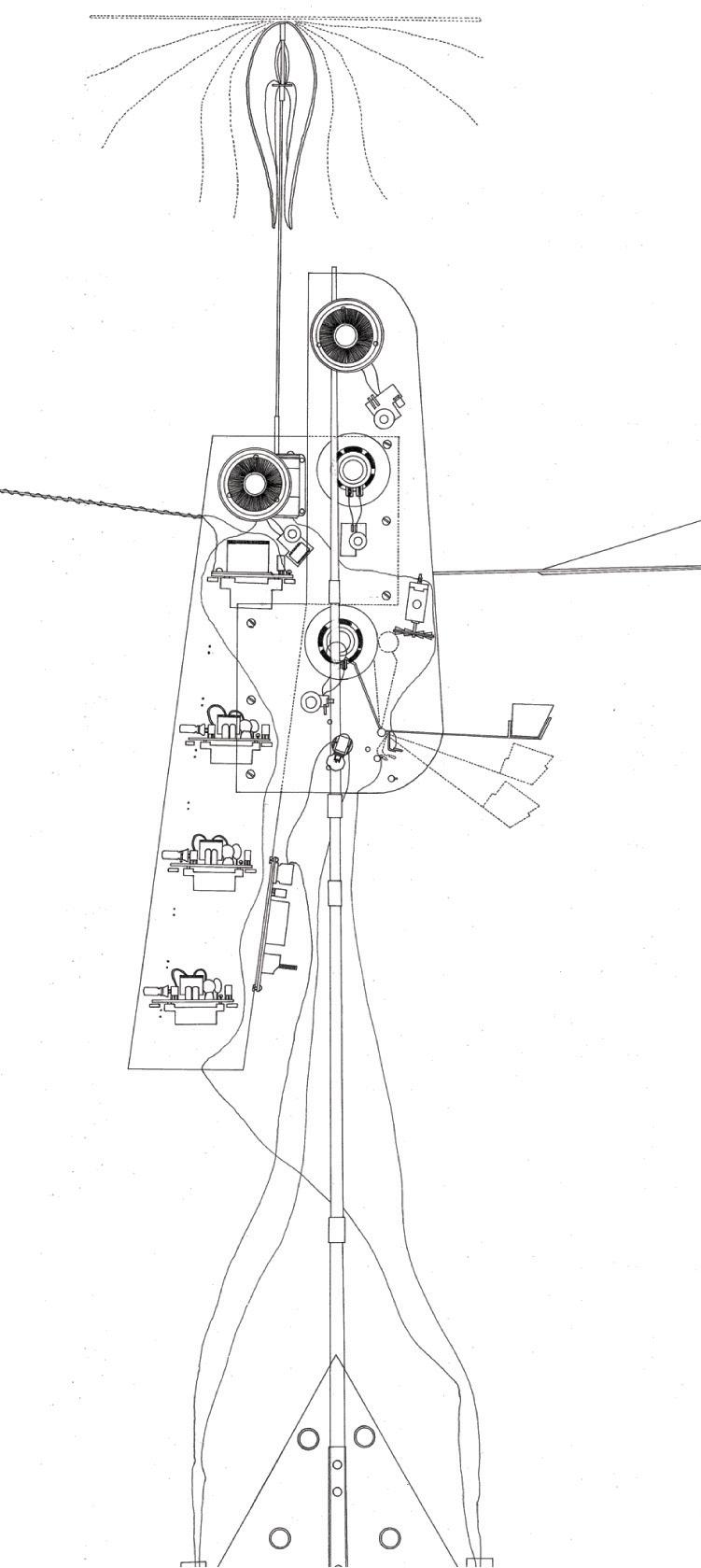 Clockwise from top: Felicity Price-Smith, Dew Collector; Jonathan De Wind, Unpredictable Relationships; Richard Thebridge, Self Building Peat Structure
Clockwise from top: Felicity Price-Smith, Dew Collector; Jonathan De Wind, Unpredictable Relationships; Richard Thebridge, Self Building Peat Structure

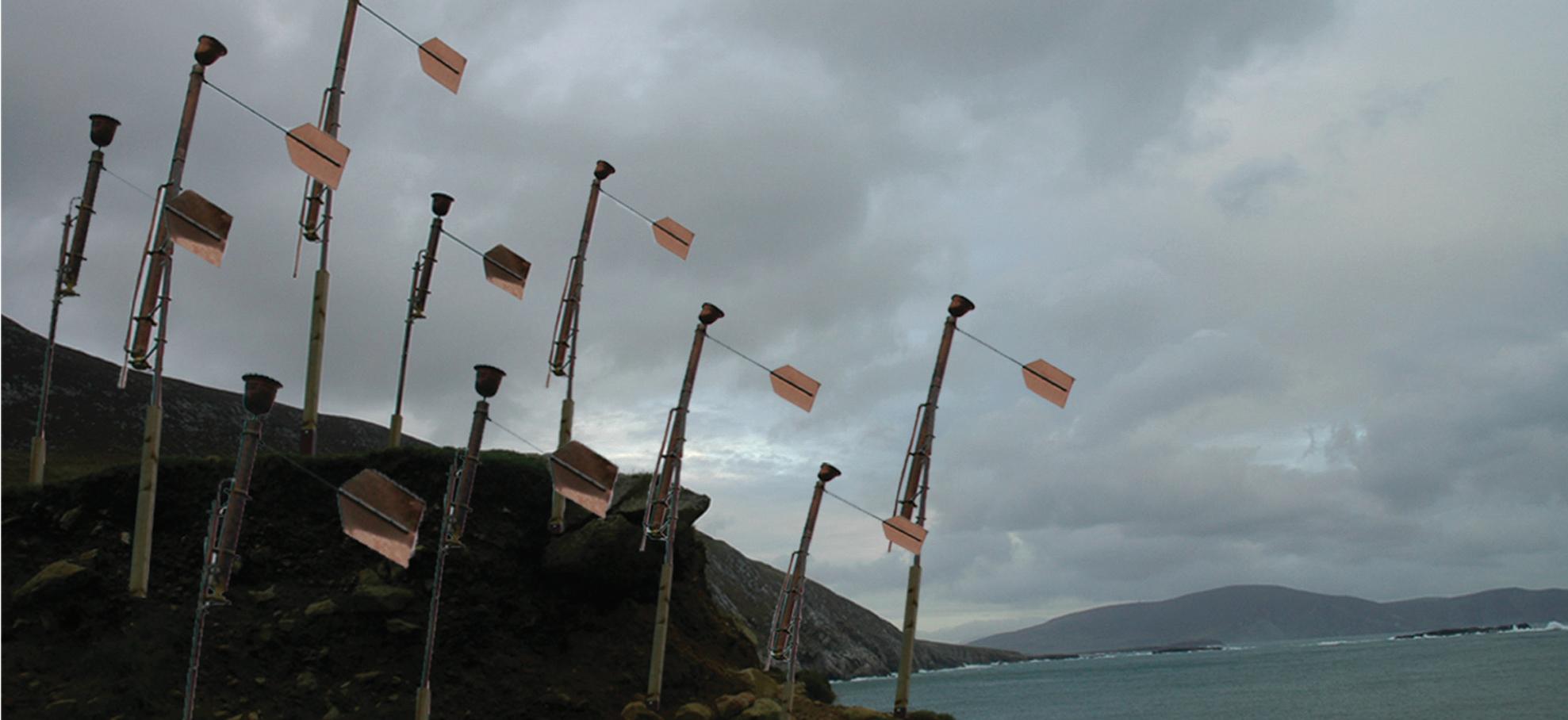
 Chantanee Nativivat, Weather Symphony device.
Chantanee Nativivat, Weather Symphony device.

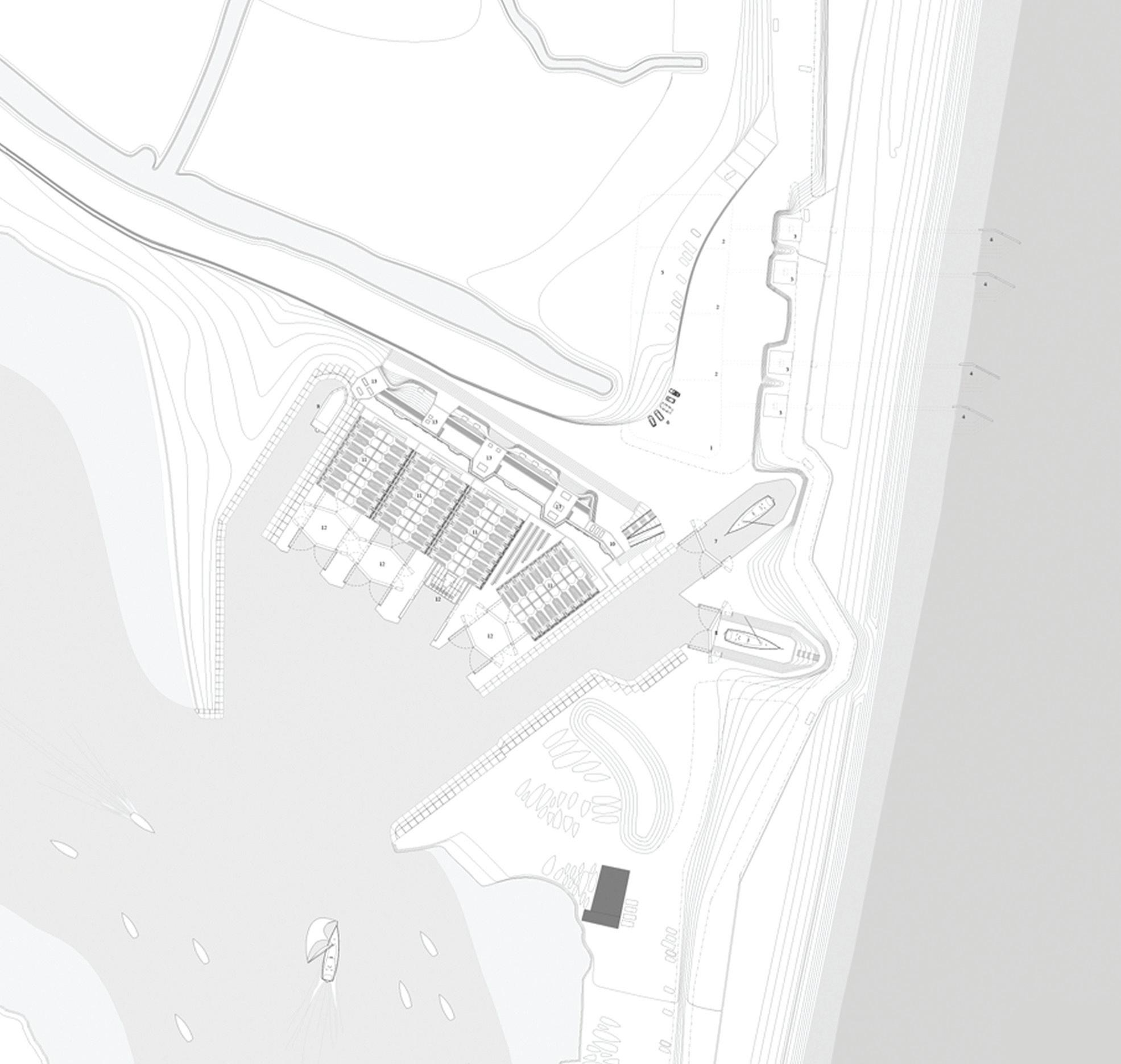

 Top: Richard Thebridge, Reluctant Tourist device. Bottom: Richard Thebridge, Racing Yacht Boatyard.
Top: Richard Thebridge, Reluctant Tourist device. Bottom: Richard Thebridge, Racing Yacht Boatyard.



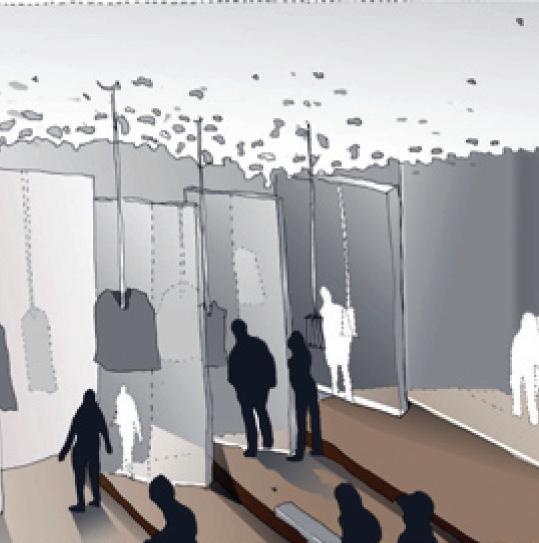


 Clockwise from top: Chantanee Nativivat, Tea Room; Rida Qureshi, Beach Comber’s Cottage; Sung Hwa (Rachel) Cha, Theatrical Fashion; Nicola Perrett, Potters’ Studios, Nicola Perrett, Potters’ Studios; Hong Jin Leow, Rug Workshop; Anastasia Kaisari, Health Retreat.
Clockwise from top: Chantanee Nativivat, Tea Room; Rida Qureshi, Beach Comber’s Cottage; Sung Hwa (Rachel) Cha, Theatrical Fashion; Nicola Perrett, Potters’ Studios, Nicola Perrett, Potters’ Studios; Hong Jin Leow, Rug Workshop; Anastasia Kaisari, Health Retreat.

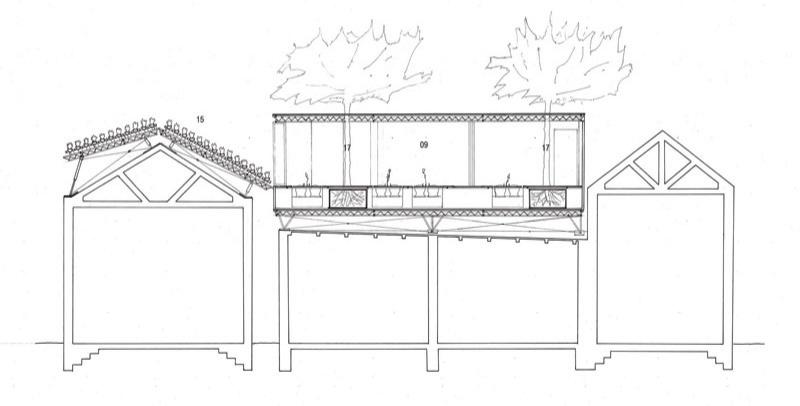
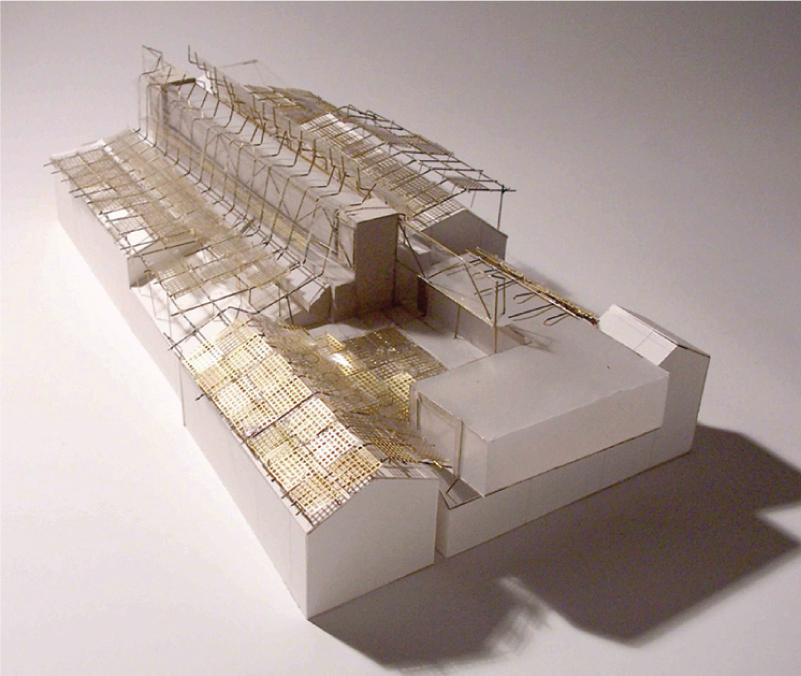
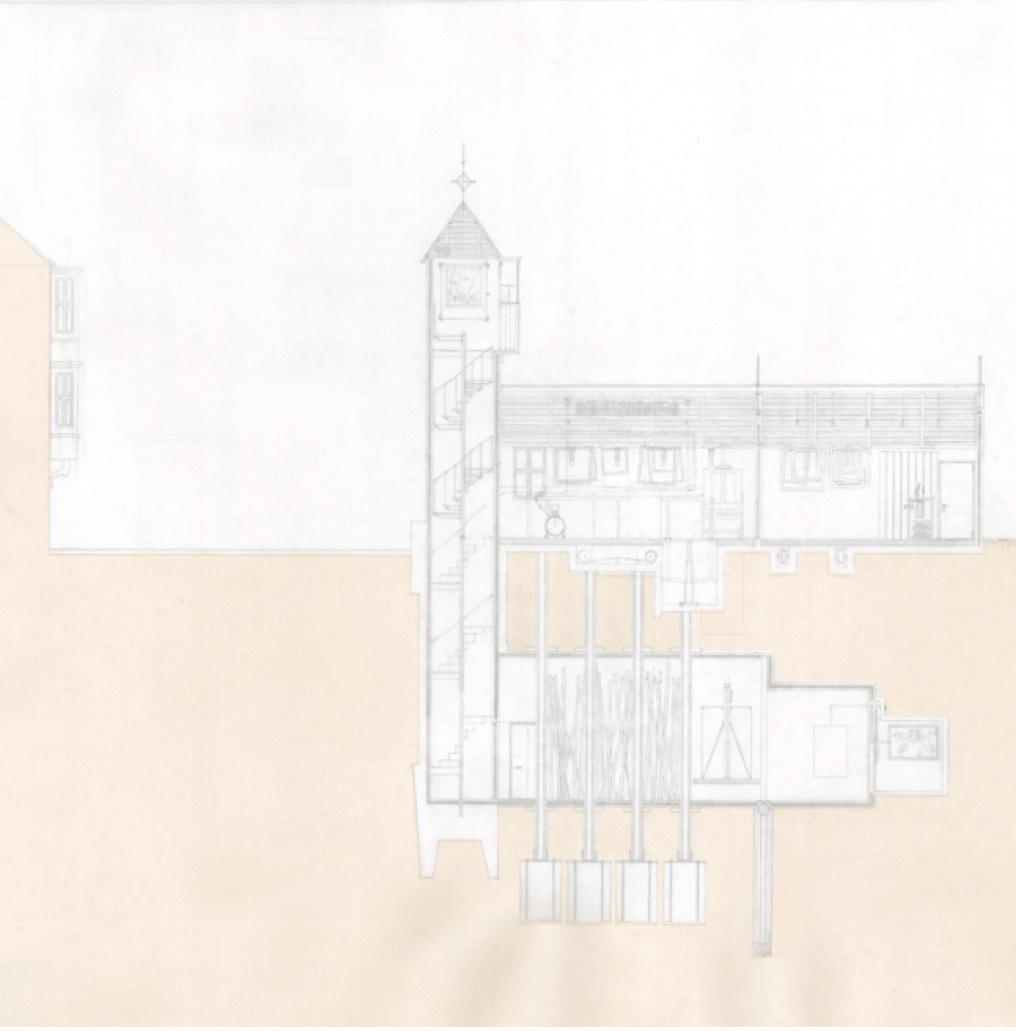
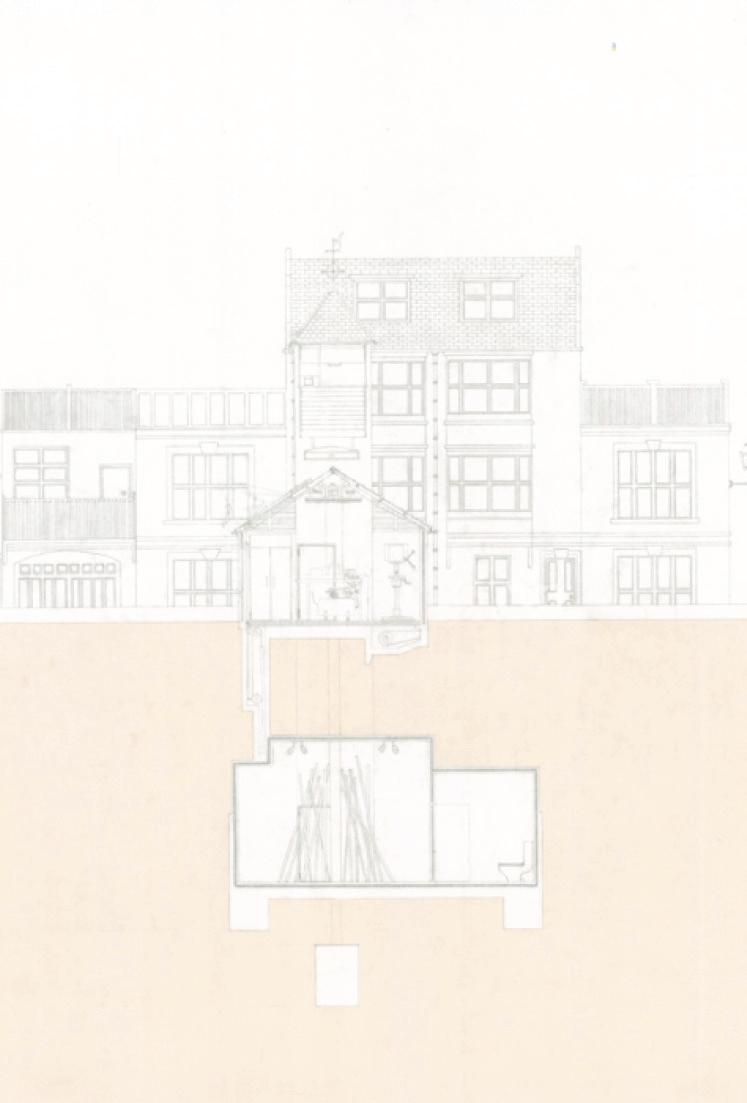 Clockwise from top: Jonathan De Wind, Artists’ Framers and Forgers; James Sale, Rooftop Garden Restaurant
Ben Addy, Stuart Piercy
Clockwise from top: Jonathan De Wind, Artists’ Framers and Forgers; James Sale, Rooftop Garden Restaurant
Ben Addy, Stuart Piercy
Yr 2: Jan Balbaligo, Amy Bodiam, James Gunn, Michael Hughes, Caroline Mok, Bodin Nilkamhaeng, Allyssa Ohse, Paniz Peivandi, Ayeza Qureshi. Yr 3: Rory Donald, Helen Floate, Momo Hoshijima, Ben Kirk, Maxine Pringle, David Rieser, Elizabeth Watts, Peter Webb, Bethany Wells.
There are considerable overlaps between fashion and architecture in terms of technique and material. The techniques and terminologies of folding, pleating, wrapping and weaving are no longer only used as metaphors in architecture - they are directly employed in the design and manufacture of our built environment. A reverse flow is also true: both top-end and street fashion increasingly make use of the pliable plastics, flexible metal and even high performance glass that were once reserved for the building site.
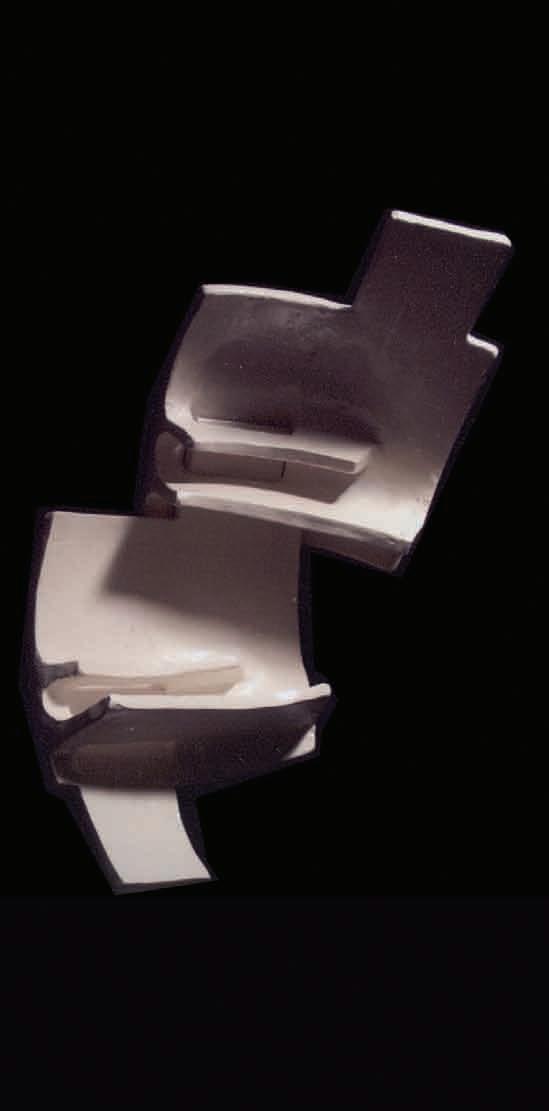
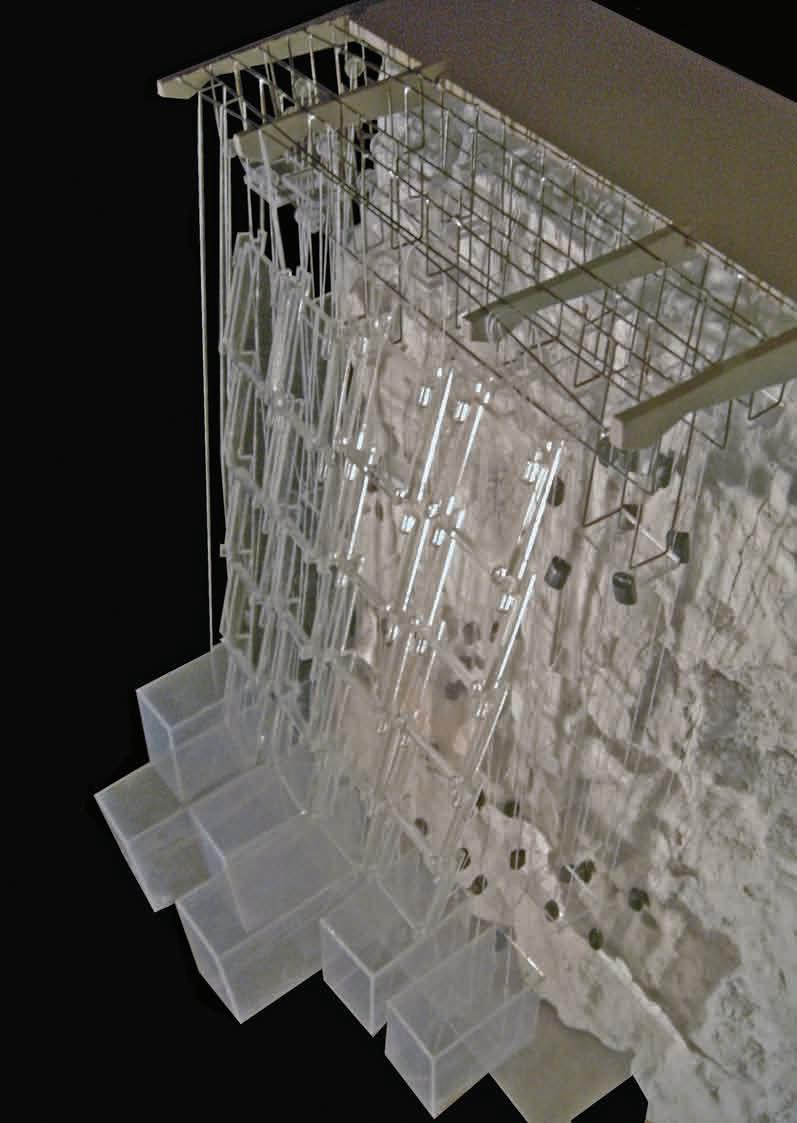
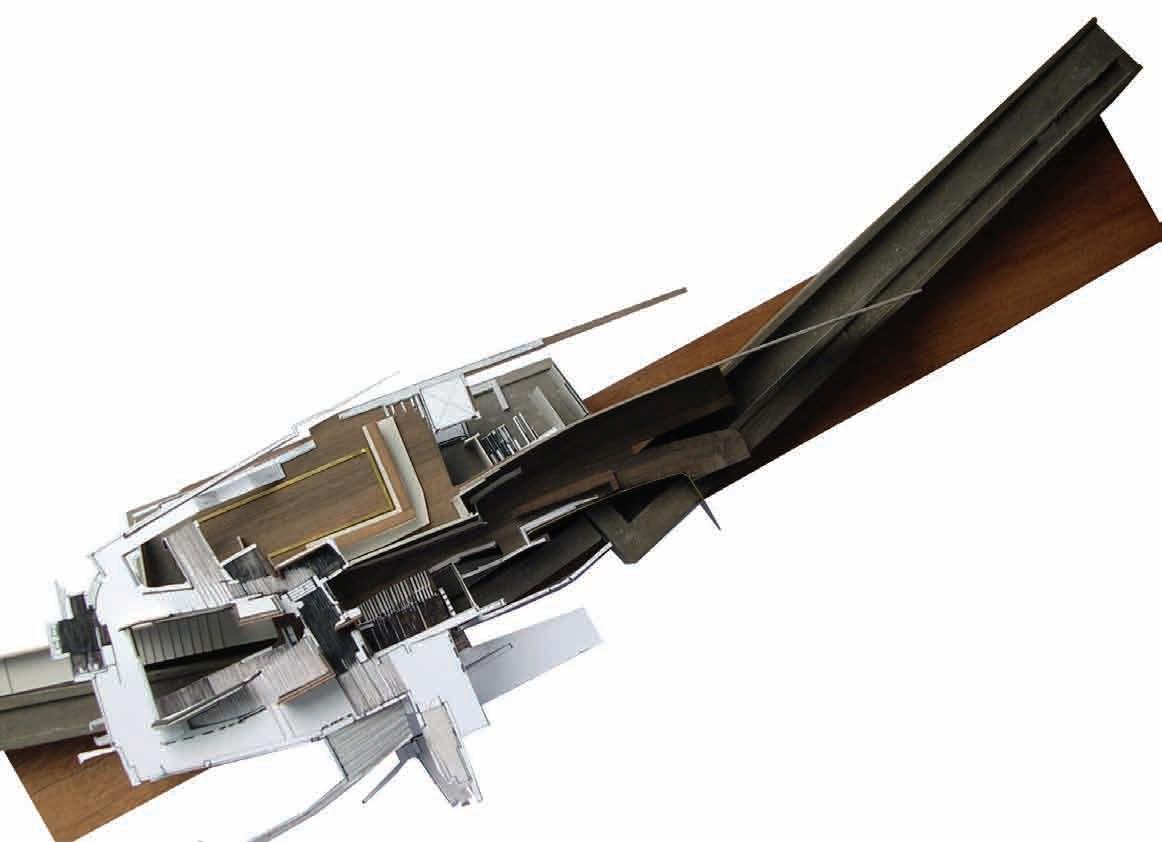
One can examine the straightforward relationship between a clothes factory and the manufacturing processes it houses, as well as more mercurial relationships between fashion brands (such as Prada or Hermes) and the architecture of their retail operations. As fashion brands develop they tend to distinguish their product through buildings as much as through conventional advertising, packaging and the products themselves. Witness the work for fashion brands as produced by architectural brands such as OMA. This brings to mind the huge potential architecture has always had for propaganda.
Unit 6 will look at both areas of interface between architecture and fashion: Visiting clothing makers in East London as well as more rarefied manufacturing and retailing operations in London, Paris and Milan, we will examine the relationship between brands and buildings. The Unit will engage with critics from outside architecture; in the more ostensibly ‘fashion driven’ fields of, for example, clothing and automotive design to explore the potential in crossover between our and their disciplines.
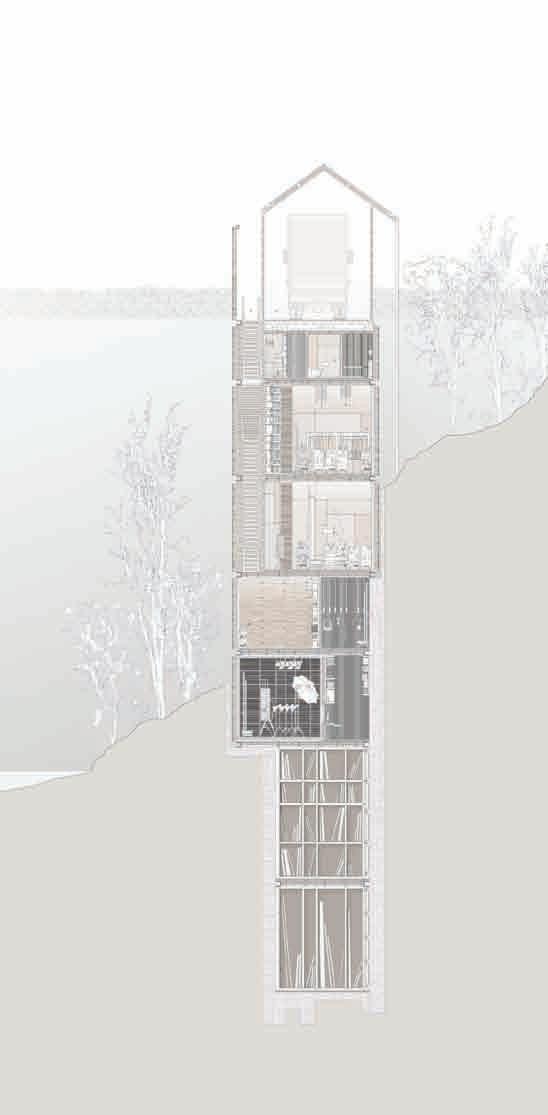
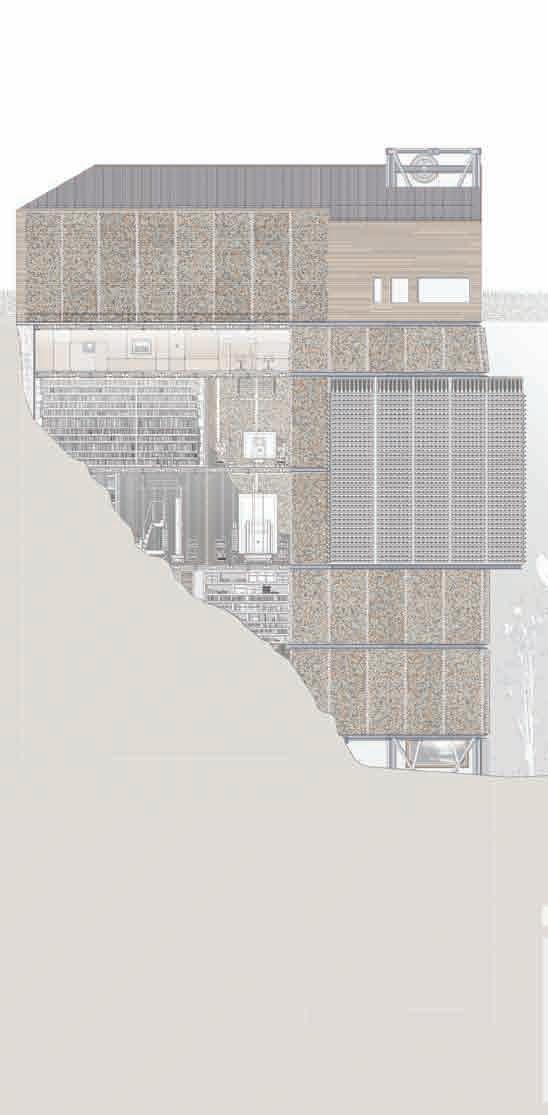

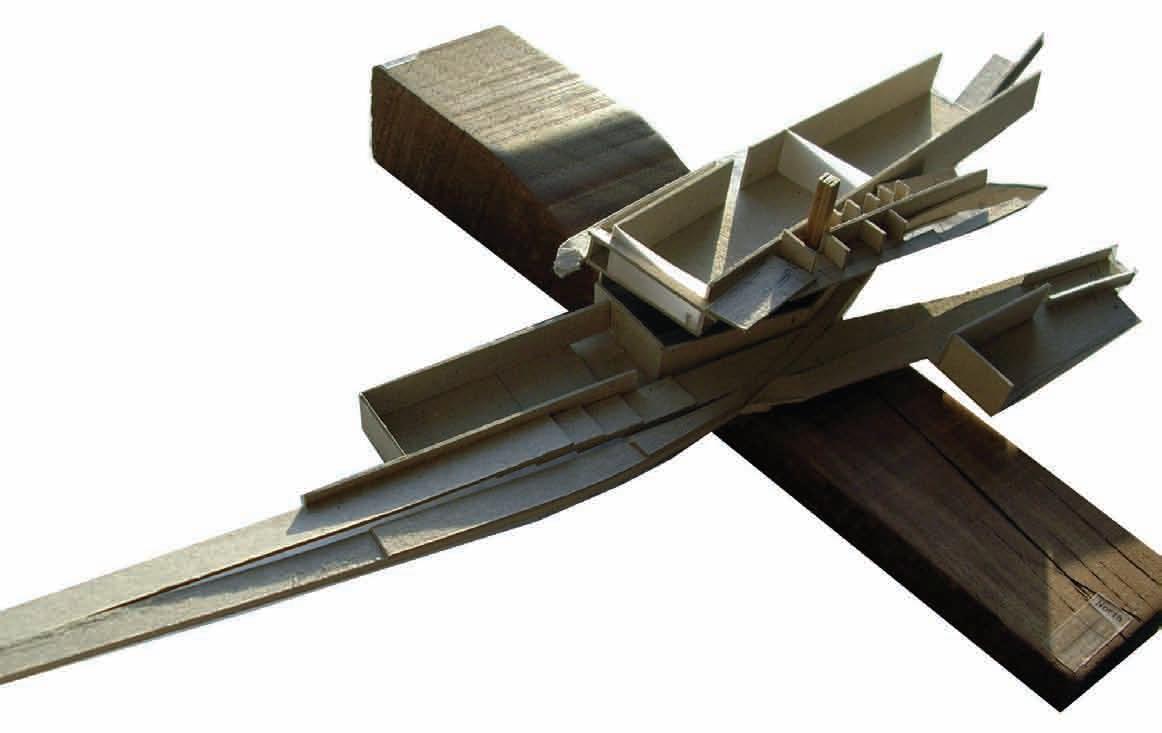
 Top: Ben Kirk. Bottom left: Bethany Wells; right: Caroline Mok.
Top: Ben Kirk. Bottom left: Bethany Wells; right: Caroline Mok.

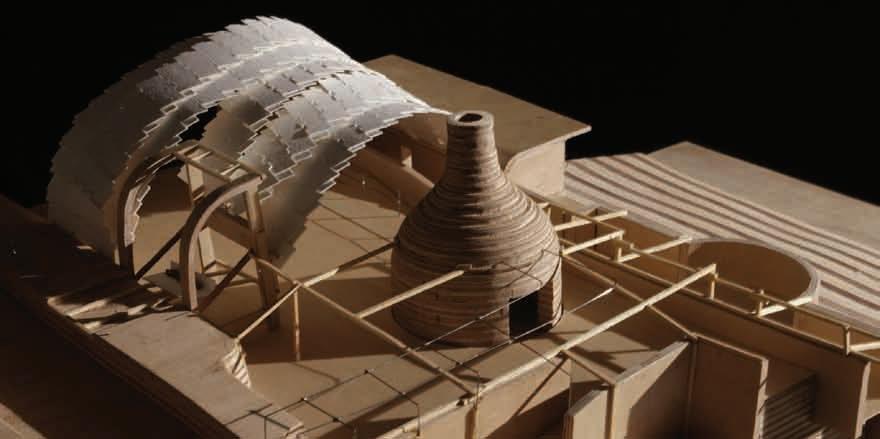

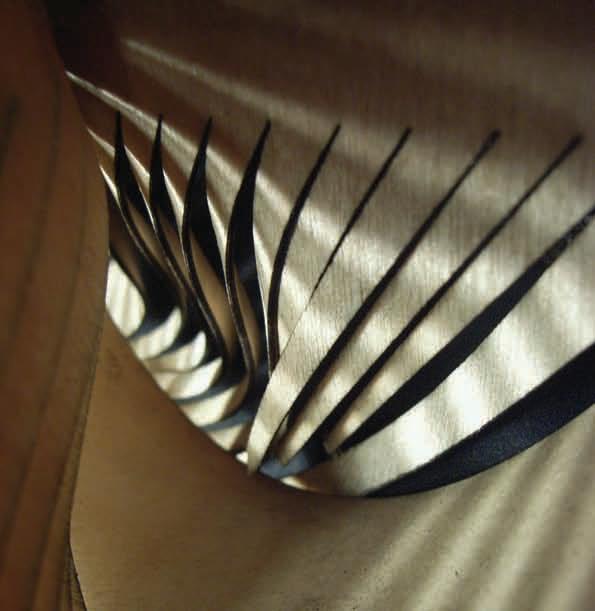
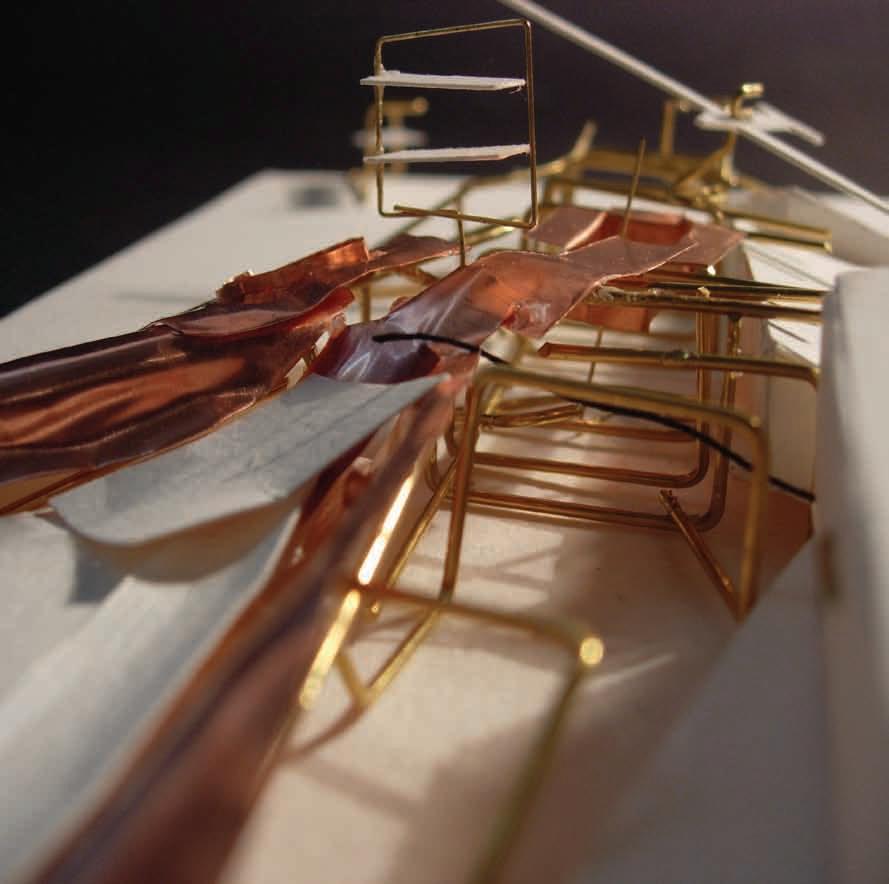
 Clockwise from top: Bethany Wells, Michael Hughes, Jan Balbaligo, Peter Webb, Jan Balbaligo, Michael Hughes.
Clockwise from top: Bethany Wells, Michael Hughes, Jan Balbaligo, Peter Webb, Jan Balbaligo, Michael Hughes.
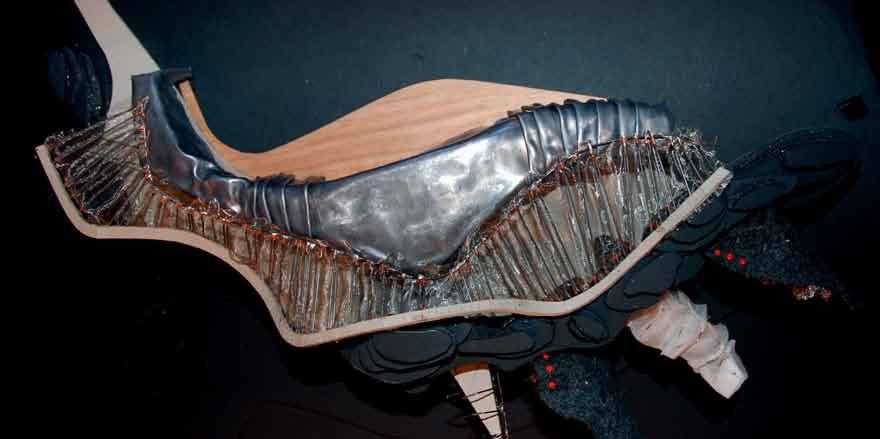
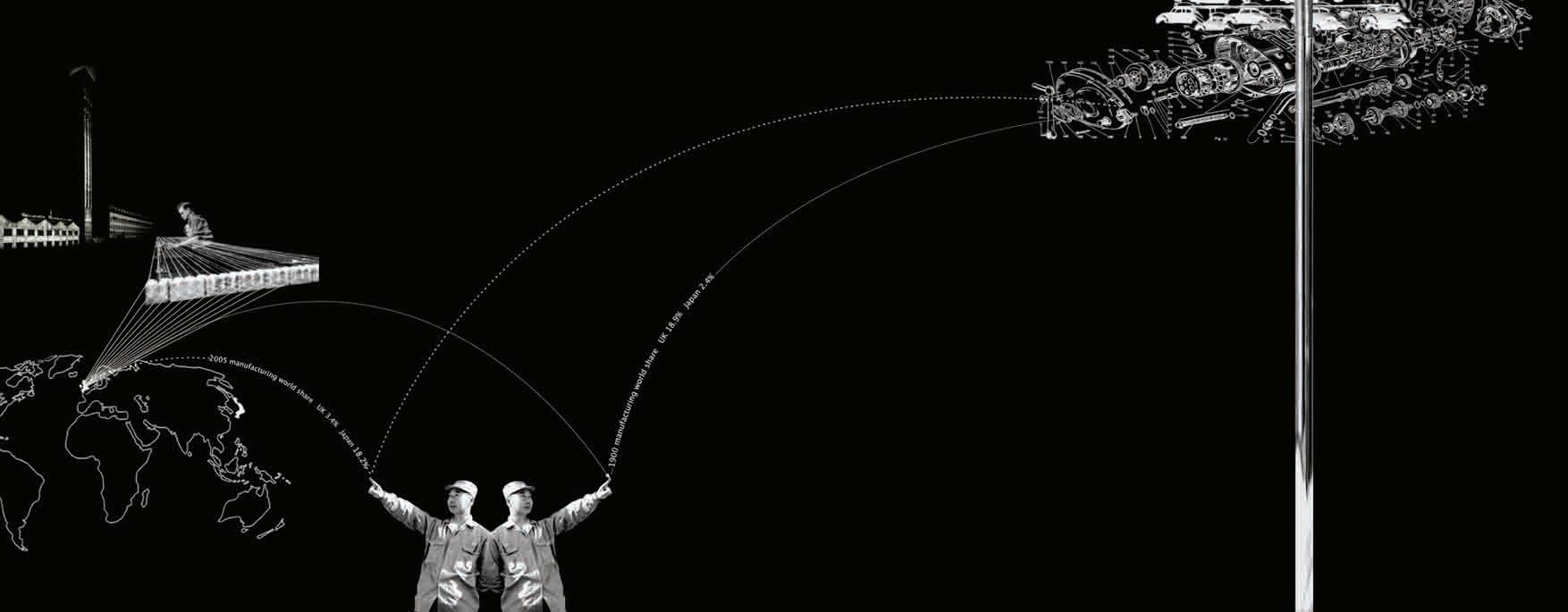

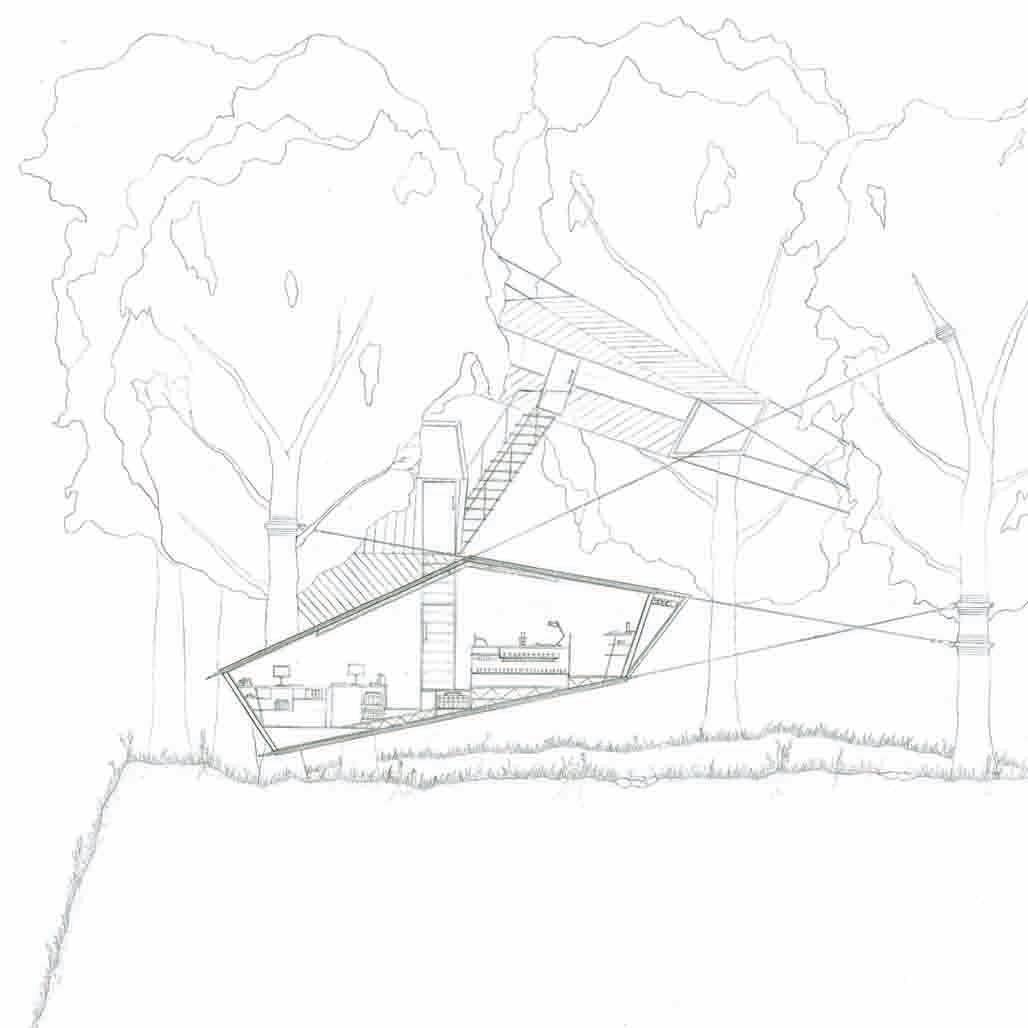
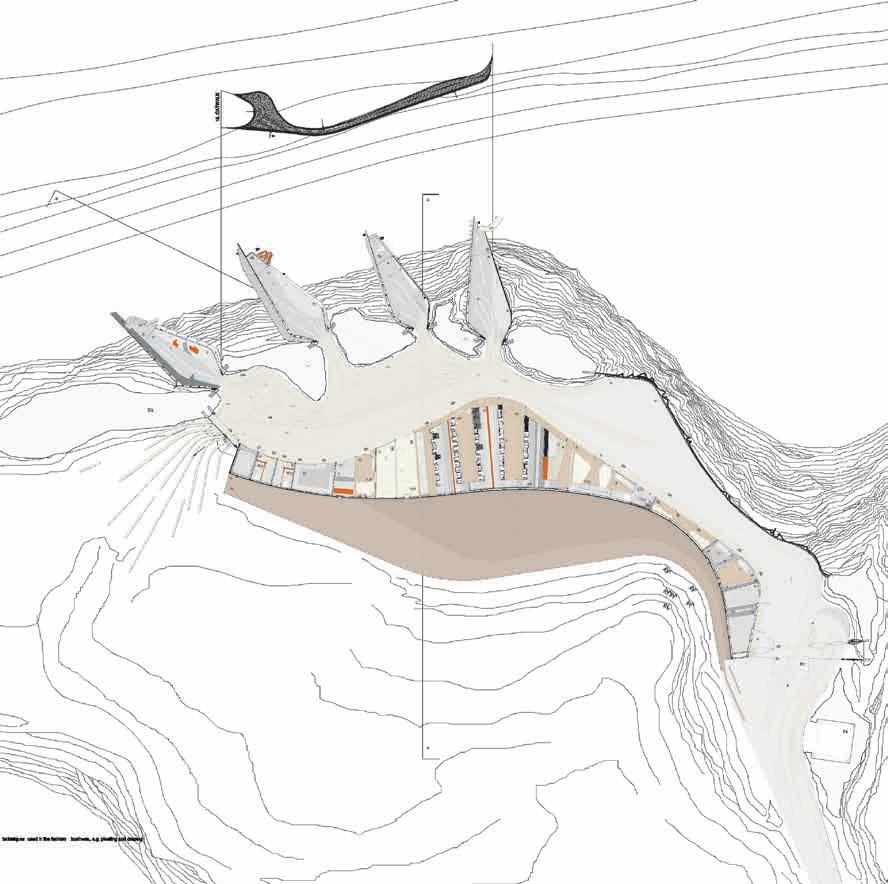
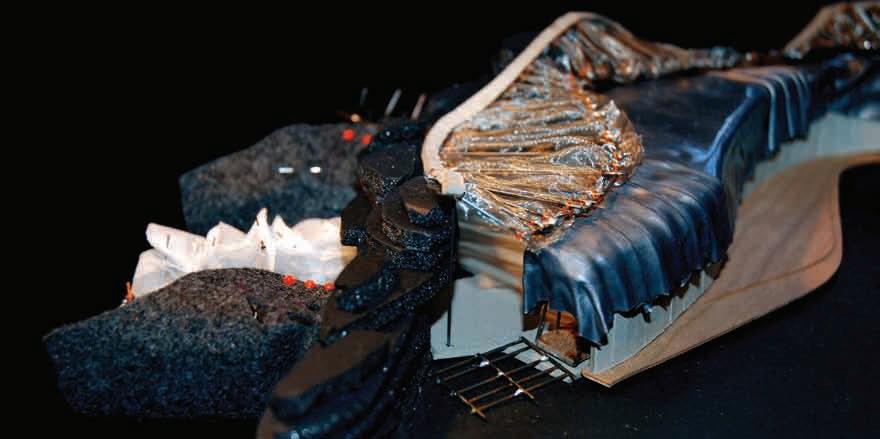 Top: Helen Floate. Middle left: James Gunn; right: Maxine Pringle. Bottom left: Maxine Pringle.
Top: Helen Floate. Middle left: James Gunn; right: Maxine Pringle. Bottom left: Maxine Pringle.
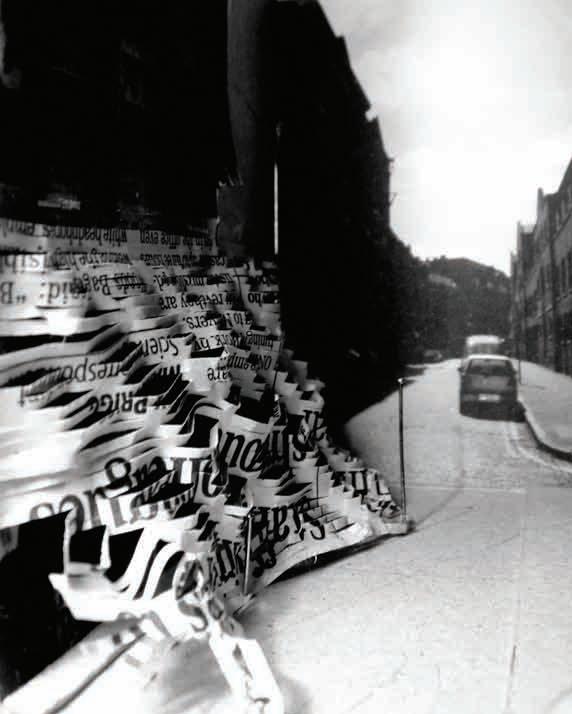
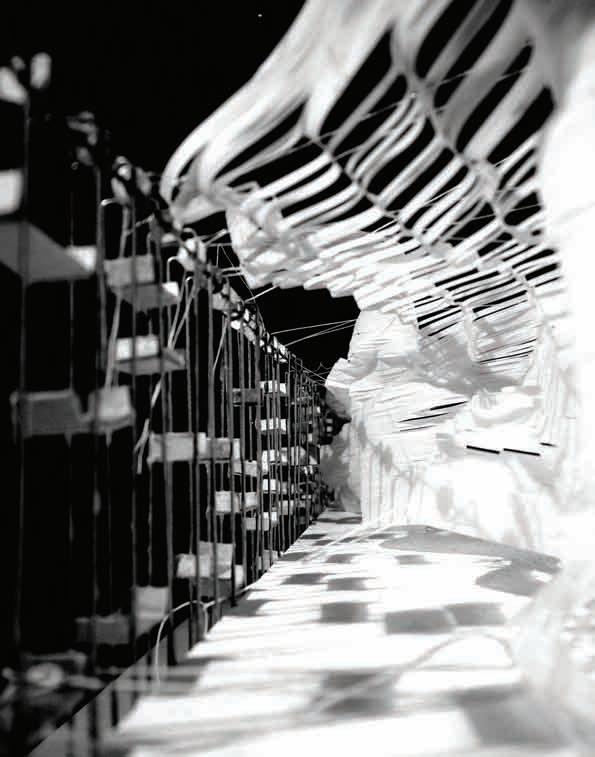

 This page, top: Amy Bodiam; bottom: David Rieser. Facing page, top: Ayeza Qureshi; bottom: James Gunn.
This page, top: Amy Bodiam; bottom: David Rieser. Facing page, top: Ayeza Qureshi; bottom: James Gunn.
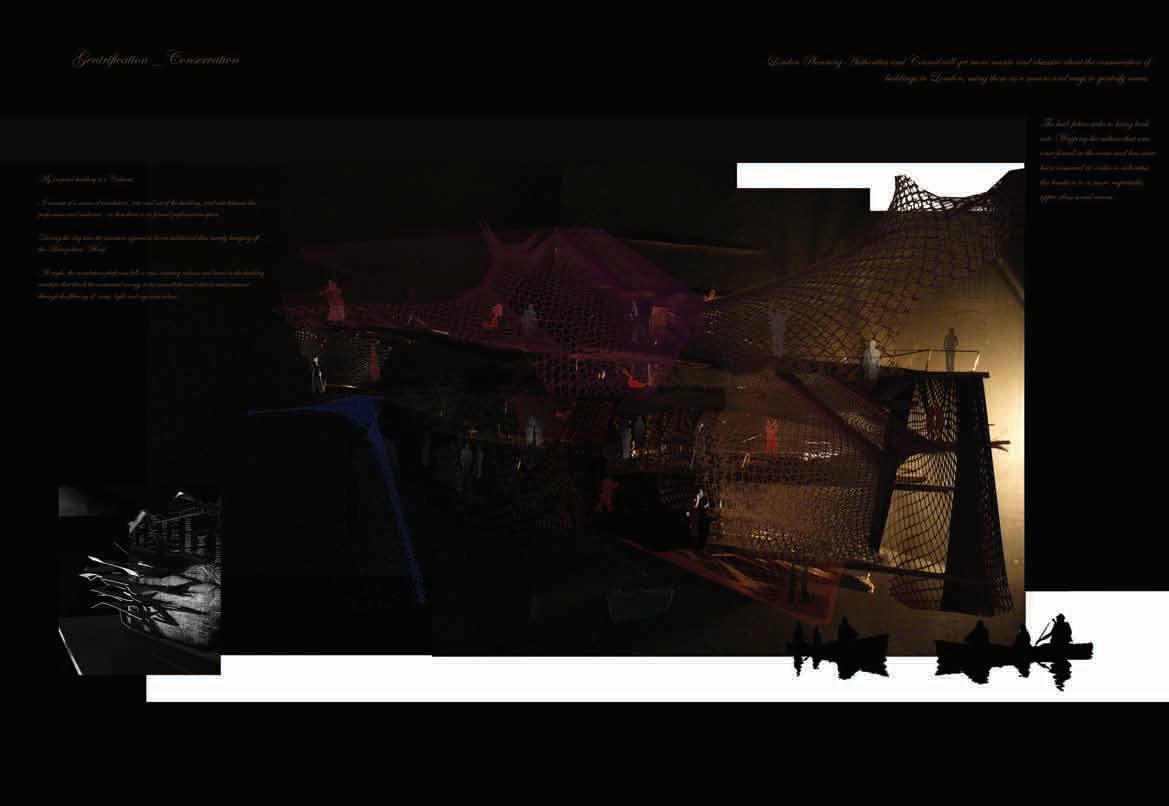
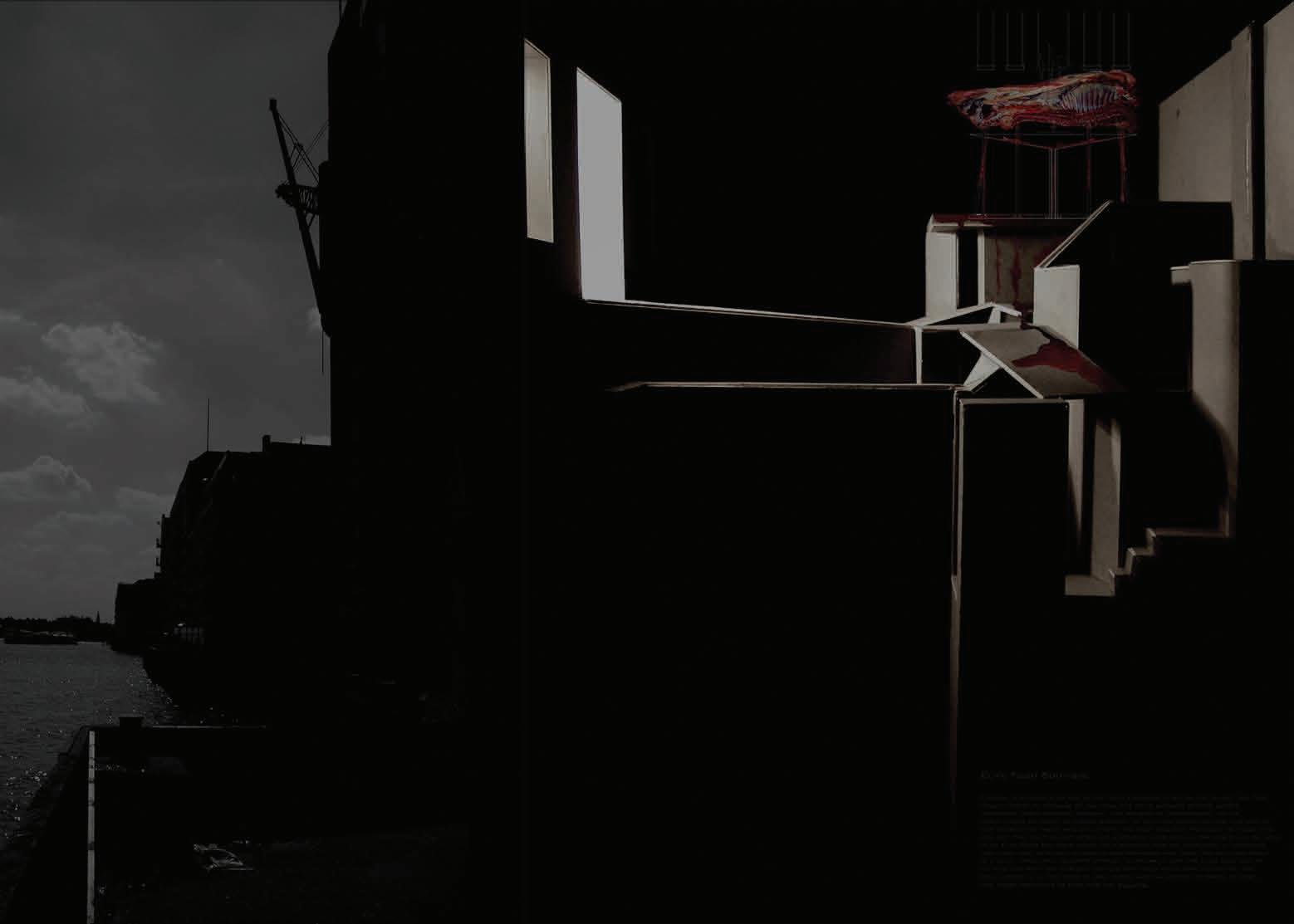
Ebb + Flow Ben Addy, Stuart Piercy
Yr 2: Julian Bond, Jonathan Chattaway, Allexis Kalli, Emily Norman, Georgina Robinson, Spencer Tracey, Jessica Walker.

Yr 3: Tala Akkawi, Jenna Al-Ali, David Cheape, Grace Cooper, Cai-jia Eng, James Halsall, Naomi McIntosh, Alicia Tkacz, Yang Yu.
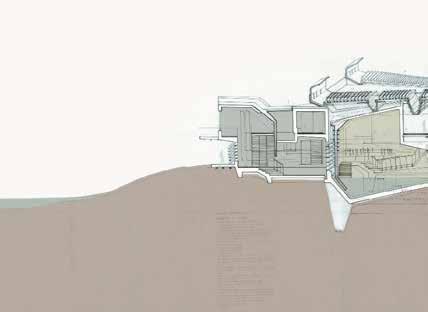
Ebb + Flow
Northern Europe is undergoing a major physical restructuring operation. Historically we have feared to live in equilibrium with our oceans creating physical barriers solid and reassuring. In the future our approach will differ significantly as recent events have shown we need to equalize the boundary condition between fluid and solid. Where we once kept the water out we must now give water some space. We will learn to live and build with it rather than against it. In Unit 6 we explored how we adapt to living with water.
Wabi Sabi is an intuitive appreciation of a transient beauty in the physical world that reflects the irreversible flow of life in the spiritual world. It is an understated beauty that exists in the modest, rustic, imperfect or even decayed, an aesthetic sensibility that finds a melancholic beauty in the impermanence of all things.
Wabi Sabi and art of Zen Unit 6 is an experimental unit where building programmes evolved from testing ideas and interests in Term 1. Architecture is multidisciplinary, we nurtured these skills with a number of seminars outside of the usual tutorials where we explored diverse subjects from photoshop to film and essential CAD skills for Yr 3. We encouraged varied working methods and pushed modeling as part of our major building projects.
Stuart Piercy and BenAddy Top:Alicia Tkacz, Artist's Studio, Schiermonnikoog.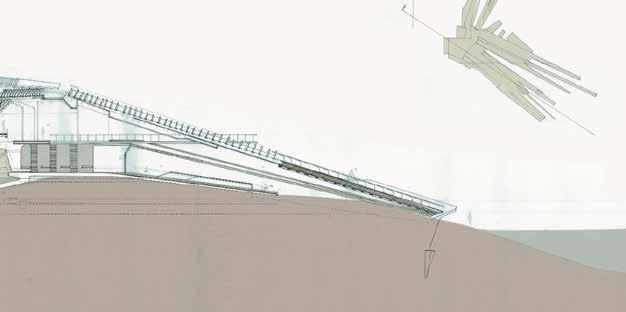

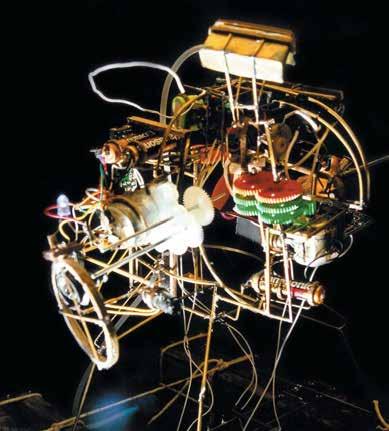
 Top left: James Halsall, Nodding Fish Device; right: Jenna Al-Ali, Cycle-of-Growth Device. Bottom: Naomi McIntosh, Publishers, Aldeburgh, long section
Top left: James Halsall, Nodding Fish Device; right: Jenna Al-Ali, Cycle-of-Growth Device. Bottom: Naomi McIntosh, Publishers, Aldeburgh, long section

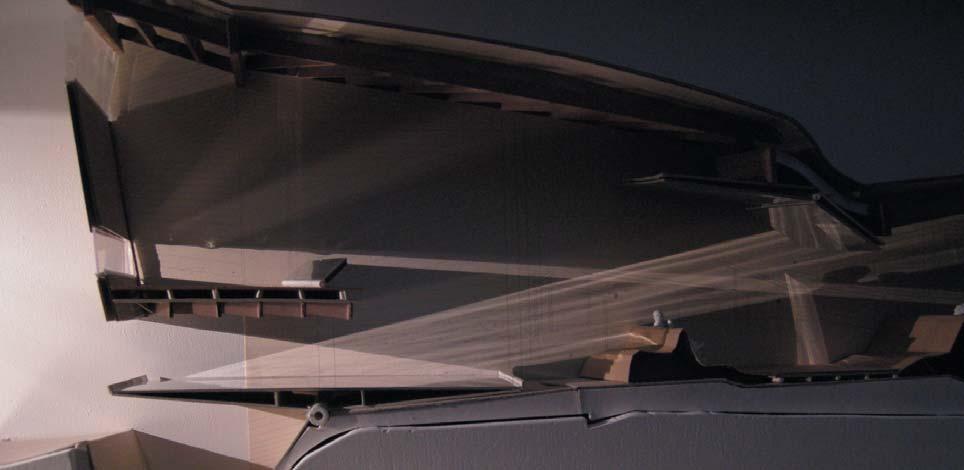 Top: Grace Cooper, The solarium auditorium uses daylight at sunrise and sunset to illuminate a performance space. Bottom:Cai-jia Eng, ‘Theatre of the Street’ , Aldeburgh, cross section.
Top: Grace Cooper, The solarium auditorium uses daylight at sunrise and sunset to illuminate a performance space. Bottom:Cai-jia Eng, ‘Theatre of the Street’ , Aldeburgh, cross section.


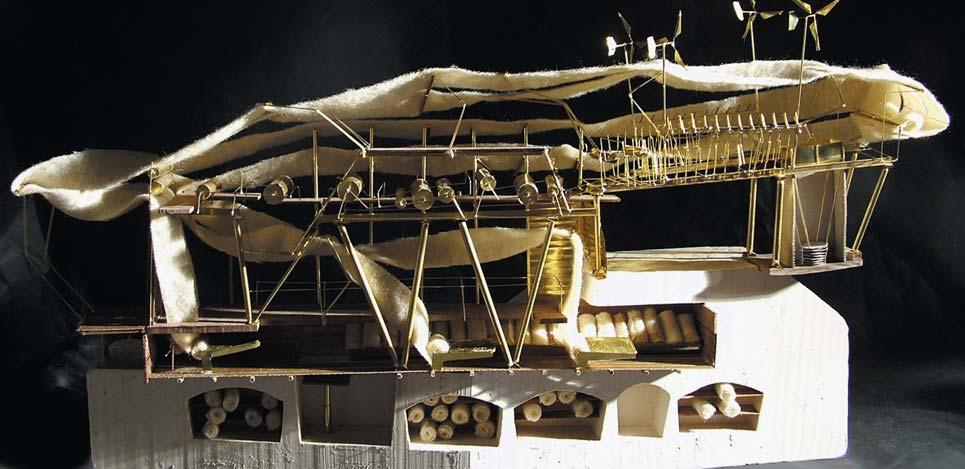
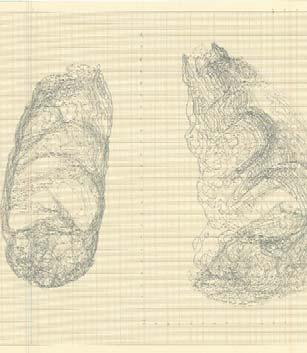 Clockwise from top:David Cheape, Slaughden Wool Works; Tala Akkawi, ASB Rehabilitation Centre, Felixstowe, cross section ; Jenna Al-Ali, Self-sustaining cartographer's home and workplace, for observations of gradual land change; Yang Yu, CT Scan Accumulation
Clockwise from top:David Cheape, Slaughden Wool Works; Tala Akkawi, ASB Rehabilitation Centre, Felixstowe, cross section ; Jenna Al-Ali, Self-sustaining cartographer's home and workplace, for observations of gradual land change; Yang Yu, CT Scan Accumulation
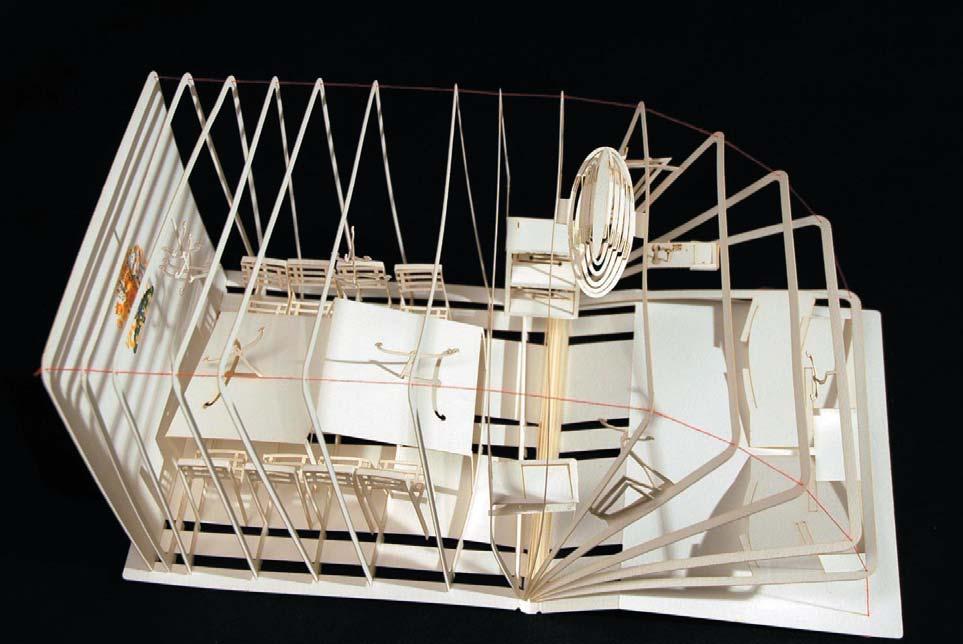

 Top left: Allexis Kalli, Swimming Crochet Animal; right: Emily Norman, final building, plan. Bottom: Spencer Tracey, device.
Top left: Allexis Kalli, Swimming Crochet Animal; right: Emily Norman, final building, plan. Bottom: Spencer Tracey, device.
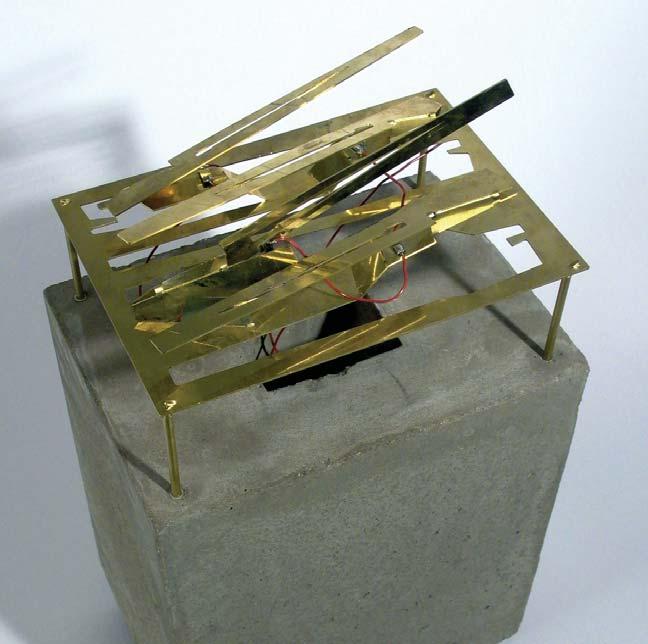
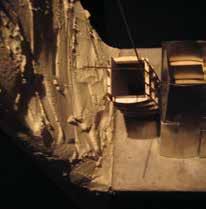

 Clockwise from top left: Georgina Robinson, device; Jonathan Chattaway, final building, model; Georgie, Canvas Stretching and Framing Workshop, Aldeburgh, cross section; Julian Bond, small building, model
Clockwise from top left: Georgina Robinson, device; Jonathan Chattaway, final building, model; Georgie, Canvas Stretching and Framing Workshop, Aldeburgh, cross section; Julian Bond, small building, model
2005
Trigger Mechanisms
Bernd Felsinger, Stuart PiercyTrigger Mechanisms
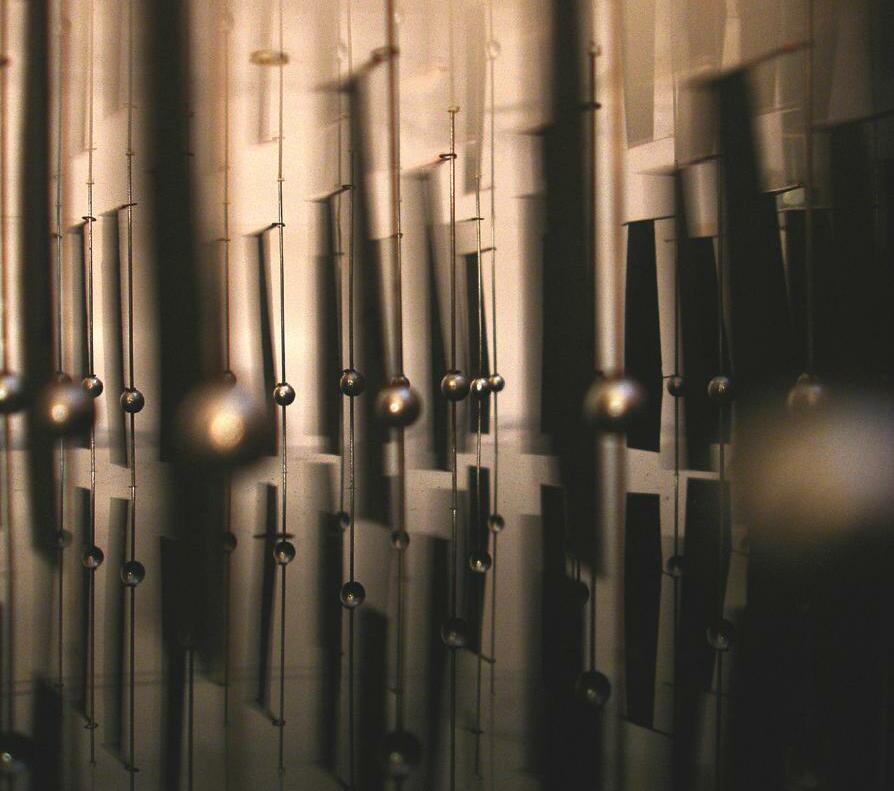
To cope with the demands of an increasing urban population, cities are in constant flux They grow denser and spread; they require re-structuring and transformation on almost every level Regardless of the scale and nature of these changes, their impact is unpredictable and their repercussions often remain left to be seen This climate of uncertainty intrigues us; it offers possibilities for even the smallest tweaks to have a noticeable impact

We focused on the potential of manipulating ‘the way things go ’ by inserting structures in the urban fabric that trigger change, provoke and demand response – propositions with an ambition to nurture, to cultivate or to corrupt
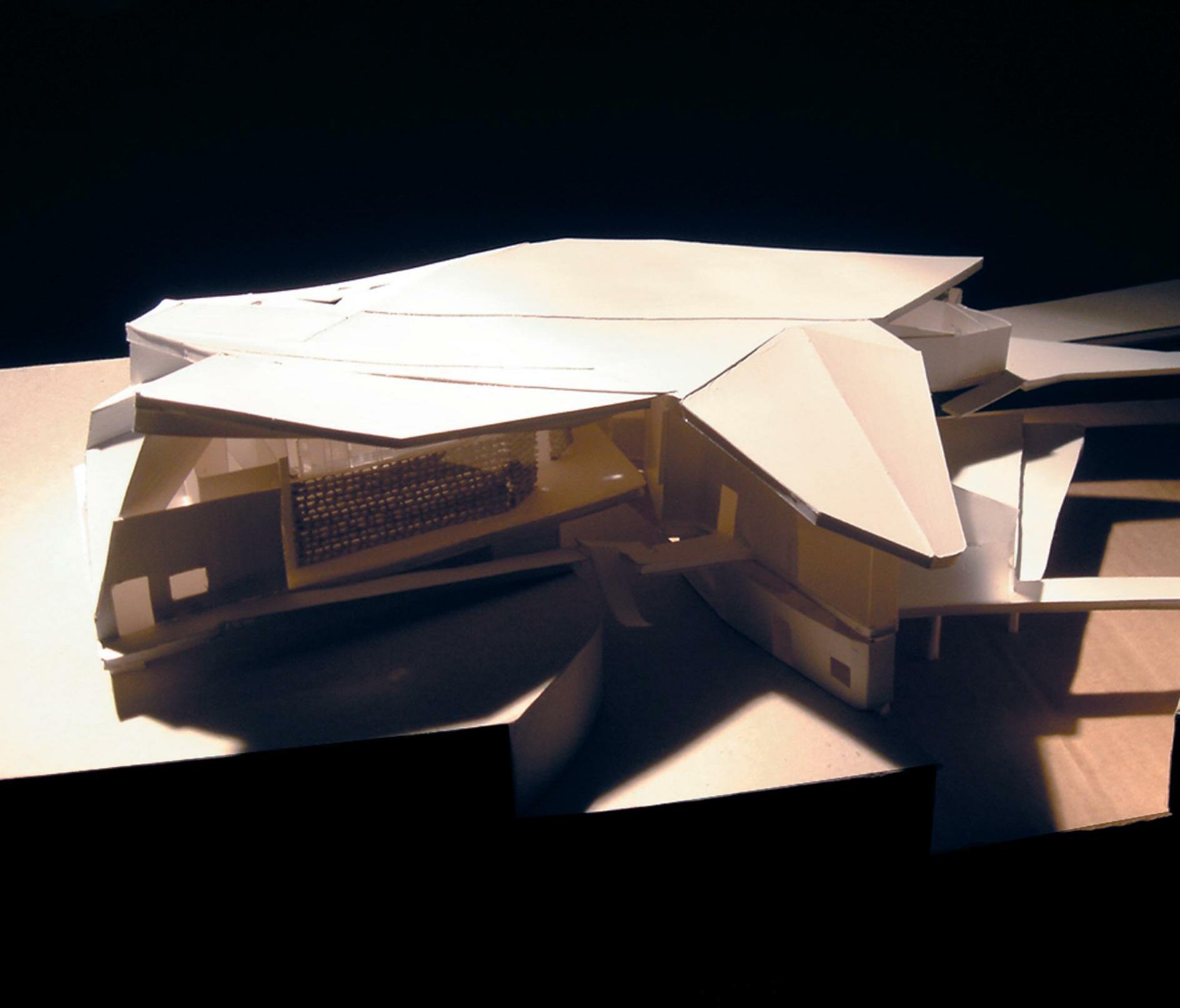

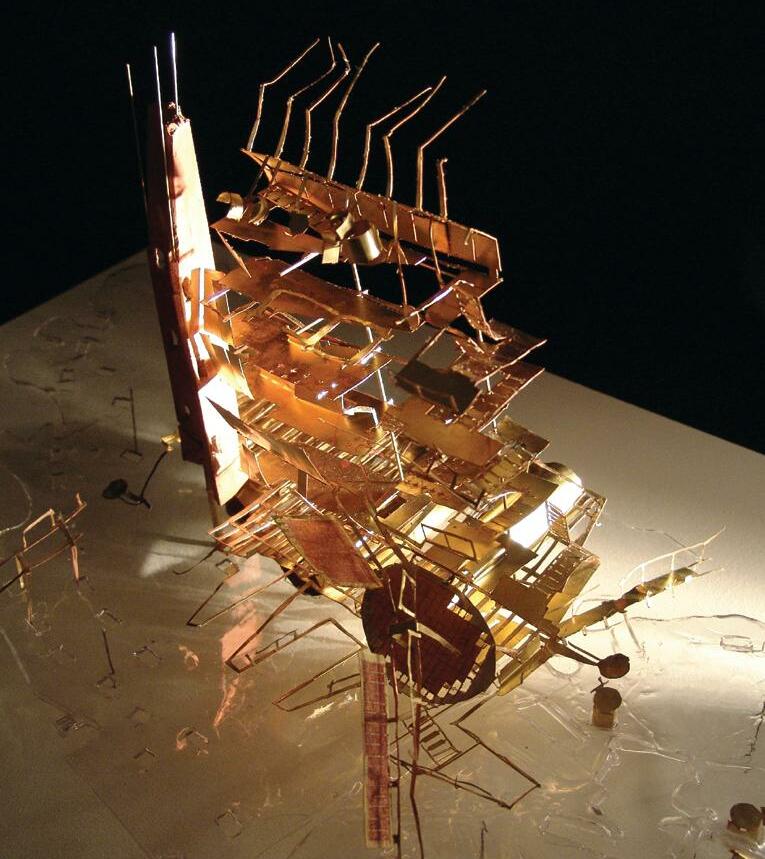
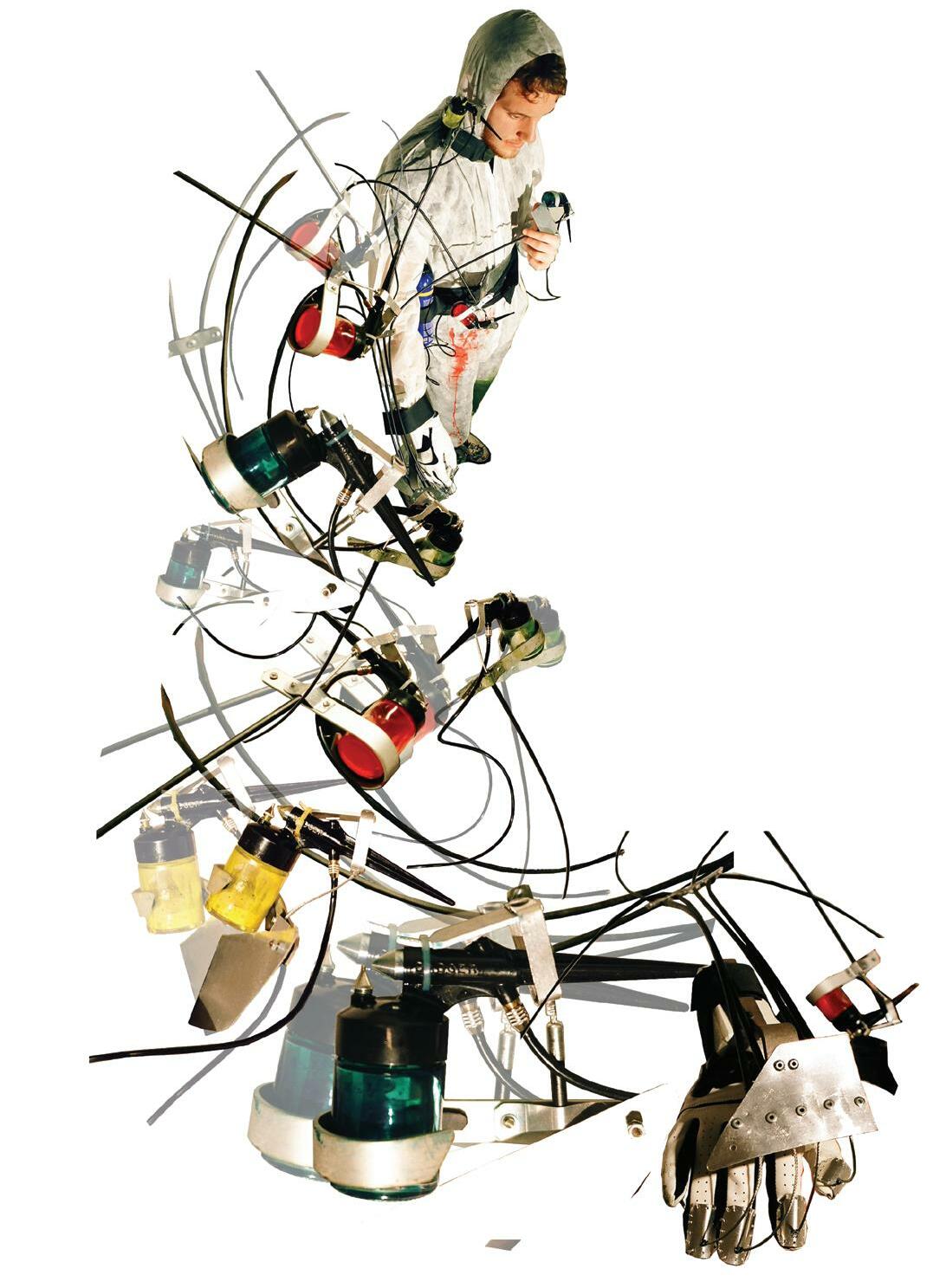
Unit 6 started the year by investigating the mechanism of cause and effect, the notion of suspense, anticipation and surprise From a 1:1 built object we ‘zoomed out’, addressing broader contextual issues towards a resolved proposal entwined in the urban fabric of Manchester The unit work is process based, passing through a series of stages and incrementally taking on a greater degree of complexity The testing of ideas remains a central part of our process
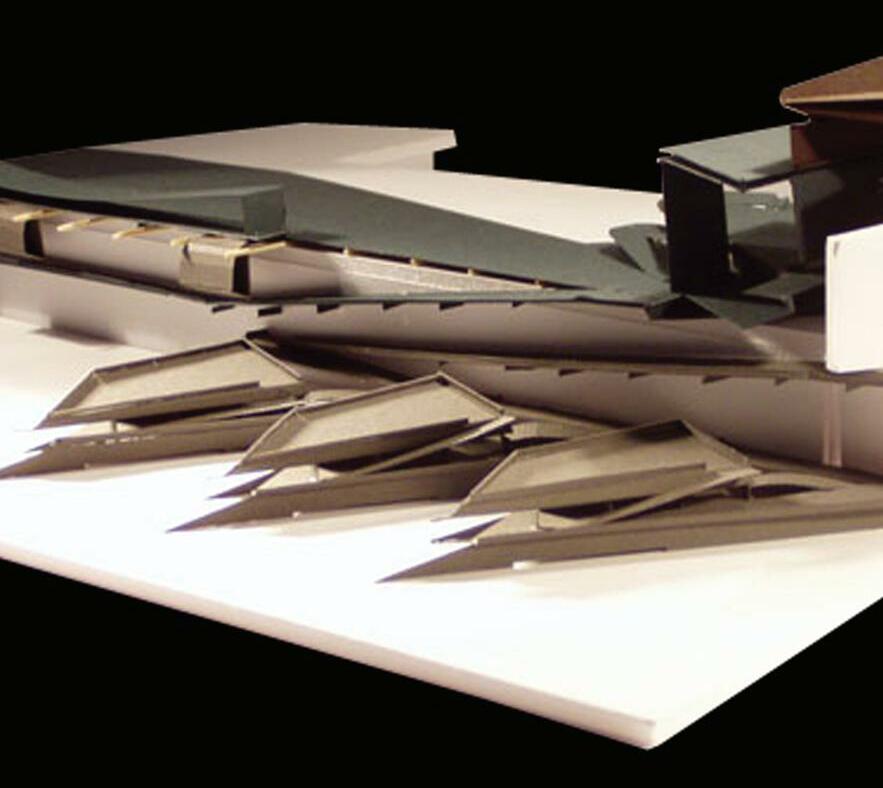 Bernd Felsinger and Stuart Piercy
Bernd Felsinger and Stuart Piercy

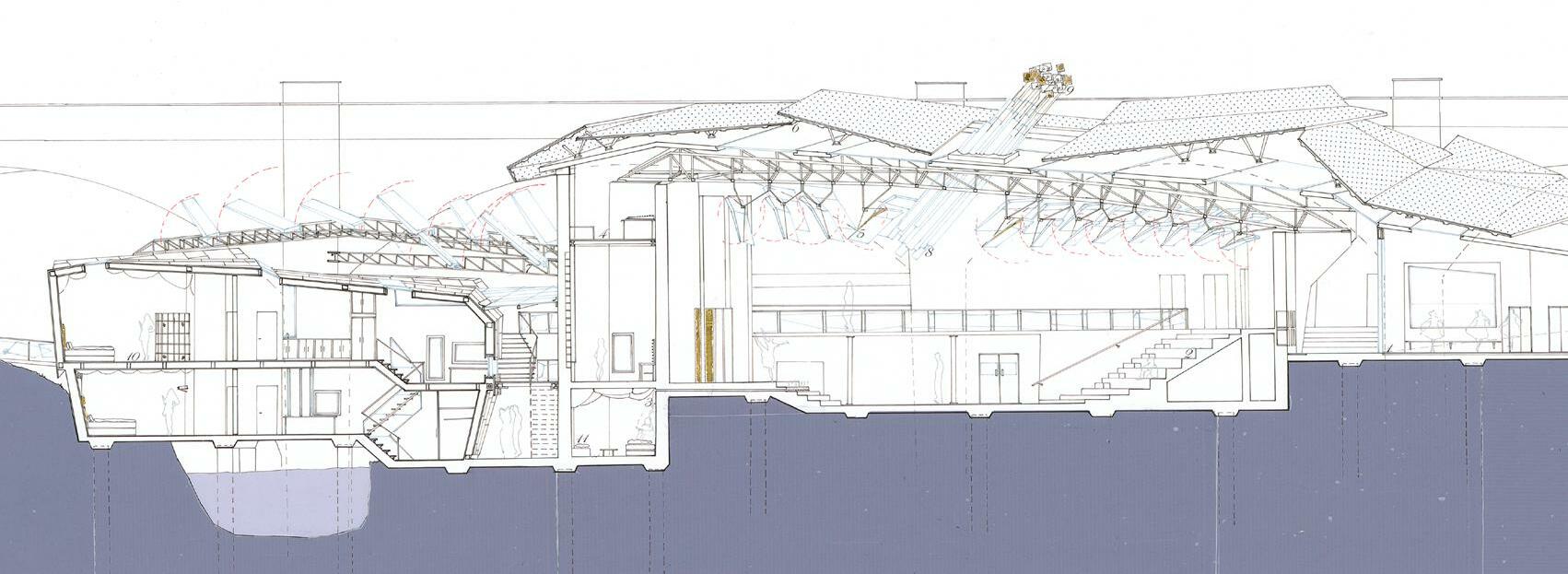
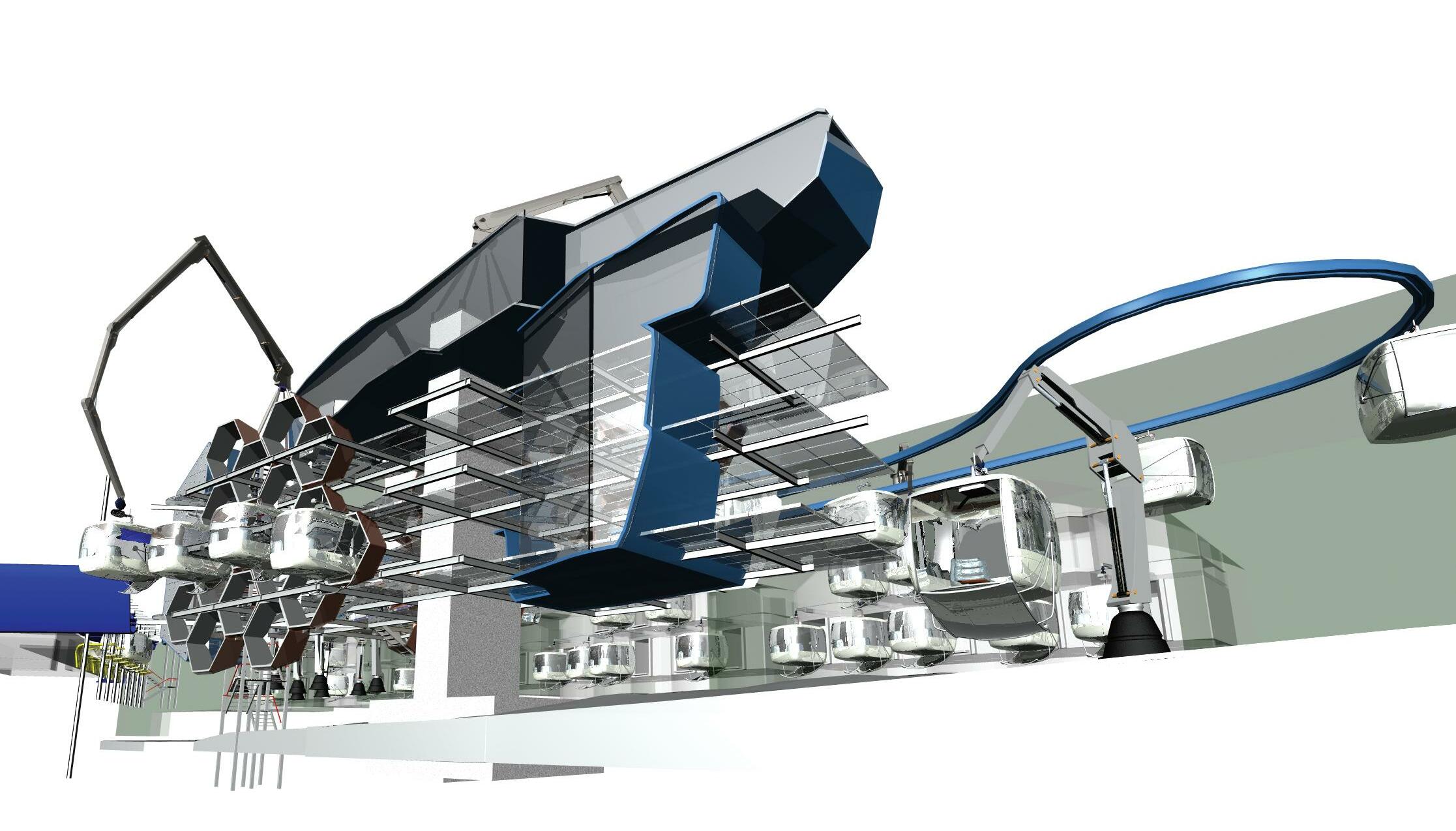

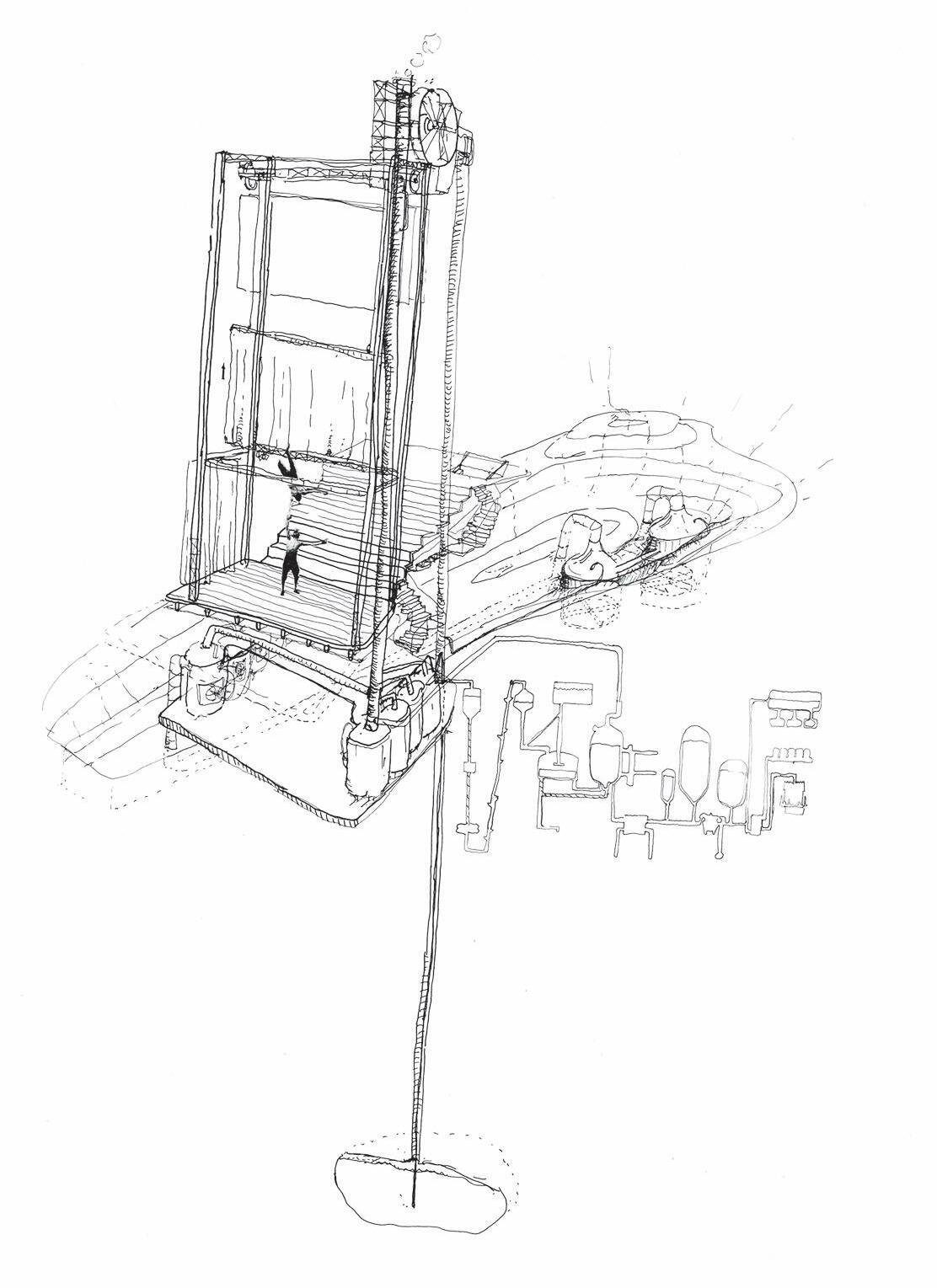 Clockwise from top: Alice Cartledge, James Barrington, Paul Tynam, Andrew Marshall, Alvin Tan Overleaf, top: Michiko Sumi, bottom: Tom Elliot
Clockwise from top: Alice Cartledge, James Barrington, Paul Tynam, Andrew Marshall, Alvin Tan Overleaf, top: Michiko Sumi, bottom: Tom Elliot



